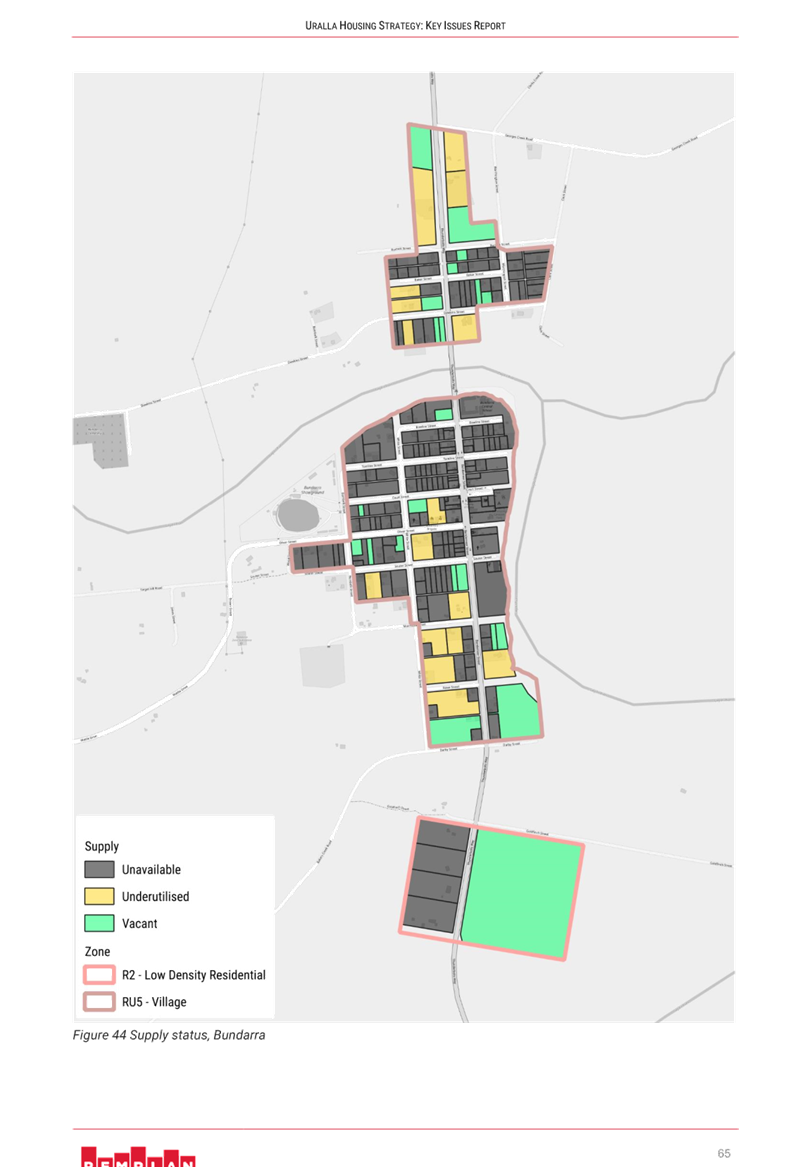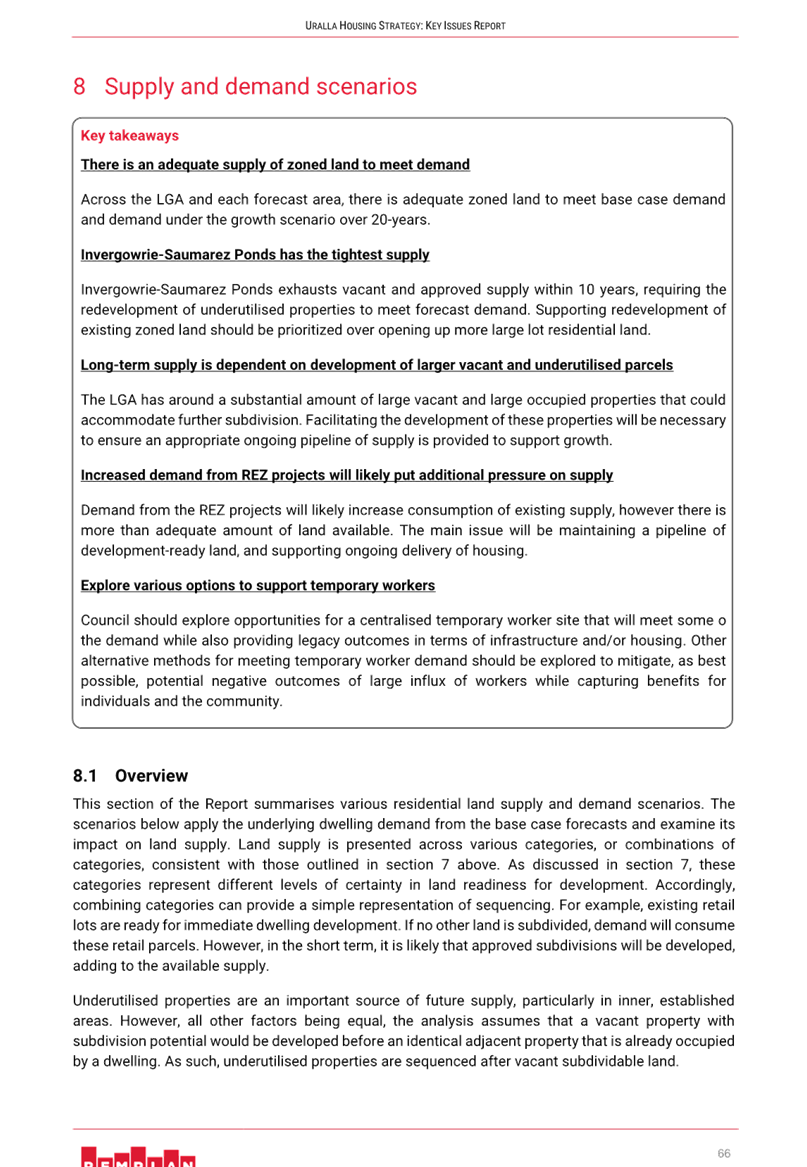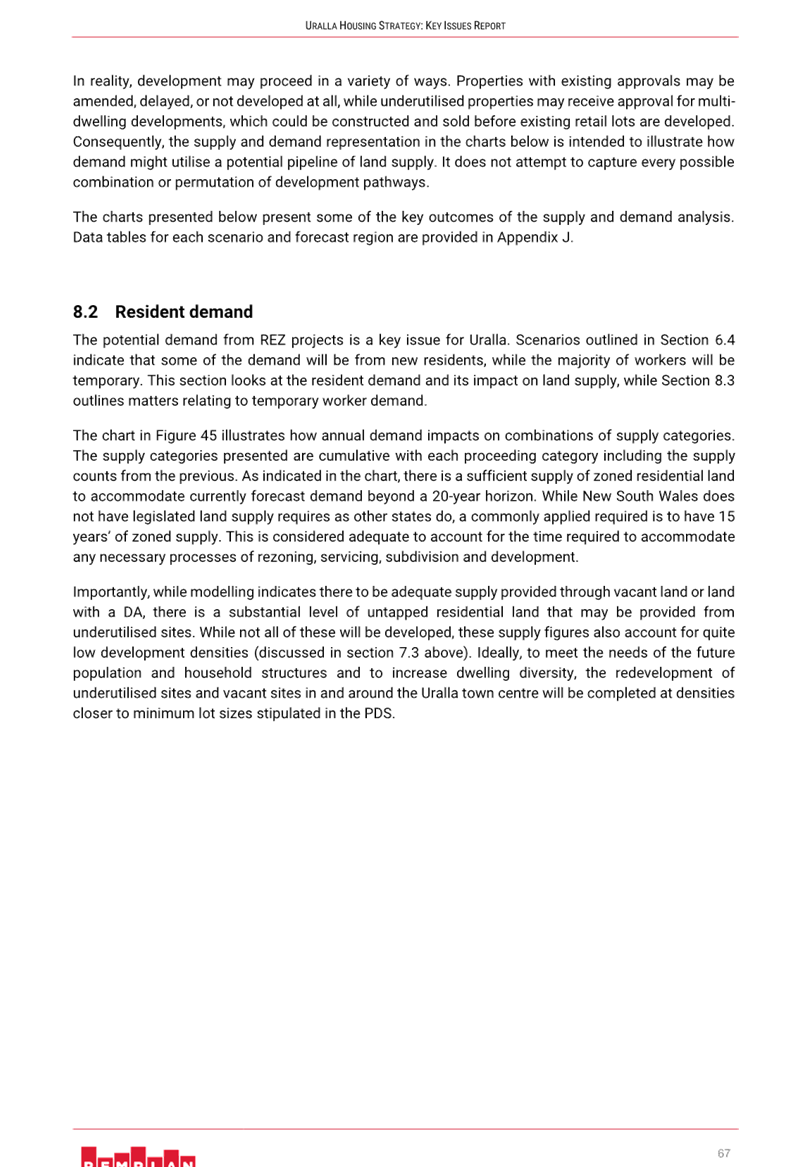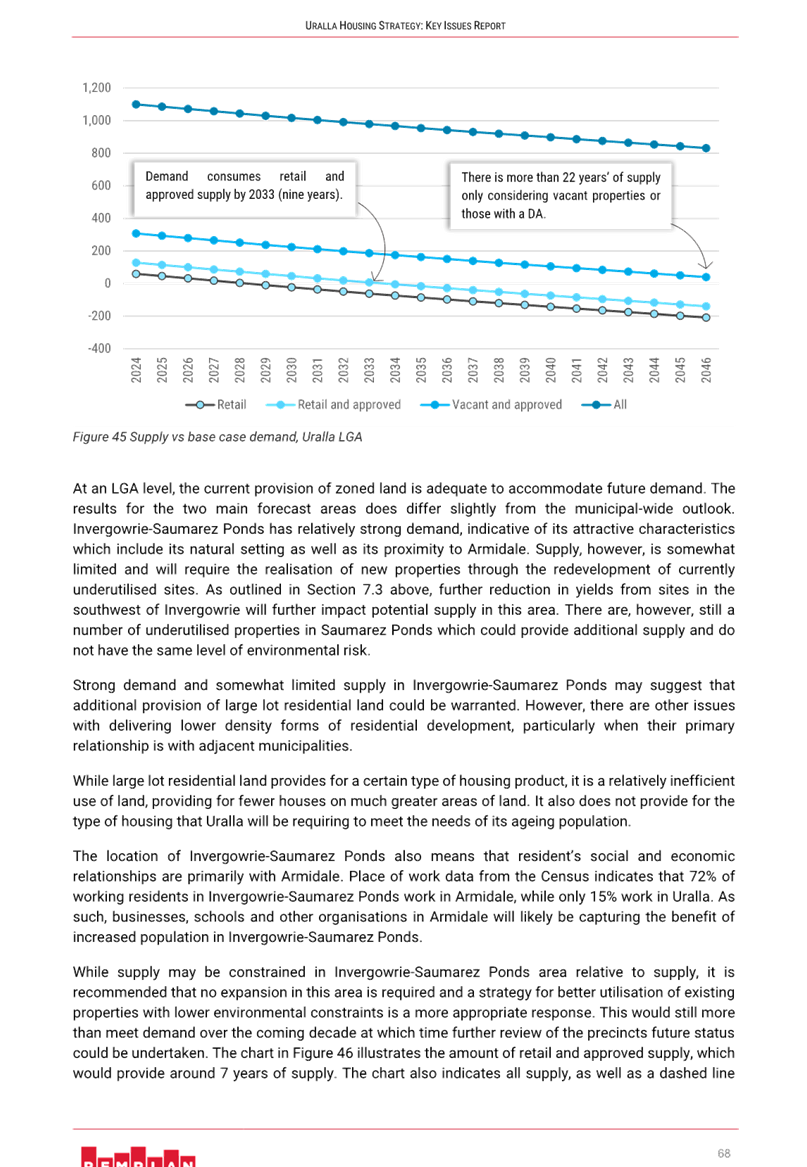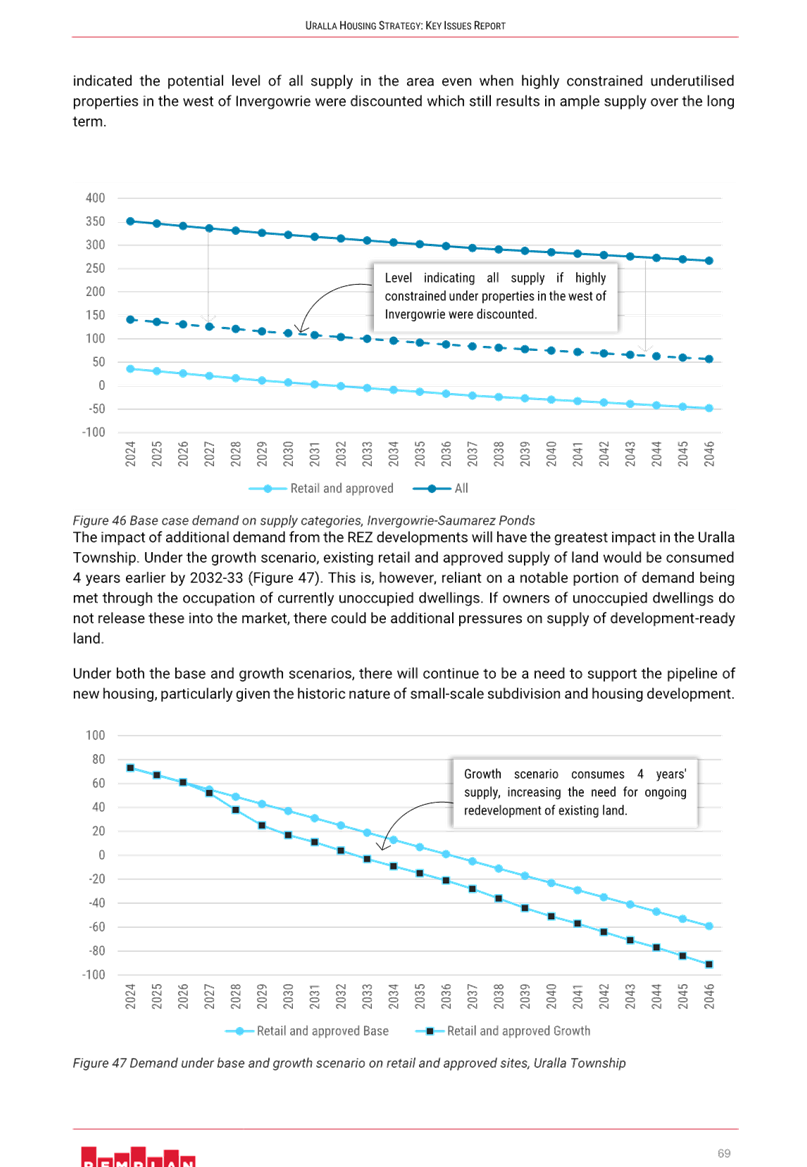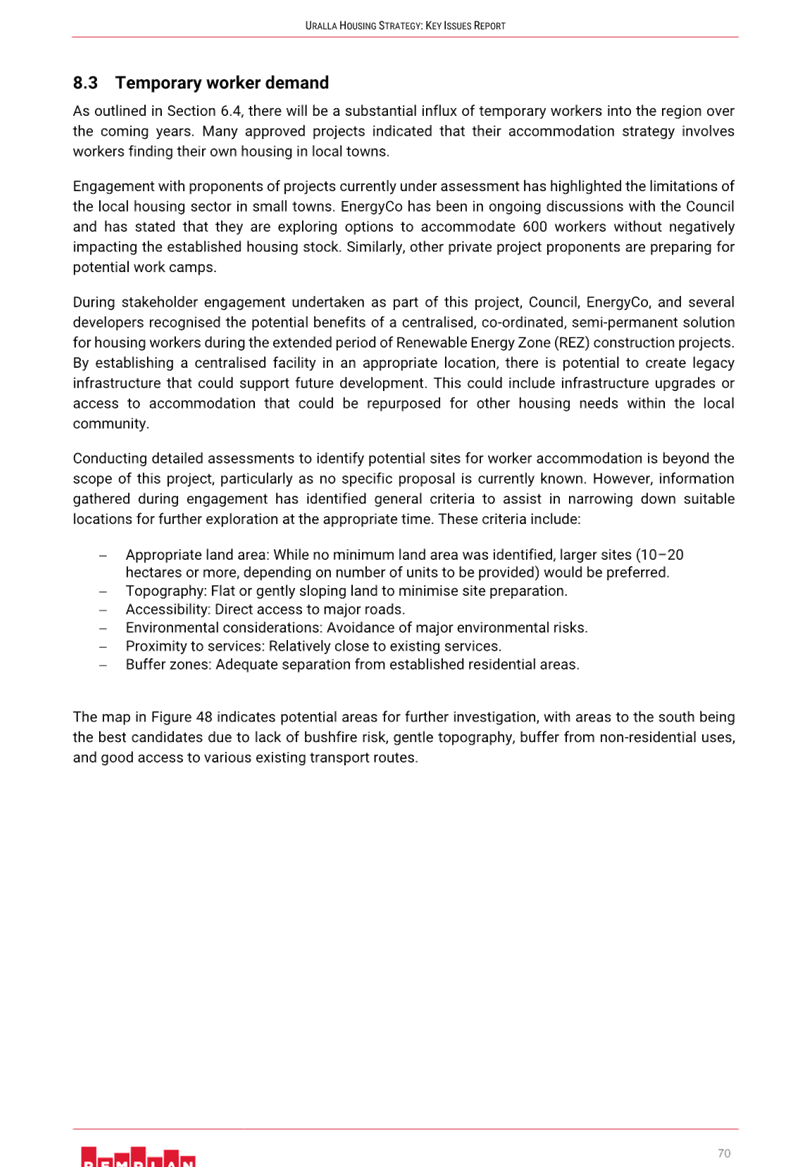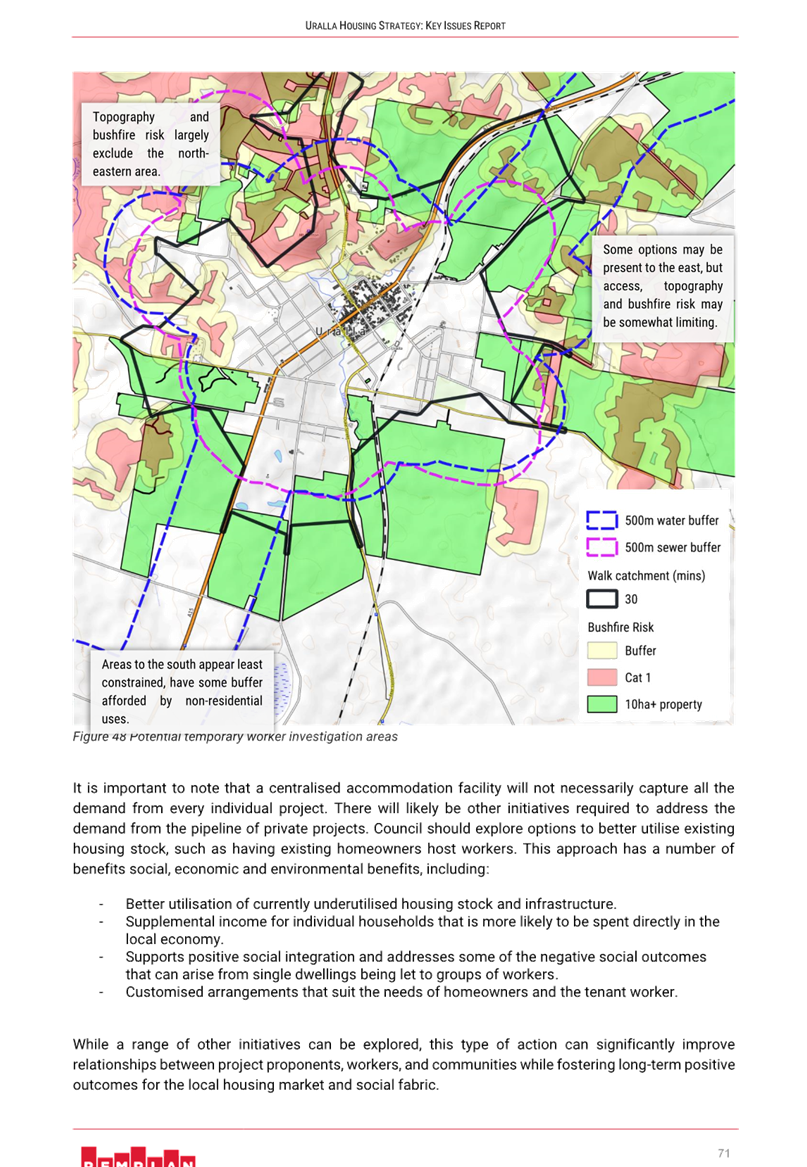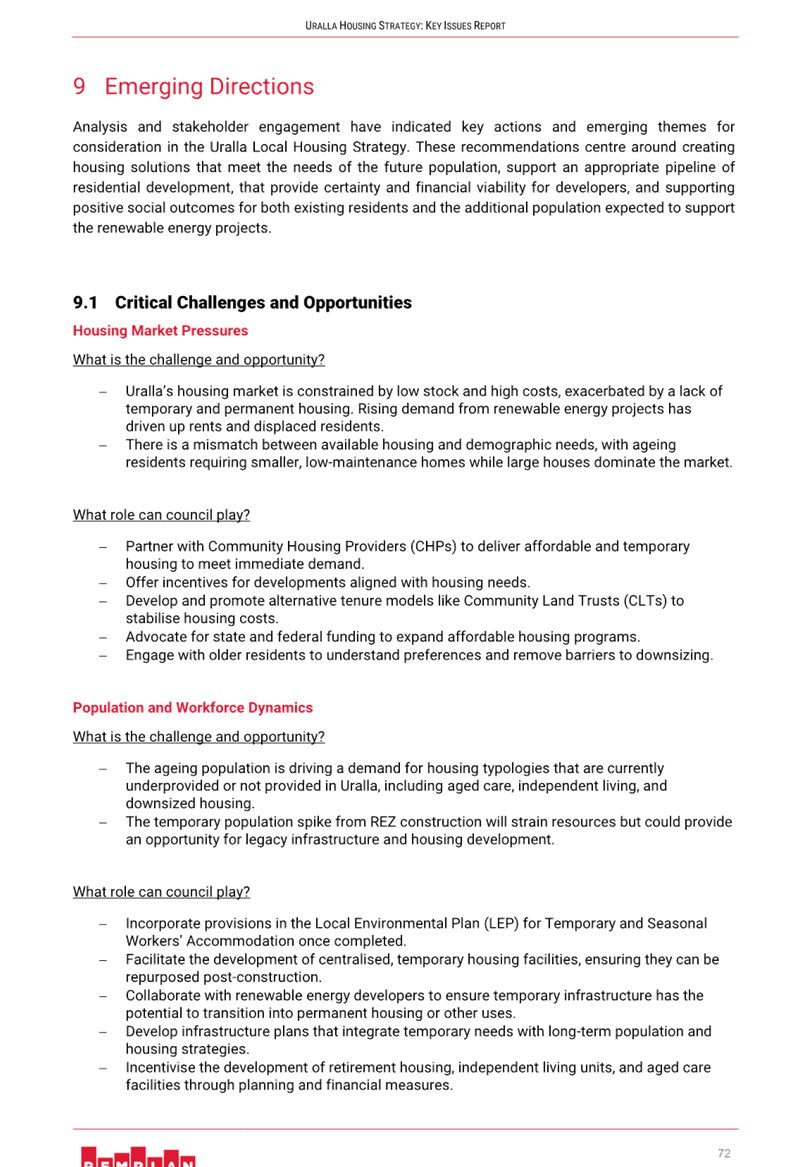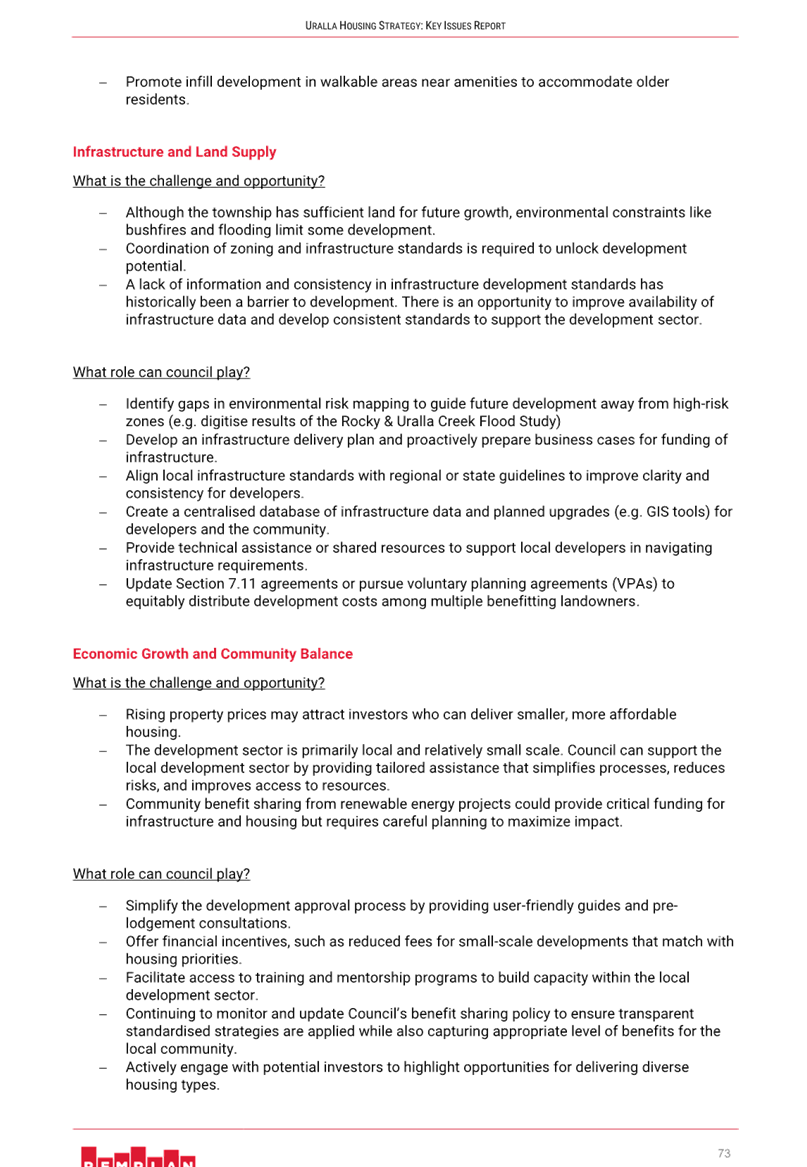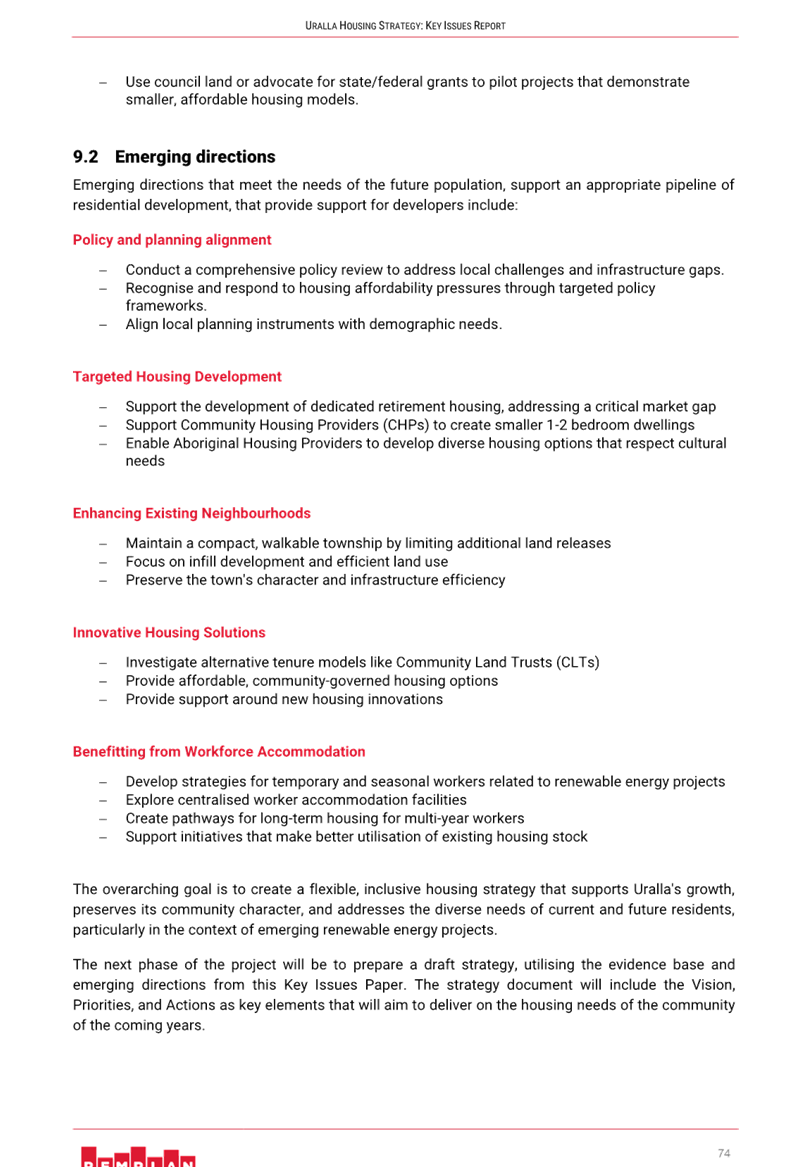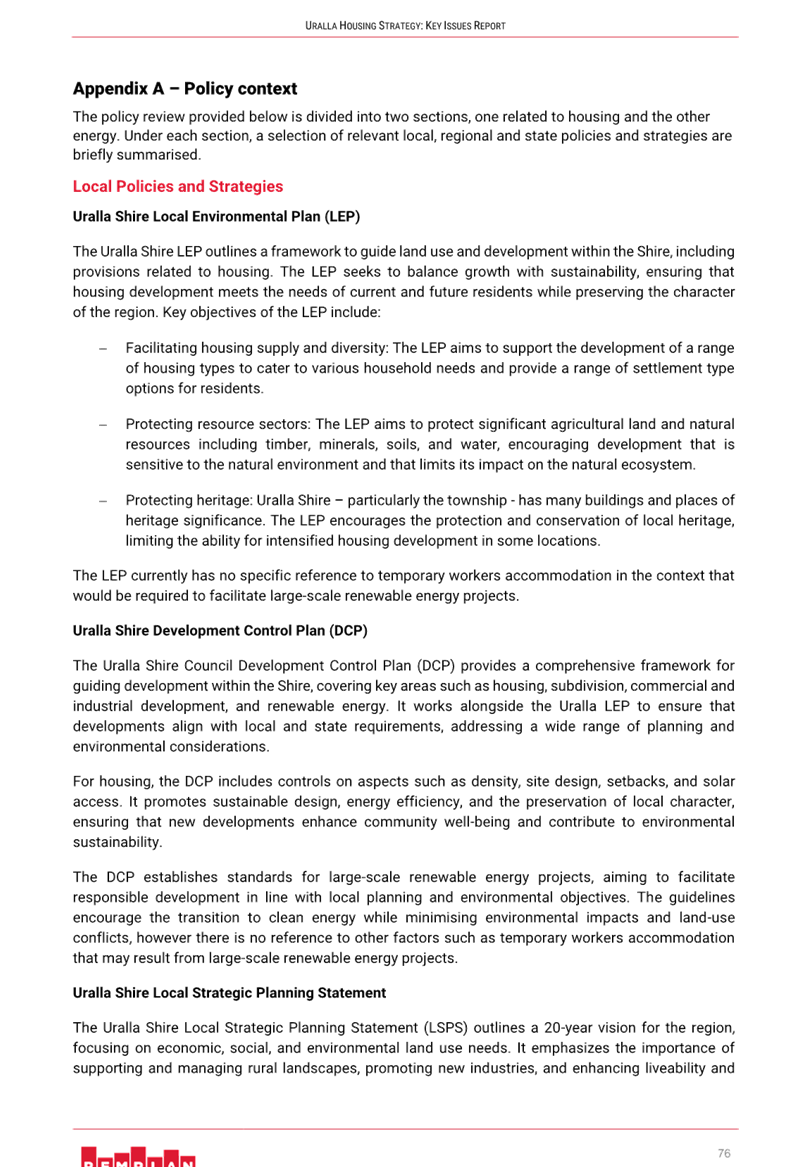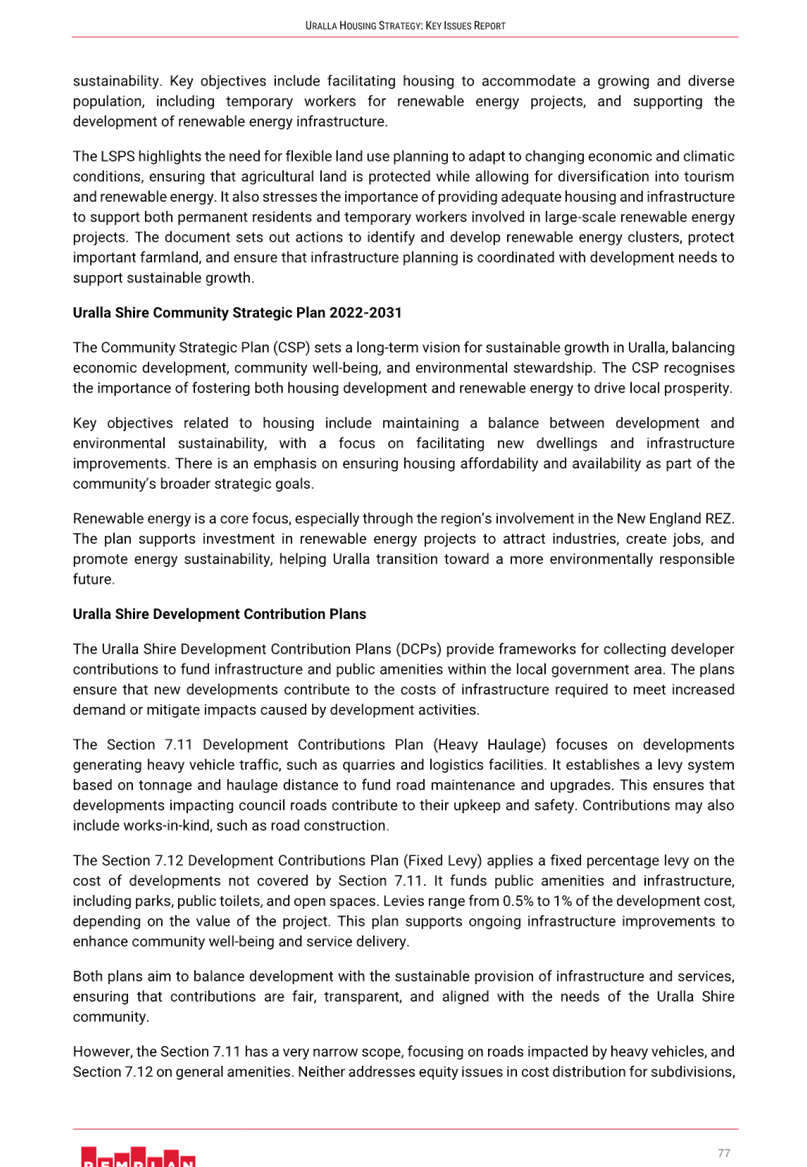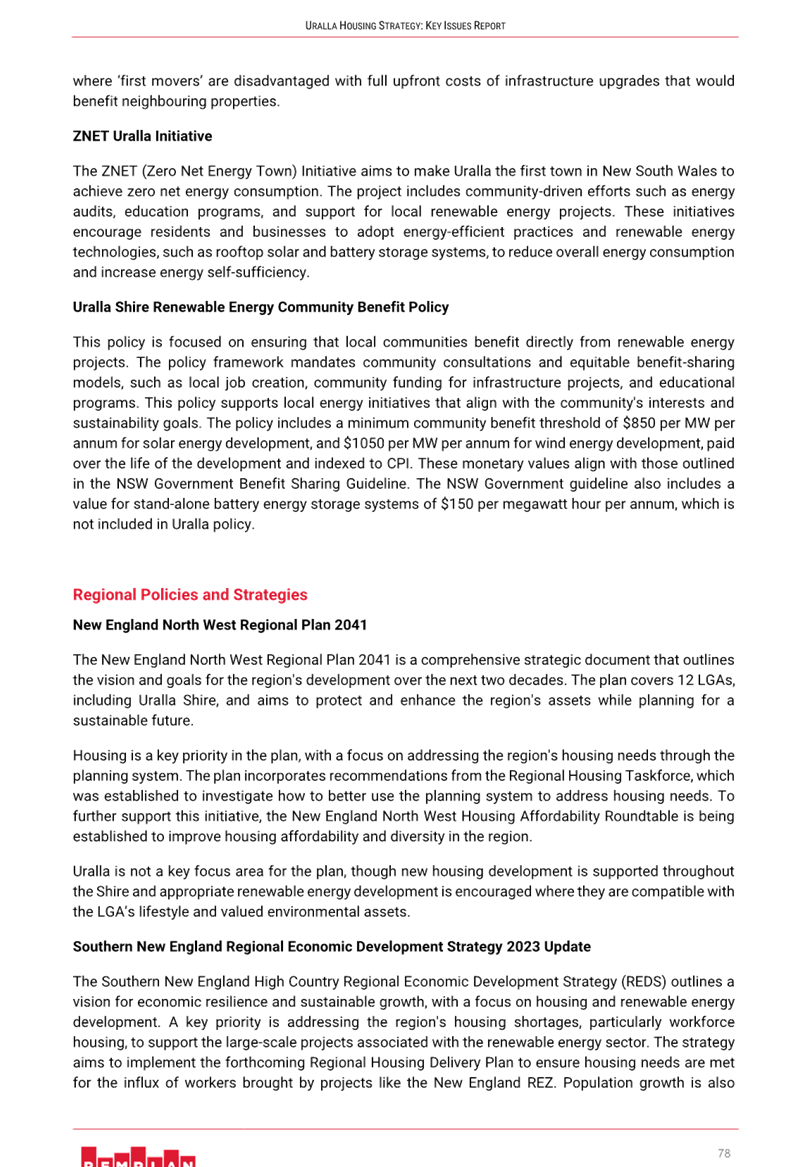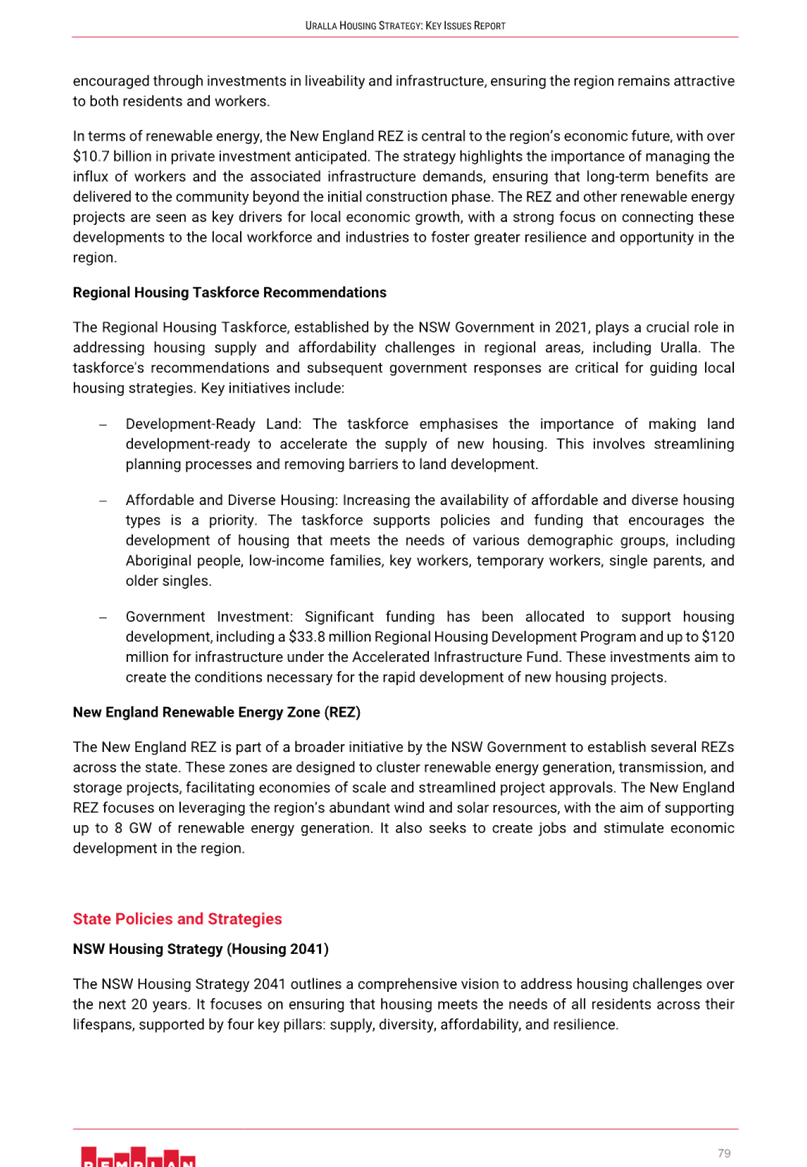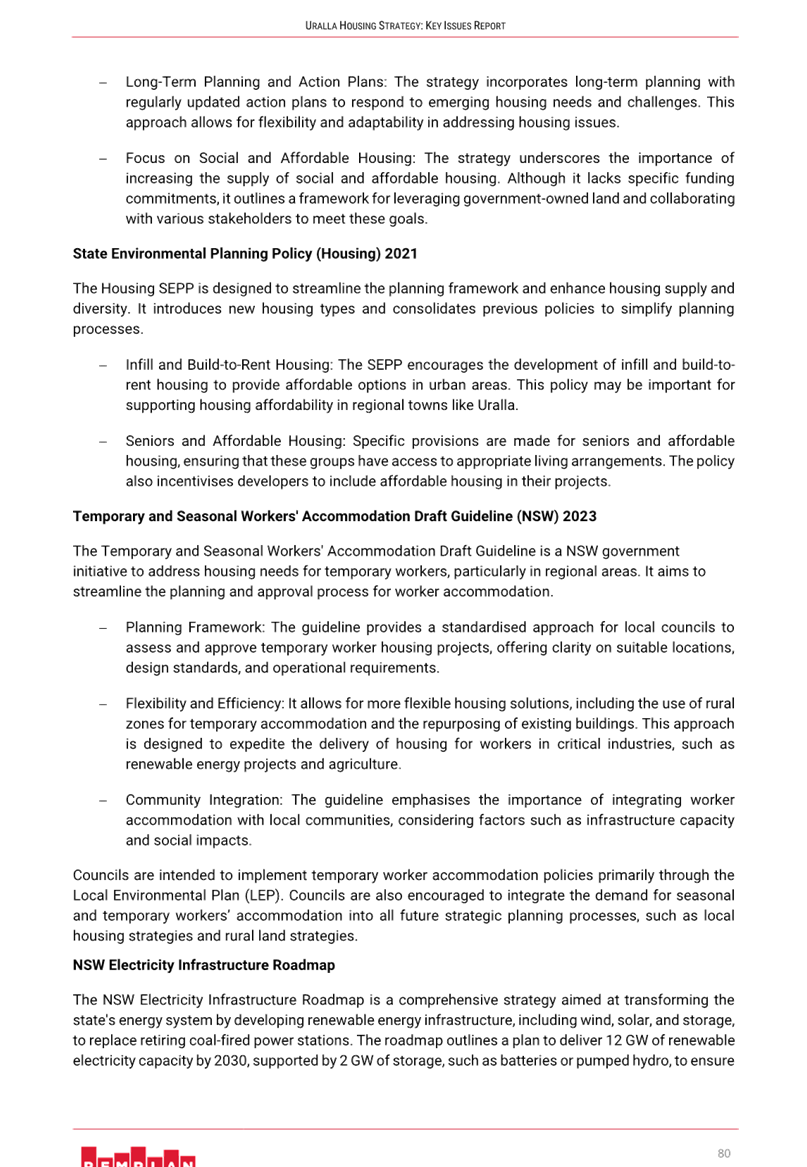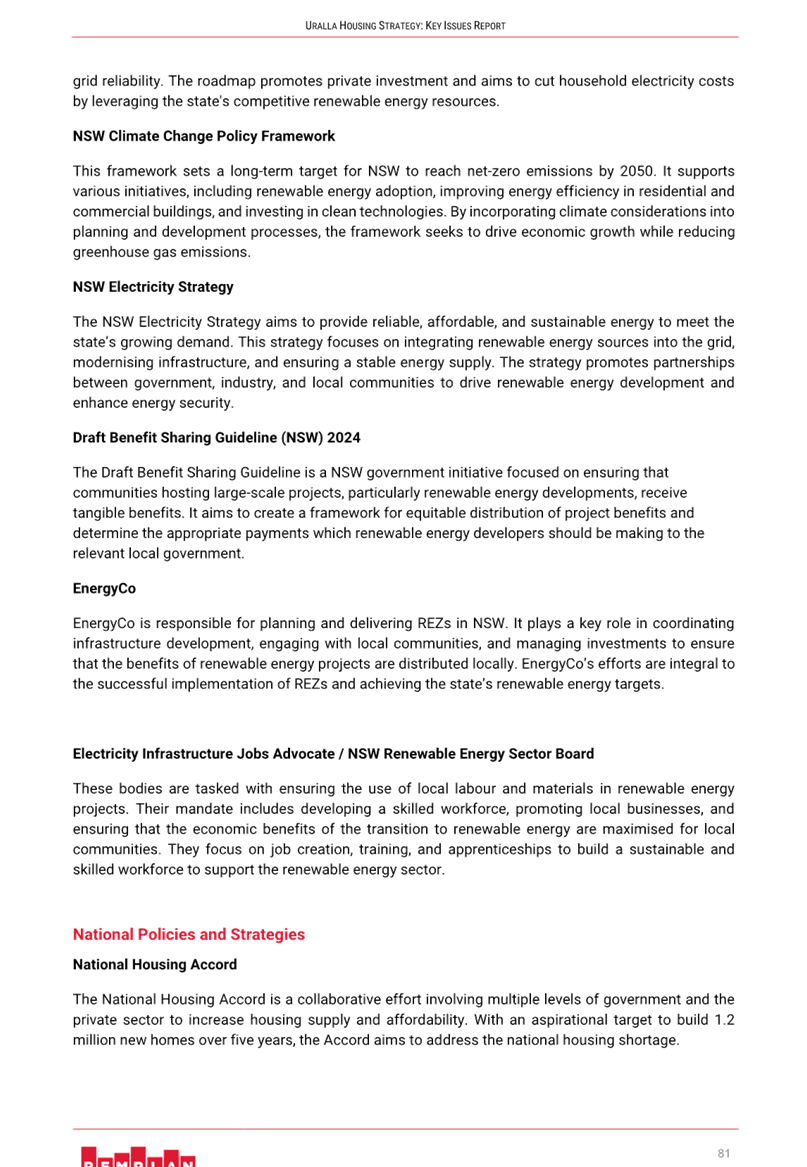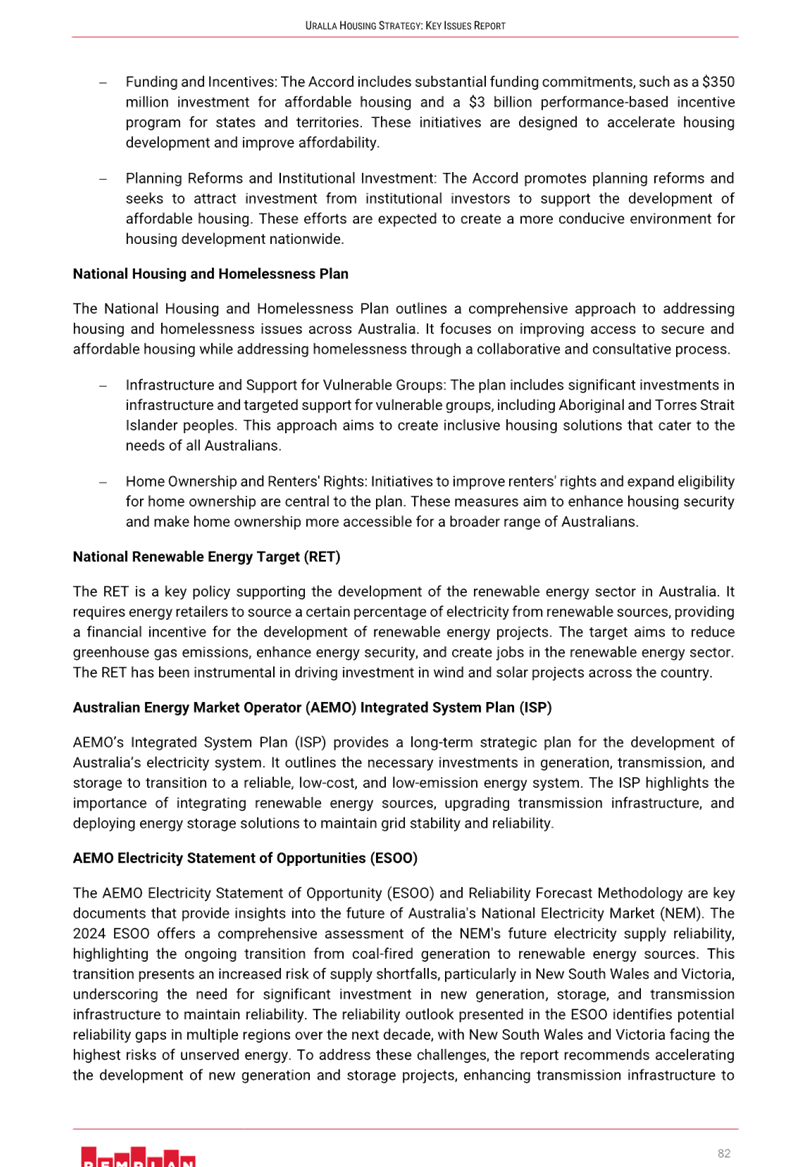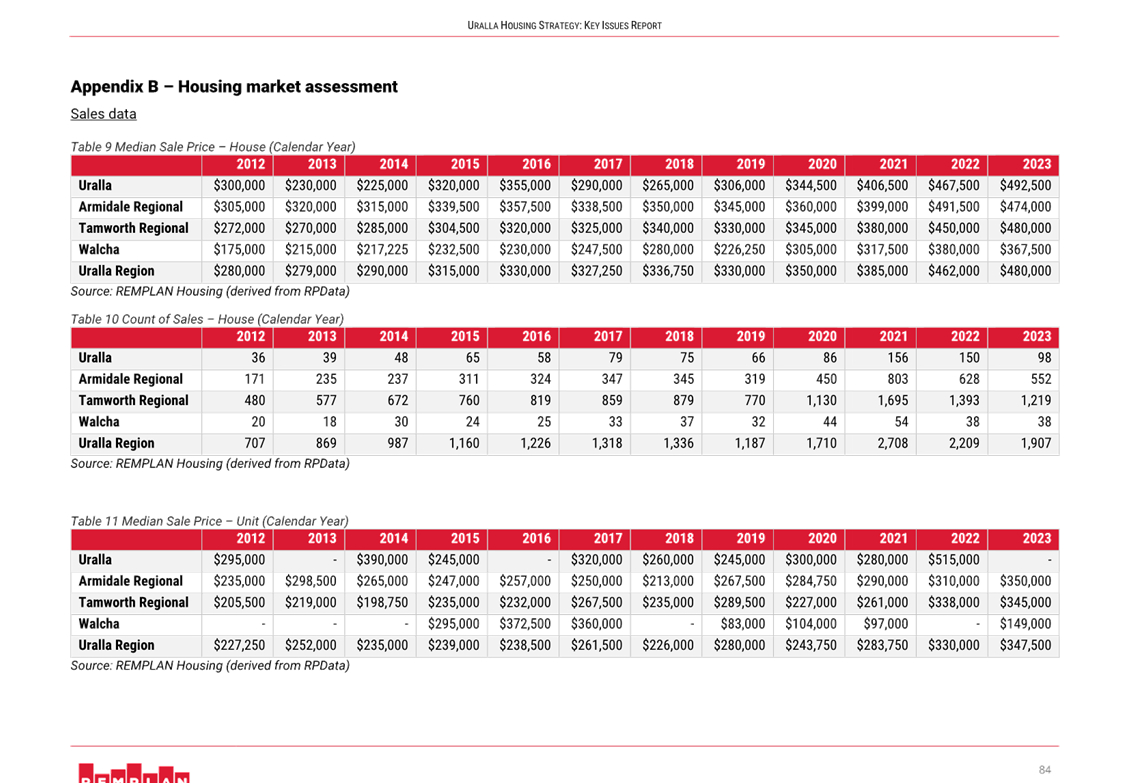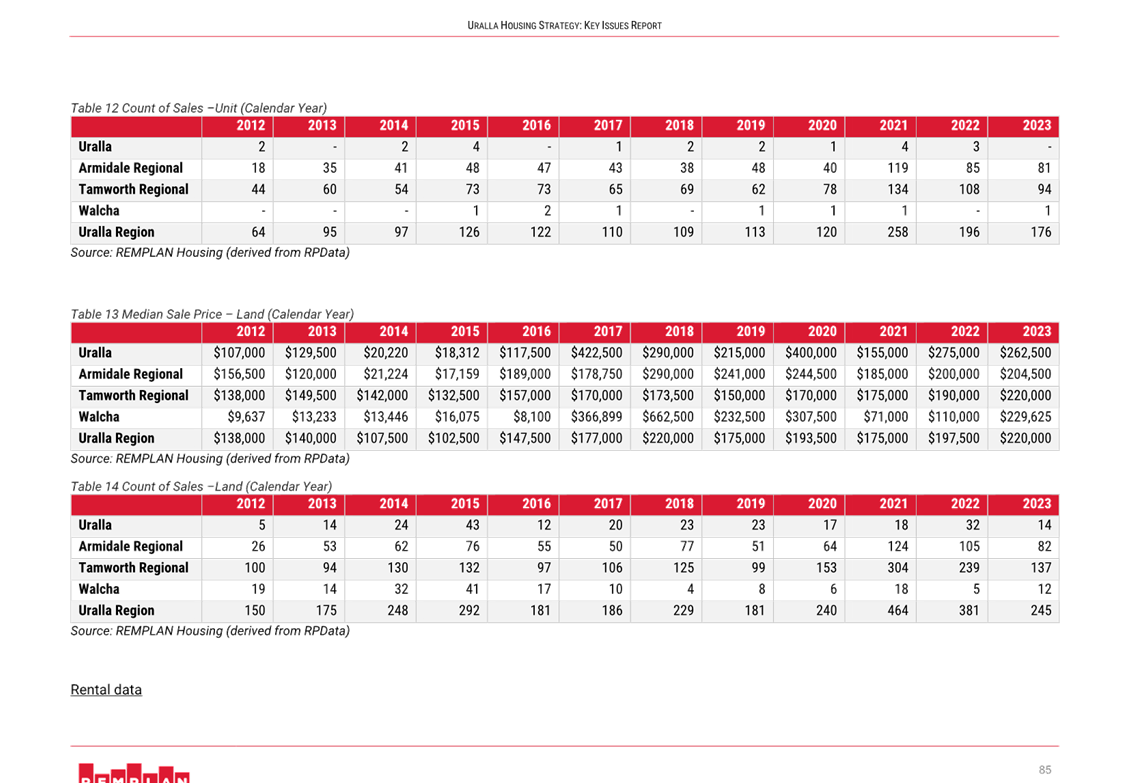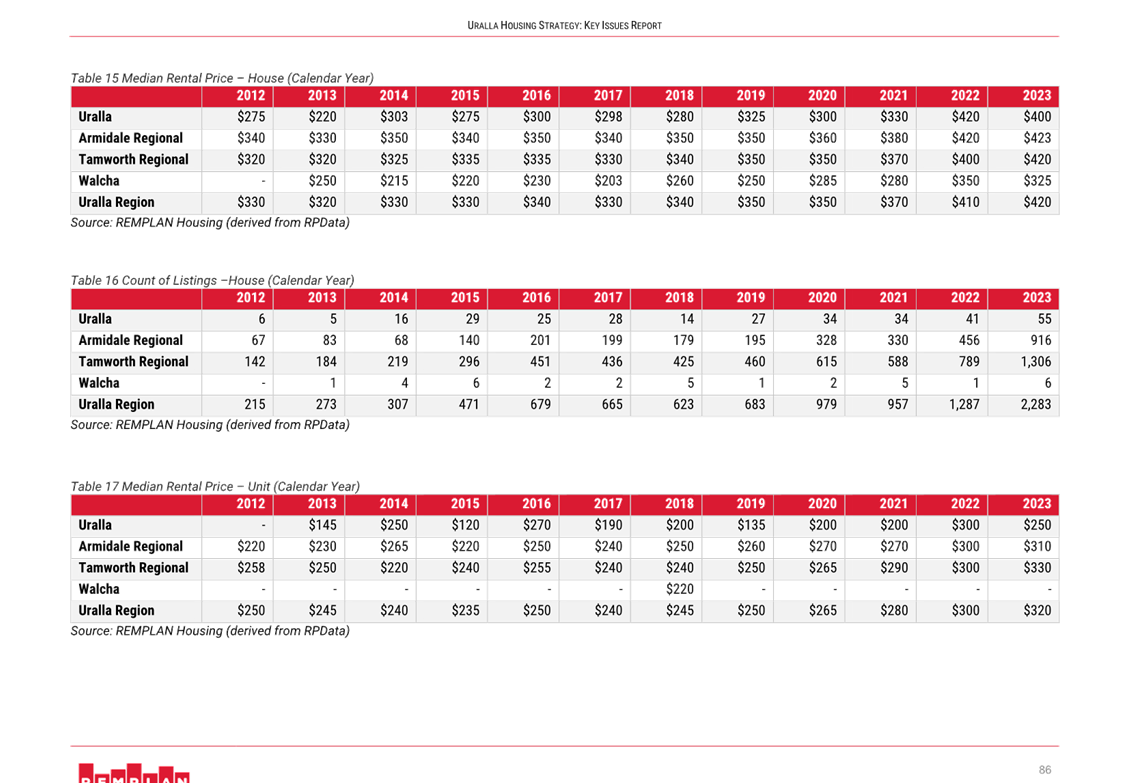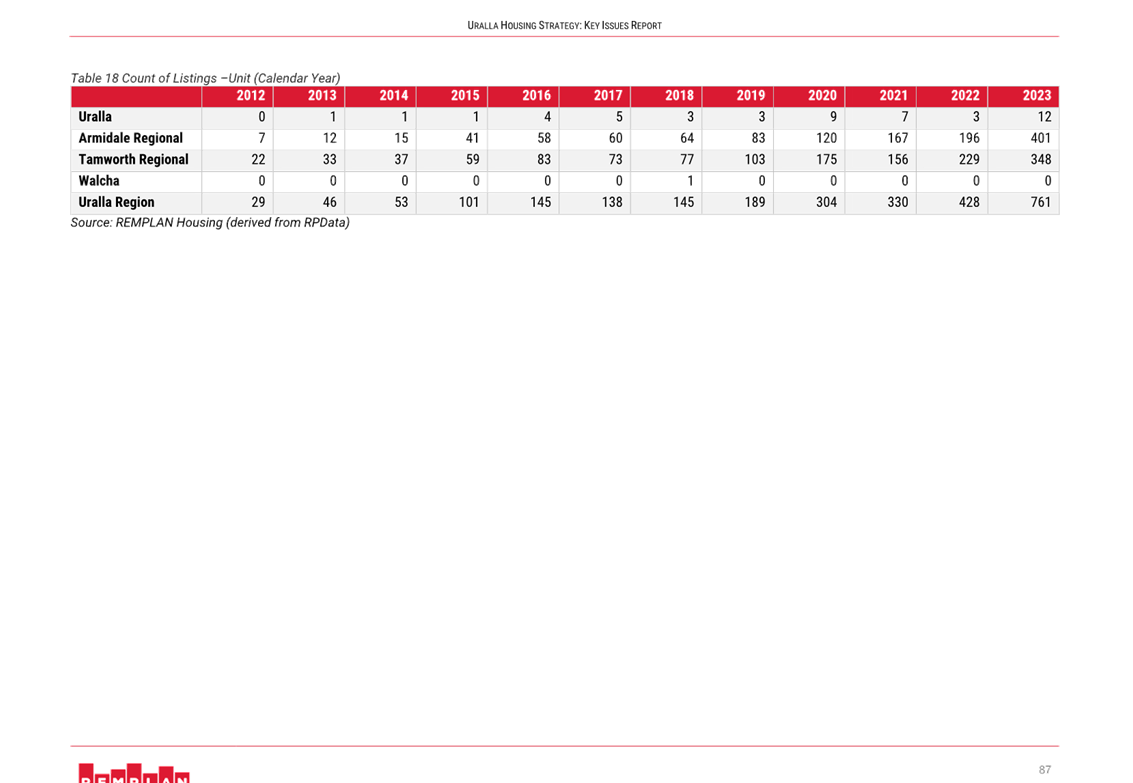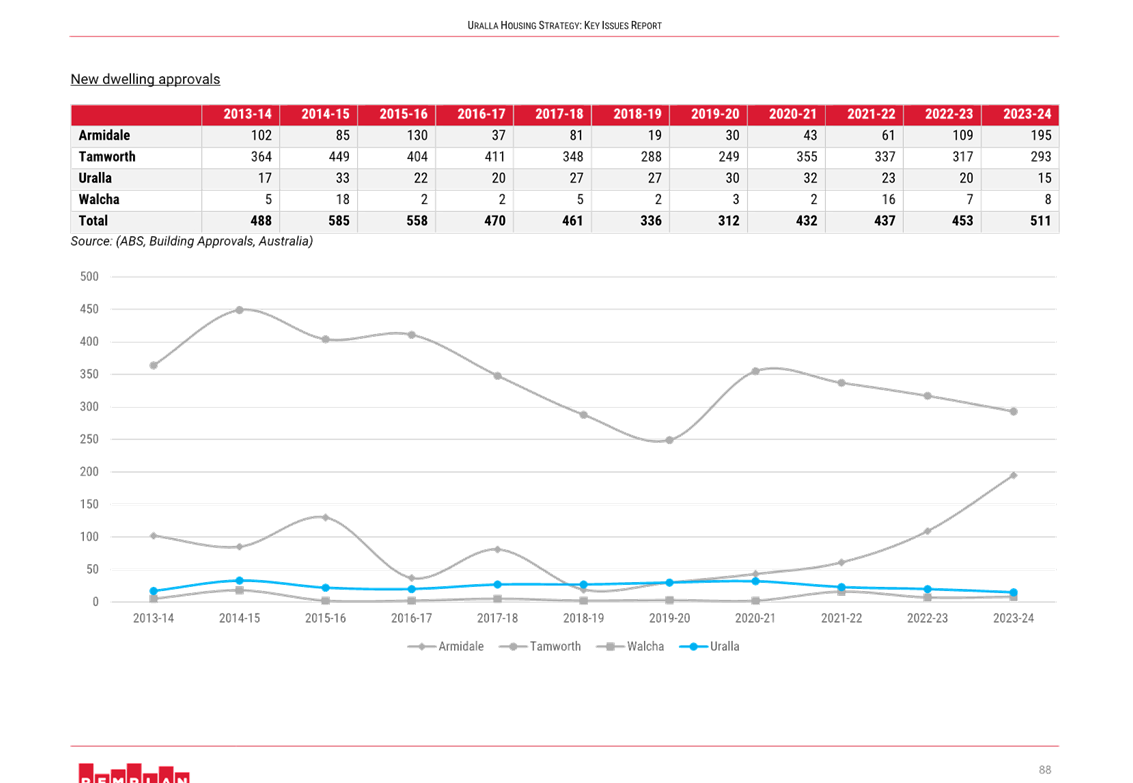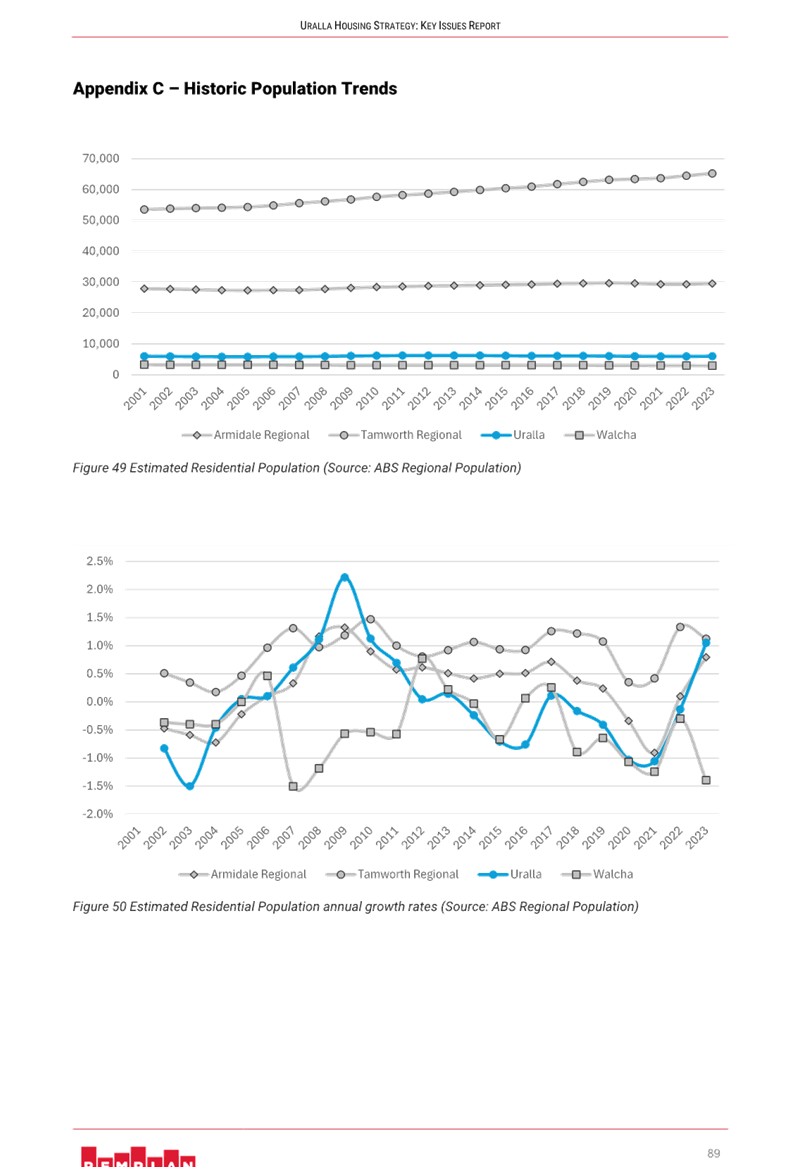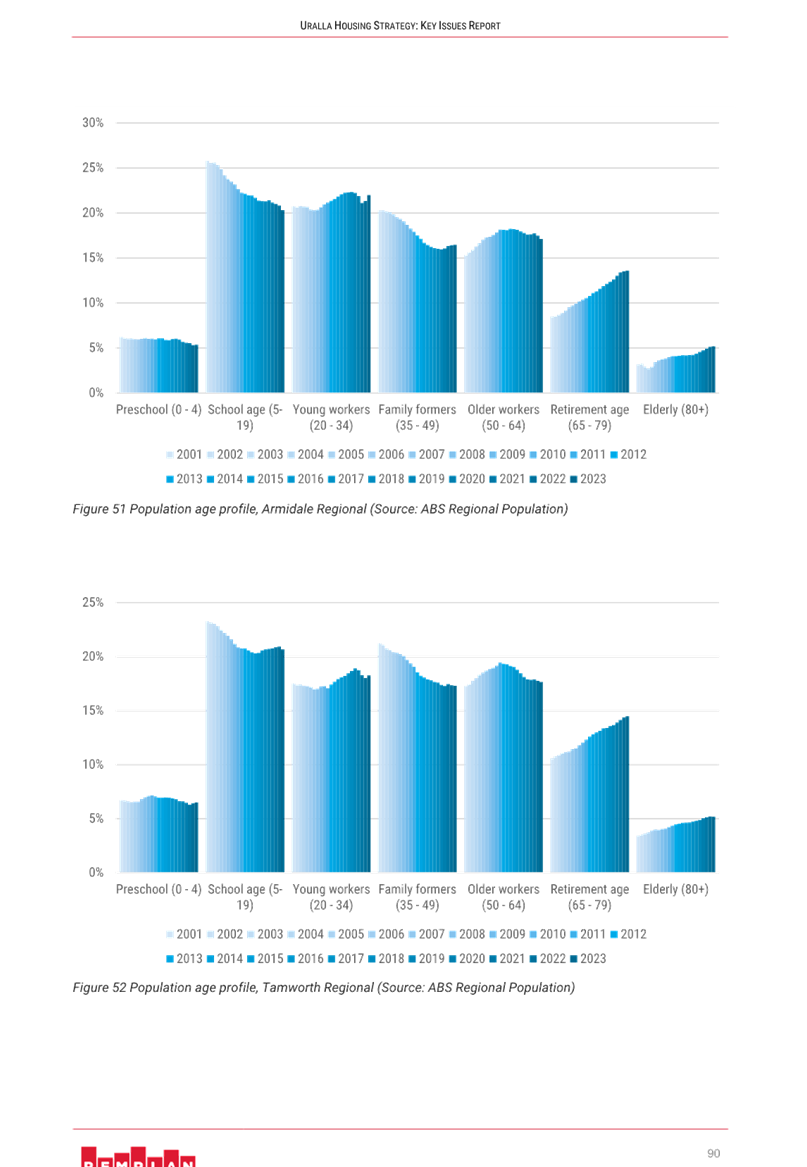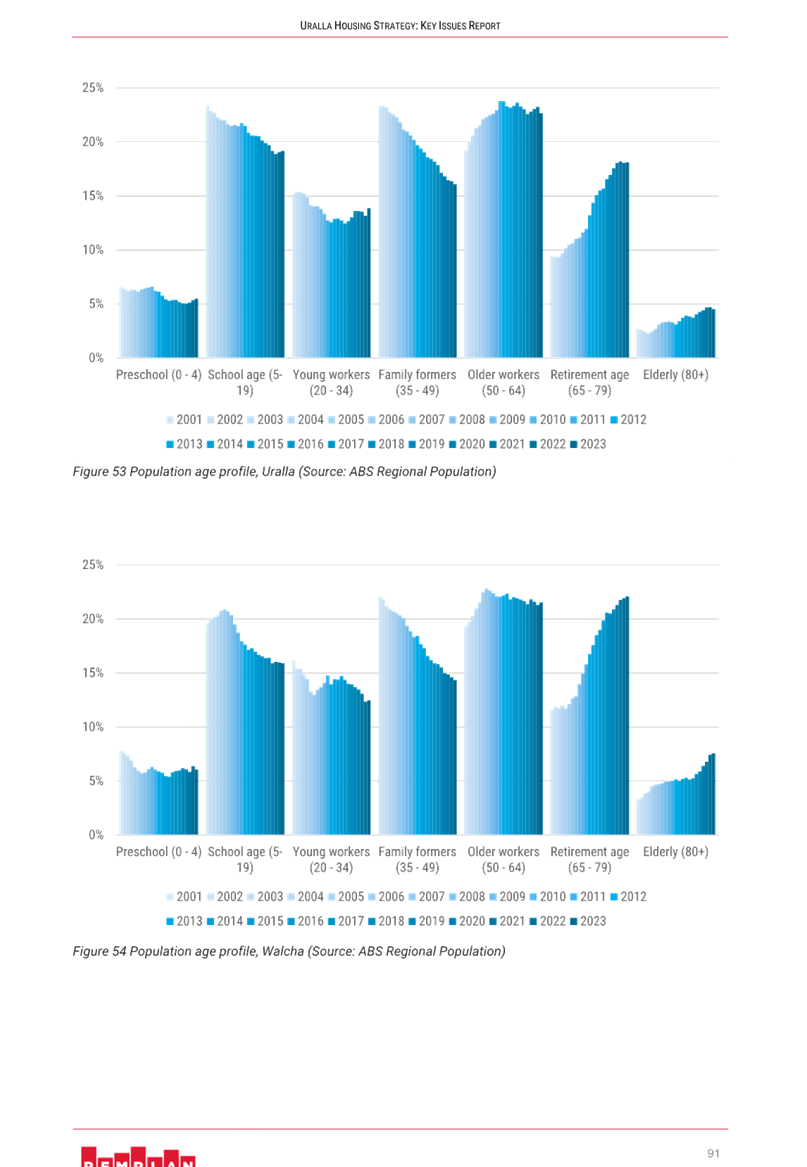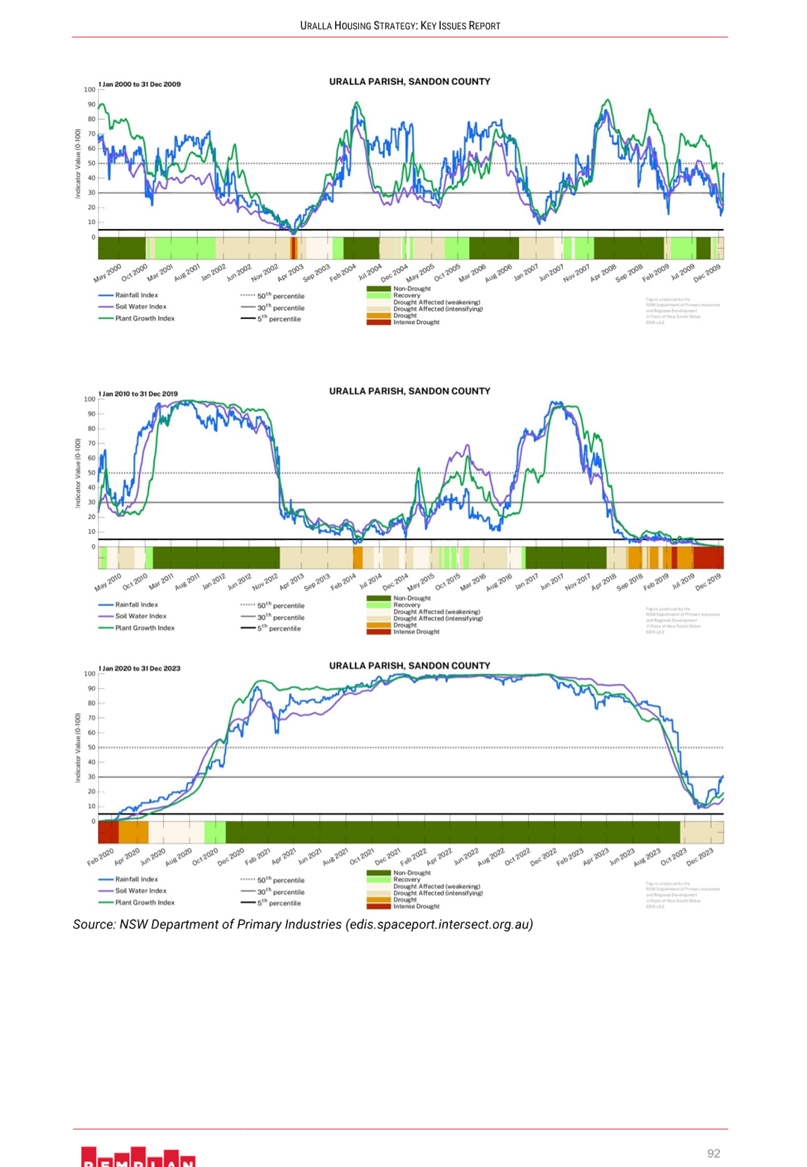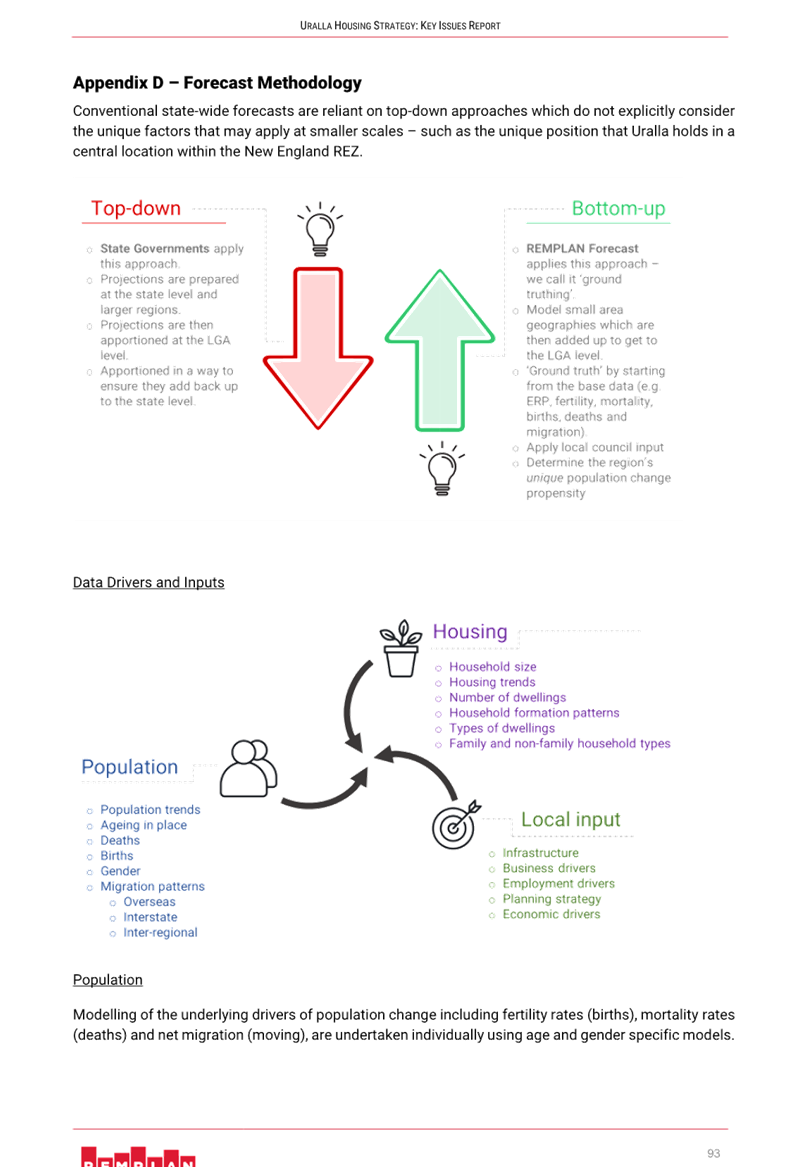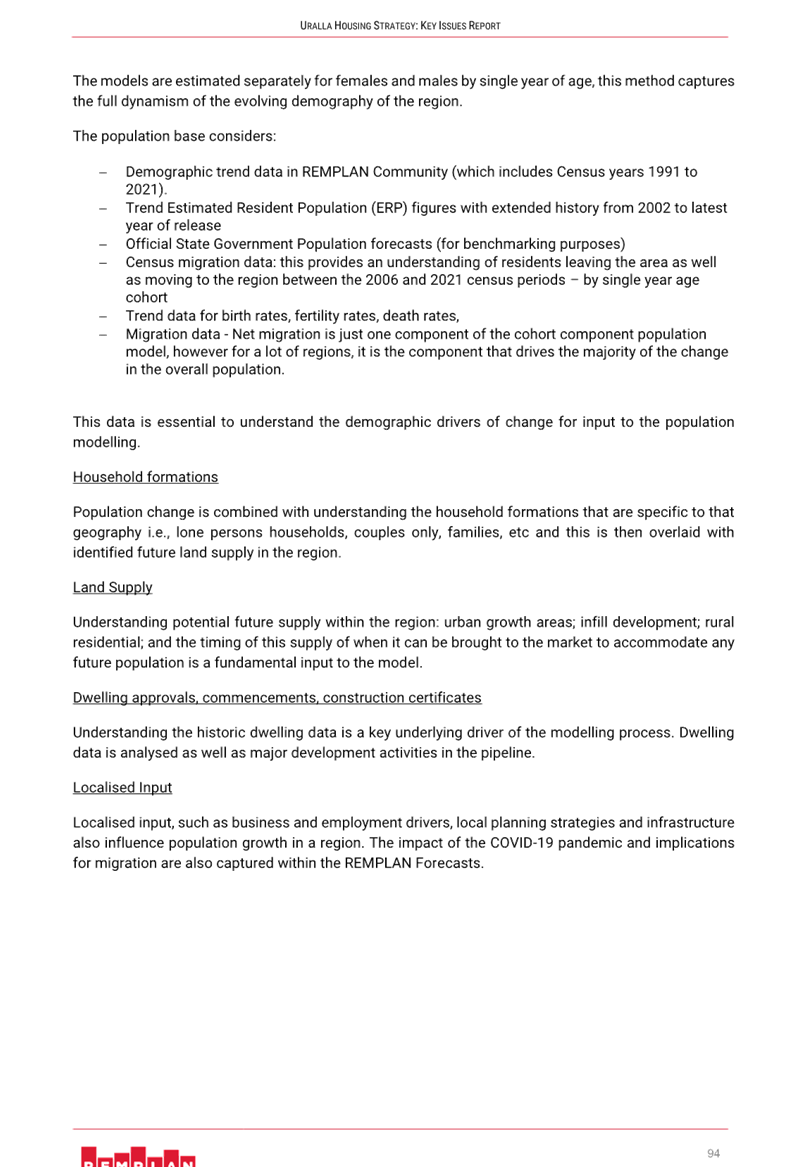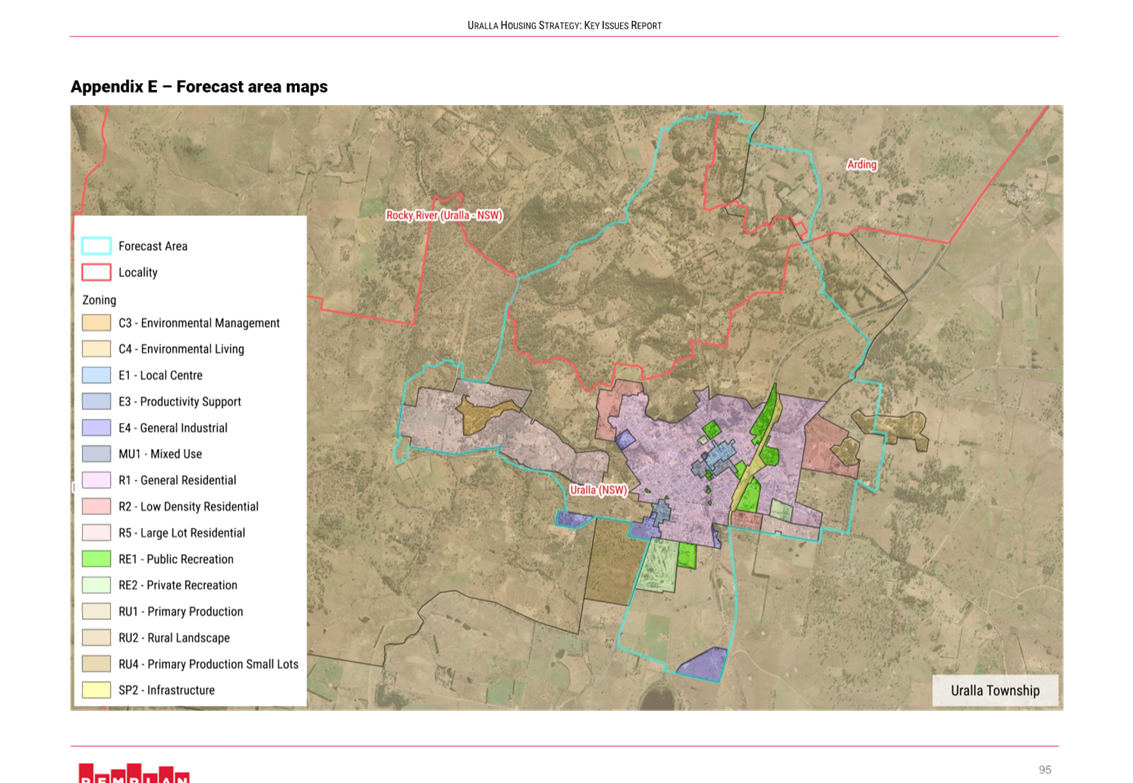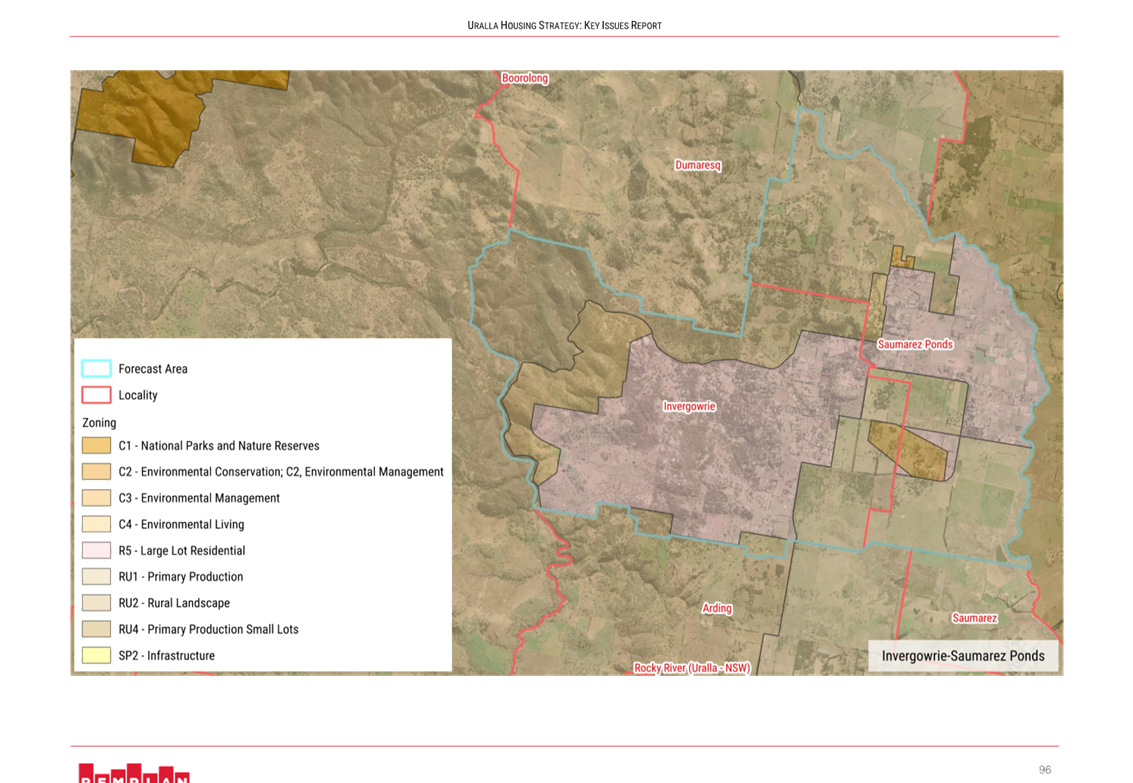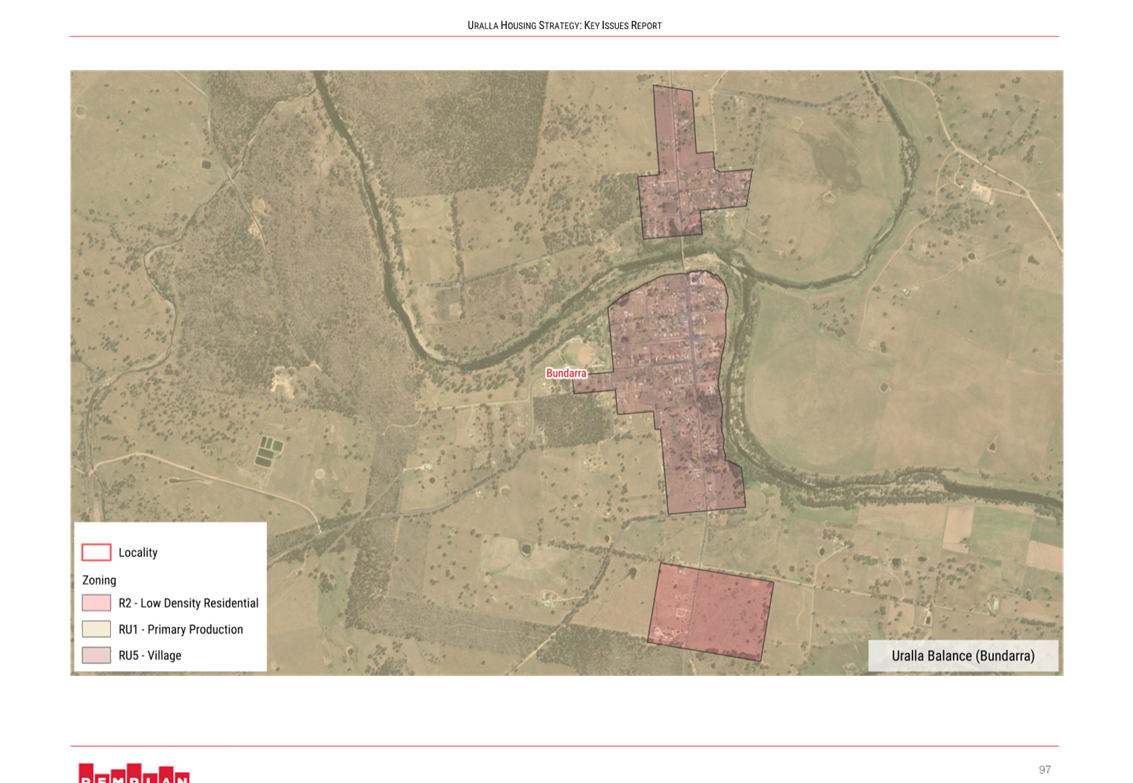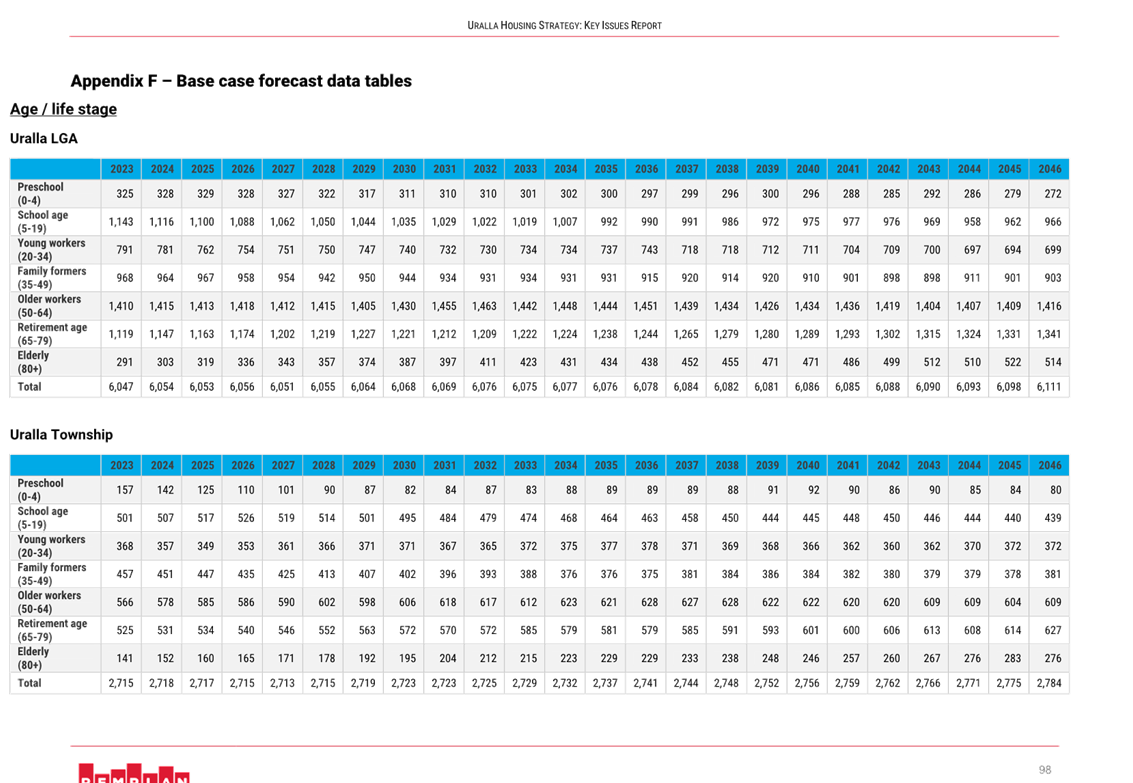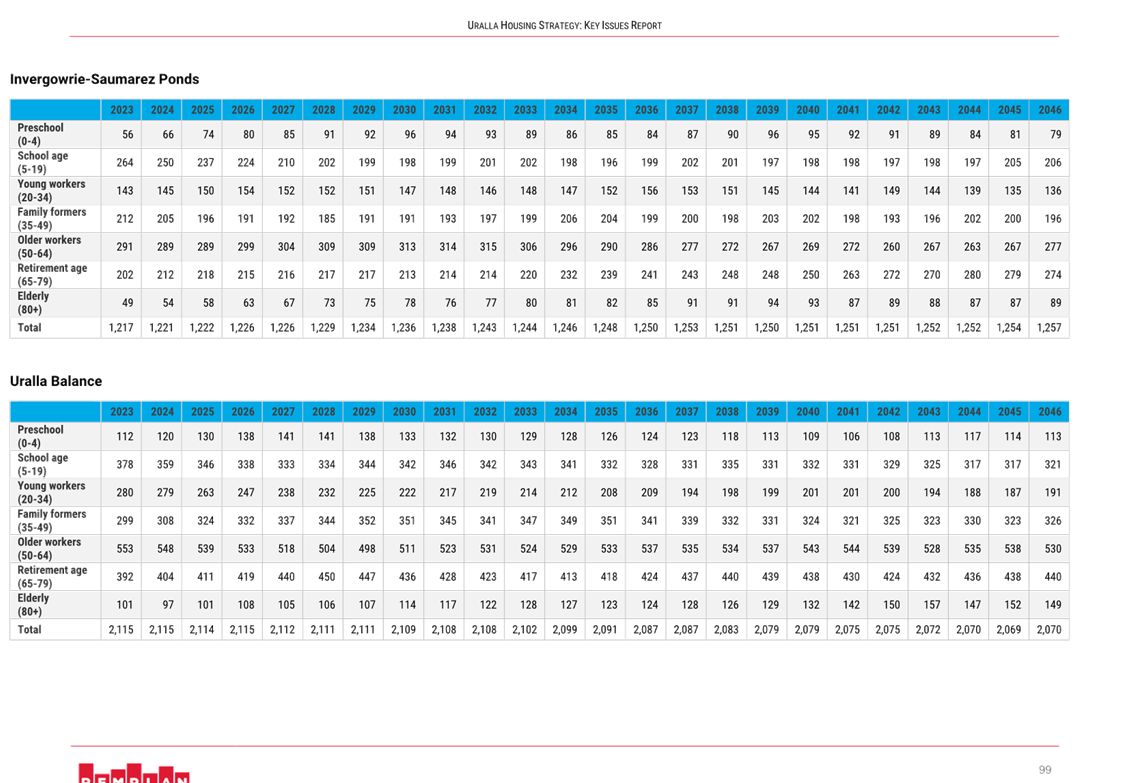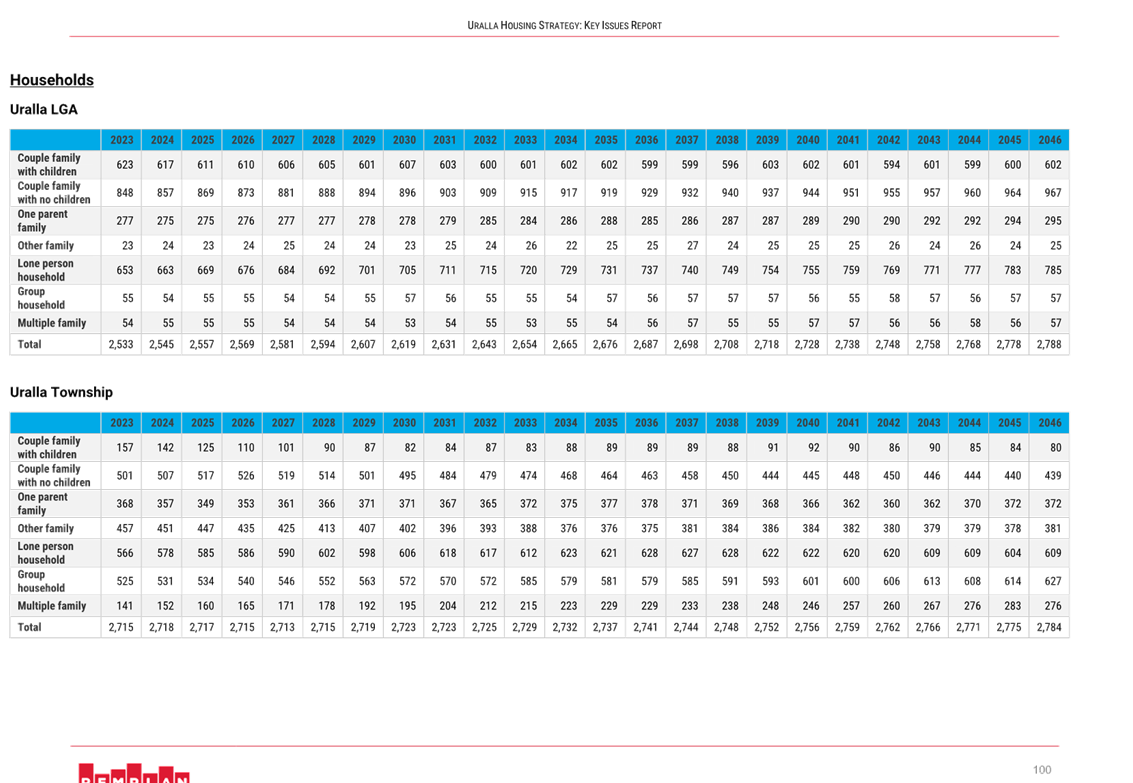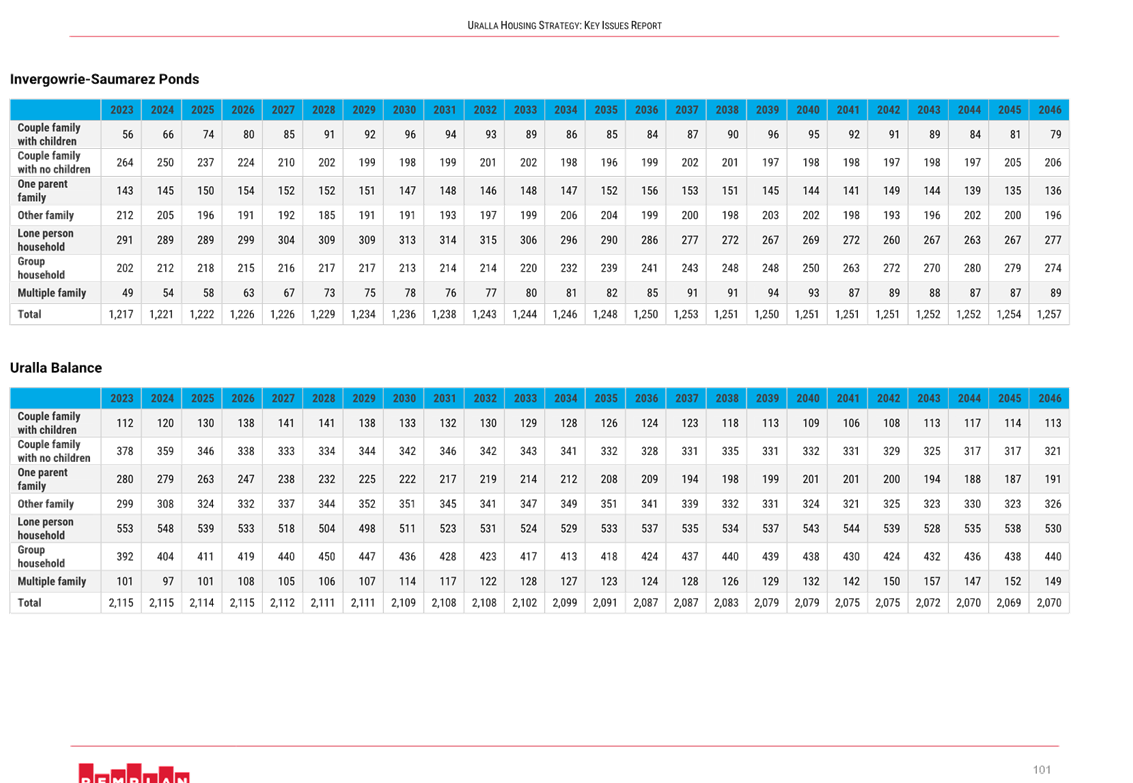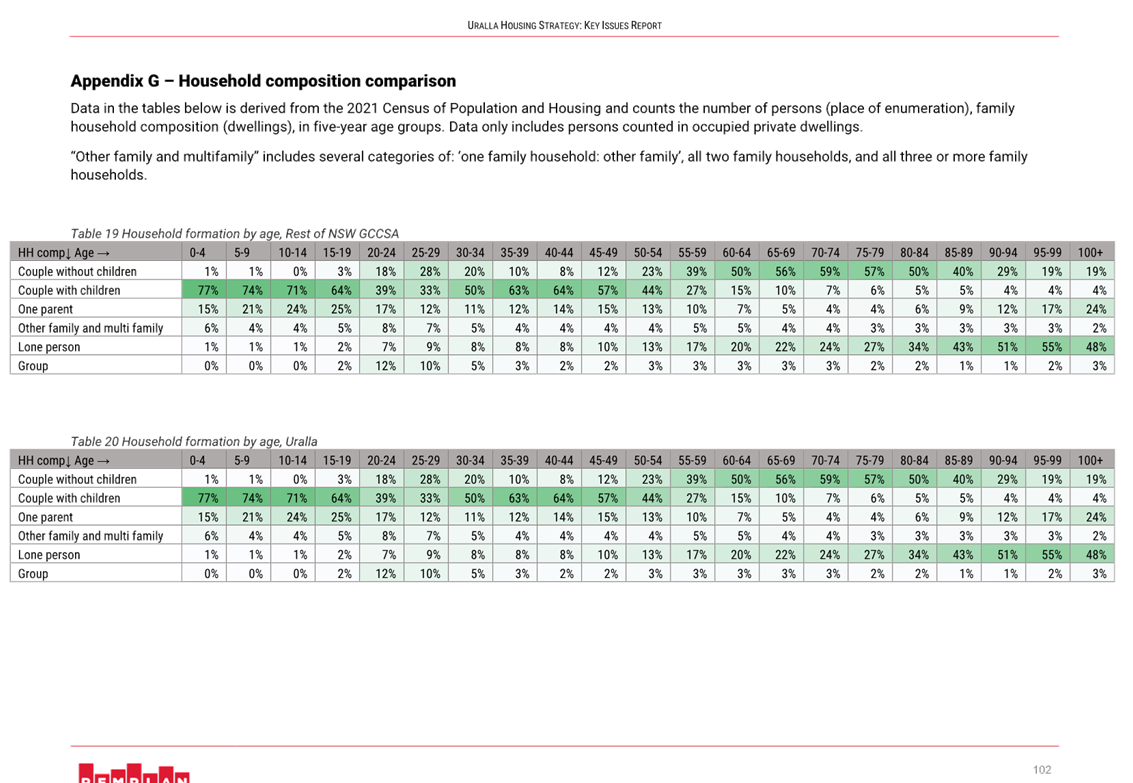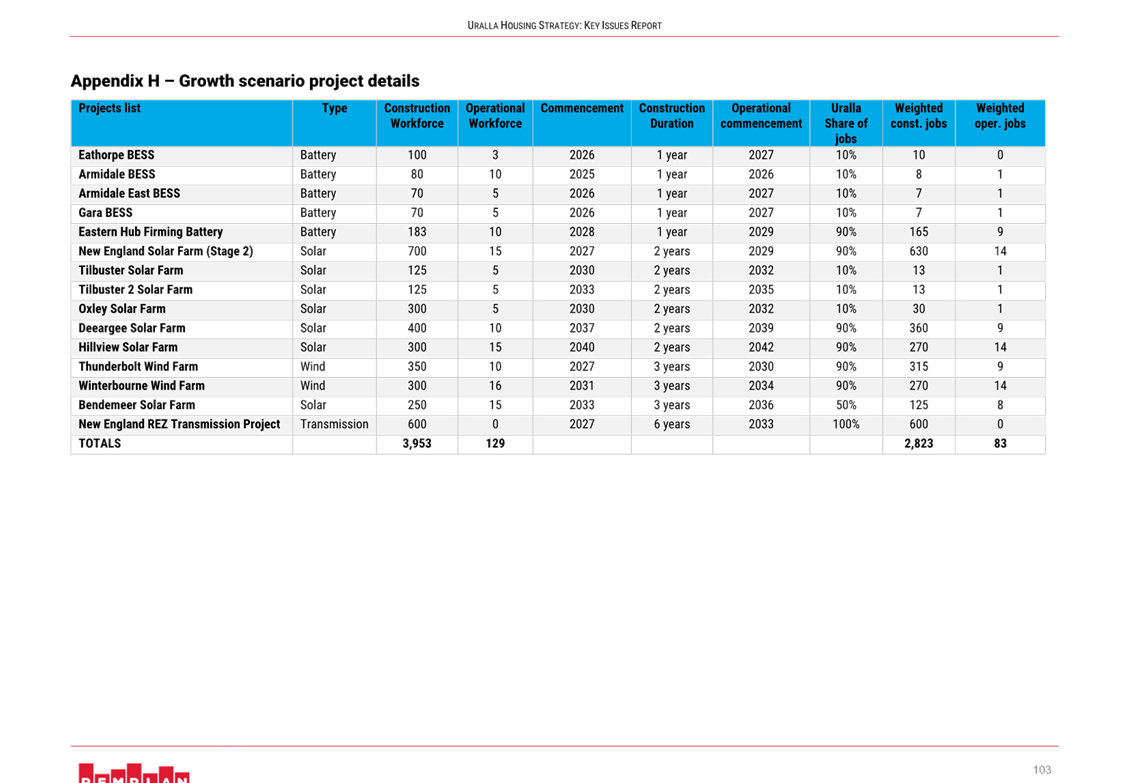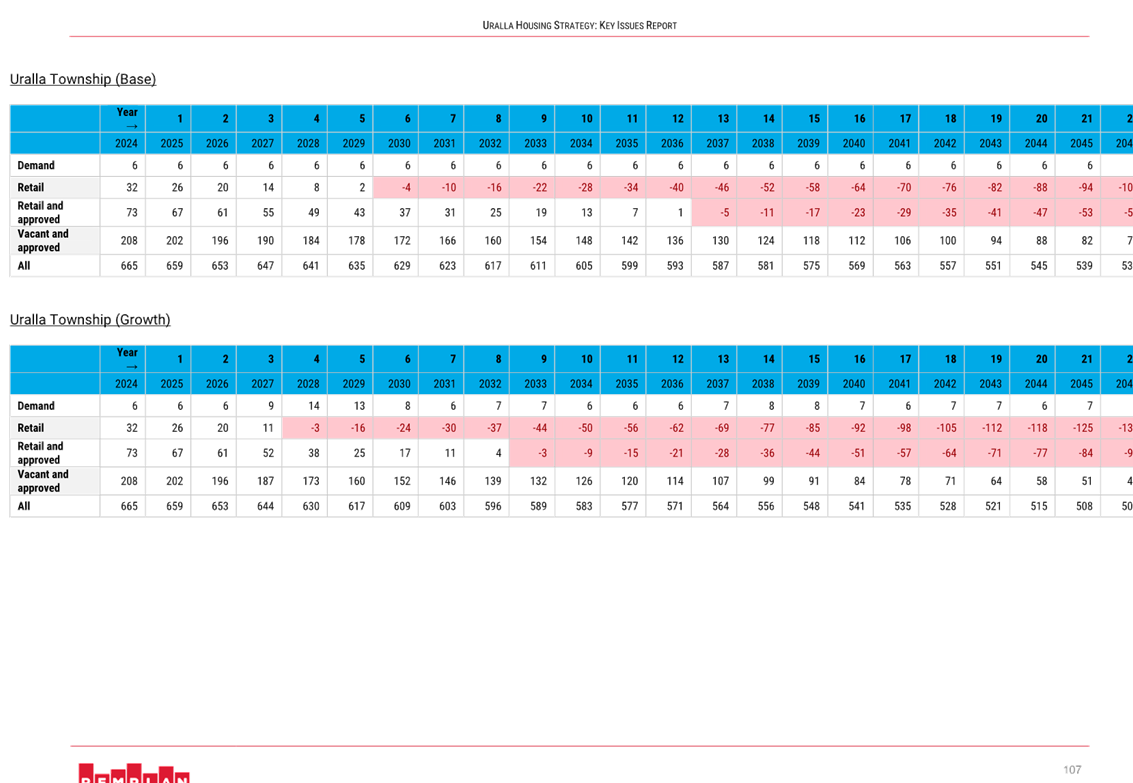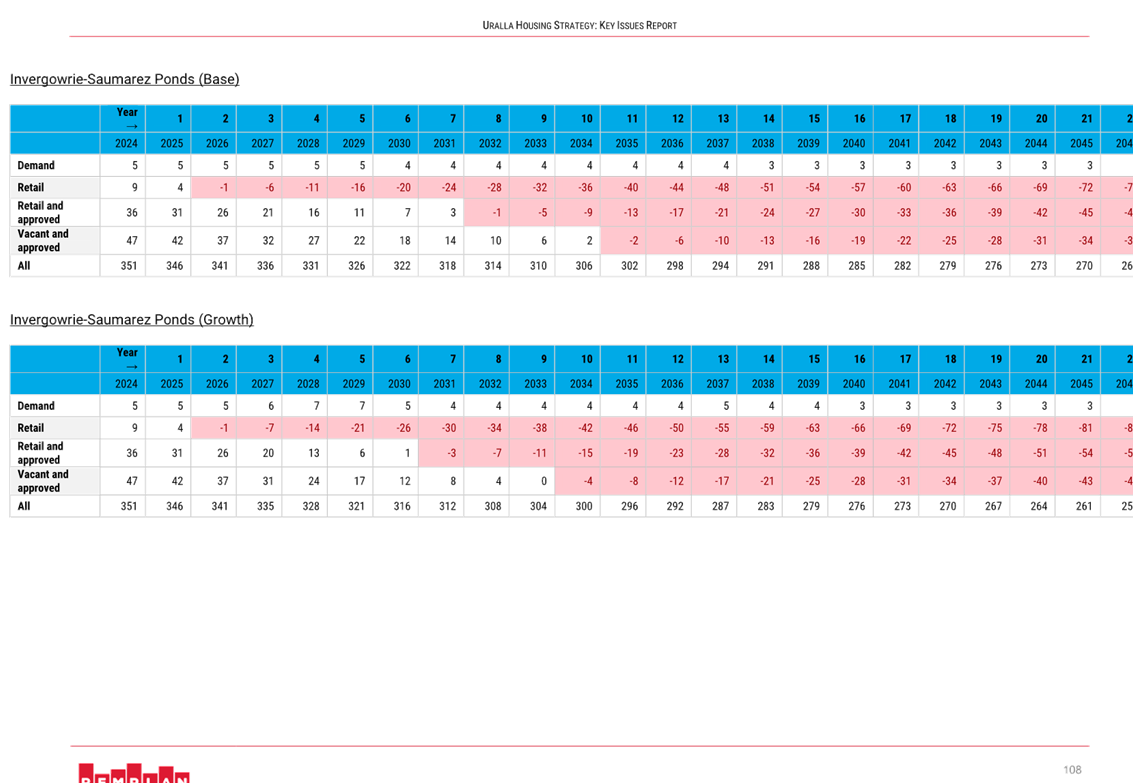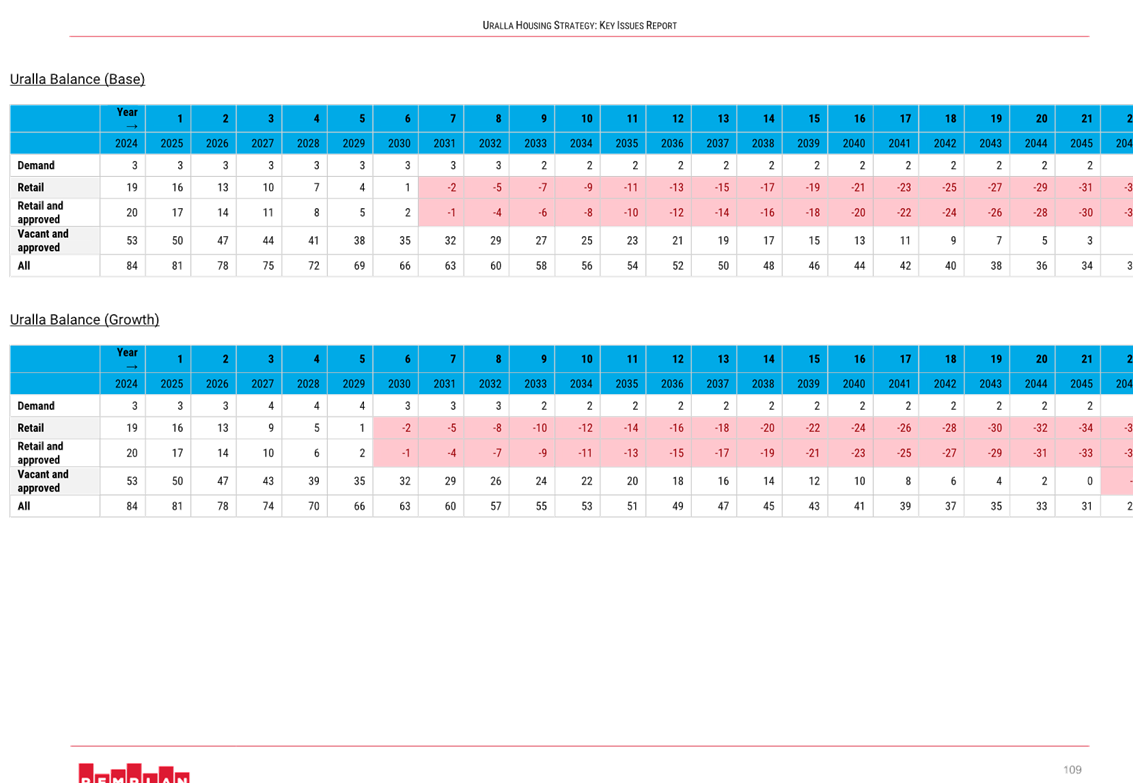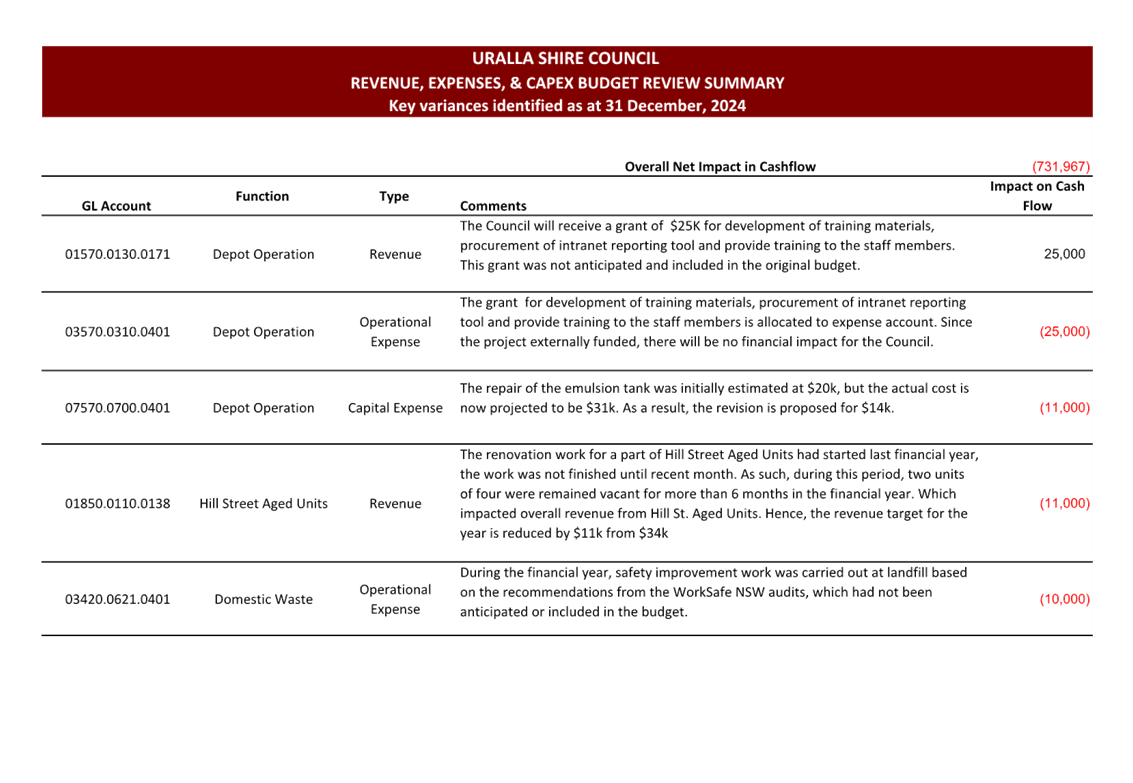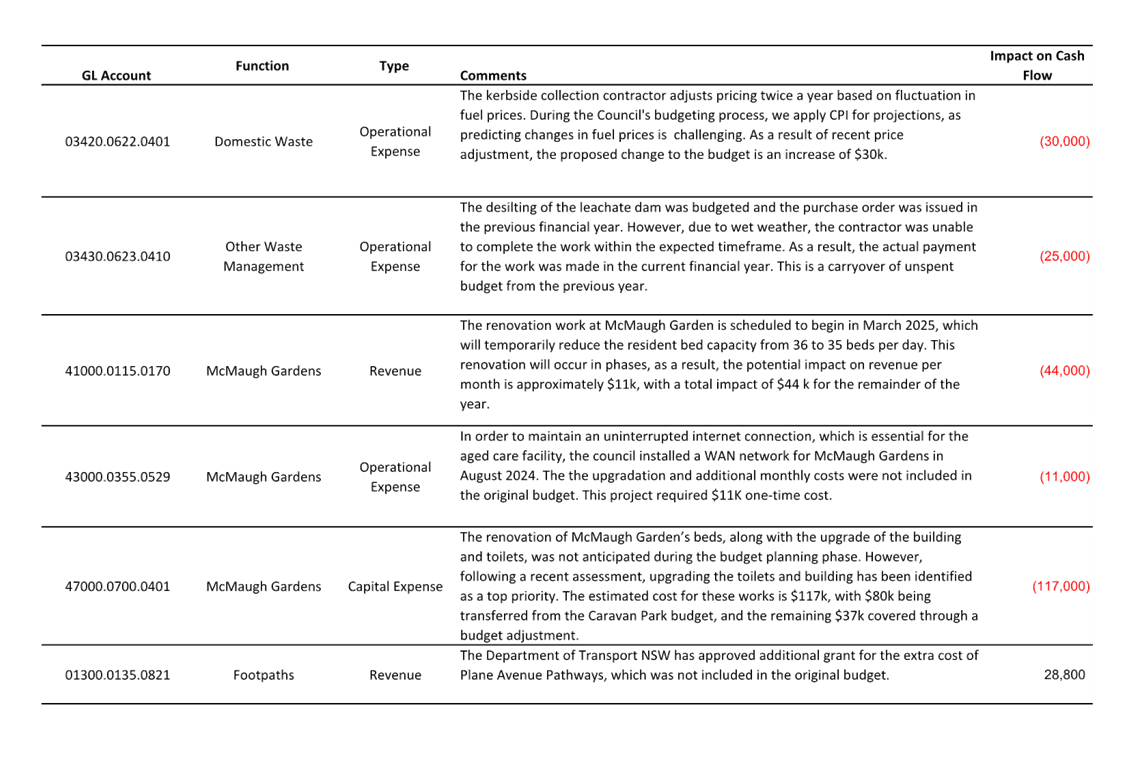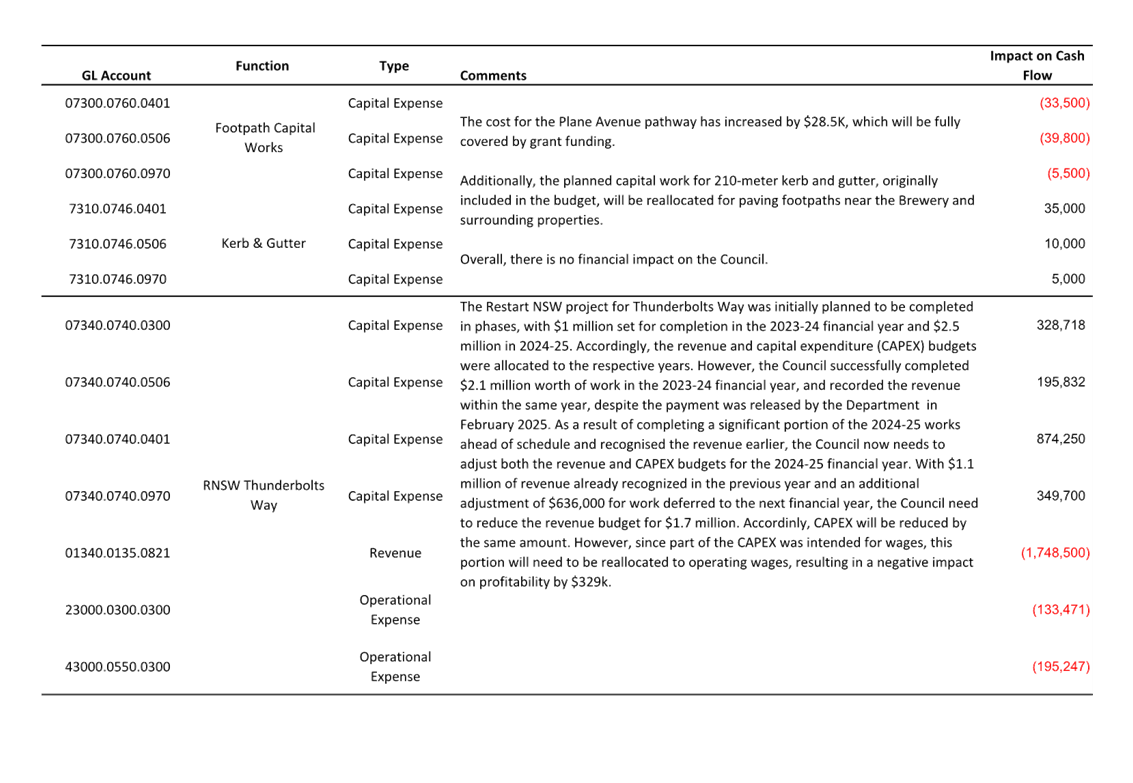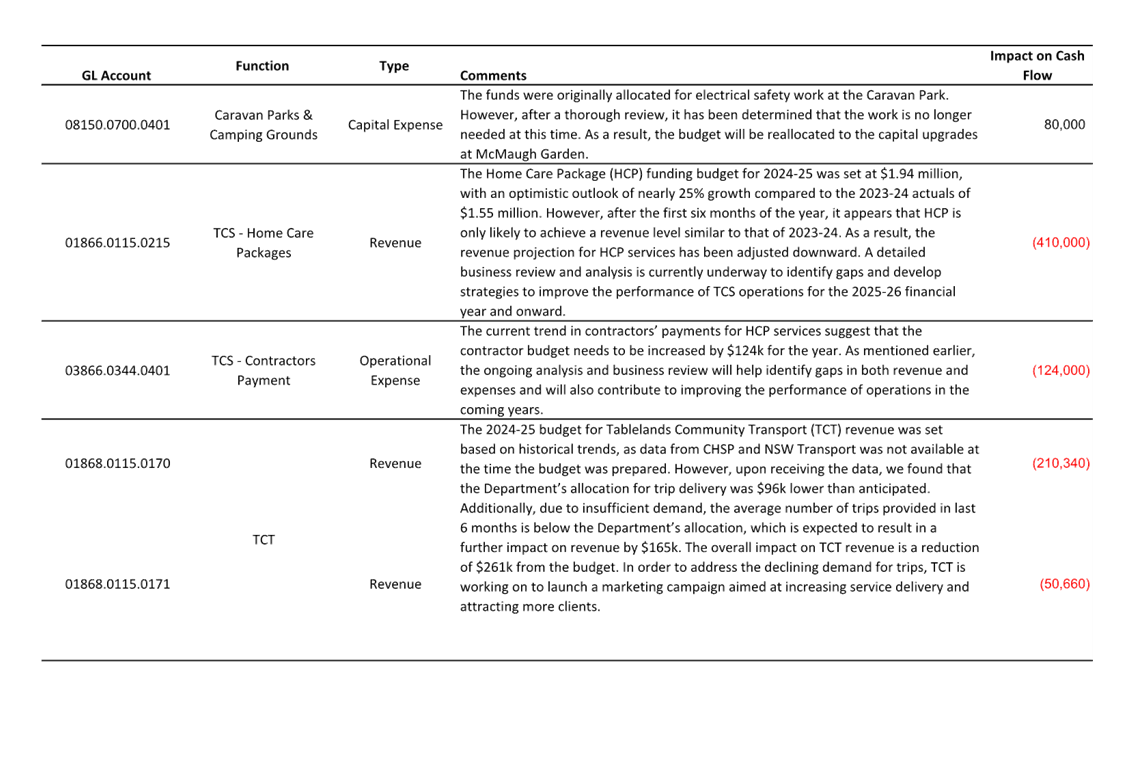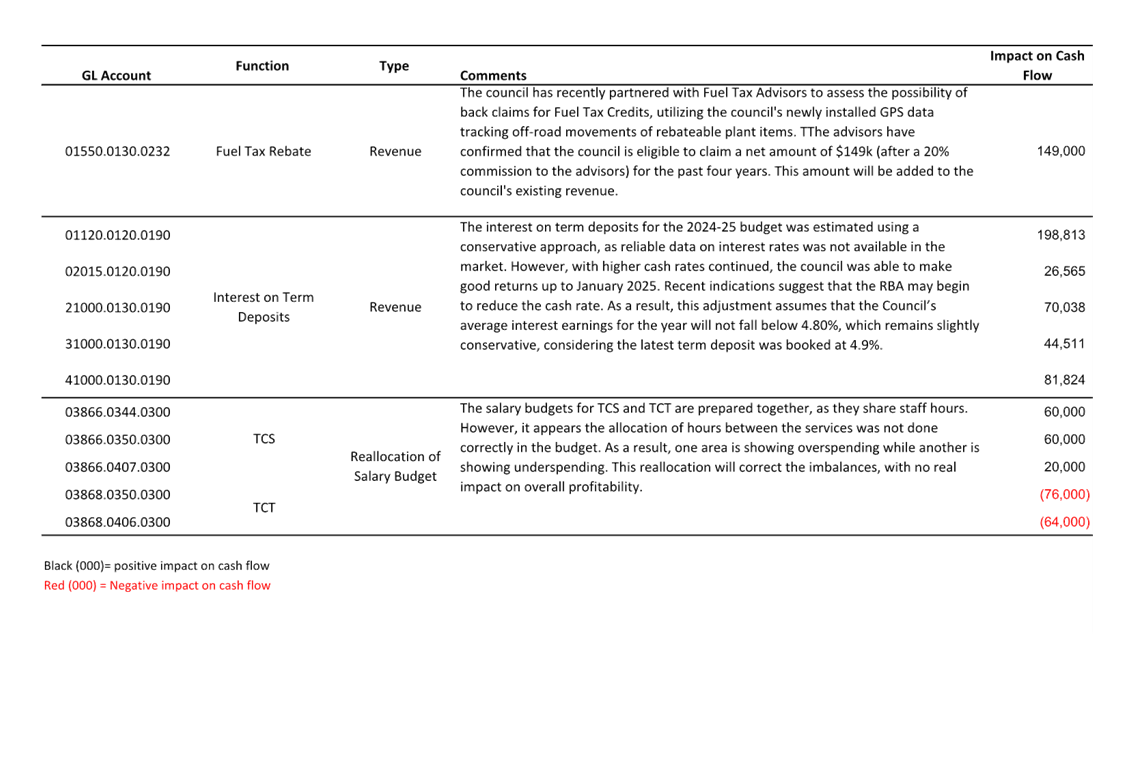|

|
|
Agenda & Business
PAPERS
|
|
Notice is hereby given, in accordance with the
provision of the Local Government Act 1993 that a meeting of Uralla
Shire Council will be held in the Council Chambers, 32 Salisbury Street,
Uralla.
|
|
Ordinary Council Meeting
25 February 2025
|
|
Commencing at 4:00 PM
|
|

|
|
Statement of Ethical Obligations
The Mayor and Councillors are bound by the Oath/ Affirmation of
Office made at the start of the Council term to undertake their civic duties
in the best interests of the people of Uralla Shire and to faithfully and
impartially carry out the functions, powers, authorities and discretions
vested in them under the Local Government Act or any other Act, to the
best of their skill and judgement.
It is also a requirement
that the Mayor and Councillors disclose conflicts of interest in relation to
items listed for consideration on the Agenda or which are considered at this
meeting in accordance with Council’s Code of Conduct and Code of
Meeting Practice.
|
|
Toni Averay
General
Manager
|
|
Ordinary Council
Meeting Business Agenda
|
25 February 2025
|
7 Confirmation
of Minutes
7.1 Confirmation
of Minutes Ordinary Meeting held 17 December 2024
|
Department:
|
General Manager’s
Office
|
|
Prepared By:
|
Executive Assistant
|
|
Authorised By:
|
General Manager
|
|
Reference:
|
UINT/25/589
|
|
Attachments:
|
1. Minutes
Ordinary Meeting Held 17 December 2024 ⇩ 
|
|
Recommendation
That Council adopts the minutes of the Ordinary Meeting
held 17 December 2024 as a true and correct record.
|
|
Ordinary Council Meeting Business Agenda
|
25 February 2025
|















|
Ordinary Council
Meeting Business Agenda
|
25 February 2025
|
8 Urgent,
Supplementary, and Late Items of Business (Including Petitions)
|
Ordinary Council
Meeting Business Agenda
|
25 February 2025
|
9 Written
Reports from Delegates
9.1 Mayor's
Activity Report for December 2024 & January 2025
|
Department:
|
General Manager’s
Office
|
|
Prepared By:
|
Executive Assistant
|
|
Authorised By:
|
Mayor
|
|
Reference:
|
UINT/25/591
|
|
LINKAGE TO INTEGRATED PLANNING AND REPORTING FRAMEWORK
|
|
Goal:
|
4. We
are an independent shire and well-governed community
|
|
Strategy:
|
4.1. Informed
and collaborative leadership in our community
|
Summary
The Mayor’s Activity Report outlines activities
conducted during the months of December 2024 & January 2025.
|
Recommendation
That Council Receives the Mayor’s Activity report
for December 2024 & January 2025.
|
Report
|
Mayor:
Robert Bell
|
|
Date of
Council Meeting:25 February 2025
|
|
DATE
|
COMMITTEE/MEETING/EVENT
|
LOCATION
|
|
2 Dec 2024
|
Mayor & GM Catch up
|
Uralla
|
|
3 Dec 2024
|
Hunter New England Health
Meeting with Hon Brendan Moylan
|
Online
|
|
3 Dec 2024
|
Information Sessions for
Councillors
|
Uralla
|
|
4 Dec 2024
|
School Presentation –
End of Year Celebration
|
Bundarra Central School
|
|
4 Dec 2024
|
Grace Munro Christmas
Celebration
|
Bundarra
|
|
4 Dec 2024
|
School Presentation –
End of Year Play
|
Uralla St Josephs College
|
|
5 Dec 2024
|
Meeting Hon Brendan Moylan
|
Uralla
|
|
5 Dec 2024
|
School Presentation –
End of Year Celebration
|
Uralla Central School
|
|
5 Dec 2024
|
Christmas Street Fair
Celebration on set up and coordination of the event - afternoon tea
|
Uralla
|
|
7 Dec 2024
|
Fairy Festival
|
Uralla
|
|
9 Dec 2024
|
Mayor & GM Catch up
|
Uralla
|
|
10 Dec 2024
|
Judging Staff Xmas
Decorations
|
Uralla
|
|
11 Dec 2024
|
School Presentation –
End of Year Celebration
|
Kingstown School
|
|
11 Dec 2024
|
McMaugh Gardens Christmas
Party
|
Uralla
|
|
11 Dec 2024
|
SaND Engagement Workshop
|
Court House
|
|
12 Dec 2024
|
Staff Christmas Party
|
Uralla Golf Club
|
|
12 Dec 2024
|
School Presentation –
End of Year Celebration
|
Kentucky School
|
|
16 Dec 2024
|
Mayor & GM Catch up
|
Uralla
|
|
17 Dec 2024
|
Service Awards for Staff
|
Uralla
|
|
17 Dec 2024
|
Ordinary Council Meeting
|
Uralla
|
|
17 Dec 2024
|
End of Year Dinner for
Councillors
|
Uralla
|
|
19 Dec 2024
|
DPHI REZ Meeting
|
Online
|
|
|
|
|
|
7 Jan 2025
|
Meeting with GM
|
Uralla
|
|
8 Jan 2025
|
Australia Day Committee
Meeting
|
Uralla
|
|
9 Jan 2025
|
Meeting with GM/Group
Manager – discussion on Bundarra Water
|
Uralla
|
|
13 Jan 2025
|
Mayor & GM Catch up
|
Uralla
|
|
15 Jan 2025
|
2AD Interview
|
Online
|
|
20 Jan 2025
|
Presentation Dam Survey
– Znet
|
Court House
|
|
21 Jan 2025
|
Regional Community
Consultation Standards Bill workshop – University of Sydney
|
Narrabri
|
|
21 Jan 2025
|
Geni-Energy Meeting
|
Narrabri
|
|
22 Jan 2025
|
Information Session for
Councillors - LTFP
|
Uralla
|
|
26 Jan 2025
|
Australia Day Awards &
Activities
|
Alma Park Uralla
|
|
27 Jan 2025
|
Mayor & GM Catch up
|
Uralla
|
|
29 Jan 2025
|
2AD Interview
|
Online
|
|
29 Jan 2025
|
Meeting Hon Brendan Moylan
|
Uralla
|
|
Ordinary Council
Meeting Business Agenda
|
25 February 2025
|
10 Public Forum
11 Mayoral
Minute
11.1 Mayoral
Minute - Uralla Shire Christmas Day Community Lunch 2024 at McCrossin's Mill
SUMMARY
The first ever Uralla Shire Christmas
Day Community Lunch was held on Christmas Day 2024 at McCrossin’s Mill.
The event was organised by a small group of Uralla Shire residents with the
goal of ensuring that everyone in our community had an opportunity to share in the
fellowship and joy of Christmas with friends, both old and new.
|
Recommendation
That Council receives this Mayoral Minute and
congratulates the organisers and generous sponsors of the inaugural Uralla
Shire Christmas Day Community Lunch.
|
Report
The 2024 Christmas season showcased
the Uralla Shire community spirit, marked by several firsts. Our inaugural
Christmas Street Fair Was a huge success and a great event enjoyed by visitors
and locals alike. This was followed by the first ever Christmas Day Community
Lunch held on Christmas day at McCrossins Mill and attended by 85 people, with a
further five Christmas lunches home delivered.
The lunch was the brainchild of
our wonderful librarian, Amanda Williams who, with the help of a small group of
locals, rallied support from community groups and businesses alike to make
the Community Lunch a reality. A big thank you to the committee organisers:
Amanda and Steve Williams, Annie Mayo, Carol Barnden, Emily Sims, Julianne
Lilly, Helen Vujanovic, Lynne Barnett and Scott Green of ACEN.
A generous donation from ACEN provided
the funding for the event, which the organising committee ensured was spent
almost exclusively with local businesses.
Local businesses Alternate Root,
Foodworks, Bling & Things, Moons Bakery, The Lolly Shop, Seasons of New
England, Thunder Graphics and Rapid Clean New England all went over and above
to make the day as special as possible.
Remarkably more than 30 volunteers
attended on the day to provide the lunch, with even more turning up “just
in case”. In addition, community stalwarts Uralla Neighbourhood Centre,
CWA and McCrossin’s Mill all provided invaluable input and support for
the day.
The organising committee found
were overwhelmed and humbled by the outstanding support provided for the event.
The event truly captured the spirit of Christmas!
We are incredibly proud of our
residents and businesses in Uralla Shire for their continued support of
community events and the general wellbeing of our residents.
On behalf of the Council, I extend
our heartfelt thanks to everyone for their support, time, and effort.
Mayor
Robert Bell
11.2 Mayoral
Minute - Cost Shifting onto Local Government
This Mayoral Minute discusses the impact of continuous cost
shifting by other levels of government on local government.
The pressure on councils to continue to provide services of
appropriate standard to our communities is now extraordinary.
The unrelenting growth in cost shifting to councils, coupled
with rate pegging, is increasingly eroding any possibility of financially sustainable
local government, and risking the capacity of councils to deliver tailored,
grassroots services to their communities and properly deliver and maintain
vital local infrastructure.
|
Recommendation
That Council
1. Receives
and notes the findings of the LGNSW Cost Shifting report for the 2021/2022
financial year.
2. Places
a copy of the cost shifting report on Council’s website so that our
communities can access it.
3. Writes
to the Premier, the NSW Treasurer and the NSW Minister for Local Government
seeking that they urgently address these costs through a combination of
regulatory reform, budgetary provision, and appropriate funding.
|
Report
Alarmingly, the latest research commissioned by Local
Government NSW (LGNSW) shows that the increase in cost shifting has been
accelerated by various NSW Government policies.
A comprehensive cost shifting report produced by independent
consultants Morrison Low on behalf of LGNSW for the 2021/2022 financial year
found that an amount of $1.36 billion of expense has been passed onto councils
to fund: ML_Report-LGNSW-Annual_Cost_Shifting.pdf. This
is an increase of $540 million since the last report from the 2017/2018
financial year and represents lost services, lost opportunity and lost amenity
for residents and businesses.
A further cost shifting review by LGNSW for the year 2023
has made similar findings: Cost_Shifting_flyer.pdf (lgnsw.org.au)
On average, this represents an additional cost of $460.67
for every ratepayer across the state.
With councils having to fund this ongoing subsidy for the
State Government each and every year it means our communities get less or go
without. They go without better roads, they go without better parks, they go
without important community services that only councils provide, and they and
their ratepayers are effectively paying hidden taxes to other levels of
government.
Councillors, our communities deserve better and this must
stop. Prior to the most recent state election the then Minns Opposition wrote
to LGNSW acknowledging that cost shifting had undermined the financial
sustainability of the local government sector.
Uralla Shire Council’s key issues to consider include:
· our massive roads
maintenance responsibility
· the burden of
regional roads
· the need for
urgent reclassification of Thunderbolts Way
· renewal and
depreciation
· provision of
critical community services in a financially sustainable manner e.g. aged care
and direct care even though not technically ‘core’ local government
services
o Waste levies
o Rate exemptions
o Regulatory functions
o Emergency services
contributions
o Libraries
funding
The above equates to $591 per
ratepayer per year in rural areas.
· continued
devolution of State functions or an absence of monitoring and regulation; for
example, management of irrigators and their water licences in a rural context.
For Uralla Shire Council the funding limitations include:
· the challenges
created by the capping of rates
· caps imposed by
the State government on development fees and animal registration fees
· State levies eg
dam levy from 1 July 2025, and pending Cemetery levy
· increasing
legislative, governance and financial auditing requirements and costs
Conclusion
Now in 2025, it is important to councils and communities
that the NSW Government urgently addresses cost shifting through a combination
of regulatory reform, budgetary provision and appropriate funding.
12 Notice of
Motion/Questions with Notice
Nil
13 Report
of Committees
Nil
14 Reports
to Council
14.1 Councillor
Representative Report - Bundarra Community Meeting 12 February 2025
|
Department:
|
Infrastructure &
Development
|
|
Prepared By:
|
Director Infrastructure &
Development
|
|
Authorised By:
|
General Manager
|
|
Reference:
|
UINT/25/1843
|
|
Attachments:
|
1. Meeting
Minutes – Council / Bundarra Community - 12 February 2025 - BSofA ⇩ 
|
|
LINKAGE TO INTEGRATED PLANNING AND REPORTING FRAMEWORK
|
|
Goal:
|
1. We
have an accessible inclusive and sustainable community
4. We
are an independent shire and well-governed community
|
|
Strategy:
|
1.1. A
growing community with an active volunteer base and participation in
community events
1.2. A
safe, active and healthy shire
4.1. Informed
and collaborative leadership in our community
4.2. A
strategic, accountable and representative Council
|
Summary
Council’s previously appointed Bundarra
School of Arts Community Consultative 355 Committee ceased its tenure on 14
December 2024. In consideration of the future, Council determined that it would
pursue the reestablishment of the Committee and appointed two Councillor
Representatives for that purpose.
To that end a meeting was arranged with the
broader Bundarra community on Wednesday 12 February 2025 to explore options for
the reinstatement of a Bundarra 355 Committee.
The meeting was well attended with three
councillor representatives, the General Manager, and the Director
Infrastructure and Planning along with 11 community members.
This report provides feedback from
the community meeting held on 12 February 2025 and recommends that Council
continues with the reestablishment process, and in the immediate instance
continues to consult with the Bundarra community before conclusively reporting
back to Council with a recommendation at the earliest possible time.
|
Recommendation
That Council notes the
report.
|
Report
Community Meeting of 12 February 2025
A community meeting was arranged at the Bundarra School of
Arts for Wednesday 12 February 2025 and was promulgated via direct councillor
and staff contact with specific community contacts, the posting of notices
locally, and a letterbox drop of approximately 200 properties.
The effort was rewarded with the attendance of 11 interested
community members comprising: John Layton, Therese Layton, Bec McLean, Lindsay
Growth, Angela Iskov, Ruth Deaves , Jennifer Dezius, Jeffery Dezius, Peter
Gregory, Trent Gregory, and Jackie Stibbard. Three Councillor representatives
(Leanne Doran, Jen Philp and Adam Blakester) and two Council staff members (GM
and DID) also attended the meeting.
Apologies were received from Max Fitzgerald, Amy Lleyton,
Tanya Swan, Darren Swan, Margie Doak, Bill Doak and Matthew Monk.
The Agenda opened discussions regarding:
· The
reestablishment of a Bundarra specific 355 Committee, with a broader role
focussed on the community as a whole as well as the Arts Hall;
· Councillors and
staff provided a high-level overview of Council’s priorities of the
coming terms;
· A discussion
regarding issues and priorities for the Bundarra community; and
· A request from
Council that attending community members consider applying for membership of a
future Bundarra 355 Committee.
The following Bundarra issues were raised by attending
community members:
● Caravan Park –
indicative comments: “caravan park has gone downhill” –
“poor signage and collection of fees” –
“squatters”.
● Emu Crossing -
“squatter” - toilets and signage for honesty box - Septic tank is
smelly and could do with a pump-out
● Sewerage Pond –
“odour issues” - “recurring issue used to be associated with
the change of seasons” – “now becoming more common”.
● Bringing people back to Bundarra – “festivals and events” - markets -
employment - business - tourism
● Policing - no Police
in town - anti-social behaviour
● Footpath issues
– “footpaths are a priority” - hospital corner up two streets
towards the Club and school to pub – “Bundarra is a poor cousin to
Uralla” – “grants are redirected to the Uralla
township”.
● Waste transfer station –
“used to be open 4 days now only 3 days” – “skip bins
full” – “not in the right place and difficult to manoeuvre
within the site”.
● Other general items raised -
- Public toilets
- Bakers Creek Crossing
- Stolen lights and solar
panels at skate park
- Services sign at entrance
to town out of date
- $27k RTC funds - reserve
awaiting decision from the community about what to spend that money on
Items raised previously and still outstanding:
- Jeff Dezius’ letter (November 24) regarding illegal
dumping and other issues
- Street tree planting
- Public toilets
- Earmarking donations for use on local community priorities
- Sports Club water meter relocation & excessive usage
charges due to unknown leak
Future Intentions
It is proposed that a further community meeting take place
in March 2025 to build upon the progress made at the recent meeting. The
proposed March meeting can explore further the types and levels of Council/community
engagement which would be most productive for Bundarra. This would then inform
the nature and scope (Terms of Reference) of a future 355 Committee in
Bundarra.
At the time of writing four (4) Expressions of Interest for
Membership of a future Bundarra 355 Committee have been received from:
1. R. McLean
2. L. Growth
3. J. Stibbard
4. S.L. Johnson
Conclusion
A highly productive community meeting was held in Bundarra
on 12 February 2025. This report provides a broad outline of that meeting and recommends
that Council continue to pursue the reestablishment of a Bundarra-based 355
Committee.
Council Implications
Community Engagement/Communication
Community will be informed of Council’s decision and
future intentions.
Policy and Regulation
Previous S355 Bundarra School of Arts Community
Consultative Committee Terms of Reference 2022
Local Government Act 1993; section 355
Financial/Long Term Financial Plan
N/A
Asset Management/Asset Management Strategy
N/A
Workforce/Workforce Management Strategy
N/A
Legal and Risk Management
N/A
Performance Measures
N/A
Project Management
Infrastructure & Development Directorate


|
Ordinary Council
Meeting Business Agenda
|
25 February 2025
|
14.2 DA-44-2024
- Alterations and additons to existing building, extension of existing carpark
and associated work - 52 Hill Street Uralla
|
Department:
|
Infrastructure &
Development
|
|
Prepared By:
|
Acting Manager Planning Development
|
|
Authorised By:
|
Director Infrastructure & Development
|
|
Reference:
|
UINT/25/2772
|
|
Attachments:
|
1. Plans
of Development ⇩ 
2. Submission
(thread, including negotiations) ⇩ 
3. Draft
Notice of Determination ⇩ 
|
|
LINKAGE TO INTEGRATED PLANNING AND REPORTING FRAMEWORK
|
|
Goal:
|
3. We
are good custodians of our environment
|
|
Strategy:
|
3.2. Maintain
a healthy balance between development and the environment
|
Note to Councillors
In accordance with the provisions of S375A of the Local
Government Act 1993, a Division is to be called whenever a motion for a
planning decision is put to the meeting, for the purpose of recording voting on
planning matters.
Development applications require a decision of Council
which MUST be either:
· Approval with conditions (to be prepared by the Manager
Development and Planning) OR
· Refusal with reasons.
Summary
Council has received a Development Application for
Alterations and additions, extension of carpark and associated work at 52 Hill
Street, Uralla.
The land is zoned RE2 (Private Recreation) and R1 (General
Residential) under the Uralla LEP 2012 and contains the Uralla Bowling Club.
The application has been referred to the Council for
determination given one (1) submission was received and there is public
interest in the proposal.
An assessment of the proposal under Section 4.15 of the
Environmental Planning and Assessment Act 1979 demonstrates that within the
limits of the matters for consideration, the proposed development (as amended)
achieves satisfactory compliance with relevant Environmental Planning
Instruments and the Uralla Development Control Plan 2012 and is therefore
recommended to be approved subject to conditions.
|
Recommendation
1. That
Council approves the Development Application (ref: DA-44-2024) for
Alterations and additions, extension of carpark and associated work at Lot A DP759022,
Lot 2 DP36806, Lot 1 DP368065 and Lots 4 – 6 DP 759022, land known as
52 Hill Street URALLA, subject to the conditions of consent in the attached
Notice of Determination.
2. That
Council notes the submission received in response to notification of the
Development Application.
|
Report
Description of Site and
Surrounding Area
The subject site is known as 52
Hill Street, and legally described as Lot A DP759022, Lot 2 DP36806, Lot 1
DP368065 and Lots 4 – 6 DP 759022.
The subject site is located
on the corner of Hill and Queen Streets, and has the following characteristics:
- Contains
existing Bowling Club, with greens located at the eastern side of the land, car
parking area at the west and main building located centrally.
- Access
is provided from Hill Street.
- Land is
a mix of RE2 (Private Recreation) and R1 (General Residential) under the Uralla
LEP 2012.
- Site
slopes from east to west, with Uralla and Rocky Creeks affecting the land,
however not impacting the development footprint.
- Flooding
aside, no other planning constraints are noted (not within a Conservation
Area).
- The
land adjoins a dwelling to the south, however by virtue of Rocky Creek and
corner location, no other dwellings are in proximity to the balance of the
site.
In the context of the proposal, no
other matters require noting.

Figure 1: Site
location and context (SixMaps)

Figure 2: Aerial
view showing LEP zoning and Flood Planning Area overlay
Planning History
There is no planning history for the subject site or
neighbouring sites that is relevant to assessment of the application.
Notwithstanding, history is as follows:
· DA-31-2023 –
LED Sign
· DA-18-2021 –
Installation of Flood Lights
· DA-79-2019 –
Solar Installation
· DA-29-2018 –
Solar Installation
· DA-75-2015 –
Signage
· CDC-174-2008
– Kitchen upgrade
· DA-3756-2006/A
– Alterations and additions
· DA-1209-2006
– Bus shed
Description of the
Development
The application seeks consent for alterations and additions,
extension of carpark and associated work consisting of the following:
Internal:
· new
entry, auditorium, verandah and toilets,
· proposed
new auditorium entry, lift and stairs,
· enlarge
& refurbish the kitchen to cater for dining and functions,
· new
kitchen servery,
· new
bowlers' locker room,
· new
alfresco dining area with access from the restaurant, open to bowls green,
· operable
walls to divide the new auditorium into smaller auditoria and meeting rooms.
· children's
playroom, accessed from and visible from the restaurant,
· new
storage area.
External:
Car Parking would increase from approximately 37 spaces to
90 spaces, and extend further west and south than the existing parking
area.
The existing group of tanks, ‘return and earn’
facility, and sheds shall remain. It is unclear whether EV parking shall
remain in the current location, however this is not required to be shown on
plans.
A retaining wall and associated earthworks from part of the
development.
- Ancillary Works
If approved, secondary
permits would be required under:
- Section 68 of the Local
Government Act 1993 (water, sewer and stormwater drainage work)
- Construction Certificate
& Occupation Certificates (for both internal works and parking area).
The development would be
conditioned to also comply with all other relevant acts as necessary.

Figure 3: Site
Plan including proposed landscaping

Figure 4: Site
Plan

Figure 5: Internal
Plan
Notification
In line with Council’s
Community Participation Plan and Development Control Plan, the application was
notified to adjoining occupiers. One (1) properly made submission was received.
The applicant amended plans
following the objection, however Council’s officer considers that Council
determination is appropriate given a theme of the submission may remain
unresolved, and the public interest in the proposal.
Referrals
External
No external referrals required.
· The development is
not classified as integrated development under 4.46 of the Environmental
Planning and Assessment Act 1979.
· The development is
located within 40 metres of Rocky Creek; however, Clause 31 of the Water
Management (General) Regulation 2018 provides an exemption for the development
because the car parking area is between the waterway and the buildings.
· The development
does not require concurrences under any environmental planning instrument. In
particular, the proposal does not warrant referral to Transport for NSW (Hill
Street is a classified road).
Internal
Development Engineer, Building Surveyor, Environmental
Health Officer – No objections, as conditioned.
It is noted that the Building Surveyor has recommended
consolidation of lots and a fire safety report, both which have been included
in the recommended conditions.
ASSESSMENT
Pursuant to Clause 4.15 of the Environmental
Planning and Assessment Act 1979, in determining a development application,
a consent authority is to take into consideration such of the following matters
as are of relevance to the development, the subject of the development
application. These are included below in full, and discussed in more detail
individually through the assessment.
|
(1) Matters for
consideration—general In determining a development
application, a consent authority is to take into consideration such of the
following matters as are of relevance to the development the subject of the
development application—
(a) the
provisions of—
(i) any
environmental planning instrument, and
(ii) any
proposed instrument that is or has been the subject of public consultation
under this Act and that has been notified to the consent authority (unless
the Planning Secretary has notified the consent authority that the making of
the proposed instrument has been deferred indefinitely or has not been
approved), and
(iii) any
development control plan, and
(iiia) any
planning agreement that has been entered into under section 7.4, or any draft
planning agreement that a developer has offered to enter into under section
7.4, and
(iv) the
regulations (to the extent that they prescribe matters for the purposes of
this paragraph),
(v) (Repealed)
that
apply to the land to which the development application relates,
(b) the
likely impacts of that development, including environmental impacts on both
the natural and built environments, and social and economic impacts in the
locality,
(c) the
suitability of the site for the development,
(d) any
submissions made in accordance with this Act or the regulations,
(e) the
public interest.
|
Section 4.15 – Evaluation
|
4.15(1)(a) the provisions of—
|
(i) any environmental planning instrument
|
STATE ENVIRONMENTAL PLANNING POLICIES
State Environmental Planning Policy (Resilience and
Hazard) 2021
Chapter 4 Remediation of Land
Chapter 4 requires Council to consider whether the subject
land of any development application is contaminated. If the land requires
remediation to ensure that it is made suitable for a proposed use or zoning,
Council must be satisfied that the land can and will be remediated before the
land is used for that purpose.
An assessment of the relevant provisions of Chapter 4 of the
SEPP (Reliance and Hazard) 2021 is provided in the table below.
|
Chapter 4
Remediation of Land
|
|
Relevant
Provisions
|
|
Provisions
|
Comment
|
|
4.6 Contamination and remediation to be
considered in determining development application
|
|
(1) A consent
authority must not consent to the carrying out of any development on land
unless—
(a) it has
considered whether the land is contaminated, and
(b) if the land
is contaminated, it is satisfied that the land is suitable in its
contaminated state (or will be suitable, after remediation) for the purpose
for which the development is proposed to be carried out, and
(c) if the land
requires remediation to be made suitable for the purpose for which the
development is proposed to be carried out, it is satisfied that the land will
be remediated before the land is used for that purpose.
|
Council’s officer is
satisfied that the land has not been subject to a previous contaminating use,
including any purpose under Table 1 to the contaminated land planning
guideline.
It is considered that the
proposed development is satisfactory regarding the clause, and has not
warranted submission of a Preliminary Site Investigation as part of the
assessment.
Not other parts of the
clause are considered relevant.
|
State Environmental Planning Policy (Biodiversity and
Conservation) 2021
Chapter 4 – Koala habitat protection 2021
Chapter 4 aims to encourage the conservation of areas of
natural vegetation that provides habitat for koalas to support a permanent
free-living population over their present range and reserve the current trend
of Koala Population decline. An assessment of Chapter 4 of the SEPP
(Biodiversity and Conservation) 2021 is provided in the table below.
|
Chapter 4
Koala Habitat Protection 2021
|
|
Relevant
Provisions
|
|
Provisions
|
Comment
|
|
Part
4.2 Development control of koala habitats
|
|
4.9 Development assessment
process—no approved koala plan of management for land
(1) This section
applies to land to which this Chapter applies if the land—
(a) has an area
of at least 1 hectare (including adjoining land within the same ownership),
and
(b) does not
have an approved koala plan of management applying to the land.
(2) Before a council
may grant consent to a development application for consent to carry out
development on the land, the council must assess whether the development is
likely to have any impact on koalas or koala habitat.
|
The land has an area more
than 1ha.
The SoEE states:
“The location of
the proposed alterations and additions does not propose the removal of will
not require the removal of trees, only some grassland vegetation.
Given the lack of
Eucalypt trees and the surrounding vegetation being predominantly grassland,
and the proposed alterations and additions do not require the removal of any
trees, it is considered that the development is likely to have a low or no
impact on koala habitat. Clause 4.9(3) of the SEPP allows Council to grant
consent without requiring a koala assessment report if the development is
unlikely to have a significant impact on koala feed trees or population, in
this instance, taking into consideration the lack of vegetation and the
existing management practices the likelihood of a significant impact on koala
feeds trees or populations is considered to be low.”
Council’s officer
agrees with the applicant’s findings, and considers the proposal
acceptable in this regard, and without condition or expert report.
|
URALLA LOCAL ENVIRONMENTAL PLAN 2012
The proposal is consistent with the LEP having regard to the
following:
|
Relevant Provisions
|
|
Provisions
|
Comment
|
|
Part 2
Permitted or prohibited development
|
|
2.3 Zone objectives and
Land Use Table
(1) The Land Use
Table at the end of this Part specifies for each zone—
(a) the
objectives for development, and
(b) development
that may be carried out without development consent, and
(c) development
that may be carried out only with development consent, and
(d) development
that is prohibited.
(2) The consent
authority must have regard to the objectives for development in a zone when
determining a development application in respect of land within the zone.
|
RE2 Private Recreation:
Objectives:
• To enable
land to be used for private open space or recreational purposes.
• To provide a
range of recreational settings and activities and compatible land uses.
• To protect
and enhance the natural environment for recreational purposes.
Within the RE2 Zone, a
Bowling Club may be defined as a ‘registered club’ and/or
‘recreational facility (outdoor). Both uses are permissible with
consent within the zone (noted that the proposal does not seek any new use).
The proposal achieves the
objectives for the zone.
R1 General Residential
Objectives:
• To provide
for the housing needs of the community.
• To provide
for a variety of housing types and densities.
• To enable
other land uses that provide facilities or services to meet the day to day
needs of residents.
A car park is not initially
permissible within the zone, however Clause 5.3 of the LEP creates
permissibility and will be discussed further.
The proposal is
inconsistent with the objectives, however in this context this is acceptable
(discussed further within this report).
|
|
2.7 Demolition
requires development consent
The demolition of a
building or work may be carried out only with development consent.
|
Noted, captured in consent.
|
|
Part 4 Principal development standards
|
|
The proposal does not
seek to vary any principle development standards.
|
|
Part
5 Miscellaneous provisions
|
|
5.3 Development near
zone boundaries
|
See discussion at end of
this table.
|
|
5.10 Heritage
conservation
(4) Effect of proposed
development on heritage significance
The consent authority must,
before granting consent under this clause in respect of a heritage item or
heritage conservation area, consider the effect of the proposed development
on the heritage significance of the item or area concerned. This subclause
applies regardless of whether a heritage management document is prepared
under subclause (5) or a heritage conservation management plan is submitted
under subclause (6).
|
The proposal is acceptable
giving bearing to the heritage significance of Alma Park.
|
|
5.21 Flood
planning
(1) The objectives of
this clause are as follows—
(a) to minimise the
flood risk to life and property associated with the use of land,
(b) to allow
development on land that is compatible with the flood function and behaviour
on the land, taking into account projected changes as a result of climate
change,
(c) to avoid adverse
or cumulative impacts on flood behaviour and the environment,
(d) to enable the
safe occupation and efficient evacuation of people in the event of a flood.
(2) Development
consent must not be granted to development on land the consent authority
considers to be within the flood planning area unless the consent authority
is satisfied the development—
(a) is compatible
with the flood function and behaviour on the land, and
(b) will not
adversely affect flood behaviour in a way that results in detrimental
increases in the potential flood affectation of other development or
properties, and
(c) will not
adversely affect the safe occupation and efficient evacuation of people or
exceed the capacity of existing evacuation routes for the surrounding area in
the event of a flood, and
(d) incorporates
appropriate measures to manage risk to life in the event of a flood, and
(e) will not
adversely affect the environment or cause avoidable erosion, siltation,
destruction of riparian vegetation or a reduction in the stability of river
banks or watercourses.
|
Council’s officer is
satisfied that the proposal will have an acceptable flood impact. In this regard,
it is noted that the proposal does not seek to establish any significant
structures within the flood planning area (including car parking).
|
|
Part
6 Additional local provisions
|
|
6.1 Earthworks
(1) The objectives of
this clause are as follows—
(a) to ensure
that earthworks for which development consent is required will not have a
detrimental impact on environmental functions and processes, neighbouring
uses, cultural or heritage items or features of the surrounding land,
(b) to allow earthworks
of a minor nature without requiring separate development consent.
(2) Development
consent is required for earthworks unless—
(a) the
earthworks are exempt development under this Plan or another applicable
environmental planning instrument, or
(b) the
earthworks are ancillary to other development for which development consent
has been given.
(3) Before granting
development consent for earthworks, the consent authority must consider the
following matters—
(a) the likely
disruption of, or any detrimental effect on, existing drainage patterns and
soil stability in the locality,
(b) the effect
of the proposed development on the likely future use or redevelopment of the
land,
(c) the quality
of the fill or the soil to be excavated, or both,
(d) the effect
of the proposed development on the existing and likely amenity of adjoining
properties,
(e) the source
of any fill material and the destination of any excavated material,
(f) the
likelihood of disturbing relics,
(g) the
proximity to and potential for adverse impacts on any watercourse, drinking
water catchment or environmentally sensitive area,
(h) any
appropriate measures proposed to avoid, minimise or mitigate the impacts of
the development.
|
Earthworks will be required
to facilitate the proposal. Council’s officer is satisfied that as
conditioned earthworks would comply with Clause 6.1(3).
|
|
6.4 Essential
services
Development consent must
not be granted to development unless the consent authority is satisfied that
any of the following services that are essential for the proposed development
are available or that adequate arrangements have been made to make them
available when required—
(a) the
supply of water,
(b) the
supply of electricity,
(c) the
disposal and management of sewage,
(d) stormwater
drainage or on-site conservation,
(e) suitable
road access.
|
The site is provided with
relevant essential services. Conditions shall be applied to the reconsent
with respect to stormwater management, which will require consideration given
the increase in impermeable area.
|
Clause 5.3 of Uralla LEP 2012
|
(1) The objective of
this clause is to provide flexibility where the investigation of a site and
its surroundings reveals that a use allowed on the other side of a zone
boundary would enable a more logical and appropriate development of the site
and be compatible with the planning objectives and land uses for the
adjoining zone.
(2) This clause
applies to so much of any land that is within the relevant distance of a
boundary between any 2 zones. The relevant distance is 50 metres.
(3) This clause does
not apply to—
(a) land in Zone
RE1 Public Recreation, Zone C1 National Parks and Nature Reserves, Zone C2
Environmental Conservation, Zone C3 Environmental Management or Zone W1 Natural
Waterways, or
(b) land within
the coastal zone, or
(c) land
proposed to be developed for the purpose of sex services or restricted
premises.
Note—
When this Plan was made it
did not include Zone W1 Natural Waterways.
(4) Despite the provisions
of this Plan relating to the purposes for which development may be carried
out, development consent may be granted to development of land to which this
clause applies for any purpose that may be carried out in the adjoining zone,
but only if the consent authority is satisfied that—
(a) the
development is not inconsistent with the objectives for development in both
zones, and
(b) the carrying
out of the development is desirable due to compatible land use planning,
infrastructure capacity and other planning principles relating to the
efficient and timely development of land.
(5) This clause does
not prescribe a development standard that may be varied under this Plan.
|
A Car Park is:
· not permissible
(or envisaged) within the R1 General Residential zone; and
· is permissible
within the RE2 Private Recreation Zone.
The proposed extended car park is fully within 50m of the
RE2 zone, and is therefore eligible to be considered as permissible, subject to
compliance with Clause 5.3(4), and is acceptable:
· While the proposal
does not further the objectives for the R1 zone, it is also not inconsistent;
and
· Notwithstanding
the R1 zoning of the land, it also is low lying in the relevant area, within
the curtilage of the Bowling Club and constrained in terms of access. It is
therefore reasonable and desirable for the land to be developed in an ancillary
form to support the Bowling Club.
On this basis, application of Clause 5.3 to authorise the
Car Park extension is considered reasonable.
No other aspects of the LEP require discussion.
|
4.15(1)(a) the provisions of—
|
(ii) any proposed instrument that is or has been the
subject of public consultation under this Act and that has been notified to
the consent authority (unless the Planning Secretary has notified the consent
authority that the making of the proposed instrument has been deferred
indefinitely or has not been approved)
|
There are no proposed planning
instruments which are relevant to the assessment of the proposal.
|
4.15(1)(a) the provisions
of—
|
(iii) any
development control plan
|
URALLA DEVELOPMENT CONTROL PLAN 2012
|
Chapter 6 Access and Parking
|
|
Relevant Provisions
|
|
Provisions
|
Comment
|
|
6.4 Access and Traffic Generation
|
|
The potential of a
development to create additional traffic loads on the road network needs to
be assessed.
For smaller developments,
there is unlikely to be any appreciable impact, and it will be sufficient to
ensure that safe access (road connection and footpath crossing) is provided
as required.
|
The proposal would not
cause any material/appreciable impact on the road network. It is not
considered that any upgrades to the existing crossover are required as part
of this consent.
|
|
6.5 Parking
Requirements
|
|
• The provisions of
this chapter will be applied to new development. The provisions of this
chapter will also be applied to the extension of an existing building
or works as if it were an independent development;
• Off-street car
parking provision now provided to existing developments shall be retained.
Additional parking spaces required for any new development or redevelopment
shall comply with the provisions of this chapter;
• In the case of a
change in the use of an existing building, Council will apply the provisions
of this DCP if it considers that the proposed new use will produce a
substantially different parking requirement than those attributable to the
existing use
• The total number of
on-site parking spaces provided in association with new development shall be
in accordance with the recommended ratios set out in this Chapter as
appropriate, subject to any qualifications or exceptions which may be
applicable in the circumstances of the case. In this regard parking proposals
that provide less parking than required by this Chapter shall be supported by
a parking study. (Note the specific definition of Gross Leasable Floor Area
in the notes to the Standard of Provision Table below.); and
• In the event of a
conflict between this chapter and an Australian Standard, the Australian
Standard (AS 2890) shall prevail
|
Noted
|
|
|
|
Aims
• To provide
accessible car parks; and
• To provide
sufficient car parks to serve the needs of particular developments.
Acceptable Solutions
Council will require the
provision of on-site car parking at the rate set out in
• 6.3 for any
particular type or category of development;
• Car parking is
provided on the site of the development;
• The layout and
dimensions of car parking areas is in accordance with the design standards
and principles as set out in Appendix B;
• Provision of car
parks for people with disabilities shall be in accordance with AS 2890.6
(2009);
• All required car
parking areas, driveways, turning areas and loading areas are paved in either
a bitumen seal coat, asphaltic or bituminous concrete, cement concrete,
concrete paving blocks, or brick paving blocks. Note: The standard of paving
required will be dependent upon the type of development proposed, with regard
to traffic loadings including turning movements of heavy vehicles;
• All parking spaces
shall be suitably marked by lines, or indicated by other approved means; and
• Free and
uninterrupted access to car parking areas shall be maintained at all times.
|
The proposal meets the
acceptable solutions, through provision of 90 car parking spaces (increase of
approximately 53 spaces), which comfortably complies with Table 6.1,
requiring 30 spaces per green. It is noted that in this regard, the
proposal will rectify an existing non-compliance.
It is noted that Licensed
hotels, clubs and restaurants require parking at a rate of:
· 1 space per guest room or unit, plus
· 1 space for manager, plus
· 1 space per 7.5 square metres of bar, lounge,
restaurant service areas.
It is also noted that the
proposal also includes:
· Auditorium (180 seat capacity)
· Restaurant (100-110 capacity)
While these uses
aren’t expressly captured in the “bowling green” rates,
Council’s officer is satisfied that they are ancillary uses in nature,
and the proposed car parking will comfortably site these uses (also bearing
in mind any existing non-conformance, and the conducive extent of on street
parking and internal overflow areas).
Furthermore, explanatory
note 5 is applicable to the proposal. While there is no expressed rate for a
function room, it is unlikely that it would be in operation at full capacity,
at the same time as greens and restaurant being also at full capacity.
5. The parking provision
for restaurants and function rooms may be reduced where it is
demonstrated that the time of peak demand for parking associated with
each facility does not coincide or where common usage reduces total
demand. Each case will be considered on its individual merits.
All other aspects are
satisfied by recommended conditions of consent.
|
|
Chapter 11 Floodplain Development
and Management
|
|
Relevant Provisions
|
|
Provisions
|
Comment
|
|
11.7 Performance Outcomes
|
|
• Development is
consistent with the principles of the NSW Floodplain Development Manual and
the Uralla LEP;
• Development does
not materially increase the risk to life; and
• New development
occurs at or above the relevant flood planning level for area.
|
It is noted that the
proposed work (including car park) are not within the flood planning area.
The proposal is inherently
compliant with the Performance Outcomes.
|
|
Chapter 13 Notification Procedures
|
|
Relevant Provisions
|
|
Provisions
|
Comment
|
|
13. 4 Notifying of Applications
|
|
Adjoining landowners will
be given notice of an application if, in the opinion of Council, the
enjoyment of land adjoining the development may be detrimentally affected by
the proposed development…
|
The application has been
notified, in line with the Chapter.
|
|
13.8 Amendments prior to Determination.
|
|
An applicant may make amendments
to an application at any time before its determination, subject to
Council’s acceptance of those amendments. In these circumstances,
Council will re-notify:
• Those persons who
made submissions on the original application; and
• Any persons who own
adjoining or neighbouring land (including those persons who were previously
notified of the application) who may in Council’s opinion potentially
be detrimentally affected by the proposal as amended.
|
Amendments to the
application were notified to the submitter.
|
|
13.9
Notification Period
|
|
|
A person may
inspect a plan and make a submission within the notification period which
will be a minimum of 14 days.
|
The period has
complied with the requirement.
|
|
13.10
Consideration of Submissions
|
|
Council will consider
all submissions received within the specified time period before determining
a Development Application. In making a determination the content of a
submission must be balanced with the Council’s statutory obligations.
Submissions form a part of the assessment of an application and each
application will be assessed on its merits.
When
determining a development application, Council will take into consideration
any submissions it has received during the notification period. Delegated
authority will not be used to determine a development application that has
received a written objection to the proposal. Development applications that
have had a written objection submitted will be referred to the relevant
standing Council Committee for comment prior to being referred to Council for
determination discussion.
Applicant to
be advised of Objections
Written
submissions cannot remain confidential as they may be used to assist in
negotiations with the owner/applicant of the proposal or be included in
Council business papers. The applicant, on request, will be advised of the
terms of any objection and is entitled to read all submissions received.
Where applications are amended in response to objections received, comments
may be sought from previous objector/s.
Notification
of Determination
Following
determination of an application each person who made a submission will be
advised in writing of Council’s decision in determining an application
as soon as practical.
|
The assessment
of the proposal (and further steps) have complied with these provisions.
|
|
Chapter 14 Contaminated Land
|
|
Relevant Provisions
|
|
Provisions
|
Comment
|
|
14.6 Acceptable Solutions
|
|
Not discussed due to
duplication with earlier comments under State Environmental Planning Policy
(Resilience and Hazard) 2021
|
See comments under State
Environmental Planning Policy (Resilience and Hazard) 2021 assessment.
|
|
4.15(1)(a) the provisions
of—
|
(iiia) any planning
agreement that has been entered into under section 7.4, or any draft planning
agreement that a developer has offered to enter into under section 7.4
|
No planning agreement has been offered or entered into
relating to the site.
|
4.15(1)(a) the provisions
of—
|
(iv) the regulations
(to the extent that they prescribe matters for the purposes of this paragraph)
|
The regulations (clauses 61 – 64) do not impose any
particular requirements regarding the development.
|
4.15(1)(b) -
|
the likely impacts of that
development, including environmental impacts on both the natural and built environments,
and social and economic impacts in the locality
|
The proposal is considered to have acceptable impacts, as
follows:
|
Environmental Impacts – Built Environment
|
|
The
proposal is considered to have an acceptable impact on the built environment,
as follows:
- The proposed extension is of an acceptable bulk and
scale, and would fit comfortably within the site and away from adjoining
occupiers.
- The proposed extension would not cause any material
impact on the street scene or setting generally.
- Car park works are suitably located and subordinate
within the site.
|
|
Environmental Impacts – Natural Environment
|
|
As conditioned, the proposal would not cause any
material harm to the natural environment.
|
|
Social and
Economic Impacts
|
|
Following submission of
amended plans and subject to recommended conditons, the proposal would not
cause any material adverse social or economic impacts.
|
|
4.15(1)(c) -
|
the suitability of the
site for the development
|
The site is conducive to the proposed development, and is not
affected by any constraints which would
Preclude the development.
Refer to earlier comments under the LEP discussion regarding
essential services.
|
4.15(1)(d) -
|
(d) any submissions made in accordance
with this Act or the regulations
|
- At the
time of preparing this report, One (1) written submission was received on 17
November 2024. The applicant was advised of the submission.
- Amended
plans provided by applicant 4 January 2025, and provided to the submitter on 13
January 2025.
- The
submitter provided further comments 18 January 2025.
|
Theme
|
Further Details
|
Officer Response
|
|
Neighbouring amenity &
safety
|
1. Light spill towards
submitter’s property from internal vehicle movements and any car park
lighting.
2. Light spill towards
submitter’s property car park lighting.
3. Safety, due to plans
showing a ‘straight’ within parking area, directly to rear of
submitters property.
4. Increased noise,
owing to a likelihood of increased events and associated car parking (request
privacy screening or fencing to be established)
|
Amended plans have been submitted which respond to
aspects 1 and 3. Amended plans show:
- One- way traffic route in vicinity to
submitter’s property (preventing vehicles travelling east towards
submitters boundary);
- Provision of guard rail and 2m landscaped width
adjacent to submitter’s property.
Submitter has confirmed the above matters are
resolved.
Light spill from any lighting within the parking
area would be acceptable as conditioned.
The expansion of the car park will inherently cause
some impact in terms of noise and privacy, however this is considered
reasonable in an urban context, and given the existing use of the subject
site and zoning. It is not considered reasonable for any additional fencing
or height extensions to the existing fencing to be required. Together
with attention to landscaping, suitable buffering would occur between the subject
land and submitters property.
|
|
Camping
|
1. Unlawful camping
occurring on land.
|
This is not relevant to the application at hand,
however it is recommended an advisory note is added to the consent to
discourage unlawful camping.
|
|
4.15(1)(e)
|
the public interest.
|
On balance, the proposal satisfies relevant planning controls
and would not adversely impact the public interest.
Conclusion
The proposed development is permissible with the consent of
Council. The proposal complies with the provisions of the Uralla Local
Environmental Plan 2012 and Uralla Development Control Plan 2011. A Section
4.15 assessment of the development indicates that the development is acceptable
in this instance, particularly having bearing to matters raised in response to
notification of the proposal. Attached is a draft Notice of Determination
outlining conditions considered appropriate to ensure that the development
proceeds in an acceptable manner.
Council Implications
Community Engagement/Communication
The application was notified in
accordance with the Uralla Community Engagement Plan related Community
Participation Plan.
Policy and Regulation
The proposal is consistent with
matters for consideration pursuant to Section 4.15 of the Environmental
Planning and Assessment Act 1979 including Uralla LEP 2012
Financial/Long Term Financial
Plan
No financial impacts.
Asset Management/Asset
Management Strategy
Nil.
Workforce/Workforce Management
Strategy
Nil.
Legal and Risk Management
The submitters and applicant will
have appeal rights.
Performance Measures
Assessment has exceeded 42 days
but in full consultation with applicant.
Project Management
Nil.
|
Ordinary Council Meeting Business Agenda
|
25 February 2025
|




|
Ordinary
Council Meeting Business Agenda
|
25 February 2025
|




|
Ordinary
Council Meeting Business Agenda
|
25 February 2025
|














|
Ordinary Council
Meeting Business Agenda
|
25 February 2025
|
14.3 Keeping
of Animals & Birds Policy (Report following Second Exhibition)
|
Department:
|
Infrastructure &
Development
|
|
Prepared By:
|
Acting Manager Planning
Development
|
|
Authorised By:
|
Director Infrastructure & Development
|
|
Reference:
|
UINT/25/2771
|
|
Attachments:
|
1. Draft
Policy - Keeping of Animals & Birds (Urban Areas) ⇩ 
2. Draft
Policy - Keeping of Animals & Birds (Urban Areas) (Rev 5) with Track
Changes ⇩ 
3. Submissions
⇩ 
4. Officer
Response to Submissions ⇩ 
|
|
LINKAGE TO INTEGRATED PLANNING AND REPORTING FRAMEWORK
|
|
Goal:
|
3. We
are good custodians of our environment
4. We
are an independent shire and well-governed community
|
|
Strategy:
|
3.2. Maintain
a healthy balance between development and the environment
4.2. A
strategic, accountable and representative Council
|
Summary
The Draft Keeping of Animals Policy (Urban Areas) (the Draft
Policy) was reported to Council on 23 April 2024 in its first iteration. The
Draft Policy was exhibited and attracted 16 (sixteen) written submissions.
The draft Policy was amended in response to those
submissions and reported to Council on 17 December 2024, where Council resolved
to exhibit the revised Draft Policy with a number of changes.
The revised Draft
Policy (second iteration) was exhibited during December 2024 and January 2025.
A total of 5
(five) written submissions were made in response to the exhibition. Some
matters are unique, and therefore this report has been prepared in response to
the submissions.
It is noted
that second iteration of the Draft Policy was a significant departure from the
version presented to Council on 23 April 2024. The current amendment (third
iteration) of the Draft Policy relates to revisions only, (in response to
notification) and as such changes are shown in bold and strikethrough within
the Draft Policy document, attached.
|
Recommendation
That Council:
1. Notes the submissions received in response to
consultation; and
2. Adopts the revised Policy - Keeping of Animals Policy (Urban
Areas) (2024).
|
Report
Submissions
Submissions in relation to the policy as exhibited (closing
end January 2025) are attached to this report. A summary is as follows:
Table 1: Summary of Submission Themes
|
Onerous requirements for:
· Dogs
· Cats
· Bees
· Rabbits
· Guinea Pigs
· Birds
· Ferrets
· Roosters
|
Please refer to the attached documents for:
· Review
of the submissions in detail, together with the Officer’s response and
commentary; and
· Redacted
submissions.
It is noted that three (3) objections are from local areas
and two (2) from state-wide organisations.
REFERRALS:
Internal – The draft
revised policy has been reviewed by Manager Governance and Service Centre, who
has provided support, subject to non-material amendments which have now been
incorporated.
External – No referrals.
The draft revised policy was referred to Northern Tablelands Local Land Service
4 December 2024.
At the time of finalisation of
this report, a response remains outstanding. Notwithstanding, the proposal is
responsive to referral comments provided by Andrew Biddle (Team Leader, Animal
Biosecurity and Welfare). In particular, the policy now refers to obligations
under NSW Biosecurity Act 2015 and Biosecurity (National Livestock
Identification System) Regulation 2017.
DRAFT POLICY: KEY
AMENDMENTS
Refer to Table 1 of the Draft
Policy.
Table 2: Summary of Species-specific changes
|
Birds & Sulphur Crested Cockatoo
|
Changes include:
· Amendments to permit greater flexibility for keeping
of birds indoors, in higher density style locations (where it may not be
possible to be 3m from a neighbouring dwelling)
|
|
Rabbits, Ferrets, Mice, Guinea Pigs,
|
Changes include:
· Amendments to make keeping of these animals less
restrictive, given impacts with these animals are effectively managed by
specified ‘additional requirements’
|
|
Bees
|
Changes include:
· Amendments to permit bees on smaller lots and
‘housekeeping’ amendments with regard to additional requirements.
|
The flexibility of the policy would remain through Part 2.3,
which is responsive to community needs while still providing a clear framework
for situations where existing animals may be considered. To facilitate this
aspect of the policy, Council staff will create an approved form for any
application.
Conclusion
As amended, the Draft Keeping
of Animals Policy (2024) has been thoroughly revised (building on substantial
changes presented December 2024), and now provides flexibility together with
clearer requirements for the keeping of animals in urban areas. Additionally,
the Policy has been amended for general housekeeping and to ensure that it
meets relevant legislation which has been implemented or updated since the
existing policy was adopted.
In its third
revision/iteration following amendments following two rounds of exhibition,
Council’s officer is confident the Draft Policy is suitable for adoption,
as amended.
Council Implications
Community Engagement/Communication
The Draft Policy was notified for
42 days.
Policy and Regulation
The Policy is consistent with the
Local Government Act 1993.
Financial/Long Term Financial Plan
No financial impacts. Enforcement
will be undertaken within existing resources
Asset Management/Asset Management
Strategy
Nil
Workforce/Workforce Management Strategy
Enforcement will be undertaken
within existing resources.
Legal and Risk Management
The
proposed Policy supports State legislation including the Local Government Act
1993 and the Companion Animals Act 1998.
Performance Measures
Customer requests and Complaints
in respect of the policy provisions will be investigated and documented in
accordance with Council’s governance and customer charter provisions.
Project Management
Not applicable.
|
Ordinary Council Meeting Business Agenda
|
25 February 2025
|














|
Ordinary
Council Meeting Business Agenda
|
25 February 2025
|














|
Ordinary
Council Meeting Business Agenda
|
25 February 2025
|

















|
Ordinary
Council Meeting Business Agenda
|
25 February 2025
|
















|
Ordinary Council
Meeting Business Agenda
|
25 February 2025
|
14.4 Striking
a New Deal (SaND) Community engagement Project Plan
|
Department:
|
Infrastructure &
Development
|
|
Prepared By:
|
Planning Officer Strategic
|
|
Authorised By:
|
General Manager
|
|
Reference:
|
UINT/25/2848
|
|
Attachments:
|
1. Place
Based Project Plan - Uralla ⇩ 
|
|
LINKAGE TO INTEGRATED PLANNING AND REPORTING FRAMEWORK
|
|
Goal:
|
4. We
are an independent shire and well-governed community
1. We
have an accessible inclusive and sustainable community
|
|
Strategy:
|
4.1. Informed
and collaborative leadership in our community
4.2. A
strategic, accountable and representative Council
1.1. A
growing community with an active volunteer base and participation in
community events
|
Summary
The Striking a New Deal
(SaND) Project is a place-based project to support Uralla Shire to undertake
engagement and capacity building activities to help Council and the community
mitigate the risks of large-scale renewable energy development, and to maximise
the attendant opportunities.
Councillors and staff participated
in a co-design workshop at the Uralla Courthouse with the Next Economy team on
11 December 2024.
This report tables the key
deliverable from that workshop, ie. the SaND project plan.
|
Recommendation
That Council notes the advice in this report and
receives the Striking a New Deal (SaND) Project Plan.
|
Report
The Striking a New Deal
(SaND) Project is a place-based project to support Uralla Shire (and Walcha
Shire) to increase the capacity of their communities to engage effectively with
industry and government regarding their vision, expectations and priority areas
for investment associated with large scale renewable energy development.
The project is co-funded by SaND
partners, led by NGO The Next Economy, through a philanthropic grant
from the Boundless Earth Foundation, and by Uralla Shire as in-kind commitments
of staff time and incidentals such as printing.
Council submitted a successful EOI
in July 2024, and the project was discussed at the Ordinary meeting of 22
October 2024, where Council resolved to delay the establishment of a Community
Advisory Body for the Renewable Energy Benefit Sharing Restricted Fund until
the Striking a New Deal project was substantially progressed.
Councillors and staff participated
in co-design workshop at the Courthouse with the Next Economy team on 11
December 2024.
The key deliverable from that
workshop is the project plan tabled with this report.
Project Objectives
The project objectives have been
refined through the co-design process to reflect the broader ambition of
Council for this community engagement project. While ultimately focussed on the
impact of the Renewable Energy Zone (REZ) and Uralla’s role as a host community
for renewable energy development, the objectives attempt to embed this in the
larger context, including the impacts of climate change itself.
It was considered important that
the community is able to offer an informed view of what they consider to
be the likely opportunities and impacts. What do they see as the big risks?
What do they see as the big opportunities?
A further objective is to begin
the community conversation about the future benefit sharing payments and the
governance required to oversee that aspect. This will provide Council with a
basis to further consider how it will design the governance framework for the
Benefit Sharing payment.
Finally, the project aims to build
the capacity of Council staff to plan and facilitate future participatory
engagement processes.
Deliverables
The SaND project will deliver a
series of structured, and unstructured community engagement activities. The key
stakeholder groups are listed at para 3. Scope of project activities in
the tabled project plan.
From those activities, Council
will receive an insights report which will detail what was heard in interviews
and workshops, as well as capturing feedback from unstructured activities e.g.
postcards, listening posts, social media commentary, etc.
The project will deliver Council
briefings that support the community consultation content for the following
strategic planning processes:
- Community
Strategic Plan – currently under review
- Land
use planning – support and inform future revisions to DCP and/or LEP and
other strategic plans e.g. structure plans
- Community
benefit sharing
The key document delivered by the
project will be a Renewable Energy Strategic Plan. It is envisioned that this
will become part of Council’s endorsed strategic planning policy, having
a similar function to, for example, the Regional Drought Resilience Plan.
The preparation of the Renewable
Energy Strategic Plan will involve input from Council officers, and will
provide a solid basis for future Benefit Sharing governance and identification
of community preferences for development outcomes etc.
Communication
A communication plan will be
developed in consultation with Council’s grants and communication
officers. The Mayor and General Manager have been nominated as spokespeople to
field media enquiries and speak publicly about Uralla’s participation in
the project.
Timeline
The project began in October 2024
and will run until October 2025. The bulk of the stakeholder engagement
activities are planned for March and April 2025. To reduce consultation fatigue
and maximise the reach of activities, the project is coordinating with other
community activities and events such as Youth Week. For that reason, it is
necessary that the project timeline remains somewhat dynamic, as Council is
still in the planning phase of some of its own activities.
It is anticipated that
opportunities will arise from the stakeholder consultations themselves that may
change the timelines or scope of other planned Council activities. However, where
this happens it will represent a minor deviation rather than a change to the
general approach.
Conclusion
This report recommends that
Council receives the SaND project plan as tabled.
Council Implications
Community
Engagement/Communication
As outlined in the project plan.
Policy
and Regulation
Local Government Act 1993
Uralla draft Community
Engagement Strategy Update 2024
Financial/Long
Term Financial Plan
Nil
Asset
Management/Asset Management Strategy
Not applicable
Workforce/Workforce
Management Strategy
As outlined in the project plan.
Legal
and Risk Management
As outlined in the project plan.
Performance
Measures
Not applicable
Project
Management
Not applicable
|
Ordinary Council Meeting Business Agenda
|
25 February 2025
|





|
Ordinary Council
Meeting Business Agenda
|
25 February 2025
|
14.5 Draft
Local Housing Strategy
|
Department:
|
Infrastructure &
Development
|
|
Prepared By:
|
Planning Officer Strategic
|
|
Authorised By:
|
Director Infrastructure & Development
|
|
Reference:
|
UINT/25/2693
|
|
Attachments:
|
1. Uralla
Housing Strategy 2025 - 2045 ⇩ 
2. Uralla
Key Issues Report UHS Draft 2025-2035 ⇩ 
|
|
LINKAGE TO INTEGRATED PLANNING AND REPORTING FRAMEWORK
|
|
Goal:
|
2. We
drive the economy to support prosperity
3. We
are good custodians of our environment
1. We
have an accessible inclusive and sustainable community
|
|
Strategy:
|
2.3. Communities
that are well serviced with essential infrastructure
3.2. Maintain
a healthy balance between development and the environment
1.4. Access
to and equity of services
|
Summary
Uralla Shire Council engaged
REMPLAN to develop a Local Housing Strategy to address future housing needs,
particularly in response to Renewable Energy Zone (REZ) development.
The draft strategy is informed by
the evidence-base expounded in the Key Issues Report presented to Council 3
December 2024. A key finding is that Uralla has sufficient land in existing
residential areas to support future population growth.
The draft strategy has been
developed around key considerations arising from the issues paper:
- Planning
for a short-term population influx driven by renewable energy developments
- Mitigating
the affordability risk
- Meeting
the needs of our ageing demographic
- Managing
the housing stock mismatch
- Unlocking
the existing, adequate land supply
REMPLAN proposes four high-level
strategic objectives that will shape planning policies and guide future
development:
· Diverse
housing for all residents.
· Ensuring
a positive legacy from the REZ.
· Proactive
Council supporting great housing outcomes.
· Maintaining
the village character and footprint of existing settlements.
The draft Strategy includes an
implementation and delivery plan which identifies priority actions for Council.
These actions are considered to be
coherent, workable, and are supported by Council’s officers.
Copies of the draft Local Housing Strategy
and Key Issues Report are included under separate cover given the size of the
files.
This report seeks Council
endorsement to proceed to public exhibition for 56 days. The extended
public exhibition period will allow for further community engagement.
|
Recommendation
That Council
1. Endorses
the Draft Uralla Local Housing Strategy for Public Exhibition for a period of
56 days.
2. Receives
a further report following the public exhibition period subject to the
receipt of submissions and/or if any amendments are proposed.
3. Adopts
the Draft Uralla Local Housing Strategy if no submissions are received,
and/or no substantive changes are proposed.
|
Report
Background
At its meeting of 26 March 2024,
Council authorised the General Manager to engage a consultant to prepare a
local housing strategy to be funded out of Council’s agreement with
EnergyCo (Resolution 47.03/24).
Council released a Request for
Quotation (RFQ) for the preparation of a Local Housing Strategy in May 2024.
The expected benefits to Council
included:
· Support
strategic planning for Uralla’s immediate, short- and long-term housing
needs.
· Provide
an evidence base for future housing demand with specific reference to the
impact of large-scale Renewable Energy development and demands for worker
accommodation.
· Identify
barriers to housing development within the Shire by engagement with key
stakeholders including landowners, builders, and developers.
· Identify
key issues, propose options and priorities, and make recommendations to support
strategic land use policy and inform future planning proposals including
updates to the Uralla LEP.
A core rationale for undertaking
this work was to “get ahead” of the Renewable Energy Zone (REZ)
development – to get on the front foot with planning so Council had a
better understanding of the demand for housing that will be generated by the
REZ. The strategy has been funded out of Council’s funding agreement with
EnergyCo.
The scope of works for the Local
Housing strategy included:
- Targeted
community engagement to identify key barriers to development and understand
future demand – landholders,
developers, housing providers and renewable energy developers were consulted,
as well as the broader community.
- Analysis
of demographic, social, economic, and environmental trends and possible impacts
of these trends that bear on housing demand and supply dynamics within Uralla
Shire, to inform pathways, priorities, and recommendations. Including:
o Analysis
of demand for REZ worker accommodation
o Audit
existing residential land supply including zoned capacity and consented development.
- Findings
& Recommendations informing Council and community on the following:
o Evidence
of housing supply and demand, key actions, and issues to address.
o Options
and sequencing for growth.
o Preliminary
site assessments, analysis of land capability constraints and land capability
gaps.
The RFQ received 8 high-quality
submissions and was ultimately awarded to REMPLAN after evaluation against the
prescribed criteria.
REMPLAN provided a Statement of
Local Issues in August 2024 and visited Uralla in to undertake stakeholder
consultation, including a workshop with Council on 13 August 2024.
Findings
The Key
Issues Report was delivered in November 2024. The report includes a detailed
assessment of Uralla’s housing market, population growth forecasts with
several scenarios exploring REZ impacts, and a land supply capacity analysis. A
Councillor briefing session was held on 3 December 2024, where Chris Kelly from
REMPLAN presented the reports key findings.
A key finding from this report was
that Uralla has sufficient zoned land to meet demand over a 20-year horizon,
but new initiatives and mechanisms are required to unlock existing residential
land supply. The demand forecast highlighted the need for both a solution to
temporary worker accommodation, and also for smaller units to support
ageing-in-place.
Some selected key findings:
- The
long-term, permanent population is forecast is to increase to approx. 6200 by
2029, decline marginally and then remain relatively stable. This long-term
trajectory is in-line with the updated NSW population projections.
- Temporary
population growth, driven by REZ worker demand, peaks at about 1,600 in 2029 in
the most conservative scenario, and averages about 900 to 2034, where it drops
to about 100.
- Highest
growth is in single and two-person households.
- Most
new housing built in Uralla comprises 3-4 bedrooms.
- Population
growth will be highest in the 65-79 years and 80+ years age cohorts.
- 800
households in Uralla have two-spare bedrooms, 400 households have 3 or more
spare bedrooms.
- Uralla
now has the highest median house price in the region.
- The
majority of Uralla existing residential land is within a 20 minute walk of the
town centre.
- An
additional 1,100 dwellings could be provided in existing residentially zoned
areas across the Shire.
- There
is 22 years’ supply only considering vacant properties or those with
existing development approval.
- The
median lot size in General Residential zone is 1,050m2 while the statutory minimum
lot size is 560 m2.
- Invergowrie-Saumarez
Ponds has only 10 years of land supply but is constrained by bushfire risk.
- Of the
existing outlying settlements, Rocky River has the best attributes for further
low-density supply.
Findings have been informed by
REMPLANs “top-down and bottom-up” methodology: an analysis of
available statistics tested against local-level insight gathered through
community consultation.
“Diversified housing for
a growing community”
The draft Local Housing Strategy
presents a housing vision for Uralla Shire which was developed through the
community engagement process. Overwhelmingly, the Uralla community wanted to
see:
- The REZ
opportunity harnessed for positive long-term outcomes.
- Greater
diversity in housing to support the changing population.
- Locals
protected from REZ related impacts on housing affordability and availability.
The vision is Diversified
housing for a growing community: Uralla Shire will offer a diverse range of
housing options that support a growing, vibrant community, with renewable
energy projects contributing to a lasting, positive housing legacy for the
Shire.
Strategic directions
The draft strategy has been
developed around key considerations arising from the issues paper:
- Planning
for a short-term population influx
- Mitigating
the affordability risk
- Meeting
the needs of our ageing demographic
- Managing
the housing stock mismatch
- Unlocking
the existing, adequate land supply
The strategy identifies that
Uralla is facing a “two-speed” scenario when it comes to land-use
planning. In the short term, with a degree of urgency, land-use planning needs
to respond to the short-term demand spike driven by the REZ. This short-term
approach needs to also support land-use planning for the longer-term,
underlying growth and meets the housing needs of residents.
To address underlying housing
needs the recommendation is for Council to proactively support and facilitate
the delivery of a mix of housing types within the existing residential areas
– including detached, semi-detached, terrace and multi-dwelling
typologies. To manage the impact of the REZ temporary demand spike, the
recommendation is to deliver dedicated temporary accommodation option/s in
suitable location/s.
REMPLAN has proposed four
high-level objectives that will shape planning policies, guide future
development, and support collaborative efforts to achieve sustainable and
inclusive housing outcomes for Uralla Shire.
|
Objective
|
Outcomes
|
|
Diverse housing for all residents
|
- Increased availability of social and affordable
housing
- Enhanced housing options for an ageing population
- Improved housing diversity and infill development
- Streamlined planning and infrastructure support
- Engaged stakeholders driving sustainable development
|
|
Ensuring a positive legacy from the REZ.
|
- Well-Planned Temporary Construction Worker Accommodation
- Long-Term Legacy Use of Infrastructure
- Enhanced Public Realm and Accessibility
- Integrated Planning Frameworks
- Increased Community Engagement in Housing Solutions
|
|
Proactive Council supporting great housing
outcomes
|
- Enhanced Development Support and Guidance
- Improved Infrastructure Transparency and Planning
- Environmentally Responsible Land Use
- Innovative and Diverse Housing Opportunities
- Streamlined and Transparent Development Processes
|
|
Maintaining the village character and
footprint of existing settlements
|
- Optimised Use of Existing Residential Land
Development
- Informed and Strategic Planning Decisions
- Enhanced Design Standards for Development
- Improved Infill Development
- Overarching settlement strategy for the Uralla
township
|
Key
actions - Delivery and implementation plan
In
consultation with senior Council staff, REMPLAN have identified the actions
that have the greatest priority and will have greatest impact on housing in
Uralla, within the capacity of Uralla Shire and within the Strategy’s
timeframe.
The key
actions proposed in the draft strategy are as follows:
- Investigate
and facilitate options for retirement and independent living within the Uralla
township.
- Investigate
opportunities for Council owned sites to be utilised for social and affordable
housing.
- Identify
large site(s) for well-located worker accommodation.
- Establish
agreements for future use of construction worker accommodation.
- Establish
a regular landowner and developer forum.
- Implement
clear, consistent, and transparent procedures for approvals, standards and
communication.
- Develop
a Township Framework Plan for Uralla to inform planning policies and controls.
- Undertake
a zoning review of the Rocky River settlement.
-
It is
considered that the actions proposed in the strategy are coherent and workable,
and while some will require external funding to undertake, they represent a
solid basis for future work.
Public
exhibition and Community engagement
It is
considered that a further community engagement effort, including but not
limited to the statutory period of public exhibition, is appropriate given the
Housing Strategy has shire-wide/ high impact.
Once
endorsed, the strategy becomes a key strategic document against which future
Planning Proposals will be considered and assessed. This has a material
consequence for landholders and developers.
Achieving
high-level of engagement with the draft strategy will support community
comprehension and acceptance of future actions informed by the strategy –
e.g. locating temporary worker facilities etc.
Moreover,
it is important to ‘close the loop’ and ensure the strategy
adequately reflects what was heard in consultation.
While not a comprehensive plan,
the general approach to community engagement will be:
- Extend
the period of exhibition to 56 days to provide ample time for public
information and response, with a further report to be prepared for
Council’s May meeting.
- Directly
inform stakeholders involved in initial community consultation by email and/or
phone
- Notify
stakeholders and members of the public across all Council’s channels.
- Provide
hard copies at key community hubs and location e.g. library, neighbourhood
stores.
- Promote
on Council’s social and communication platforms.
- Schedule
focus groups or community drop-in sessions as part of CSP engagement.
- Media
release and placement in local newsletter.
Conclusion
REMPLAN has delivered a sound and pragmatic draft Local
Housing Strategy for Uralla. The strategy has been developed with reference to
local insights, as well as robust analysis of the policy context, and the
available geographic, demographic, socio-economic data. It is considered that
the strategy’s four top-level objectives are well aligned with
Uralla’s existing strategic priorities and reflect what was heard in
stakeholder and community consultation. The action plan is considered to be
coherent and workable and supported by Council’s officers.
An extended period of exhibition will support the
strategy’s aims and provide adequate time to undertake community
engagement activities. It is anticipated that a further report will be made to
Council at the end of the exhibition period.
COUNCIL
IMPLICATIONS
Community Engagement/Communication
The Draft Local Housing Strategy
is recommended to be exhibited for a period of 56 days.
Policy and Regulation
The Strategy is consistent with
the NSW Local Housing Strategy Guideline 2018
Financial/Long Term Financial
Plan
Public exhibition and additional
Community Engagement activities will be undertaken within existing funding
arrangement i.e. EnergyCo funding agreement
Asset Management/Asset
Management Strategy
Nil
Workforce/Workforce Management
Strategy
Public exhibition will be
undertaken within existing resources.
Legal and Risk Management
The proposed Strategy supports
State legislation including the Environmental Planning and Assessment Act
1979
Performance Measures
Not applicable.
Project Management
Strategic Planning Officer.
|
Ordinary Council Meeting Business Agenda
|
25 February 2025
|
























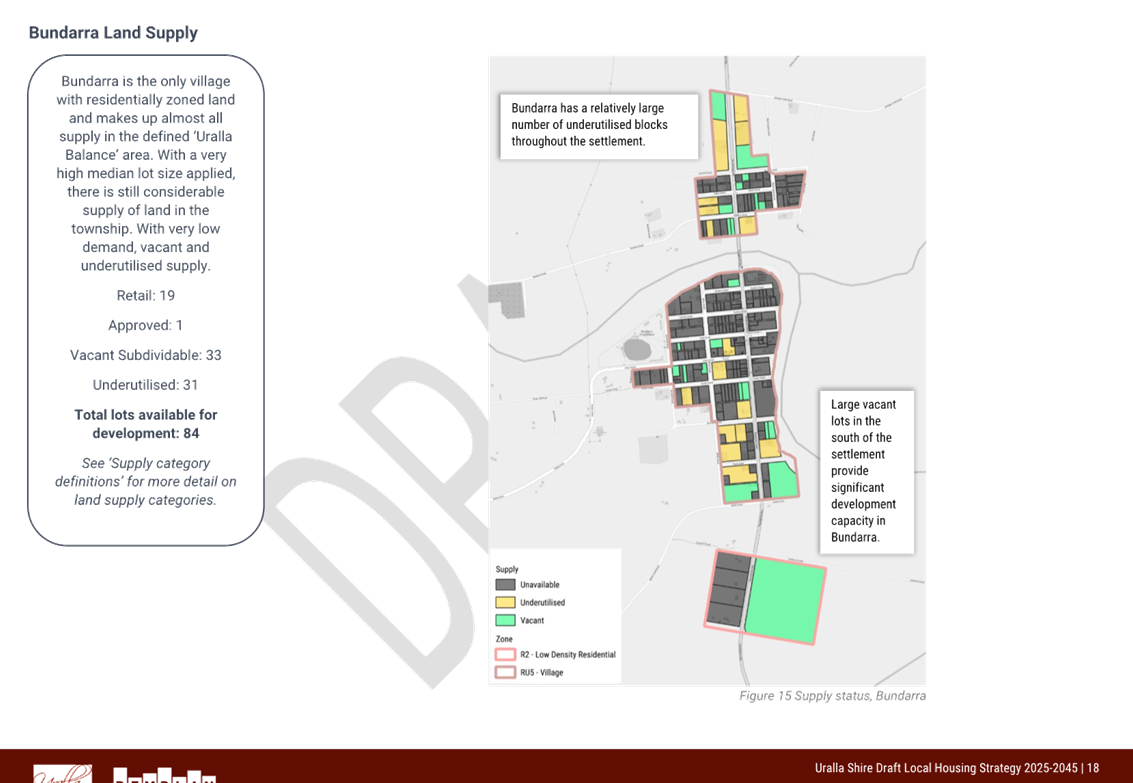

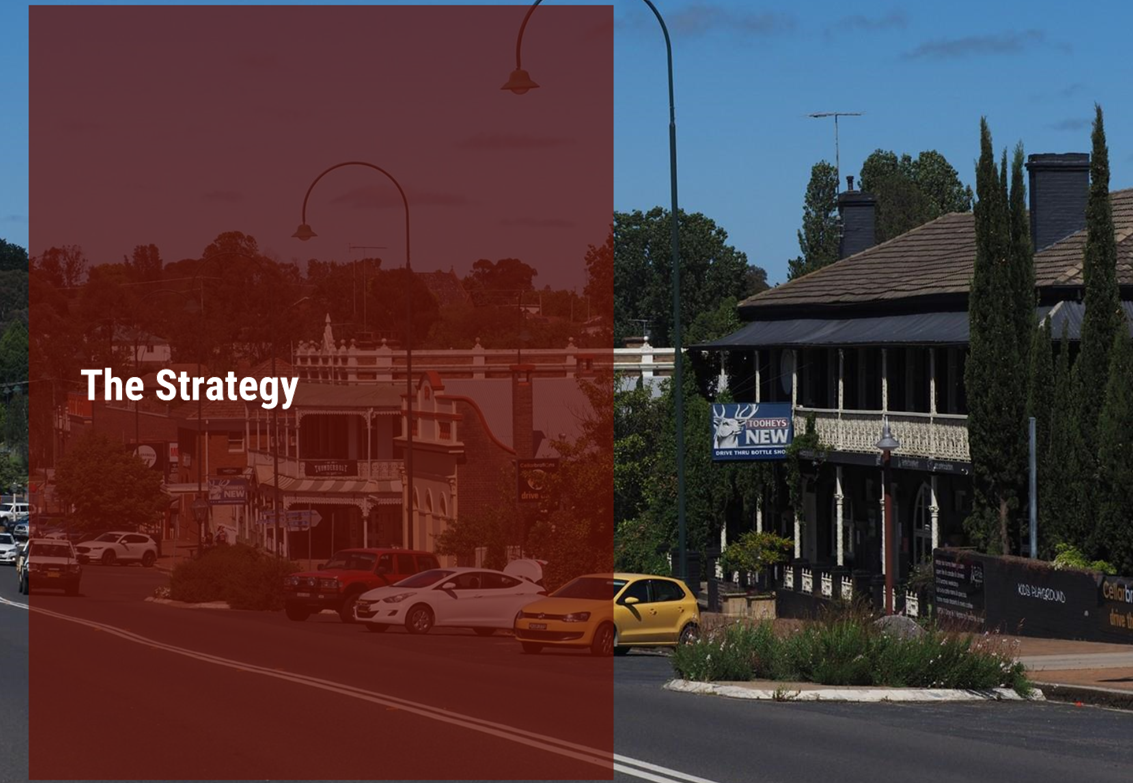
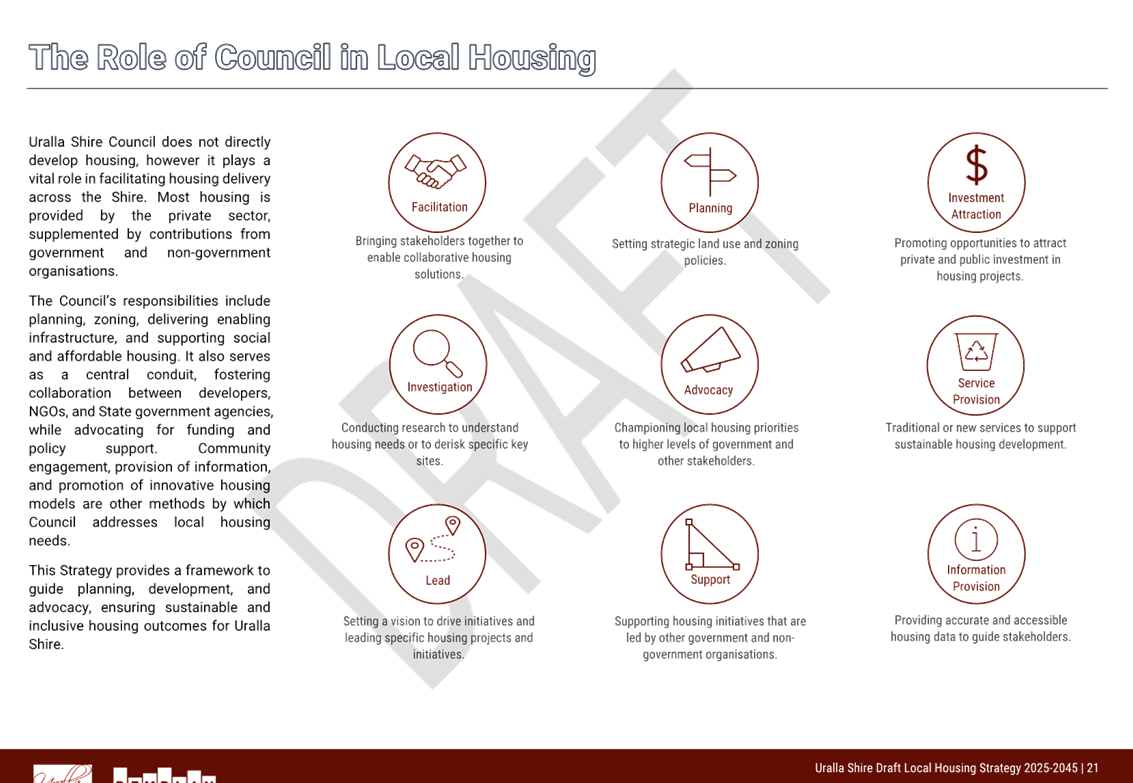




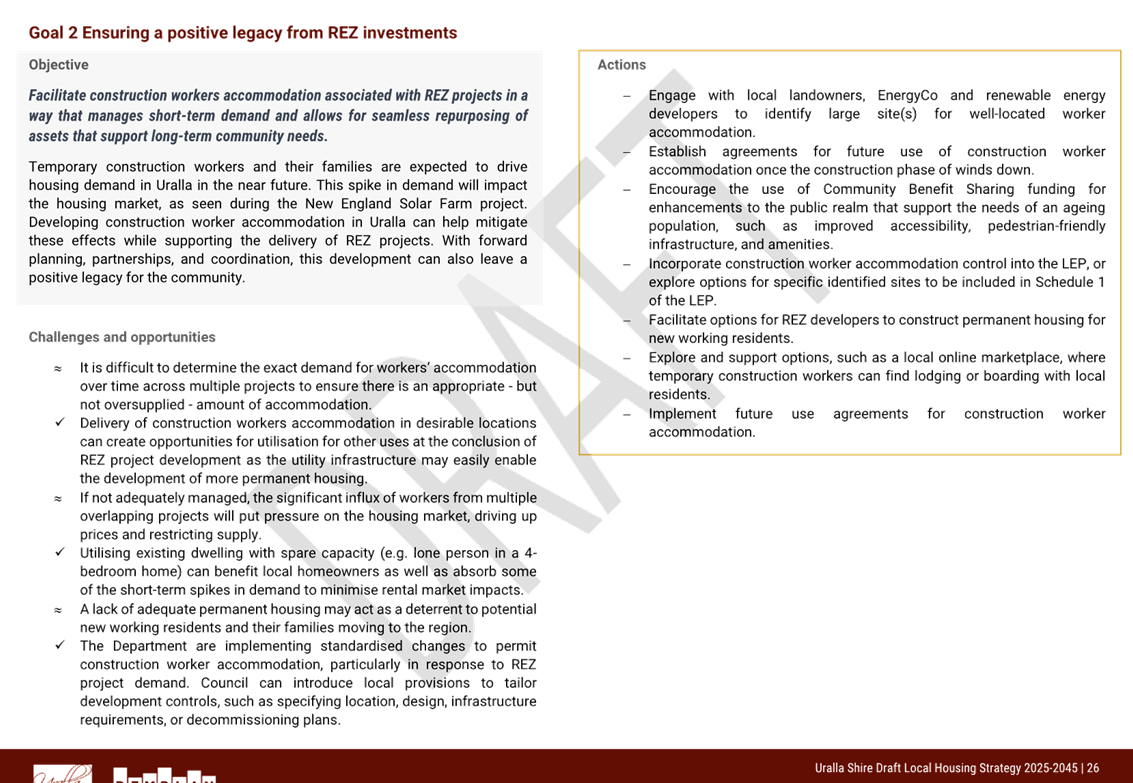

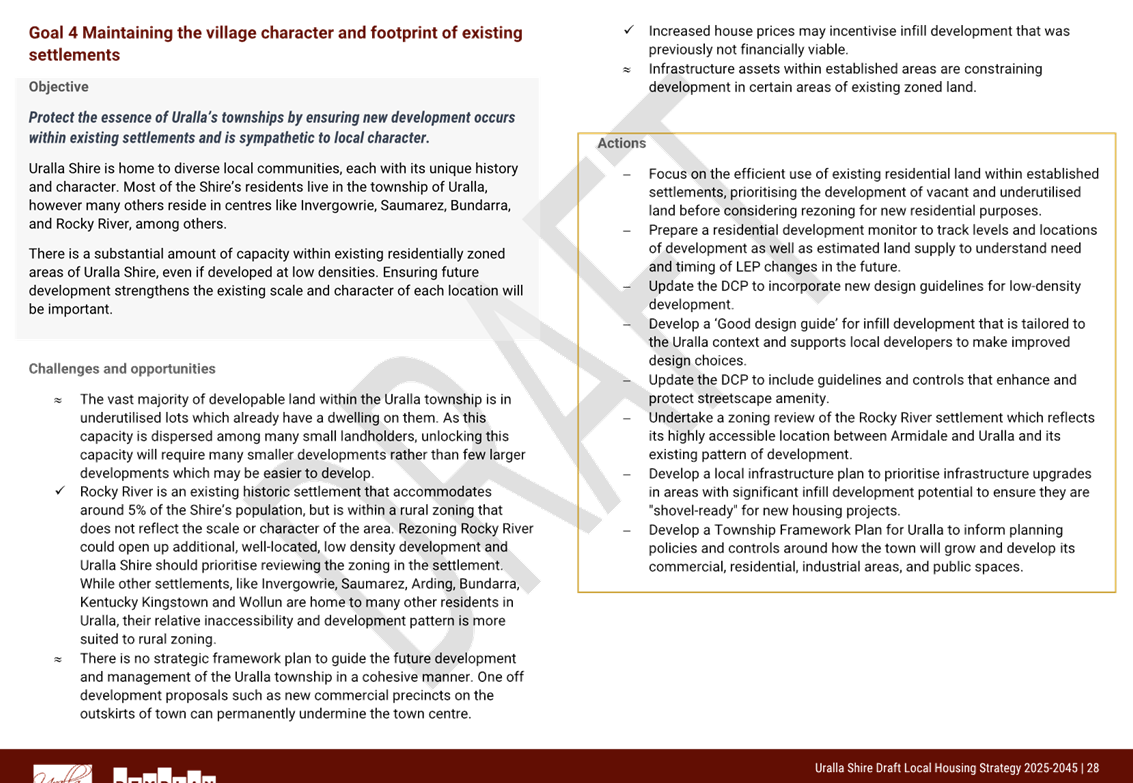
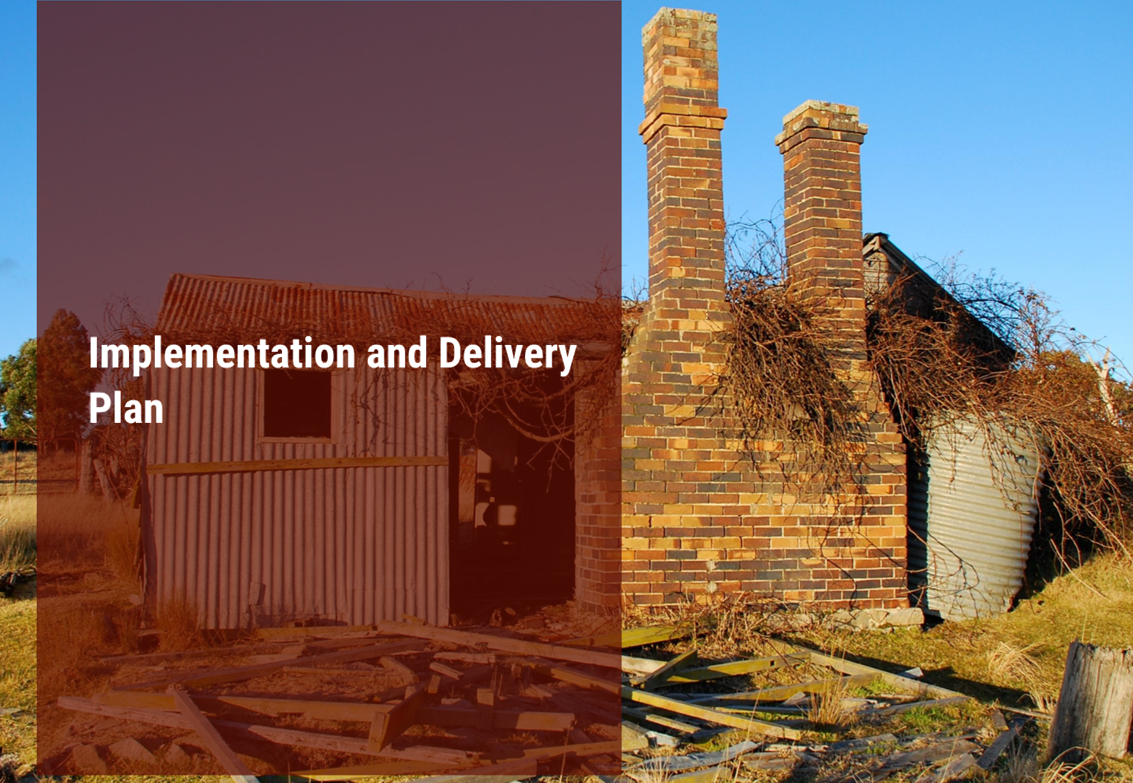
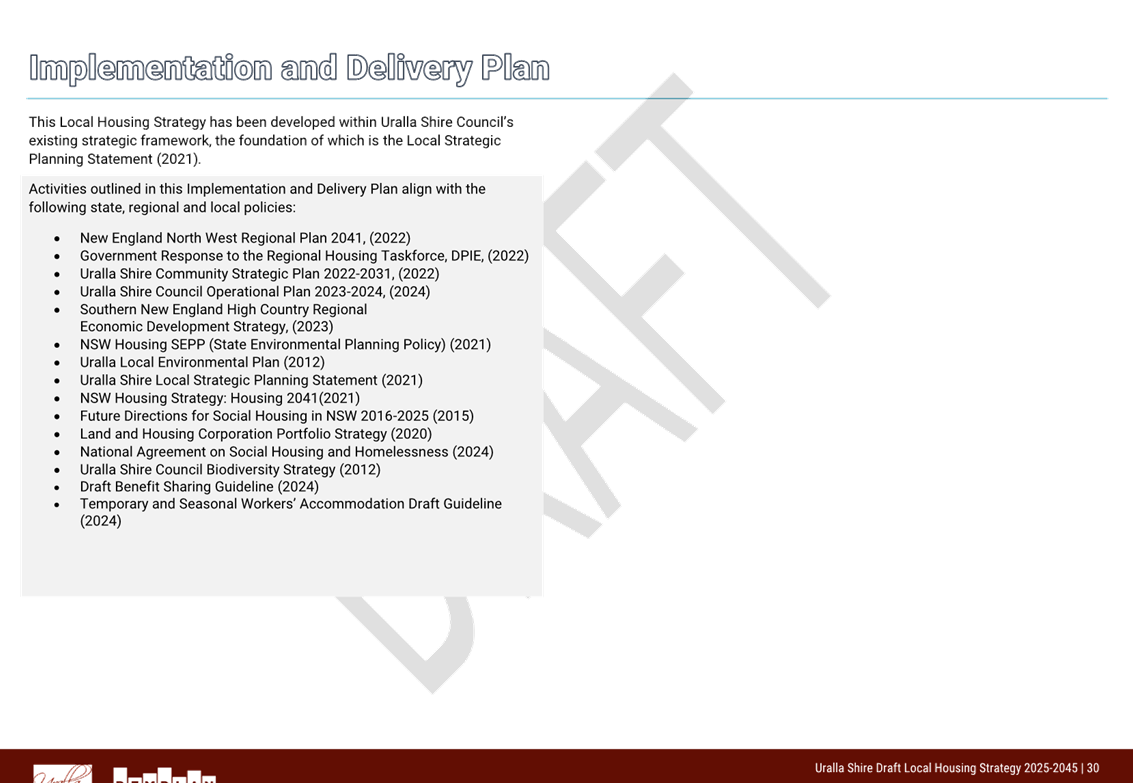
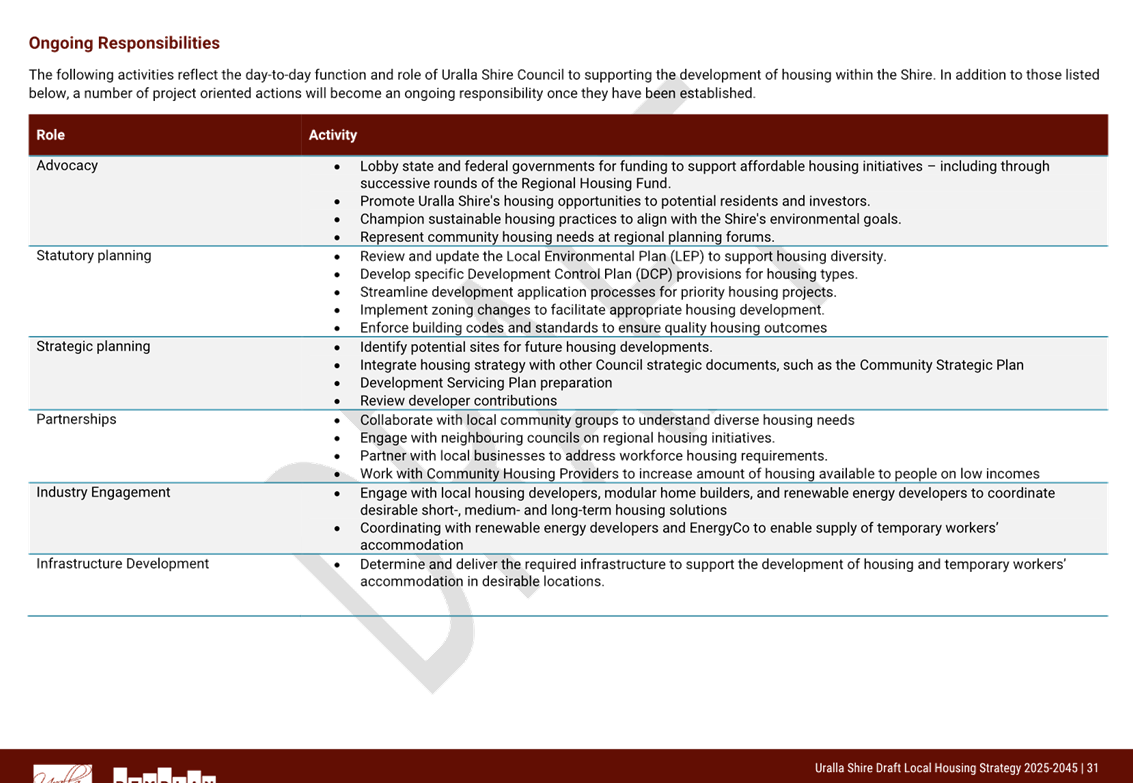
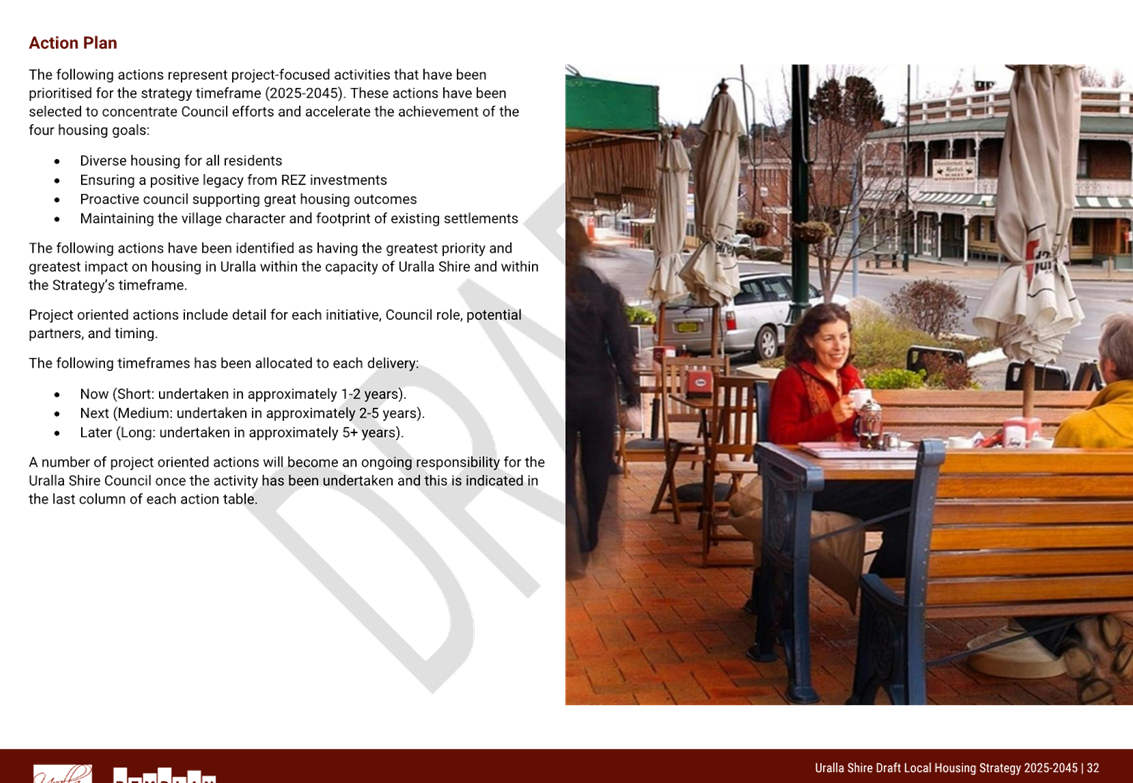
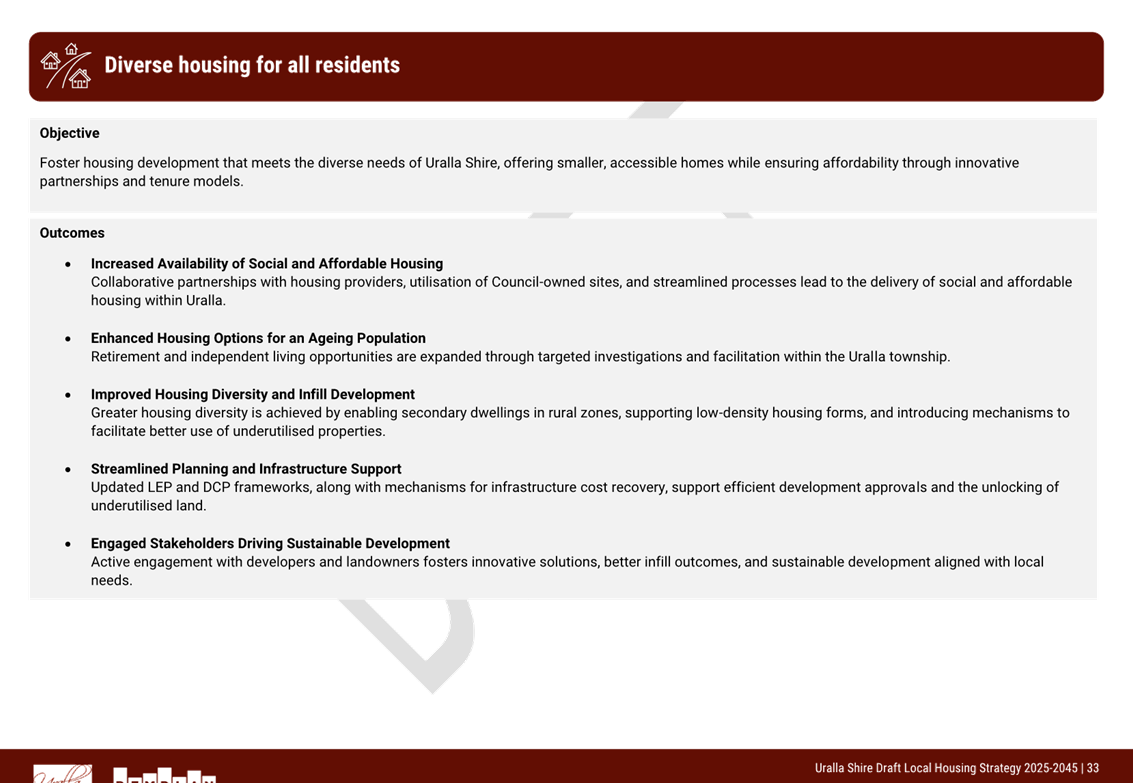
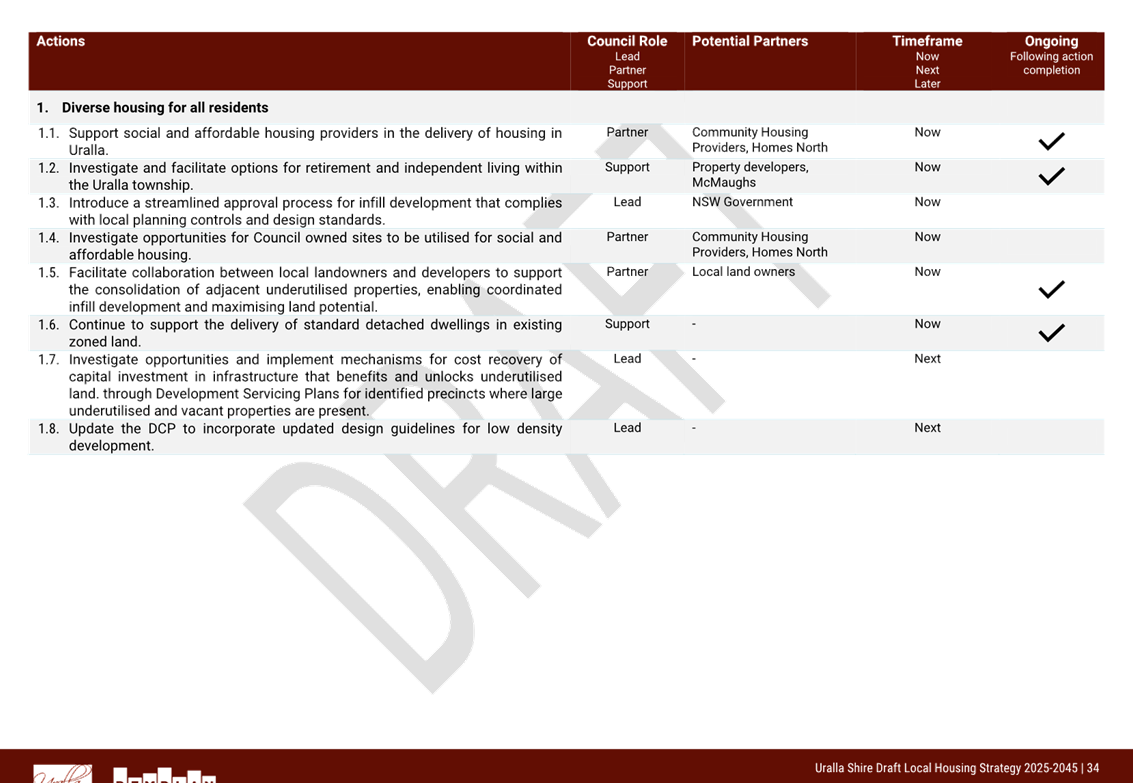
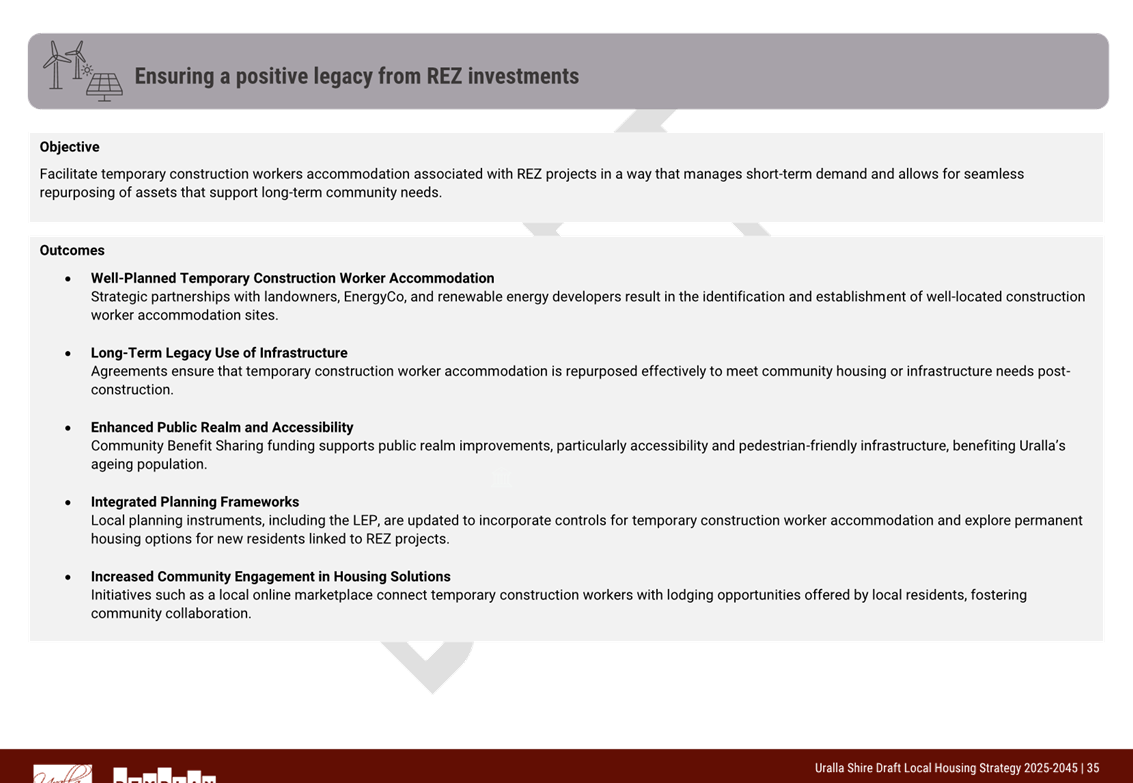
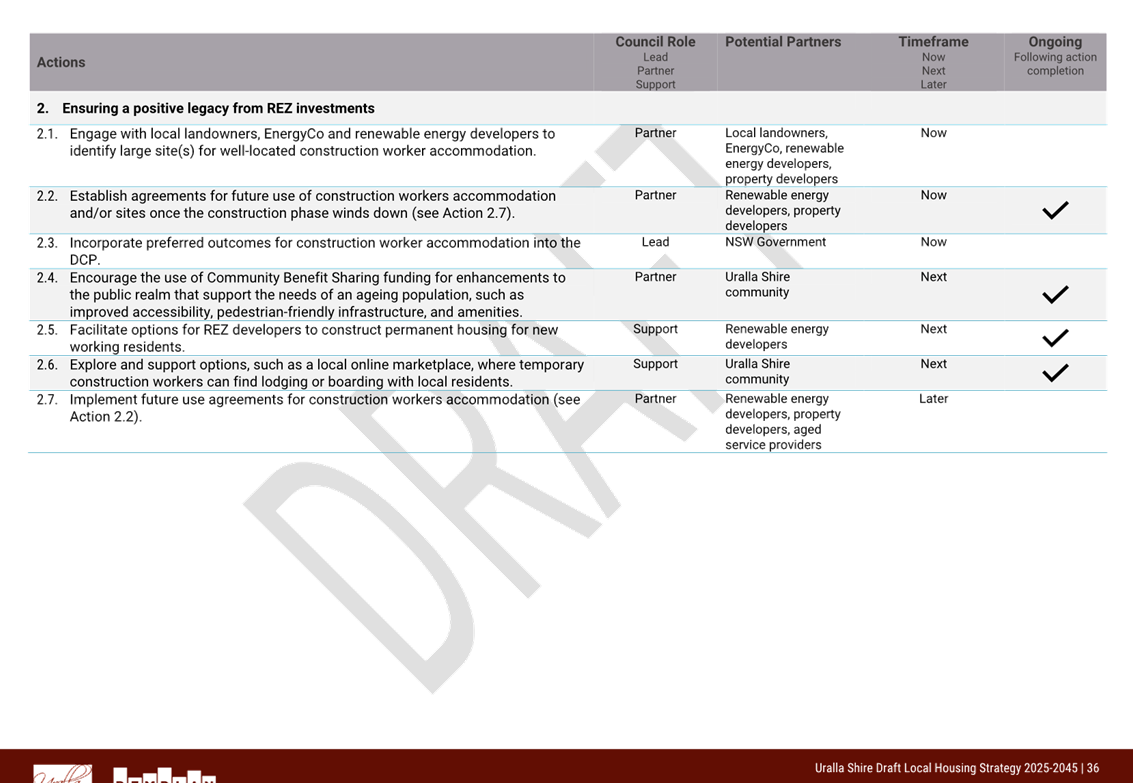
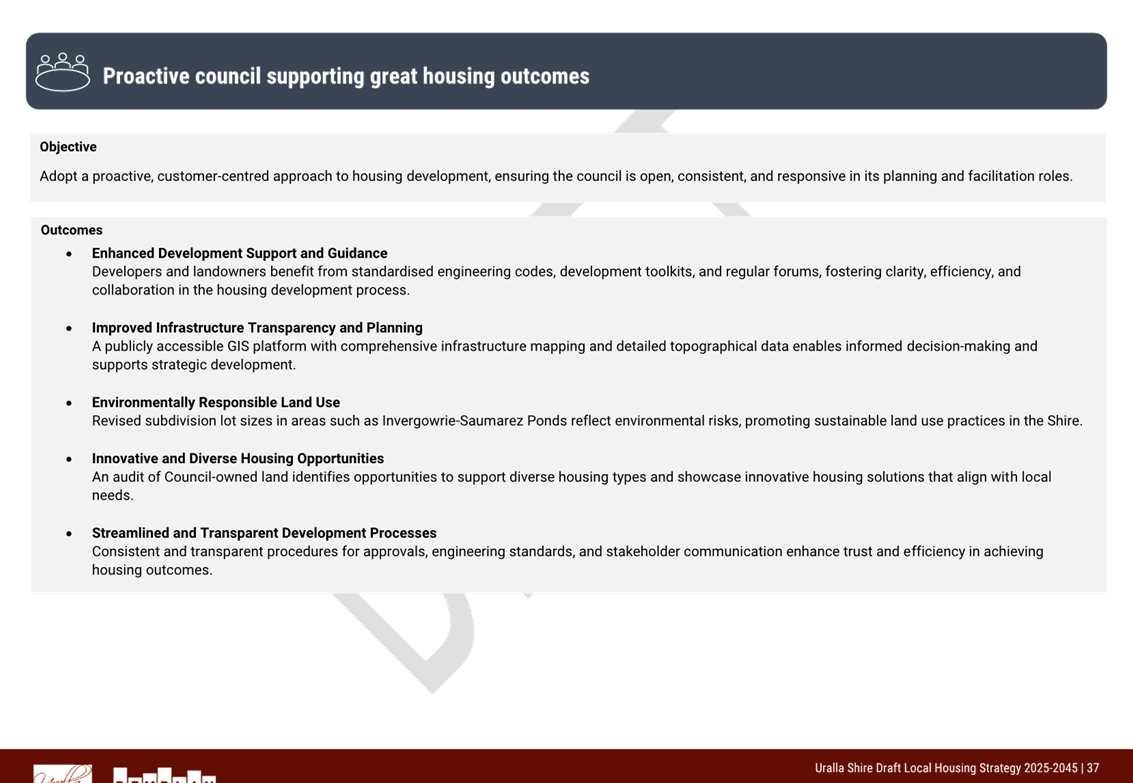
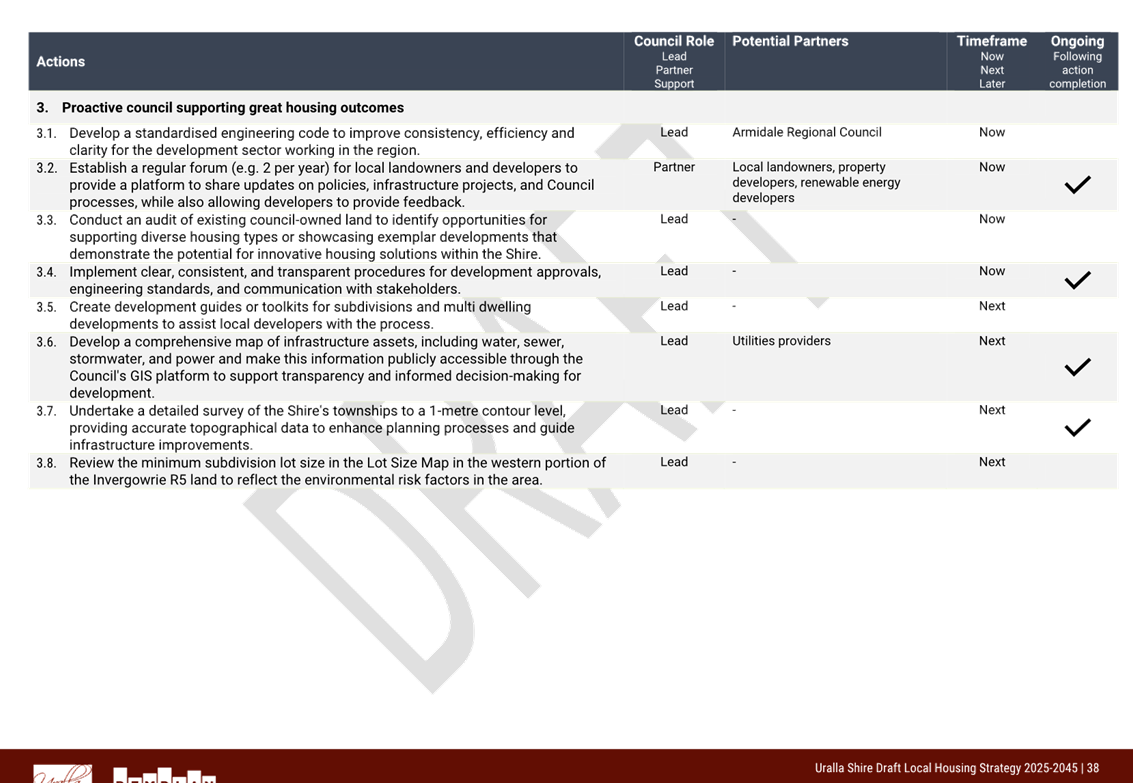
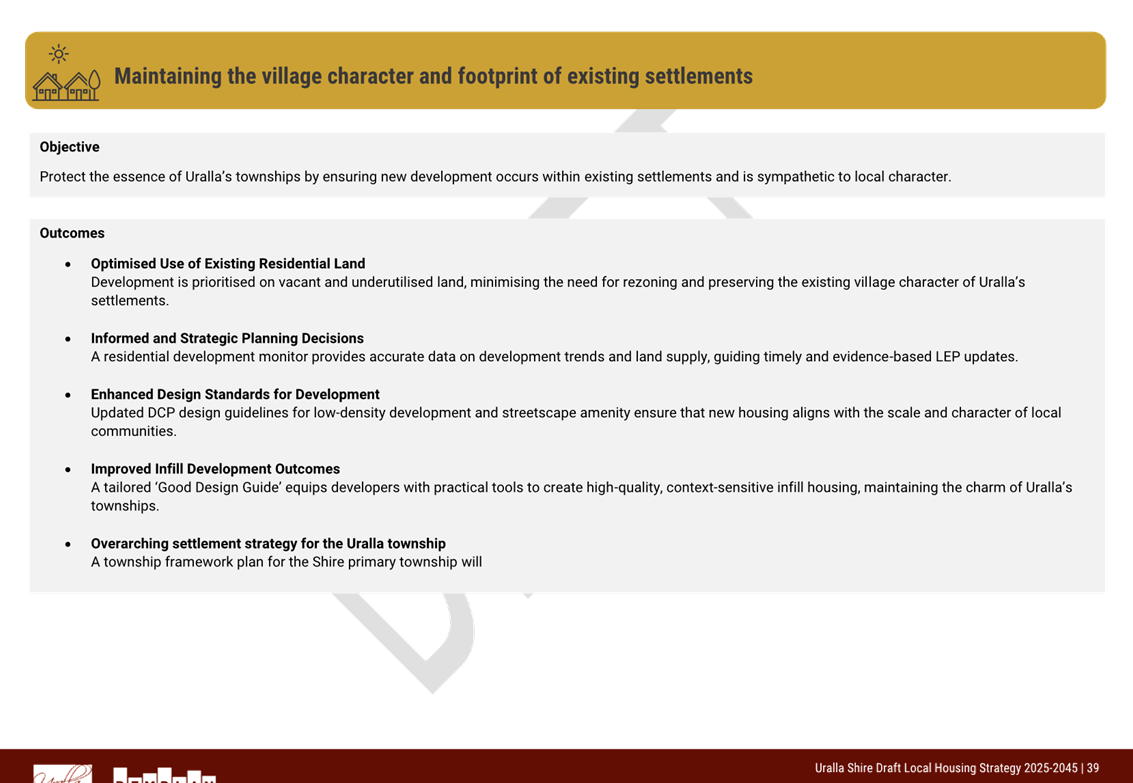

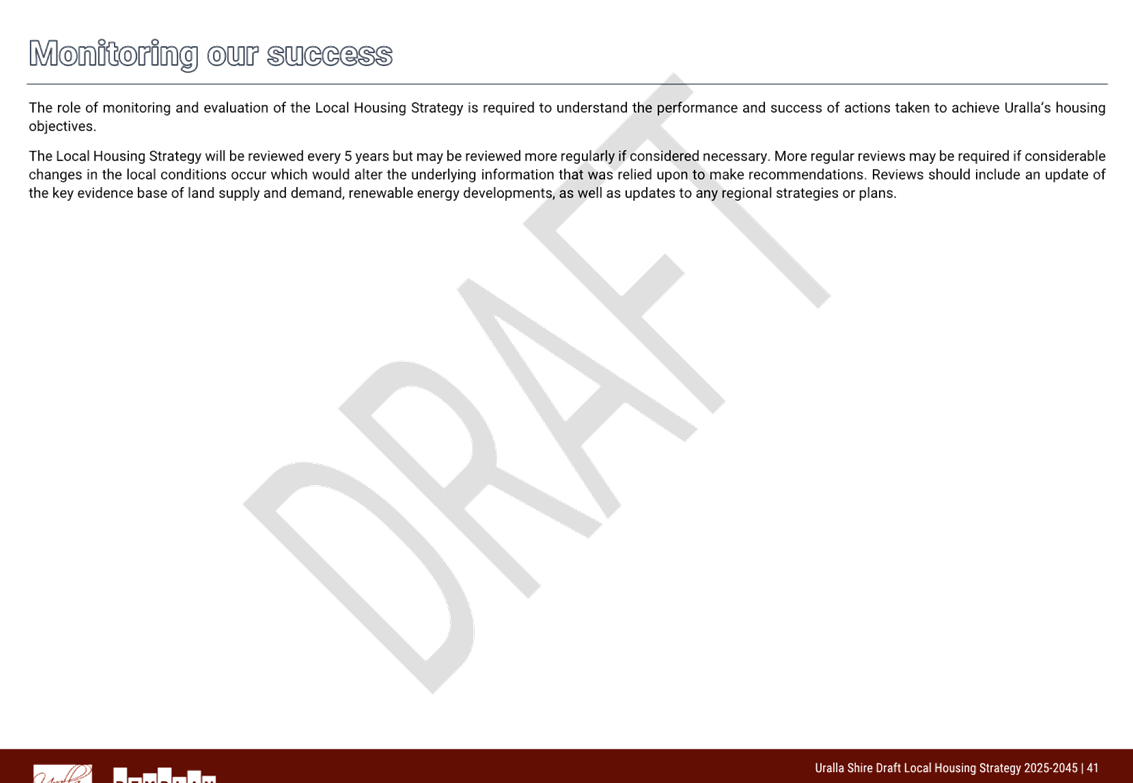
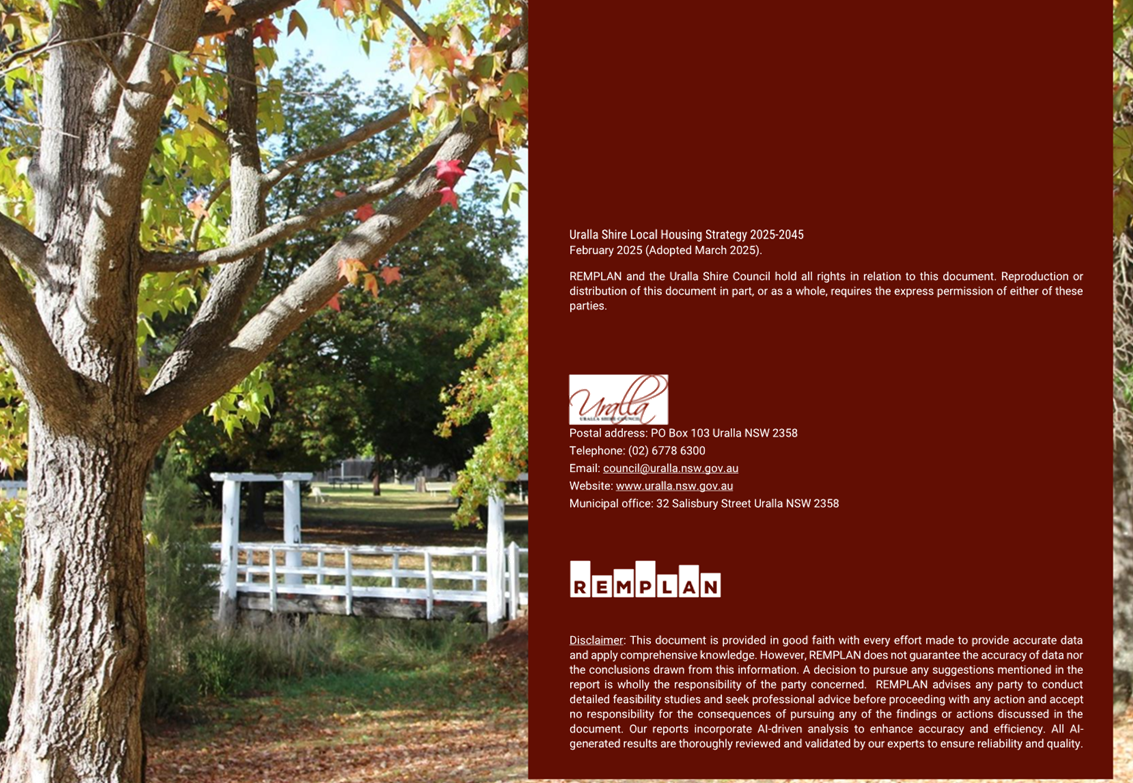
|
Ordinary
Council Meeting Business Agenda
|
25 February 2025
|
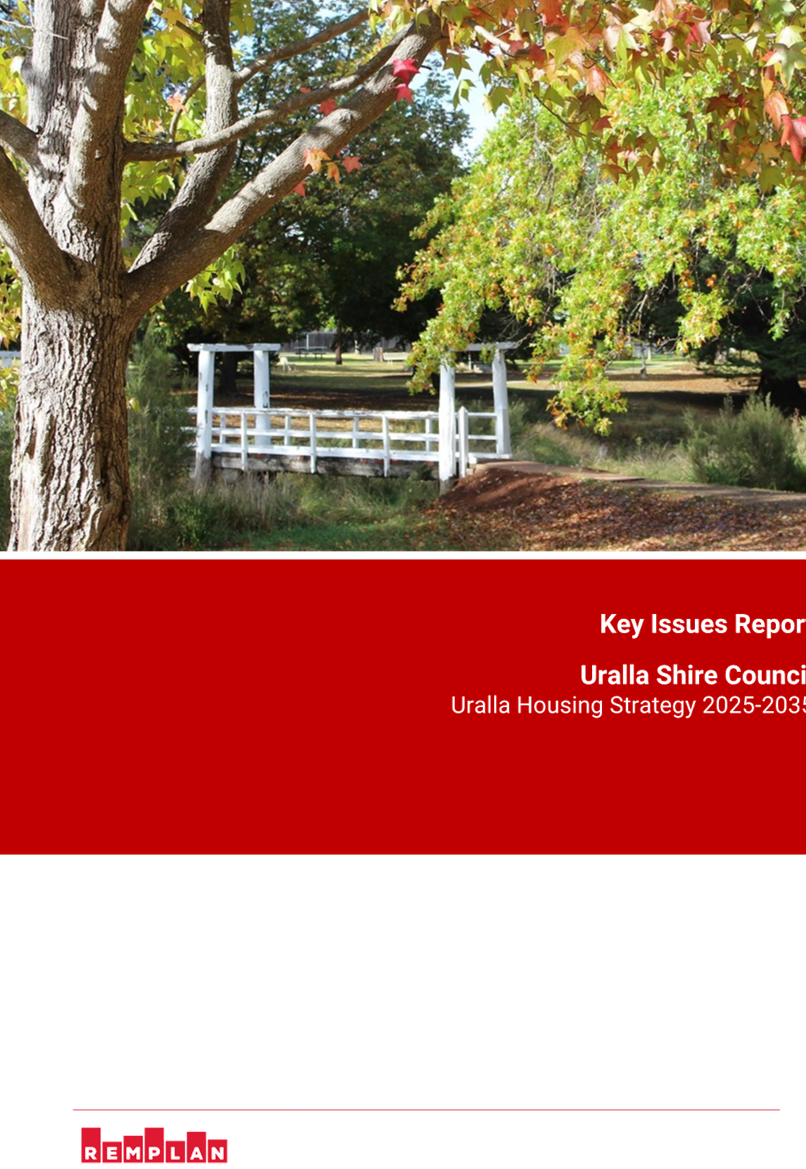
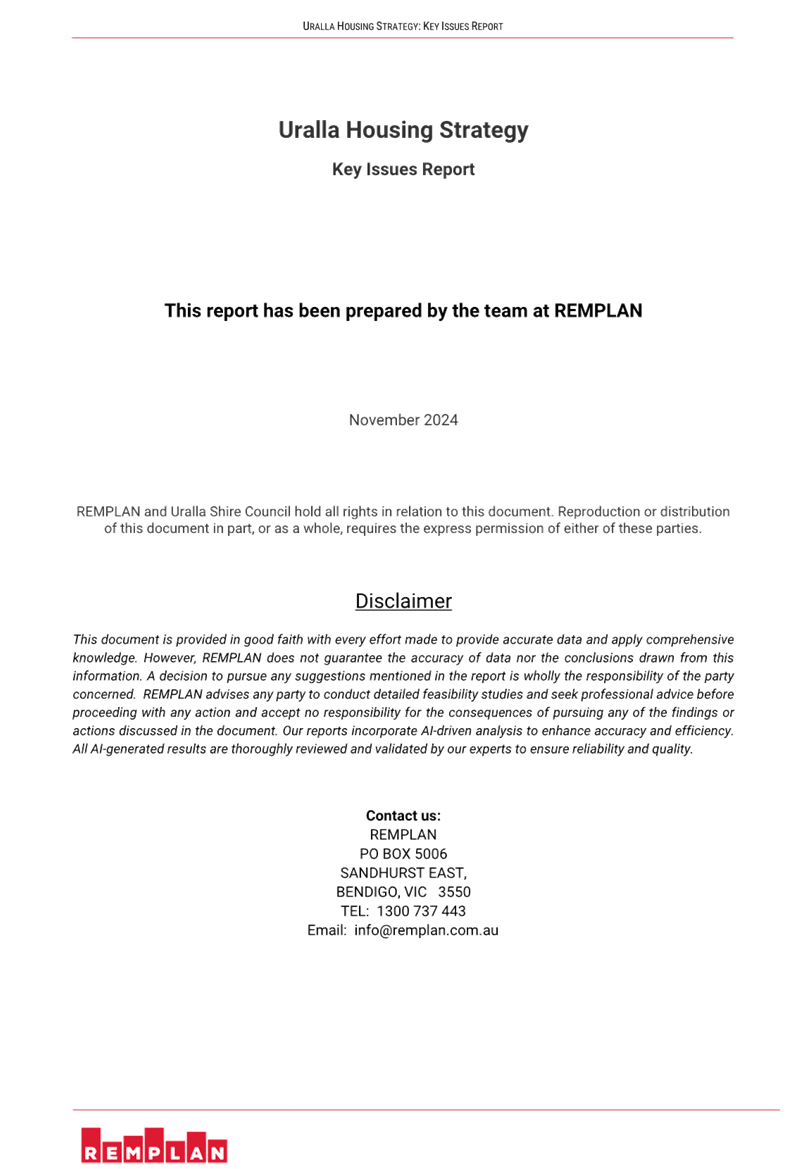
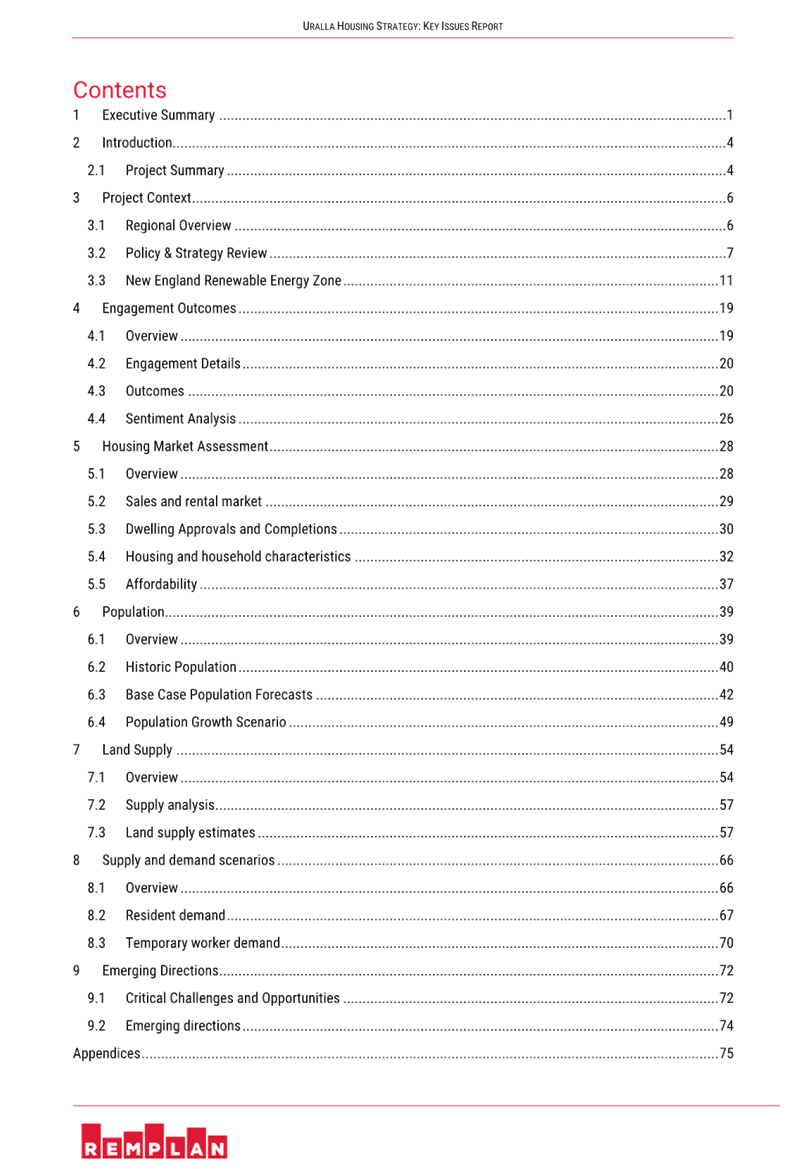
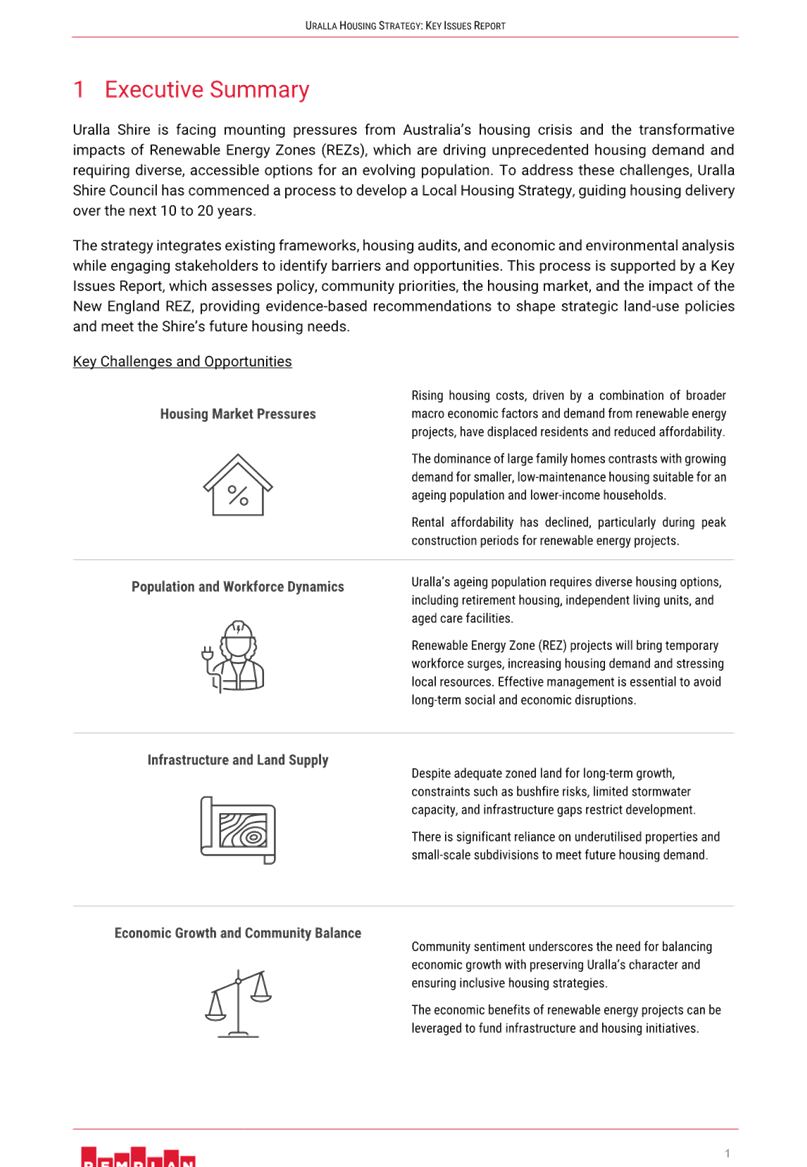
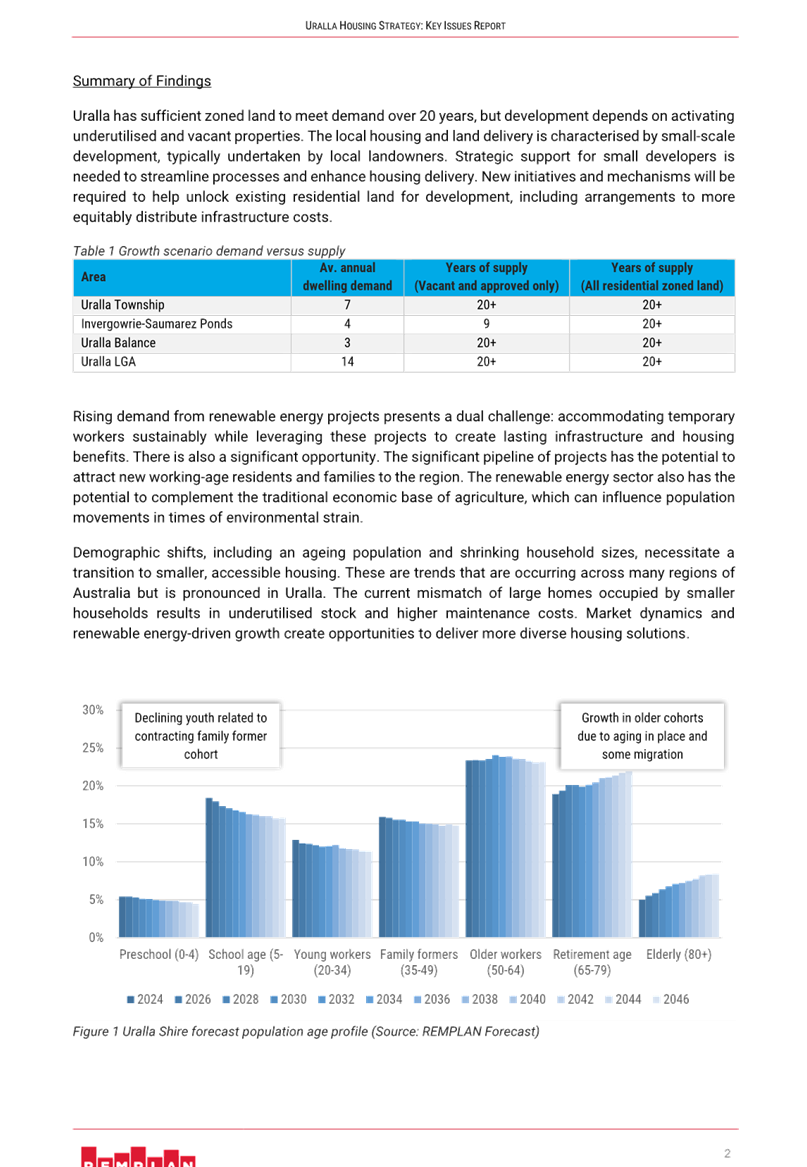
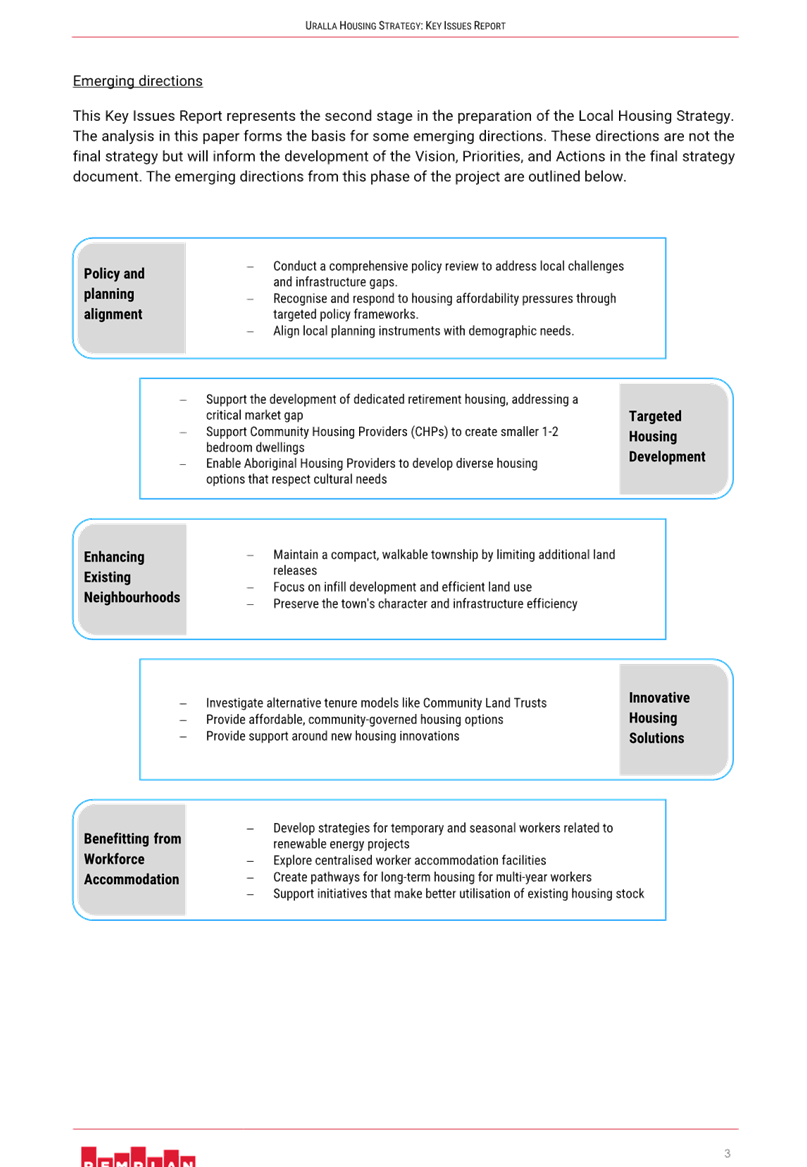
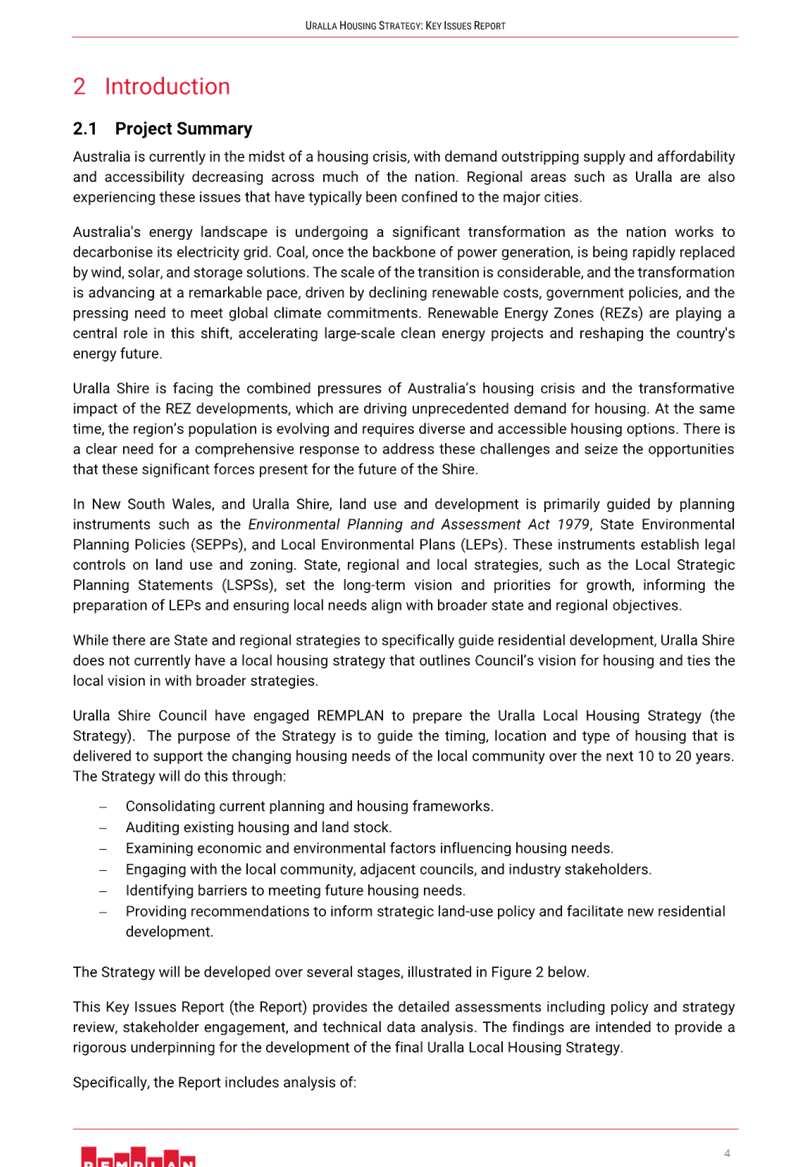
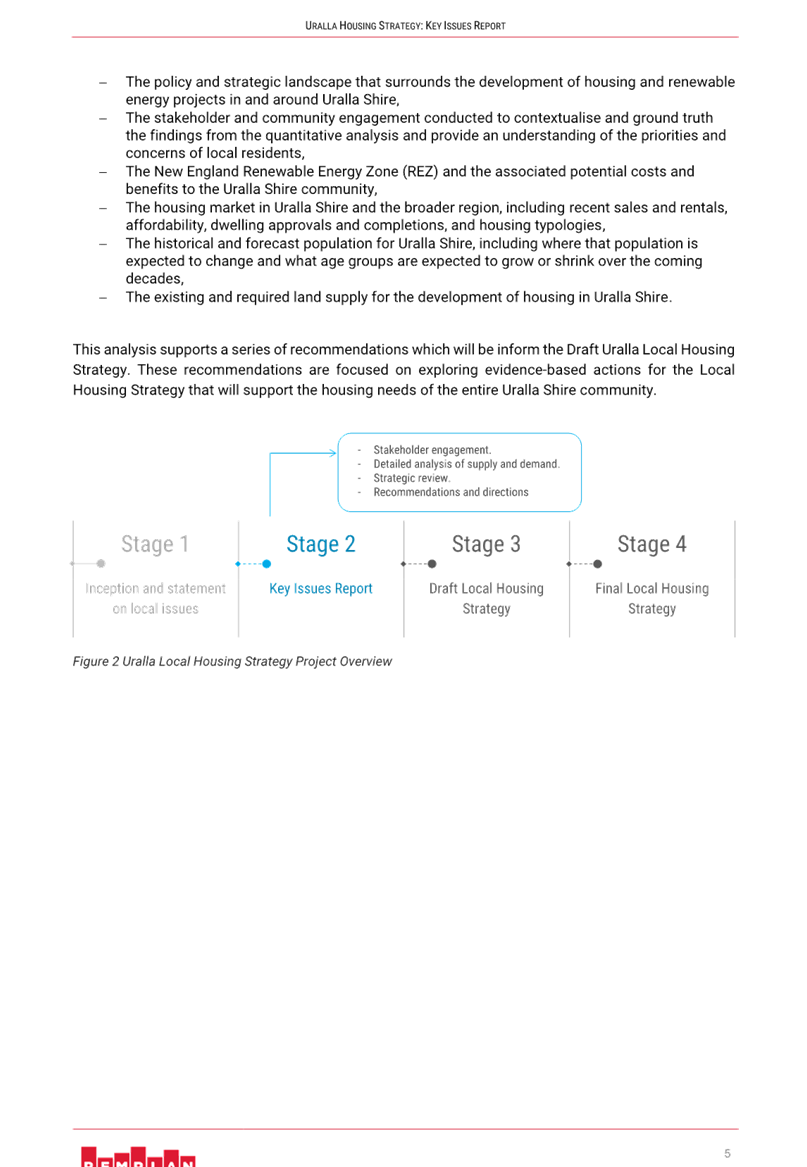
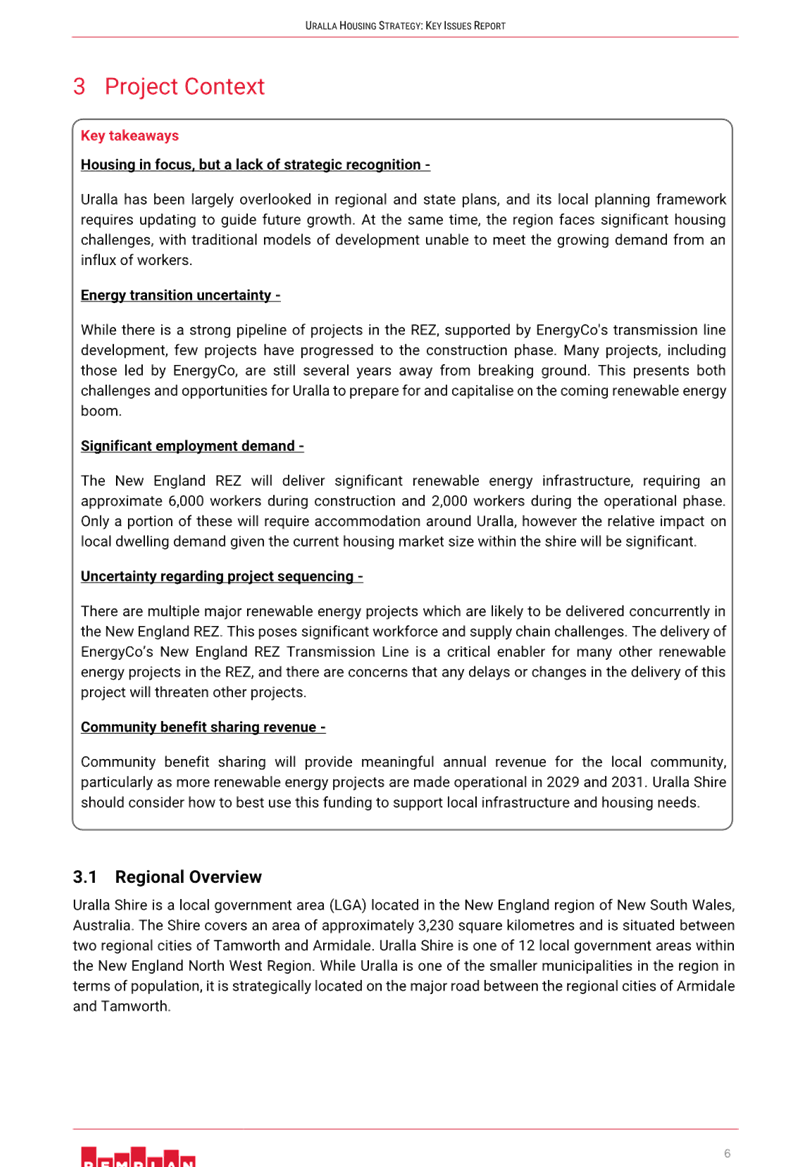
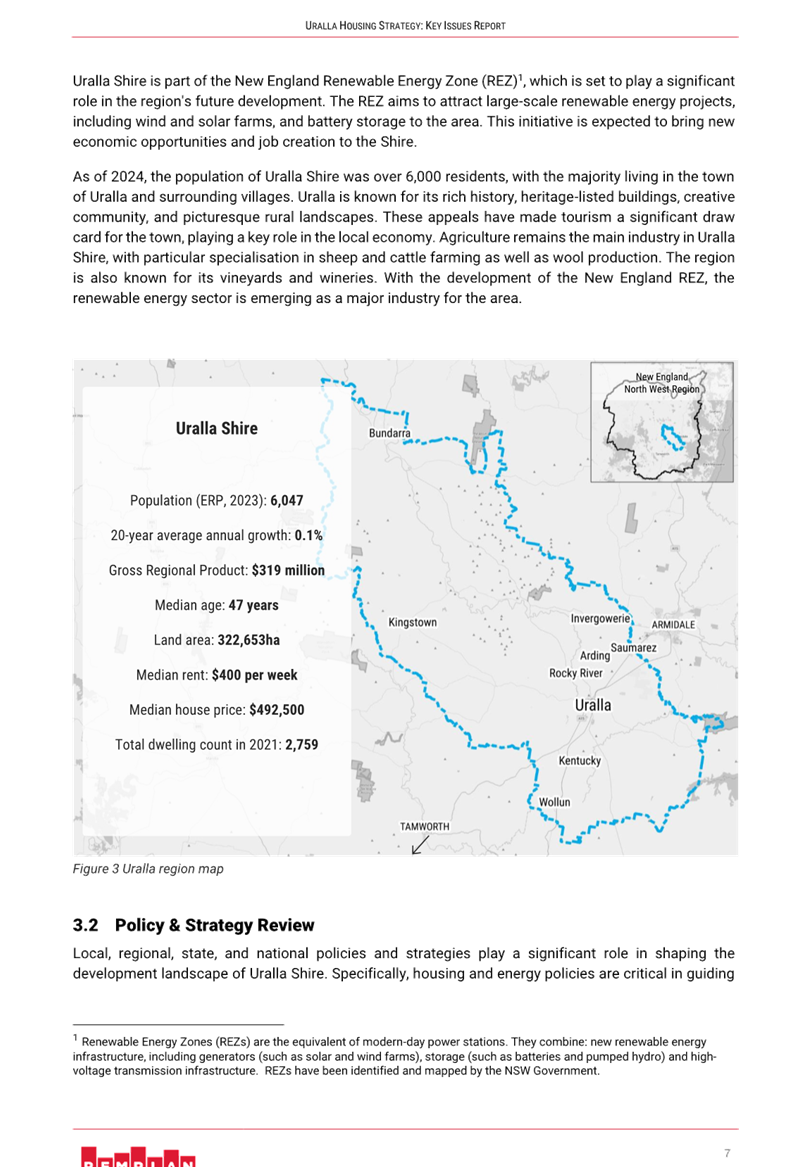
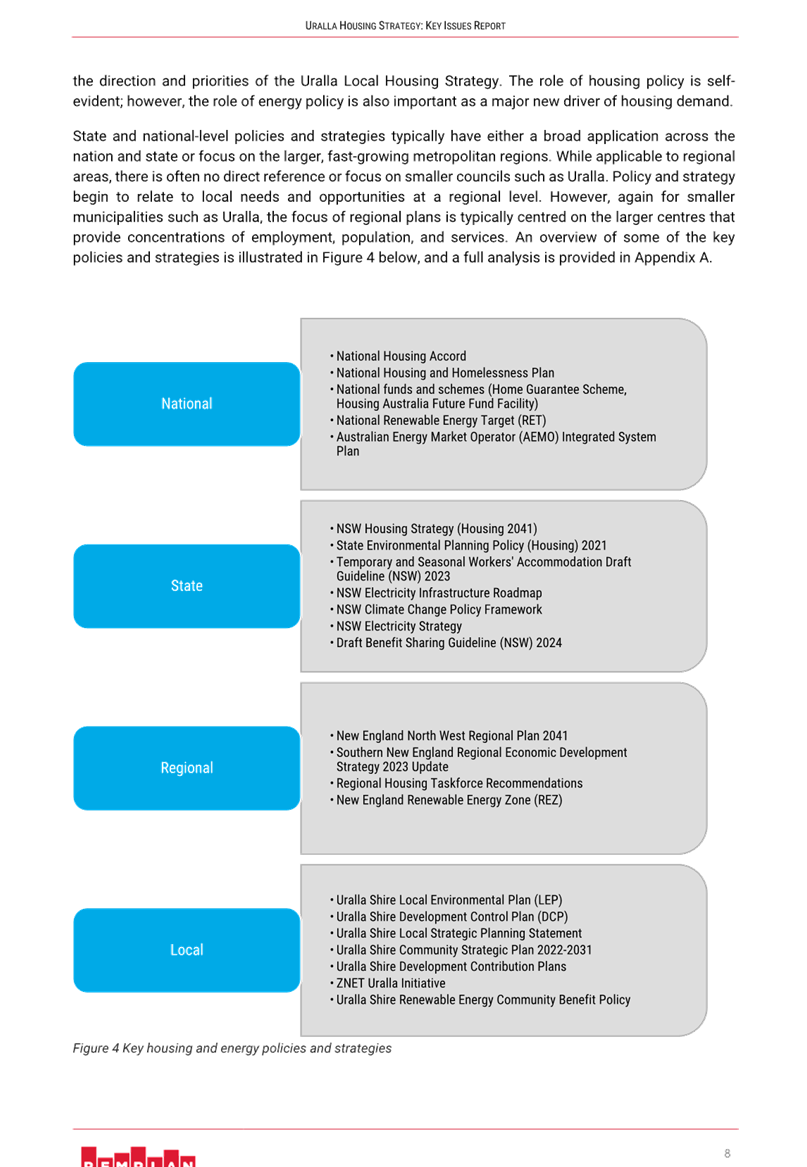
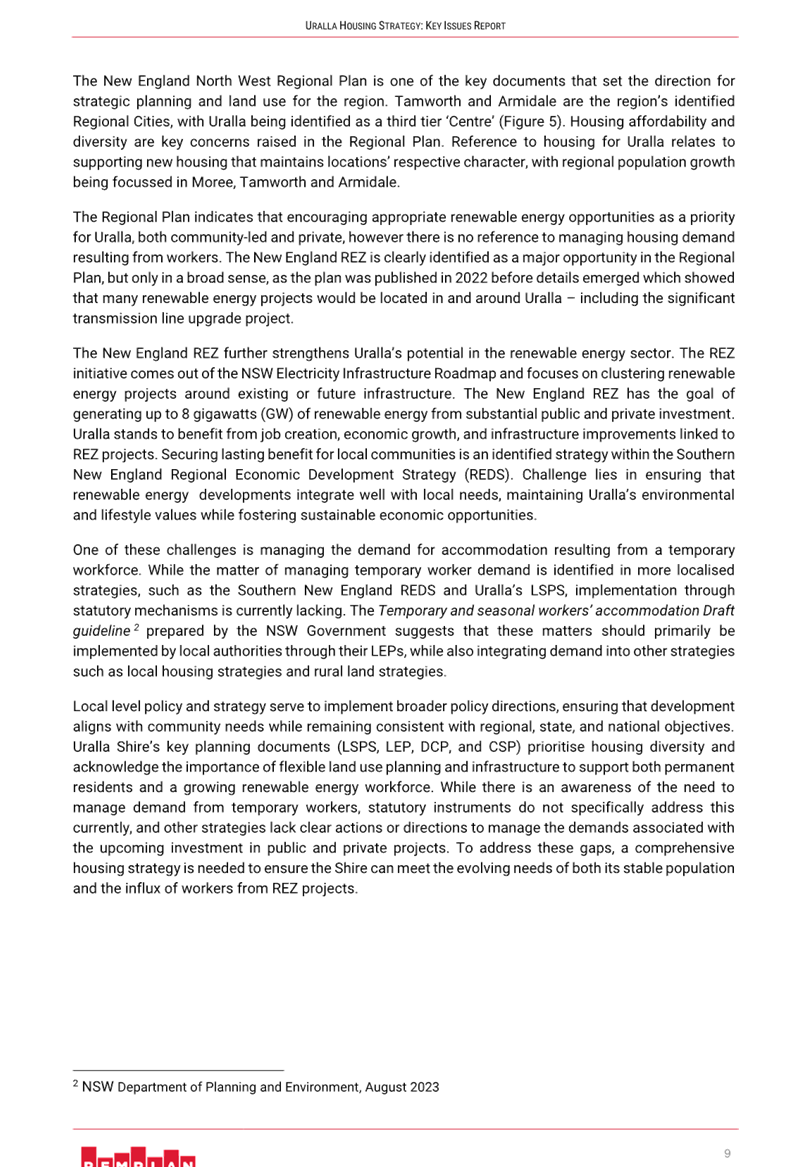
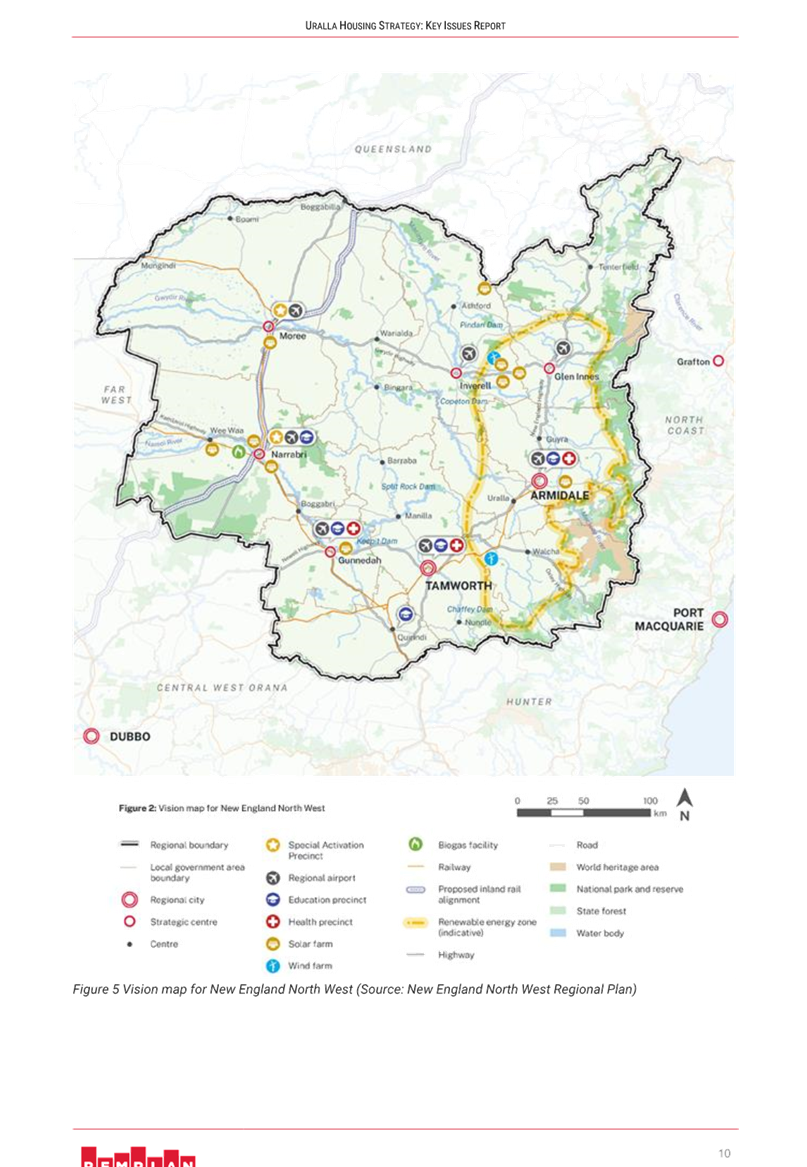
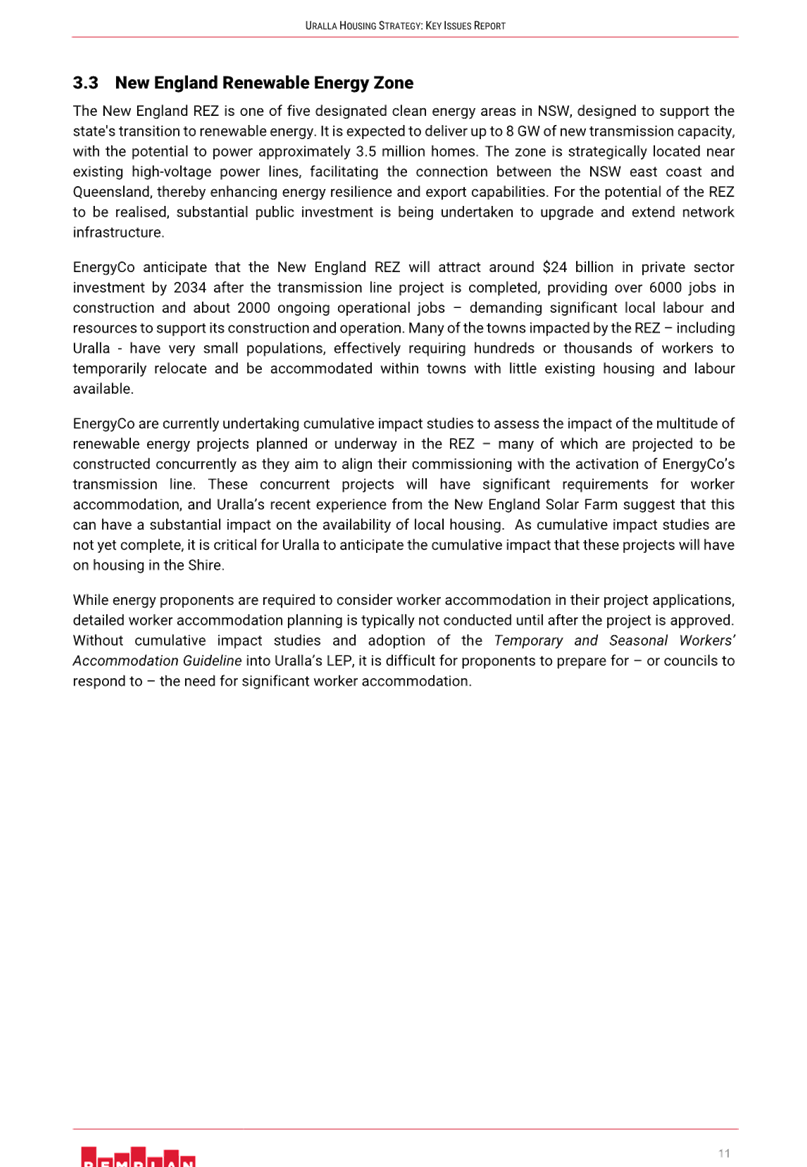
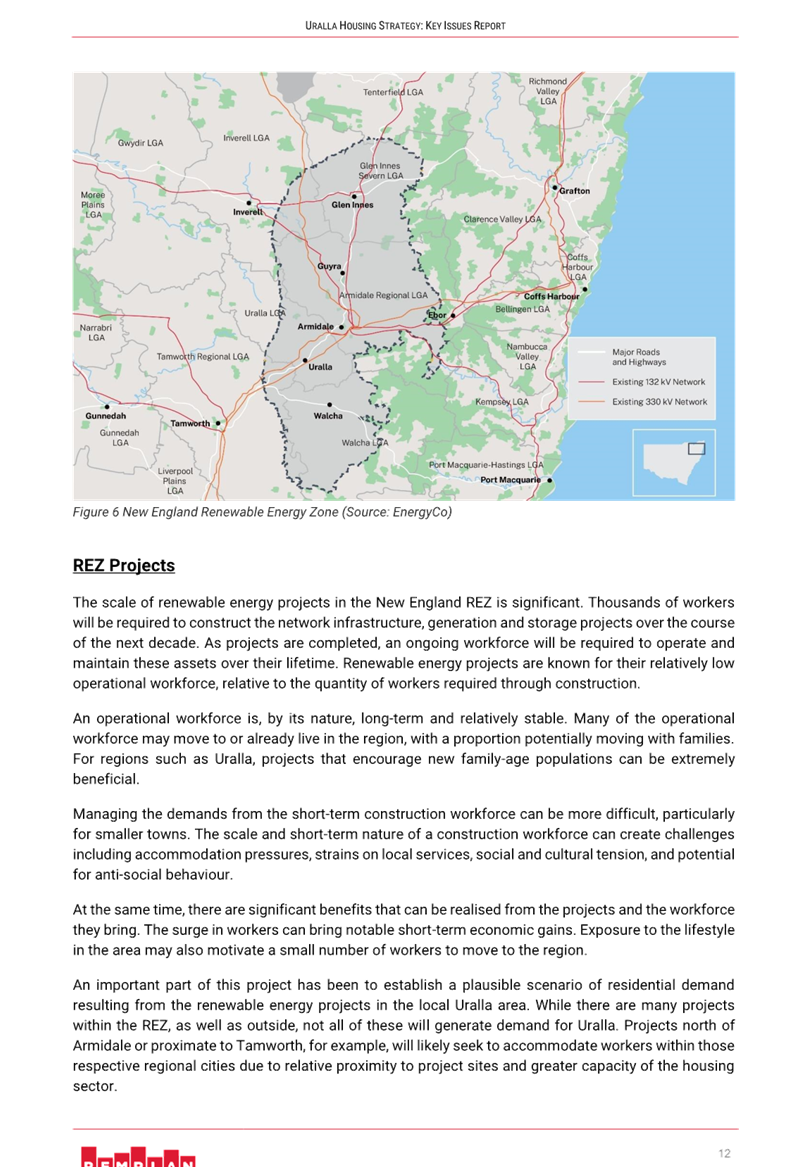
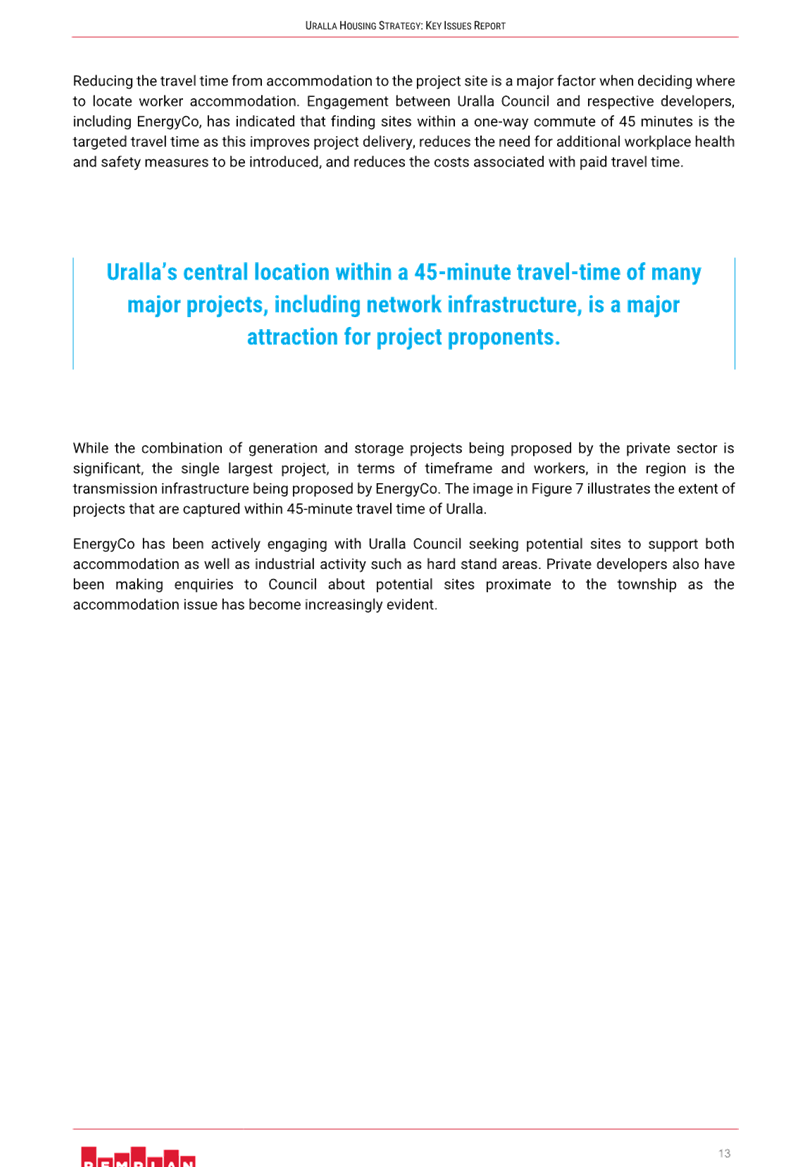
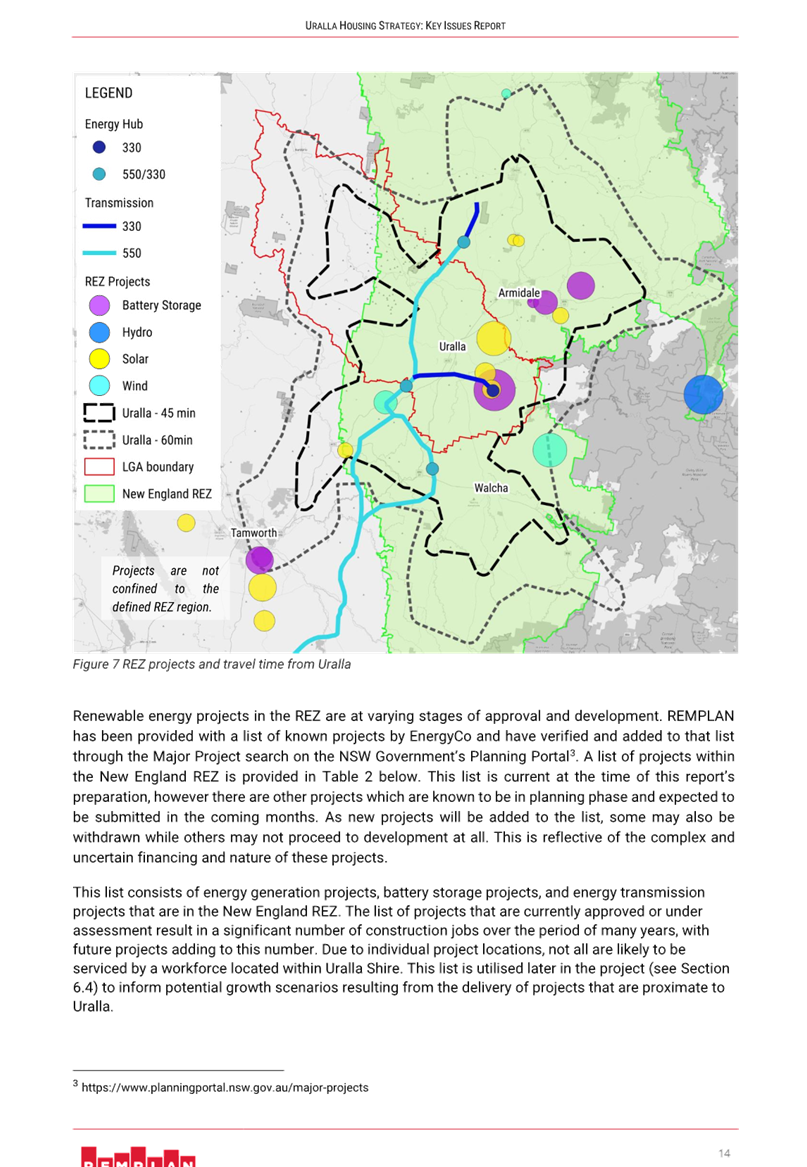
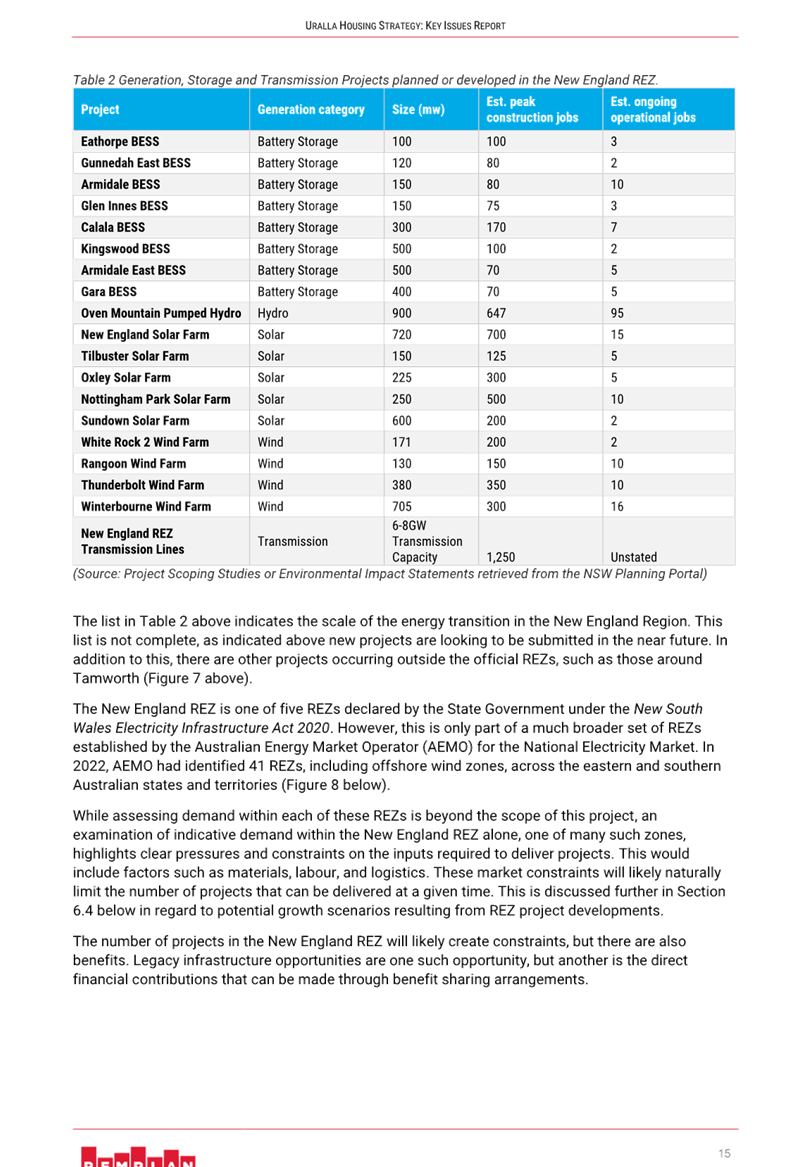
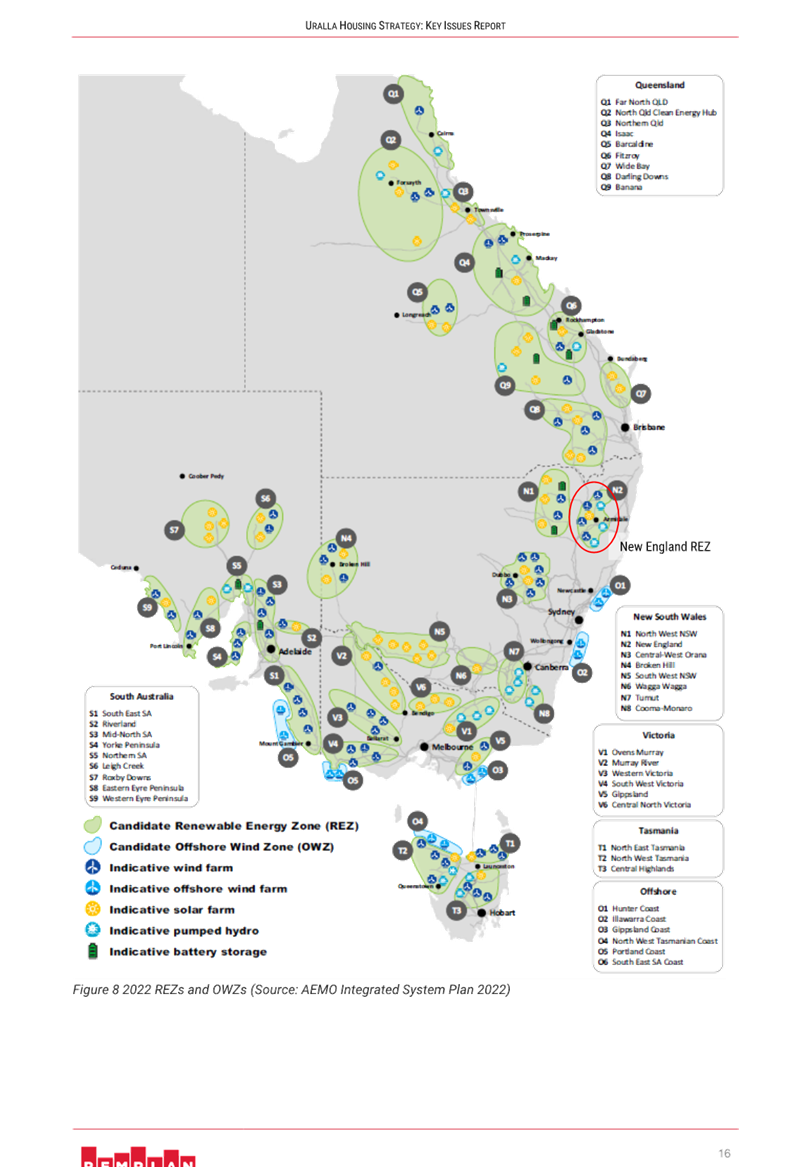
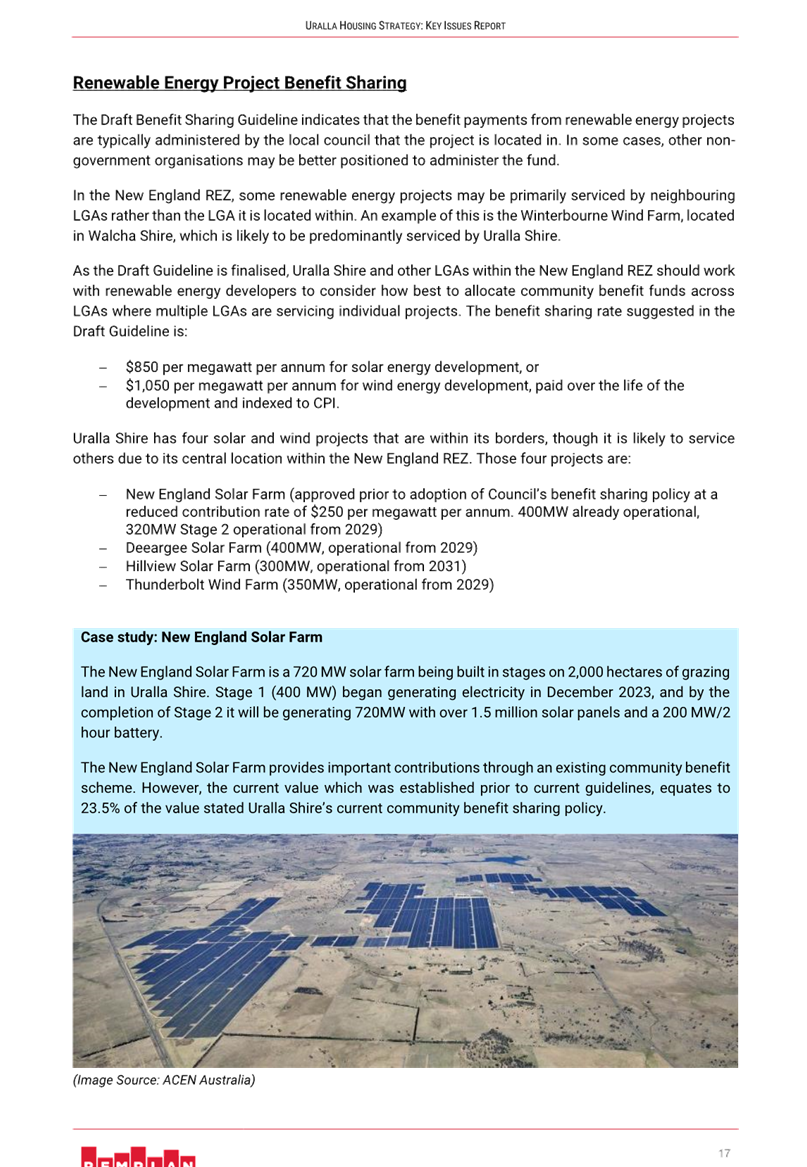

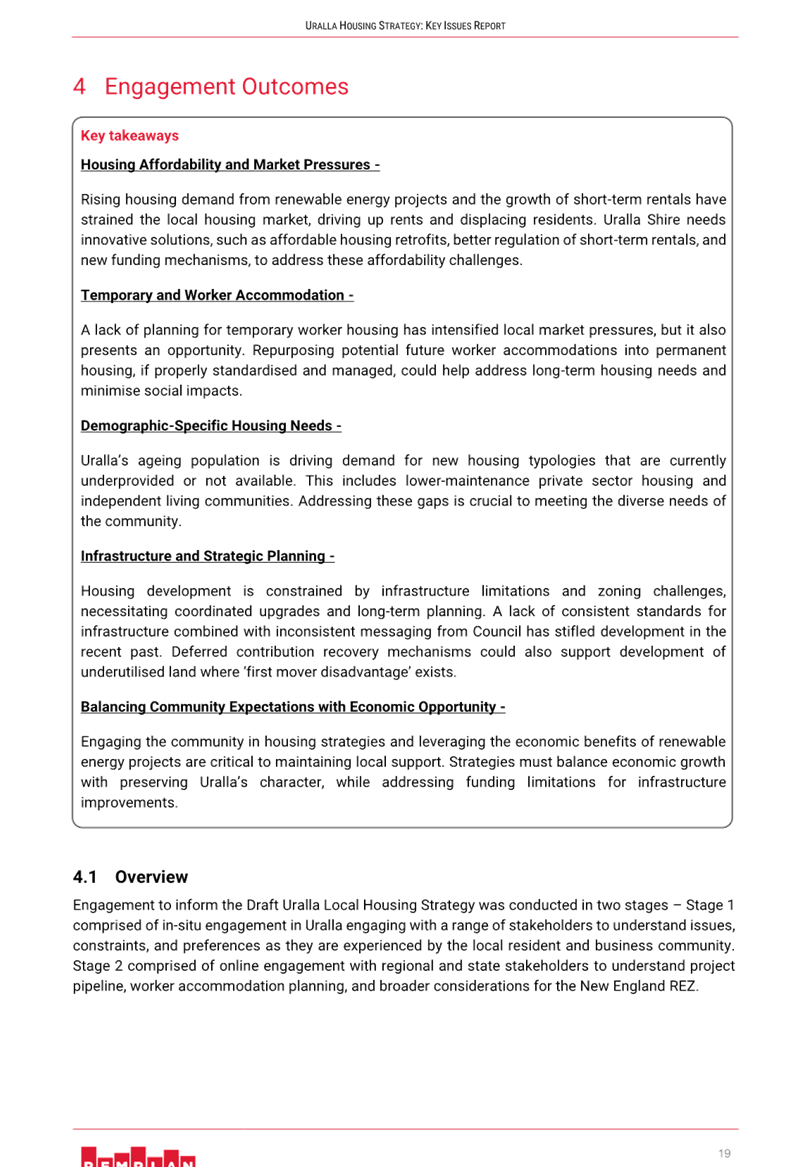
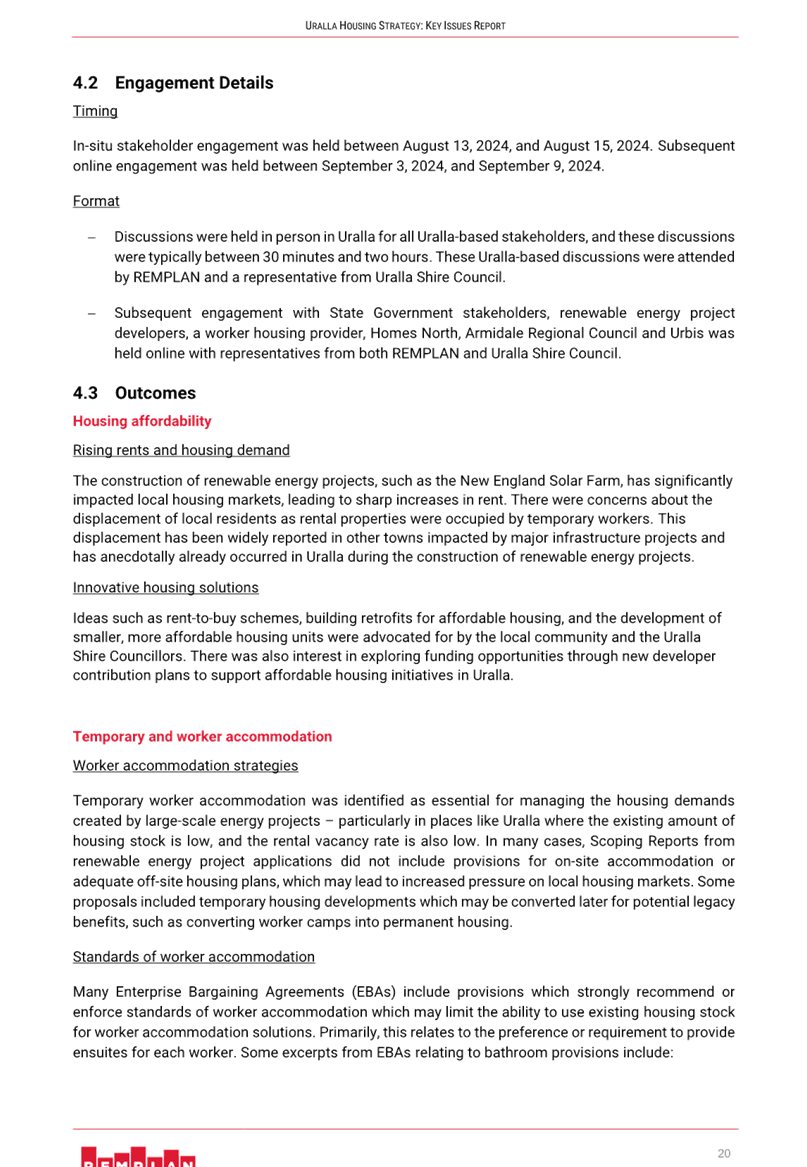
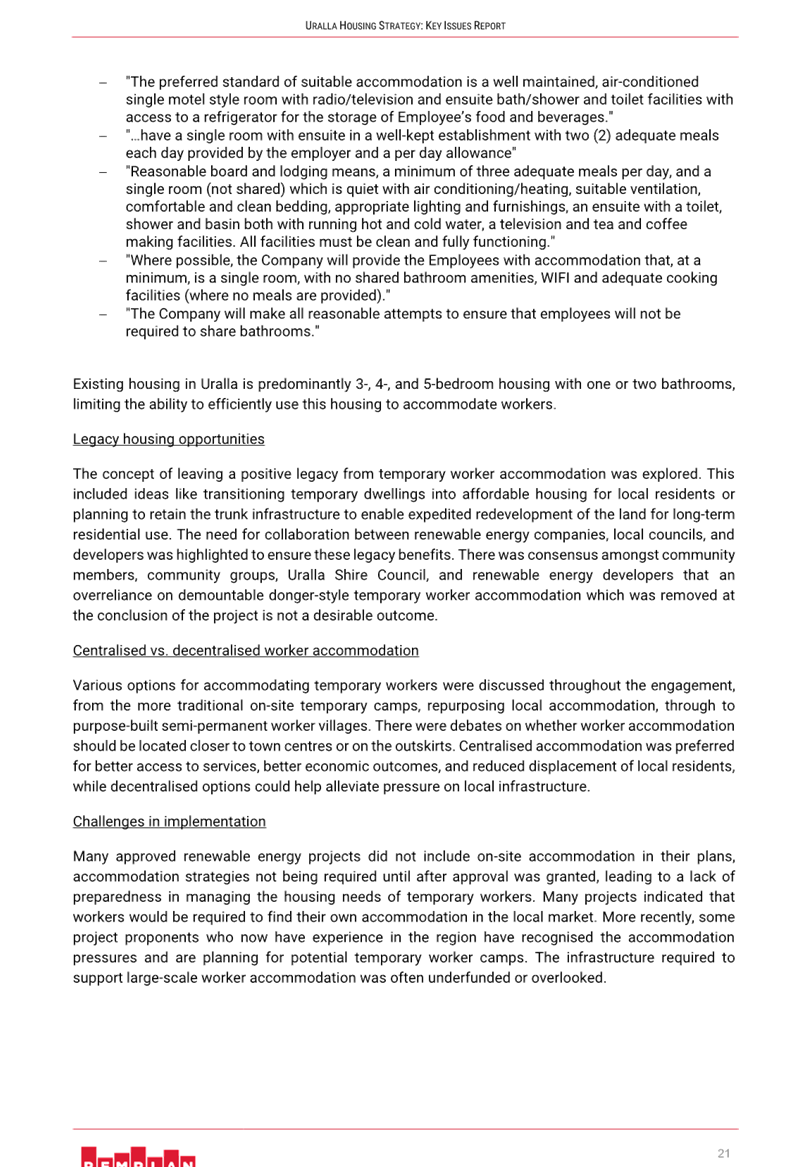
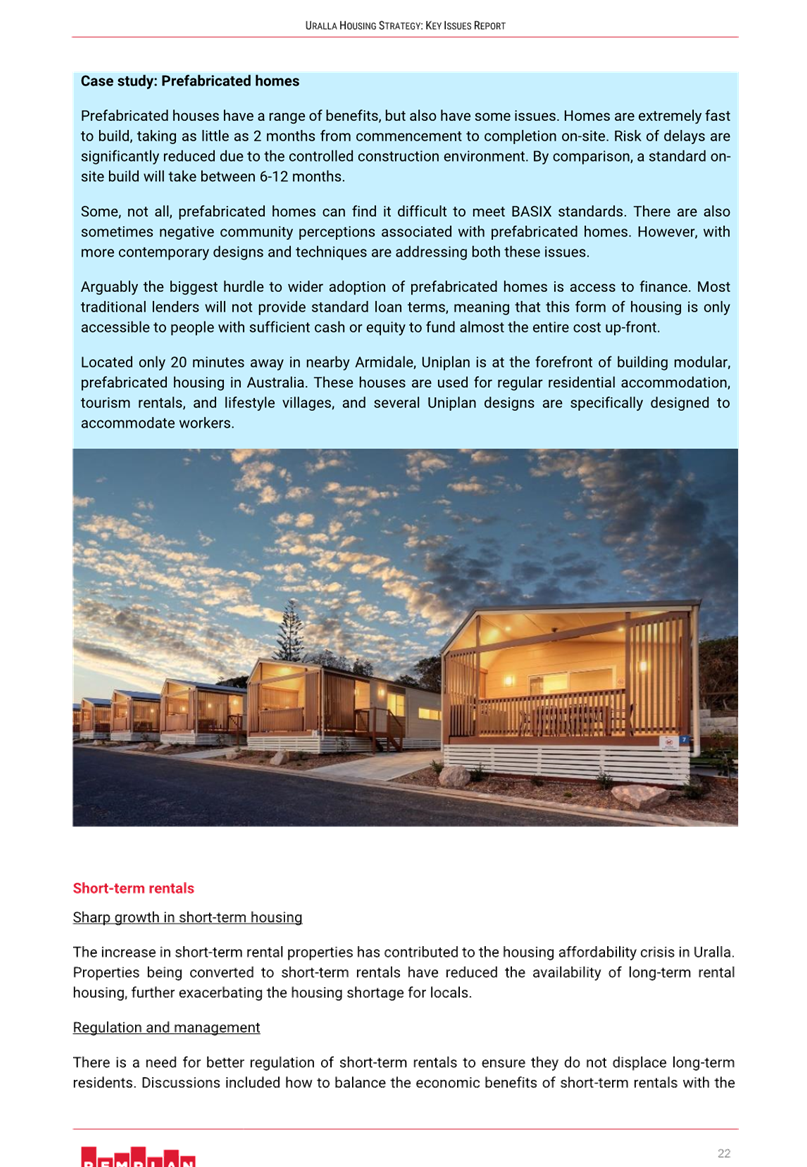

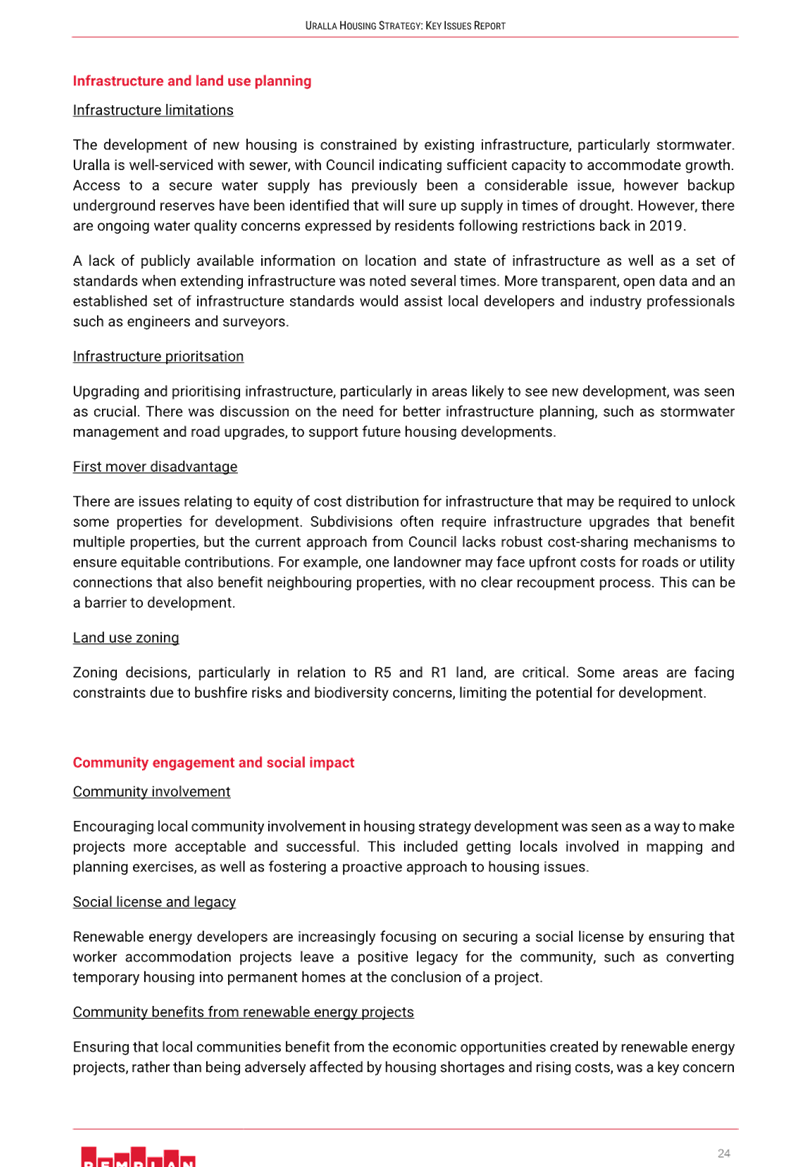
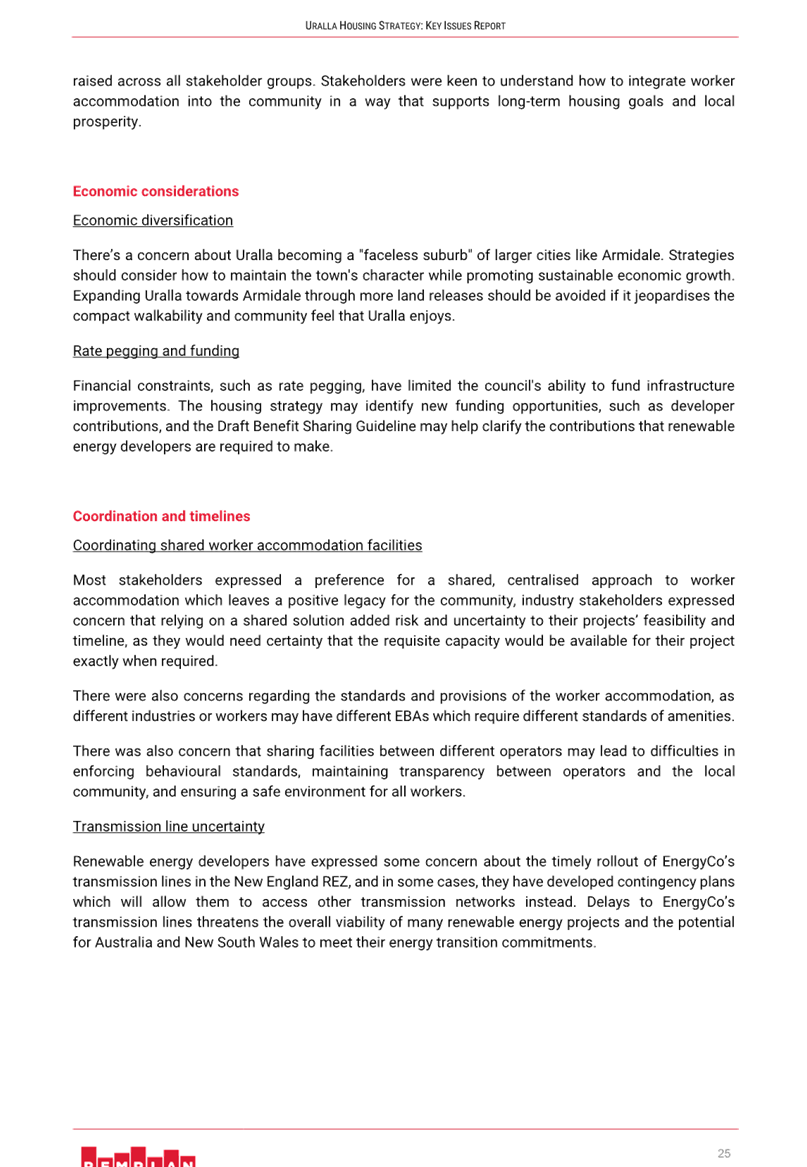
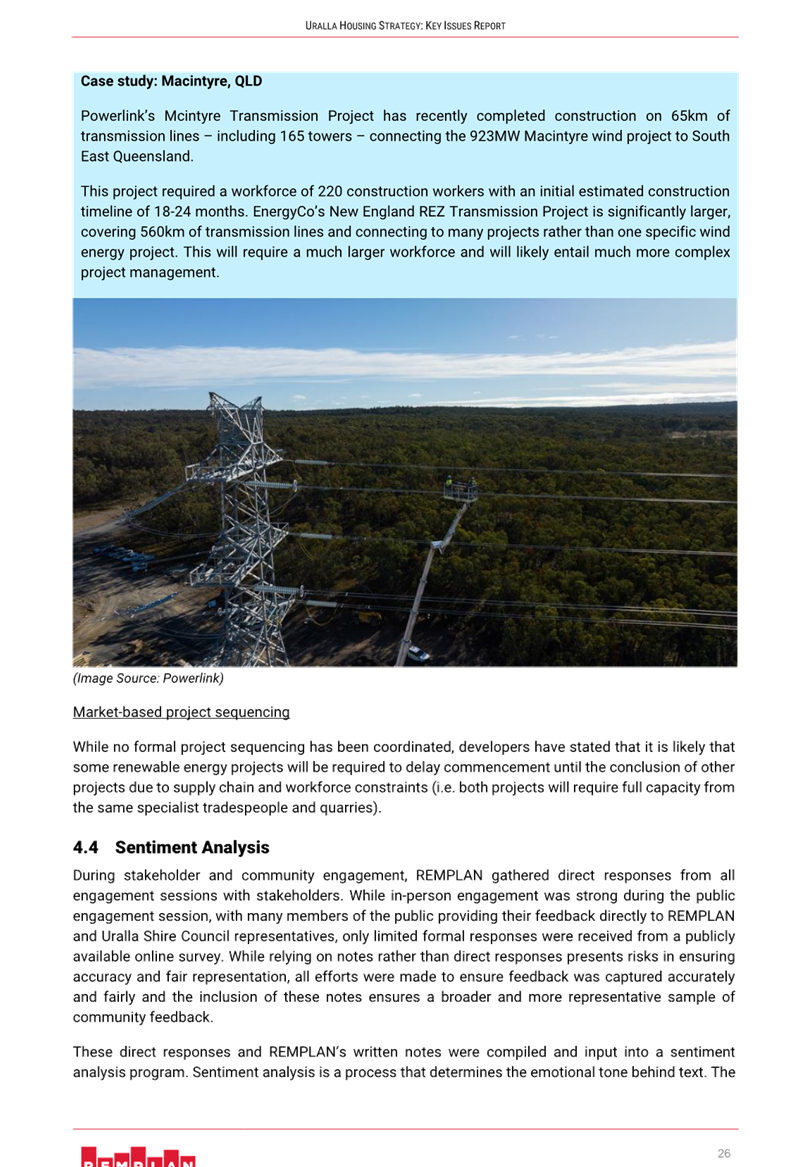
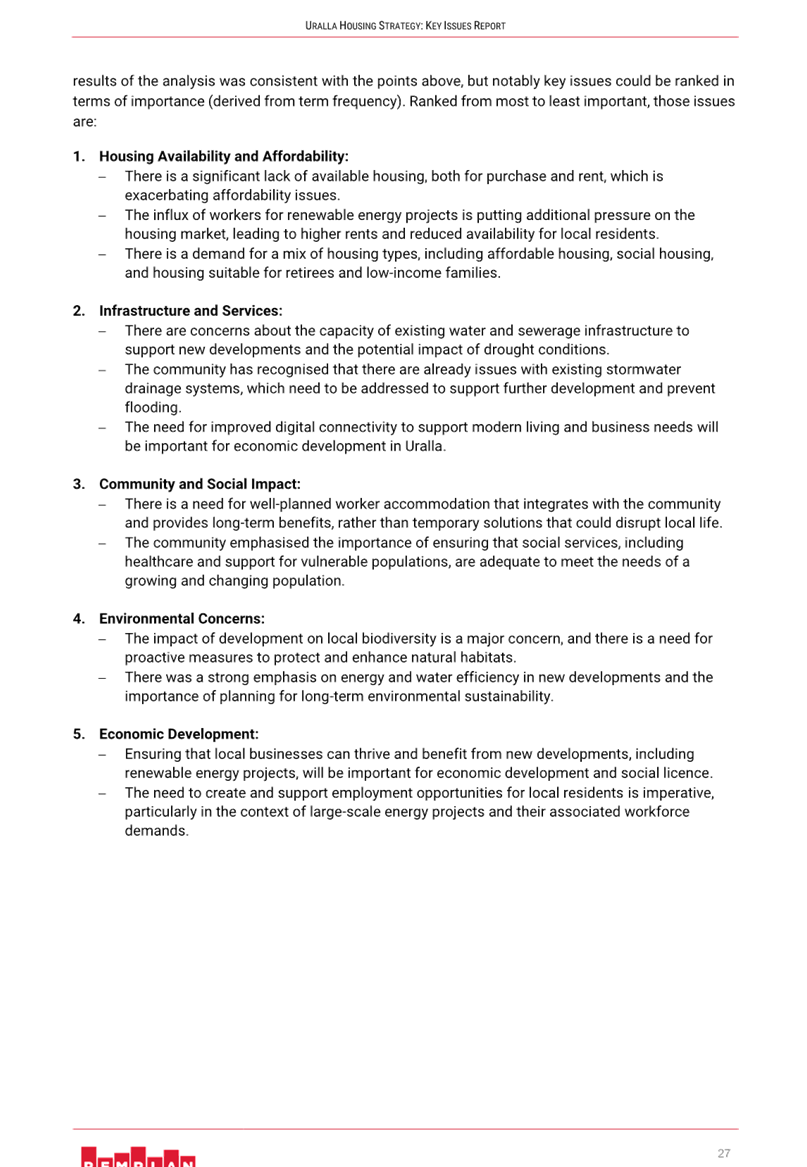
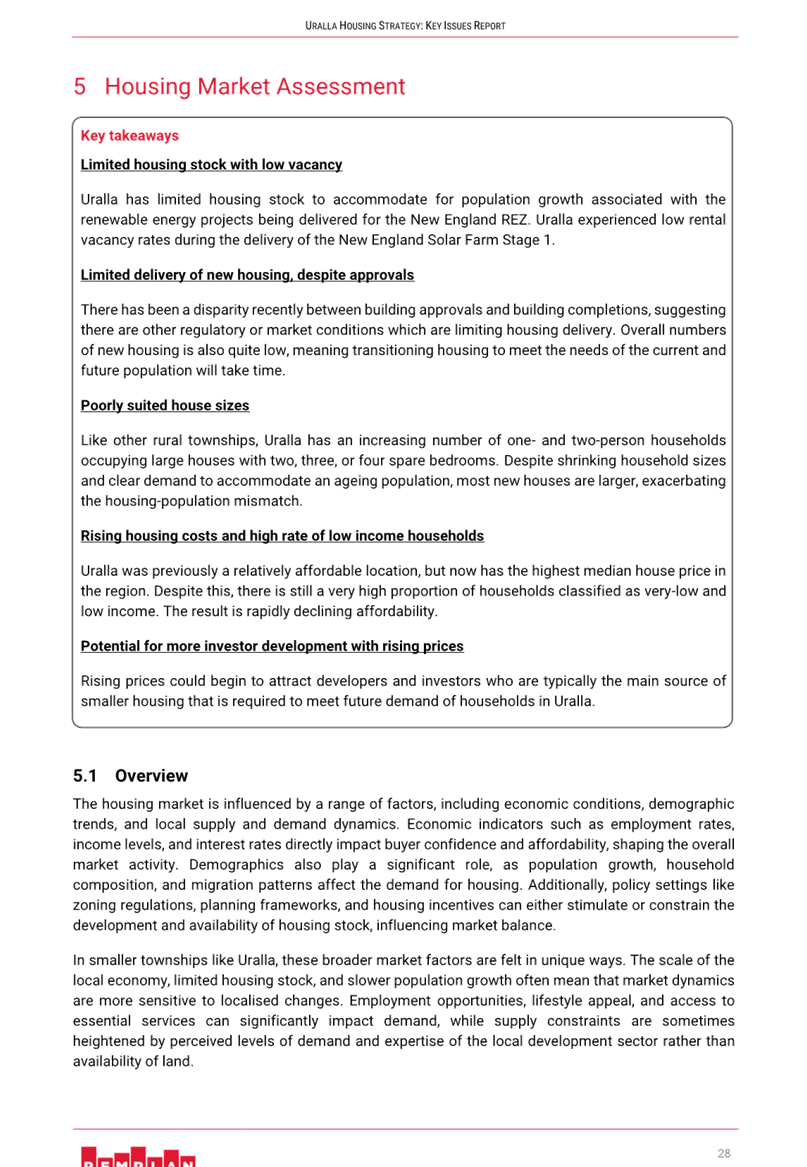
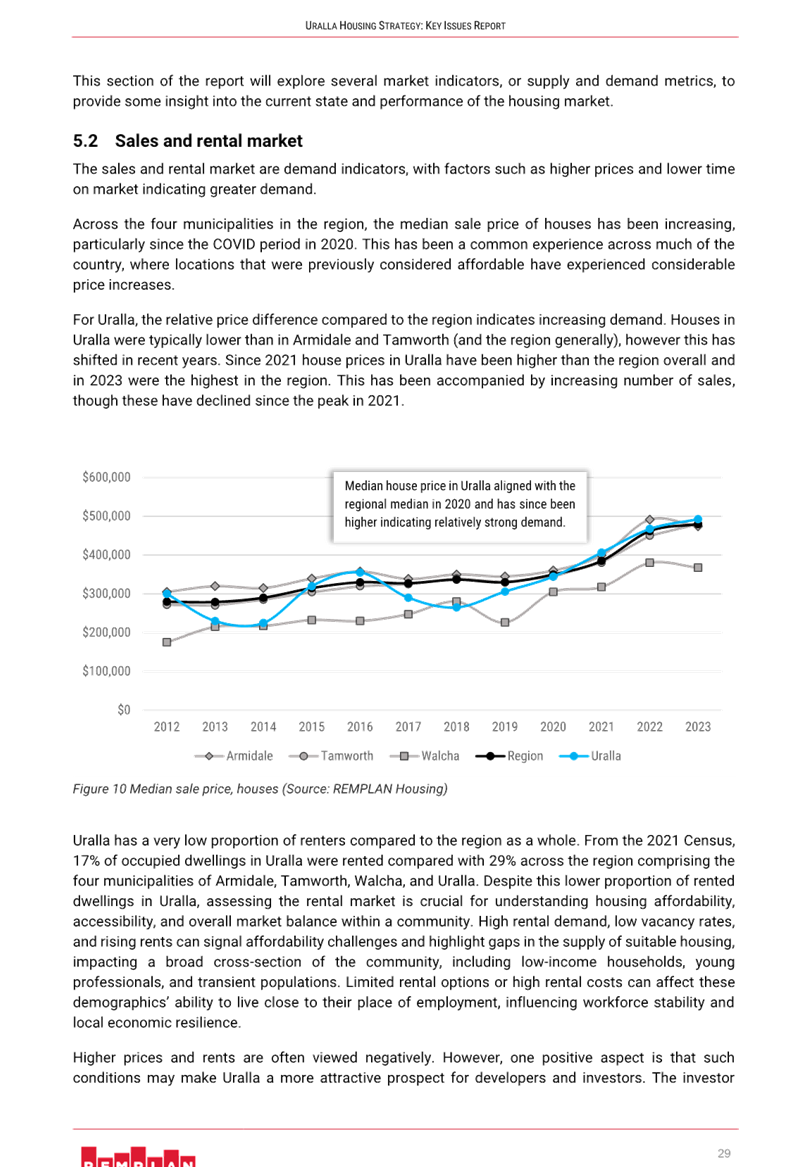
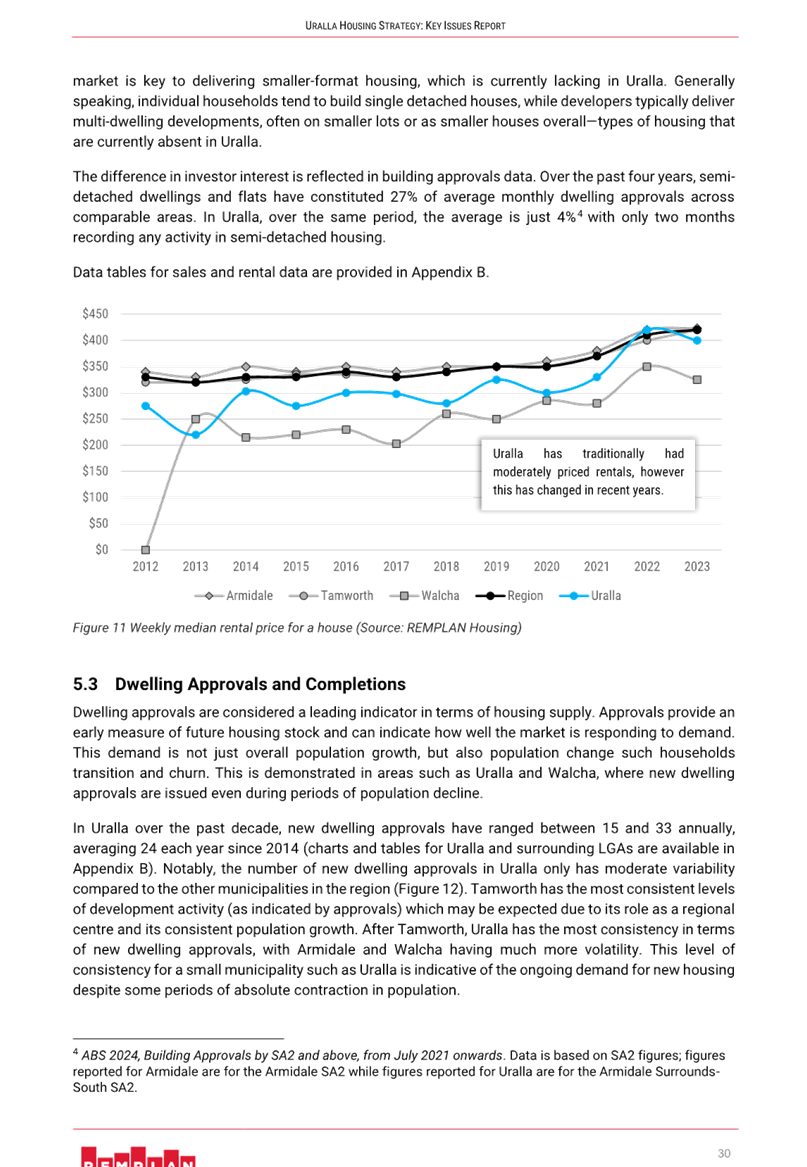
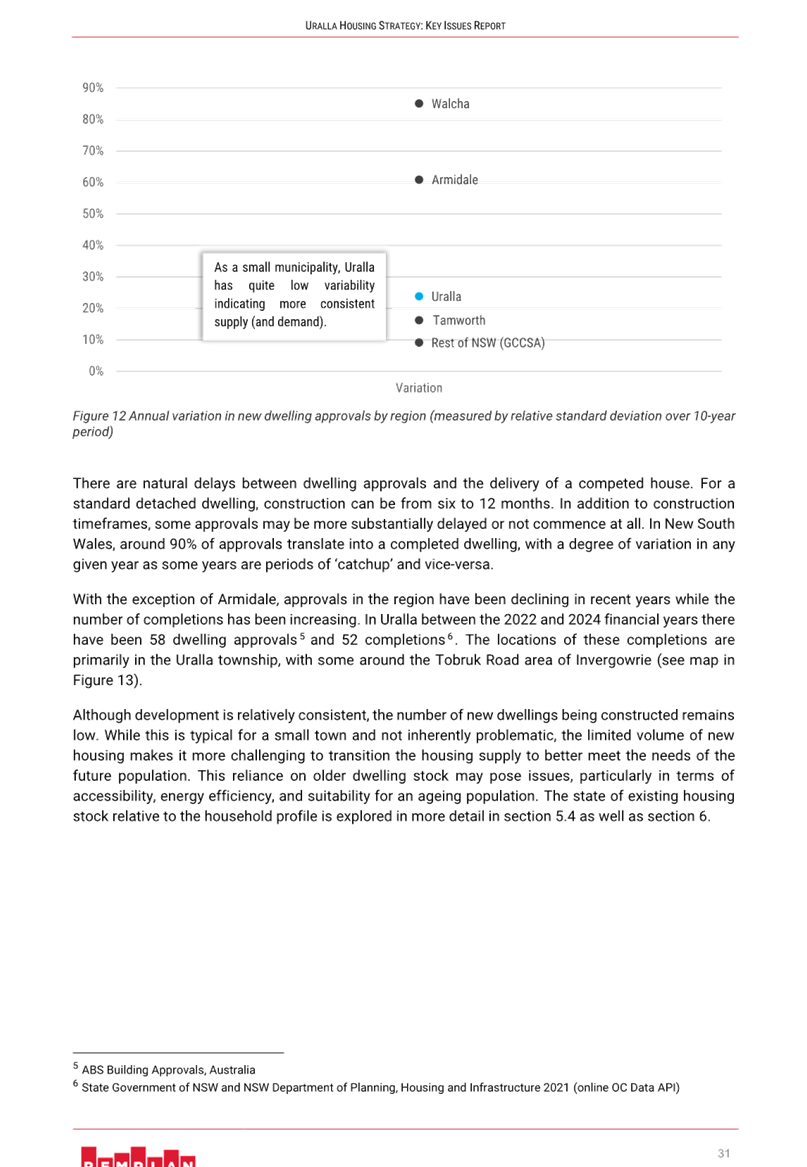
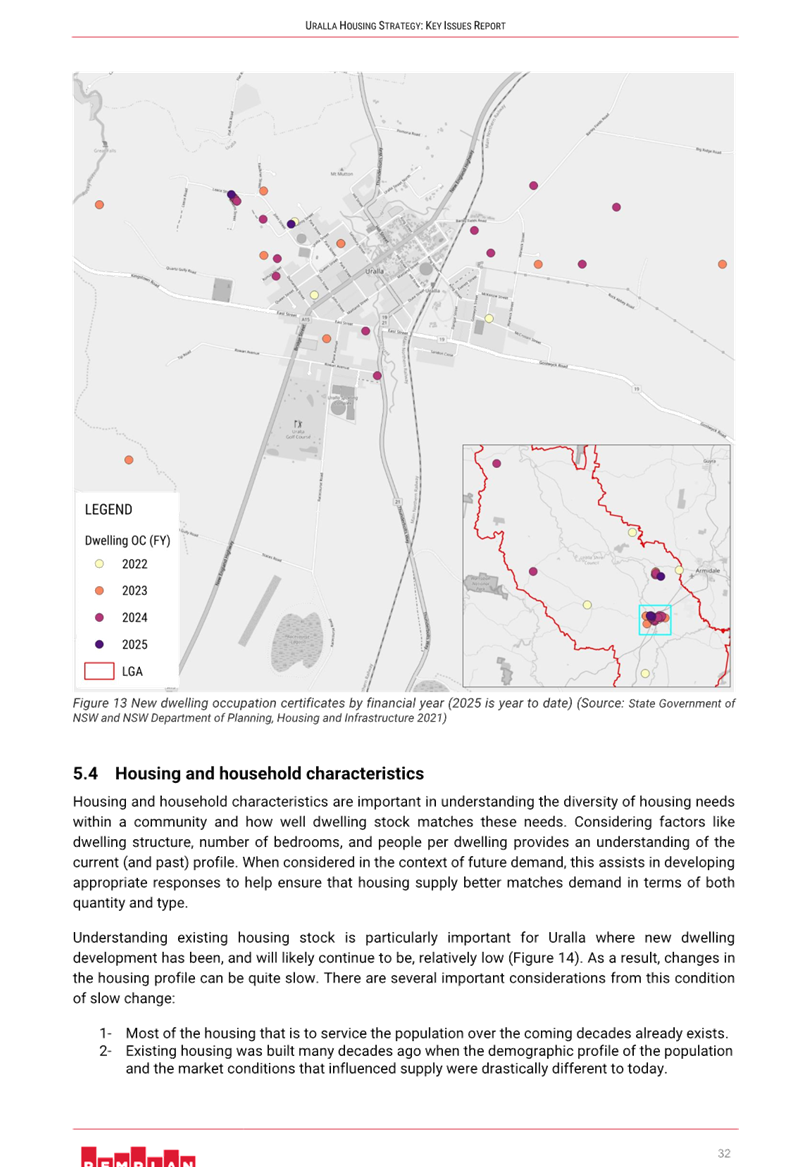
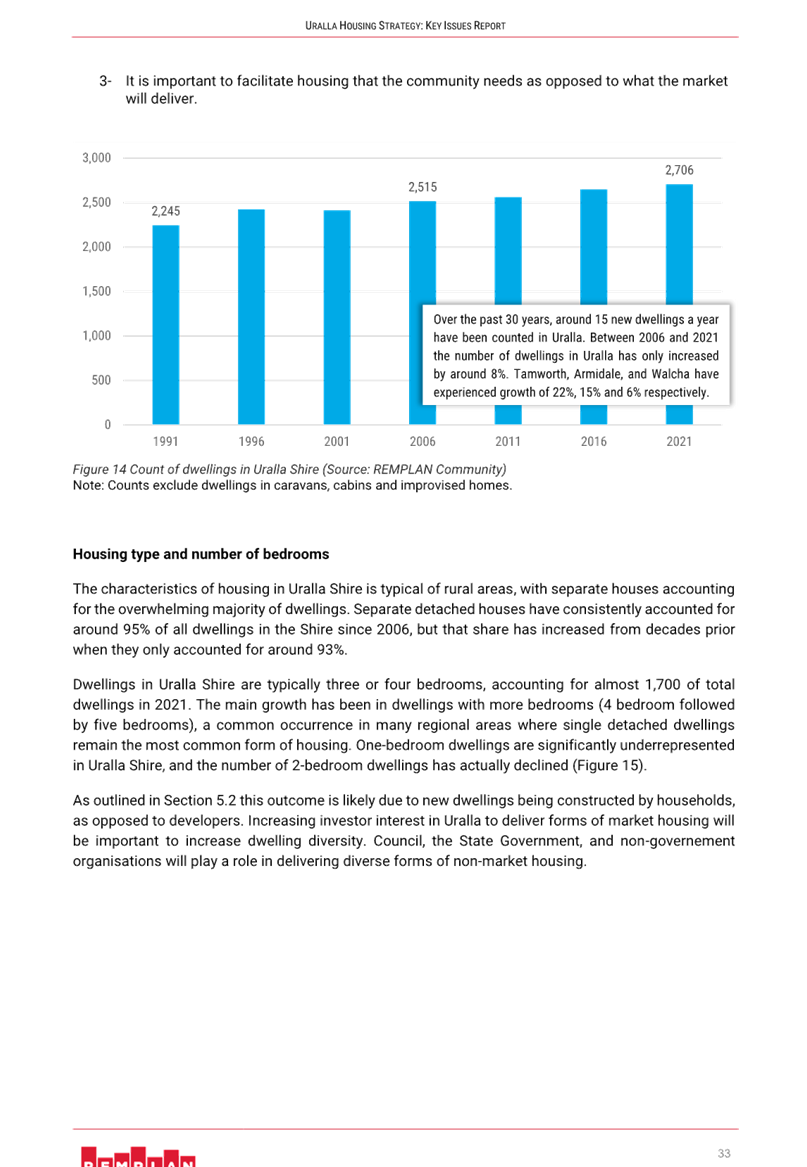
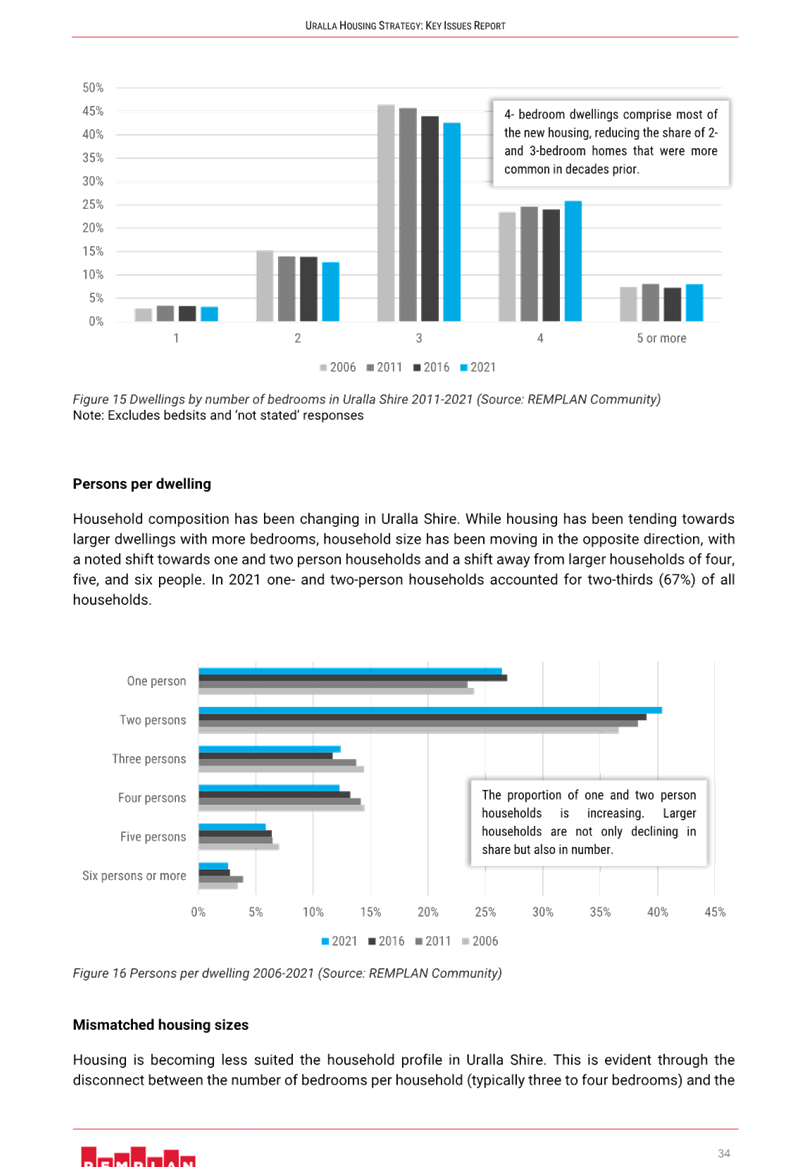
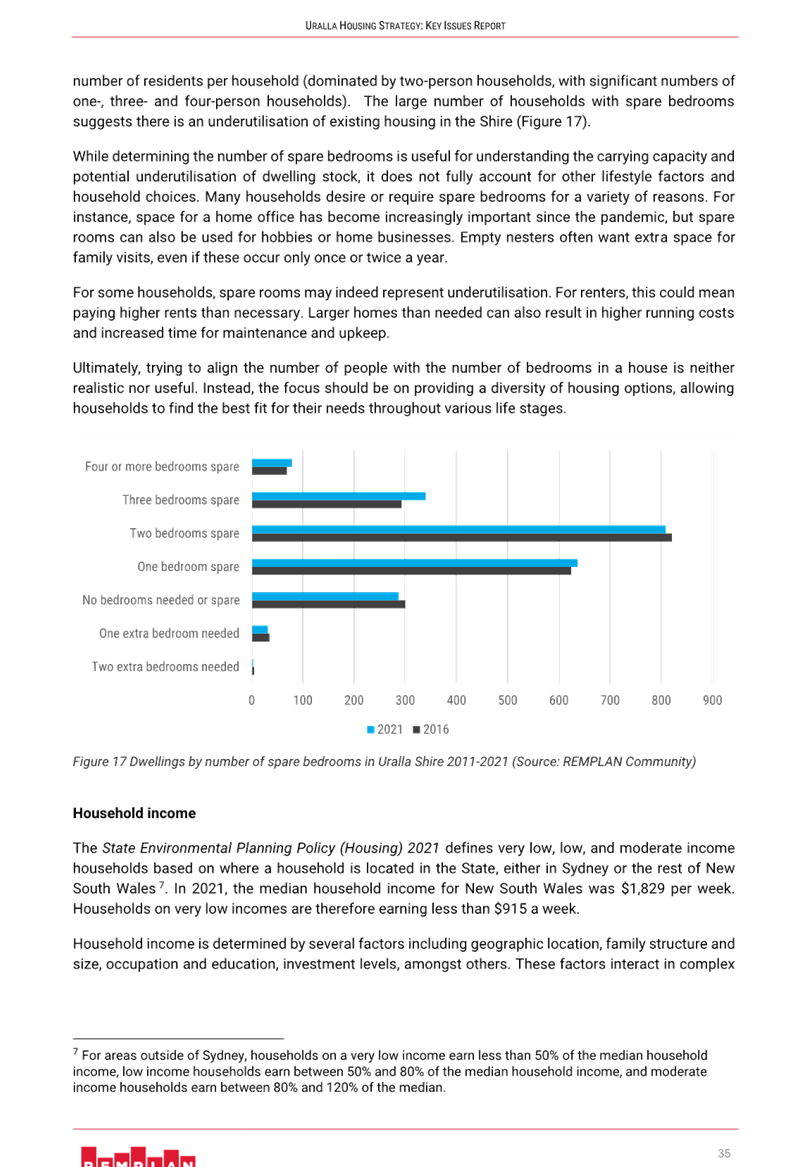
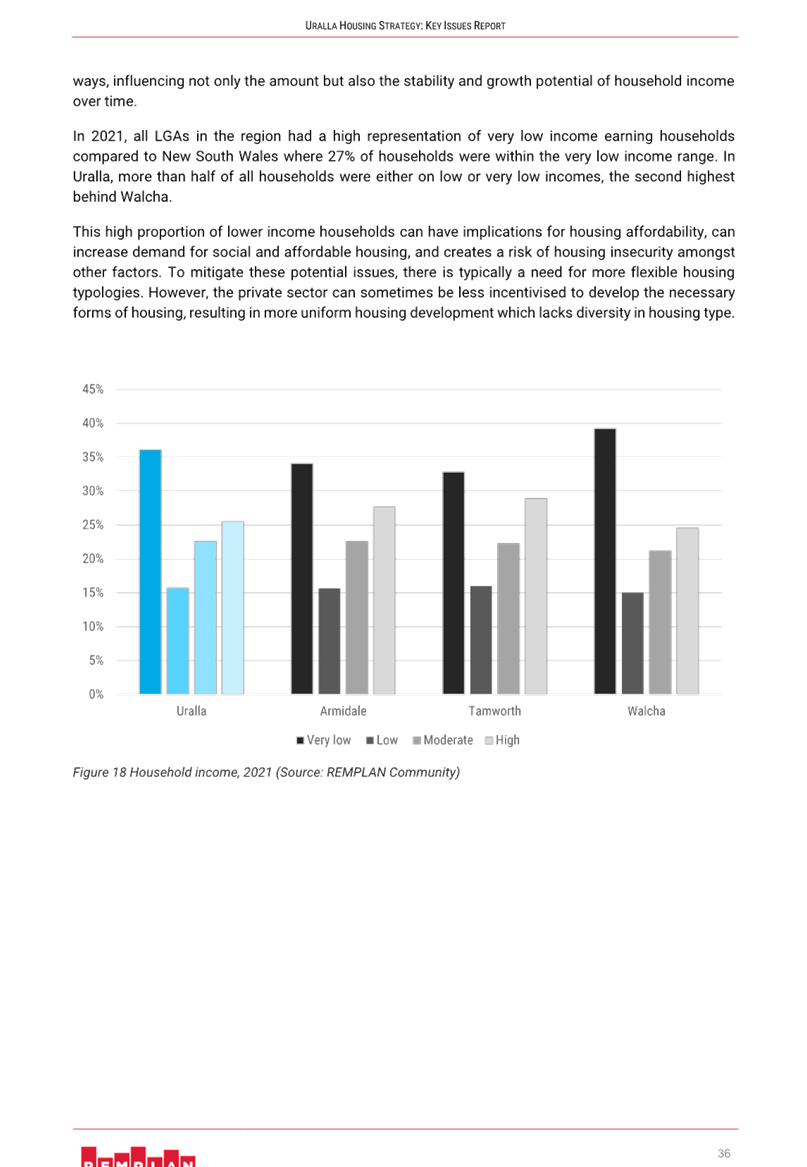
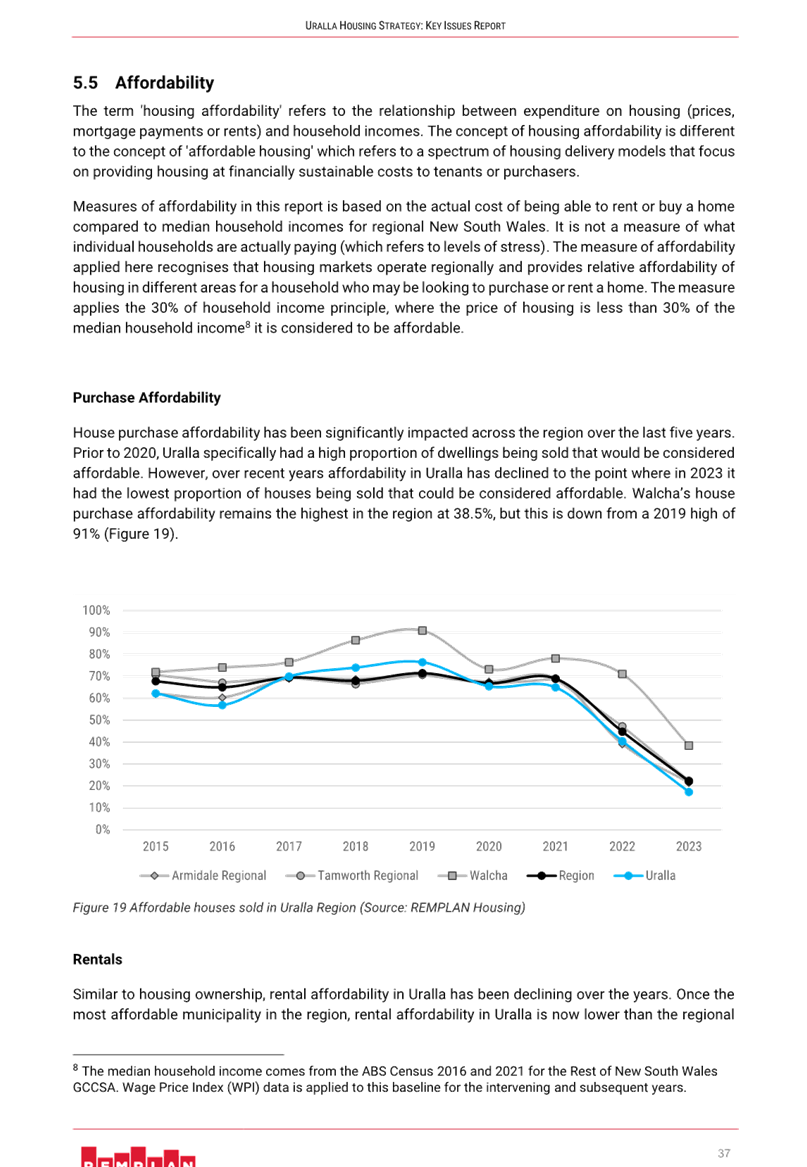
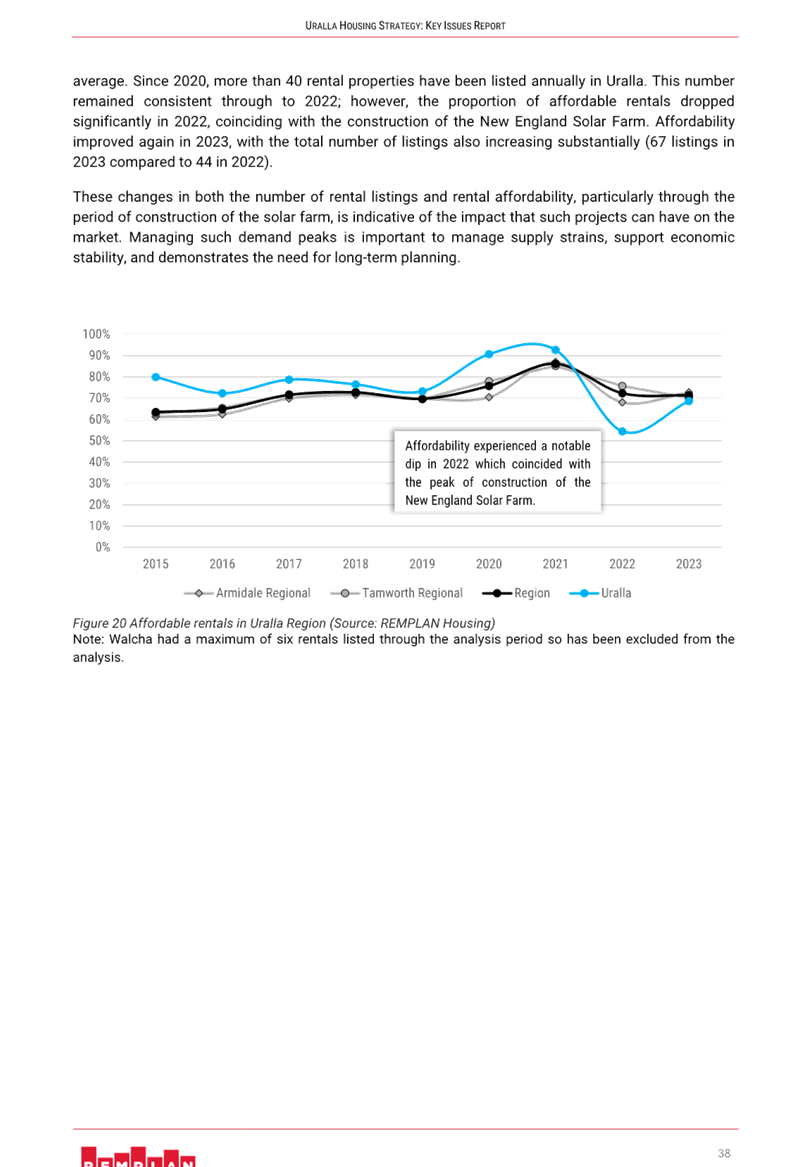
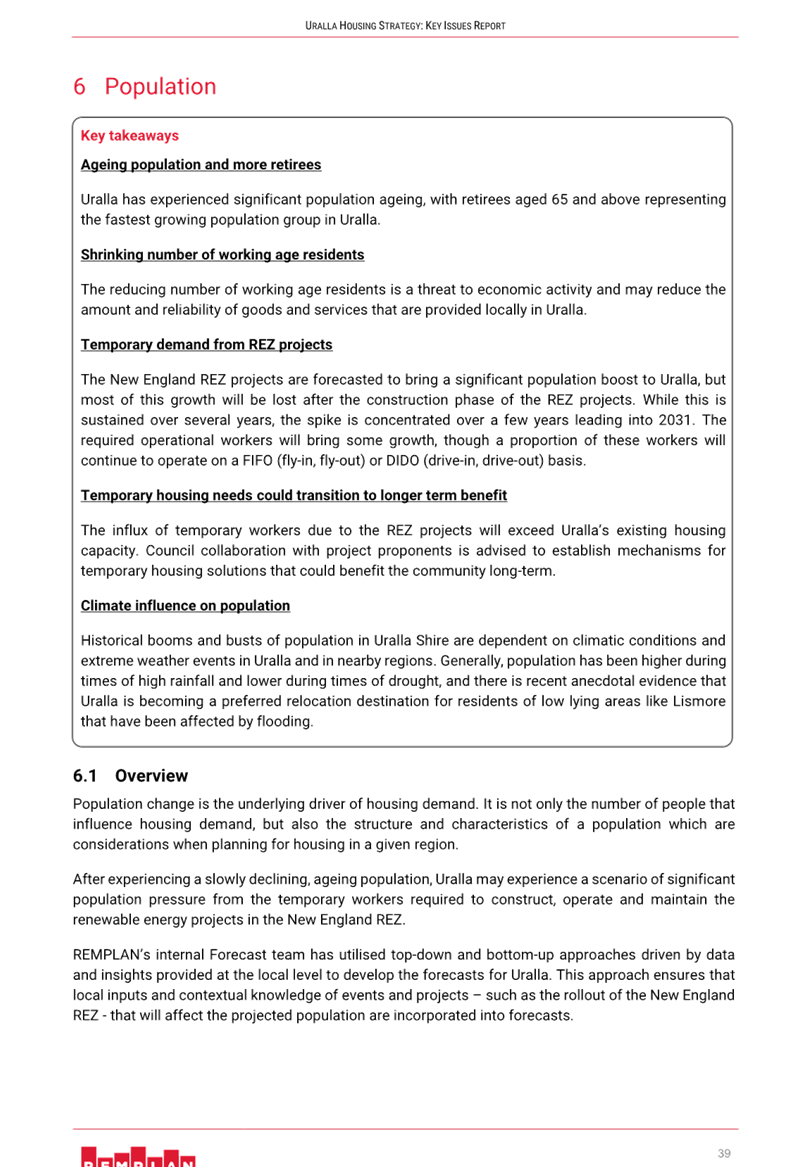
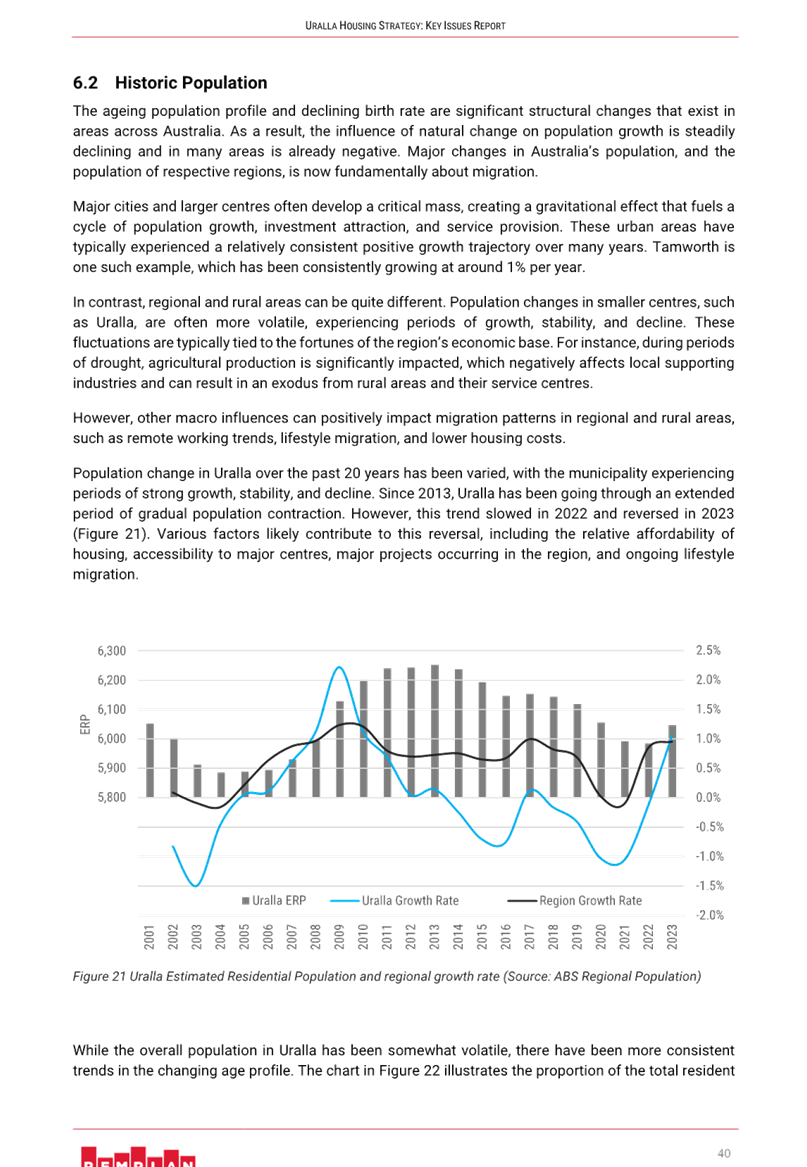
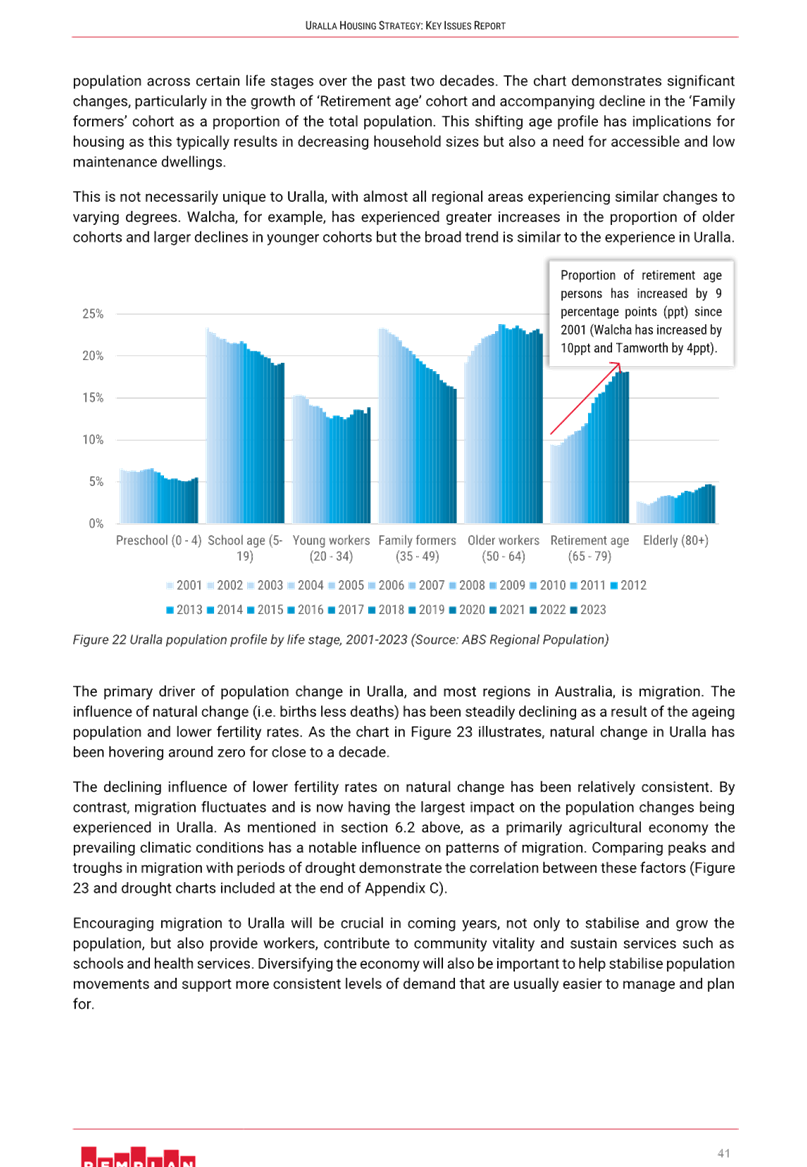
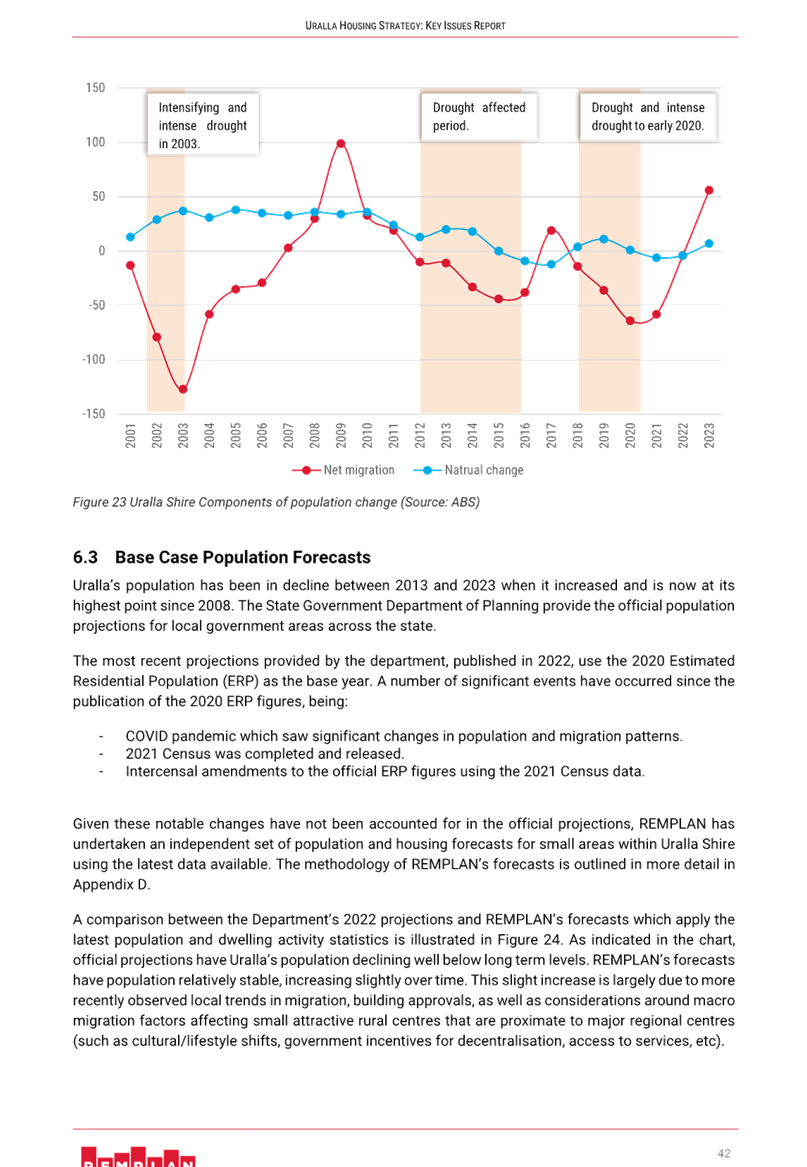
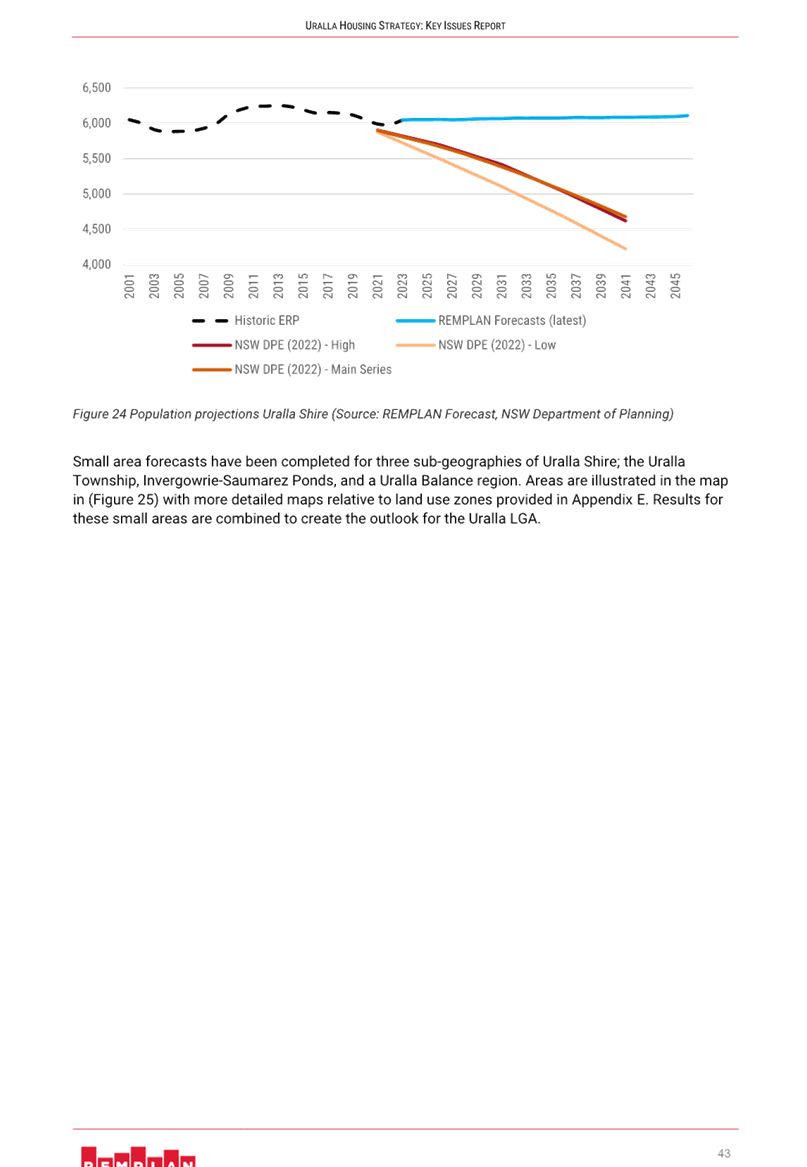
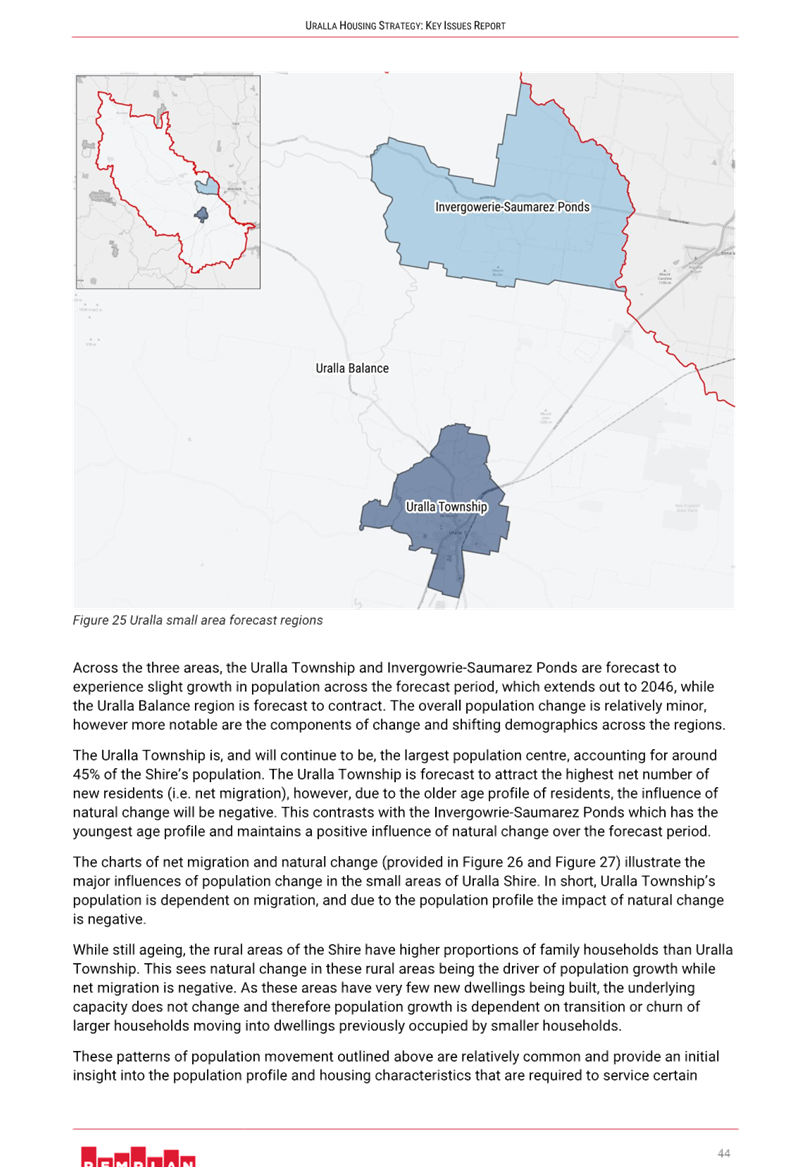
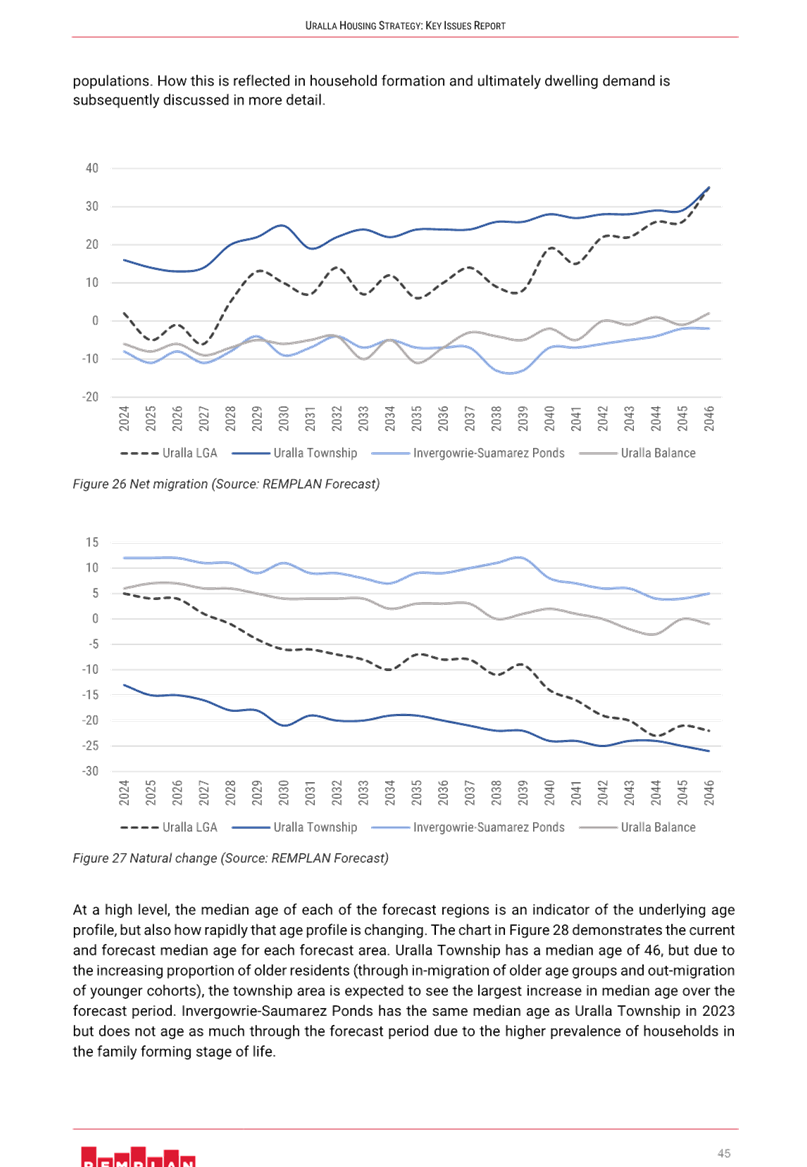
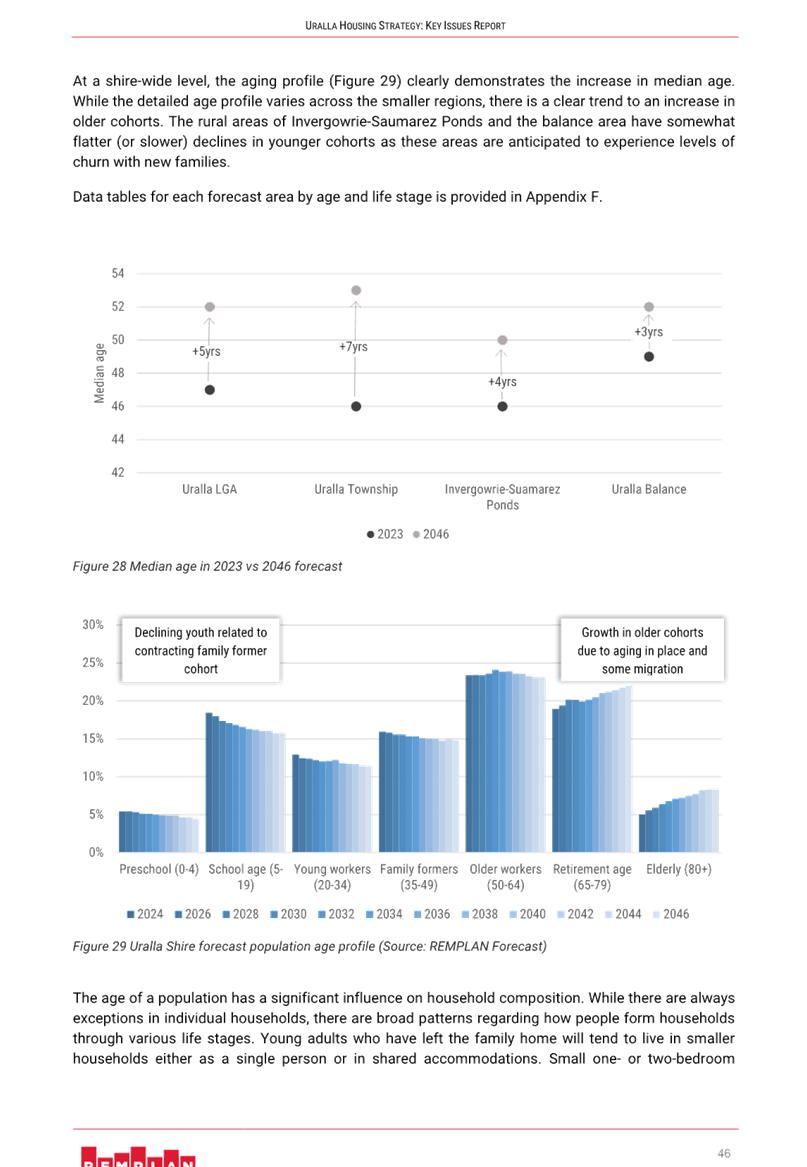
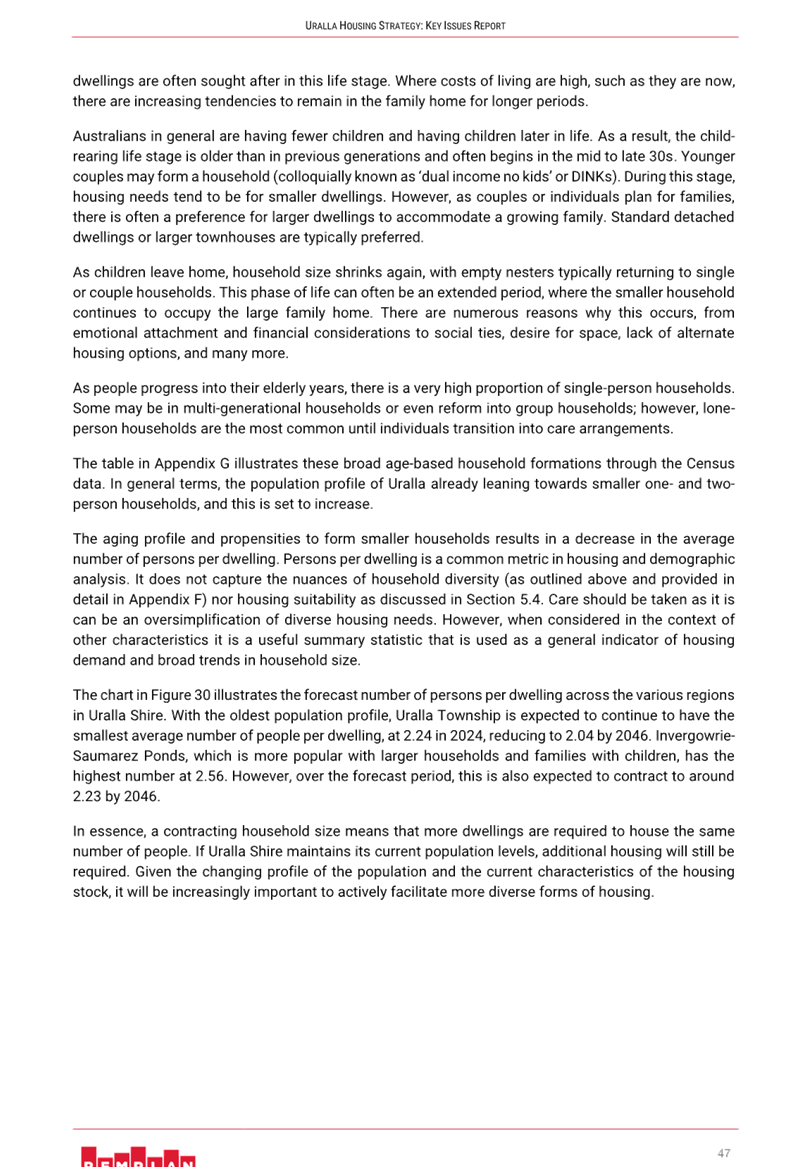
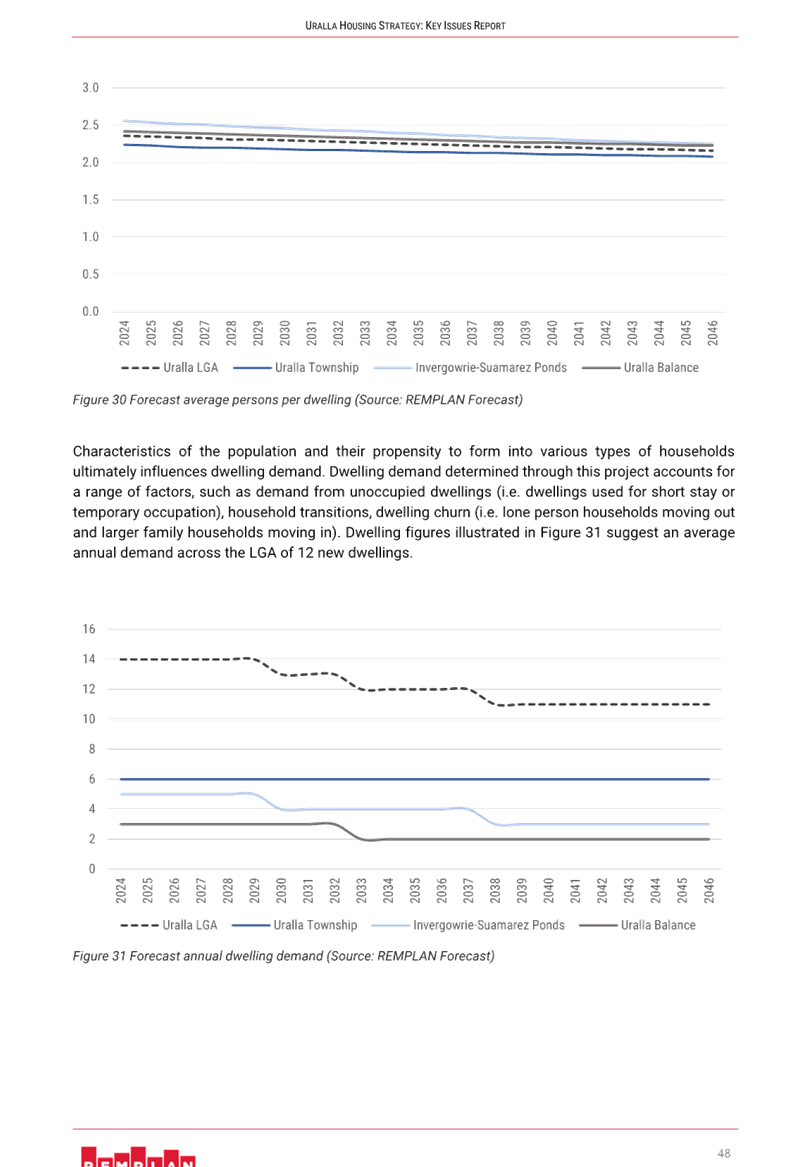
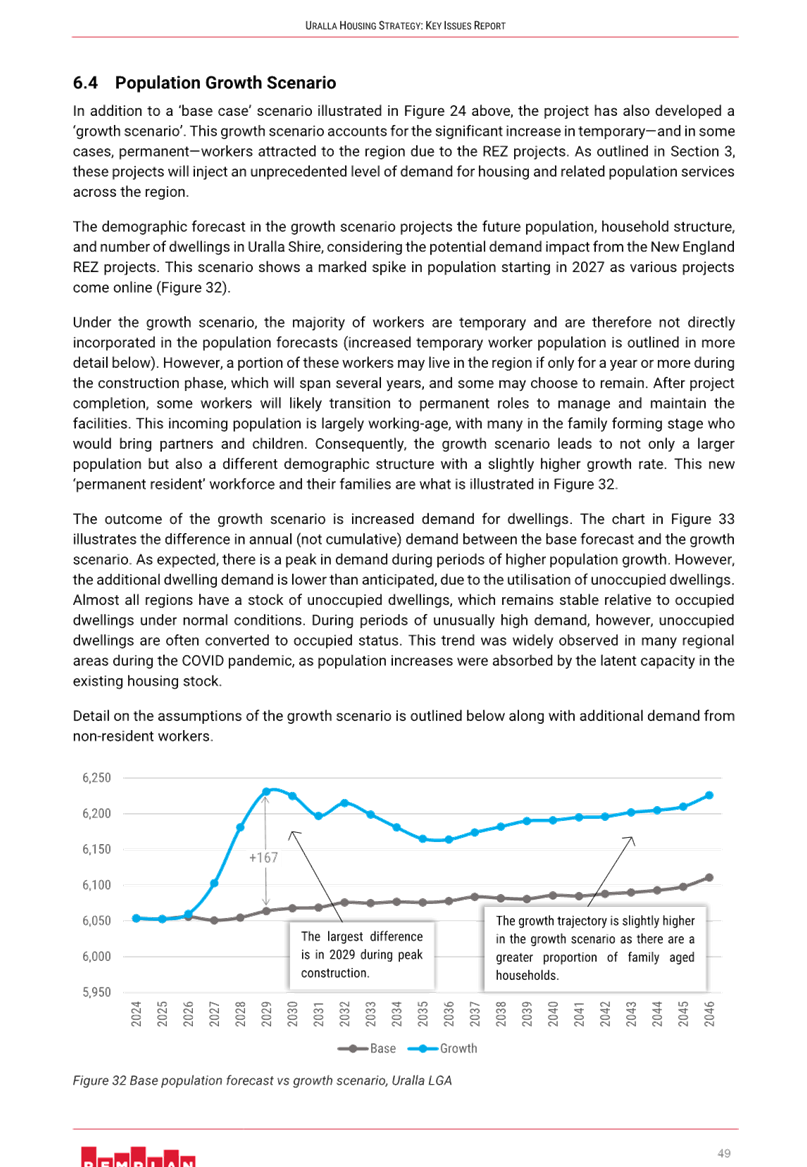
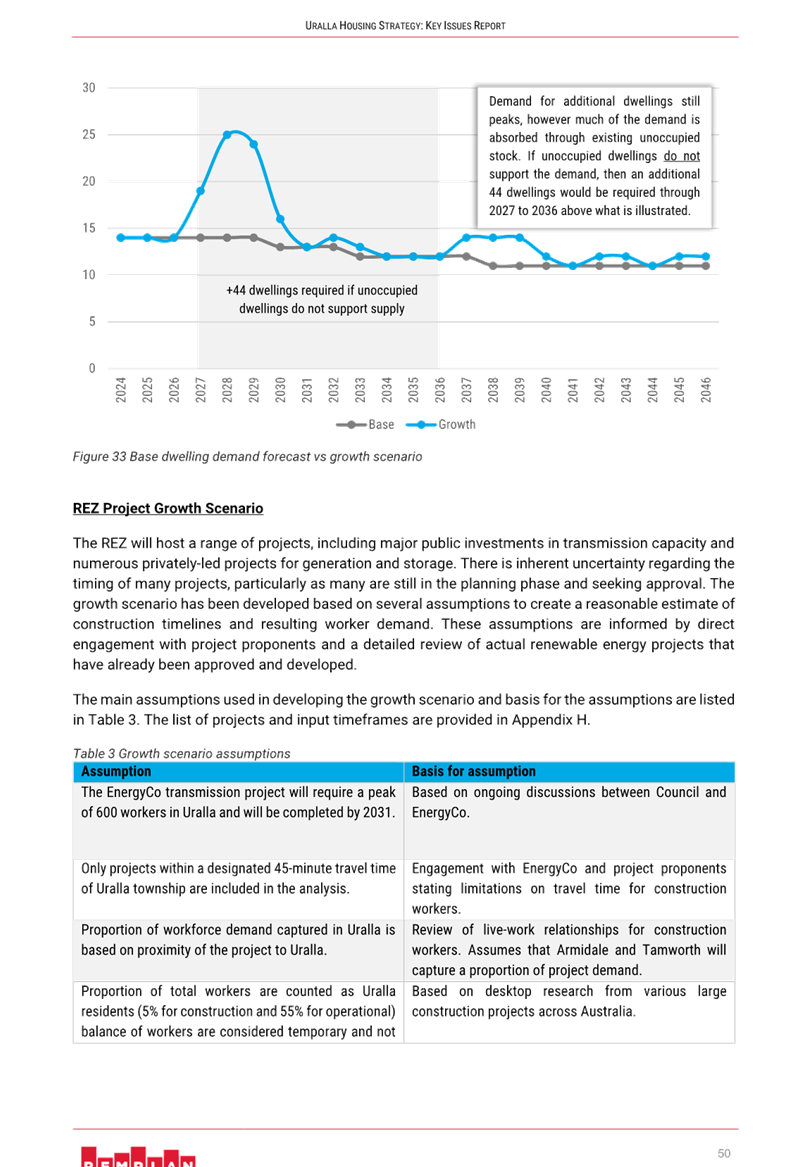
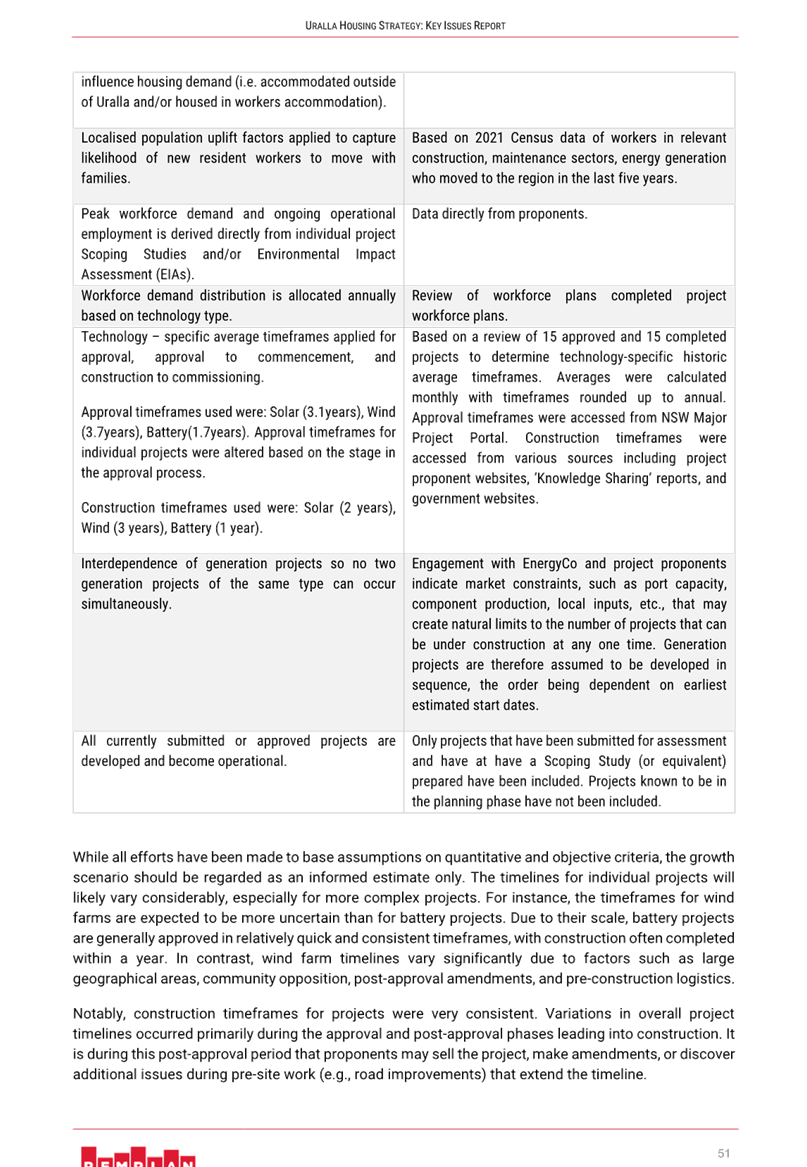
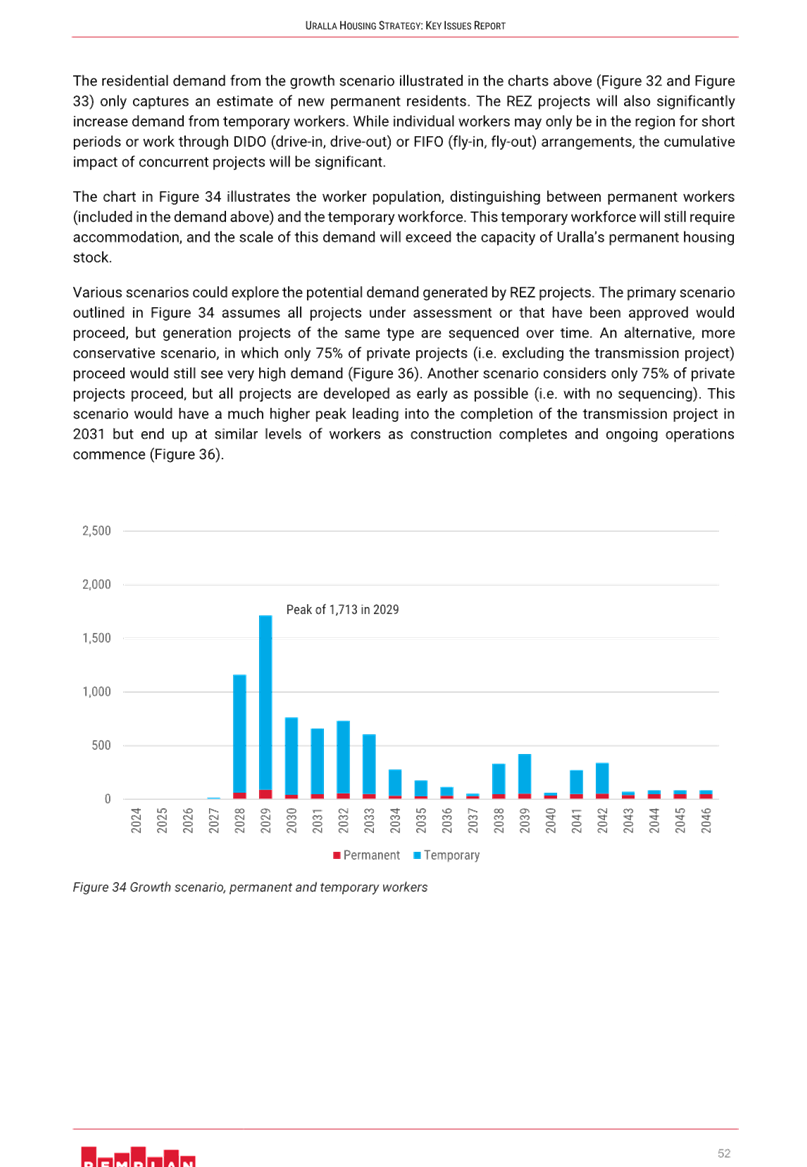
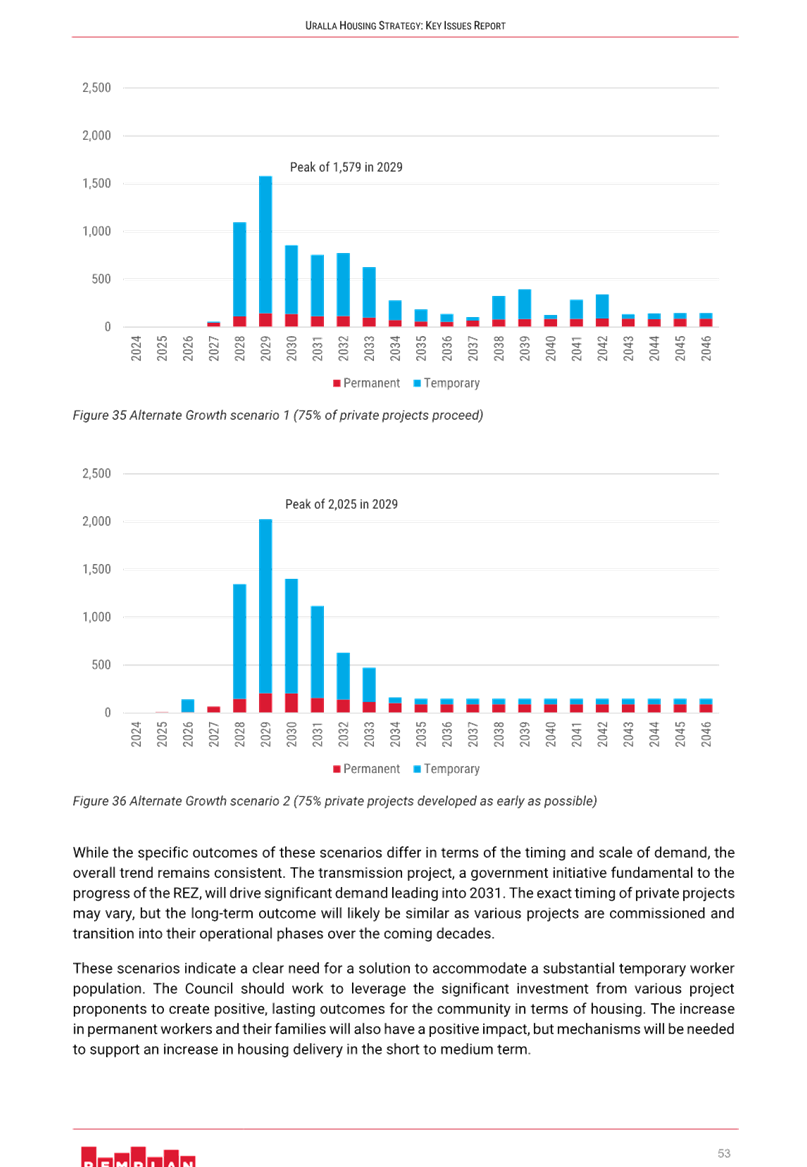
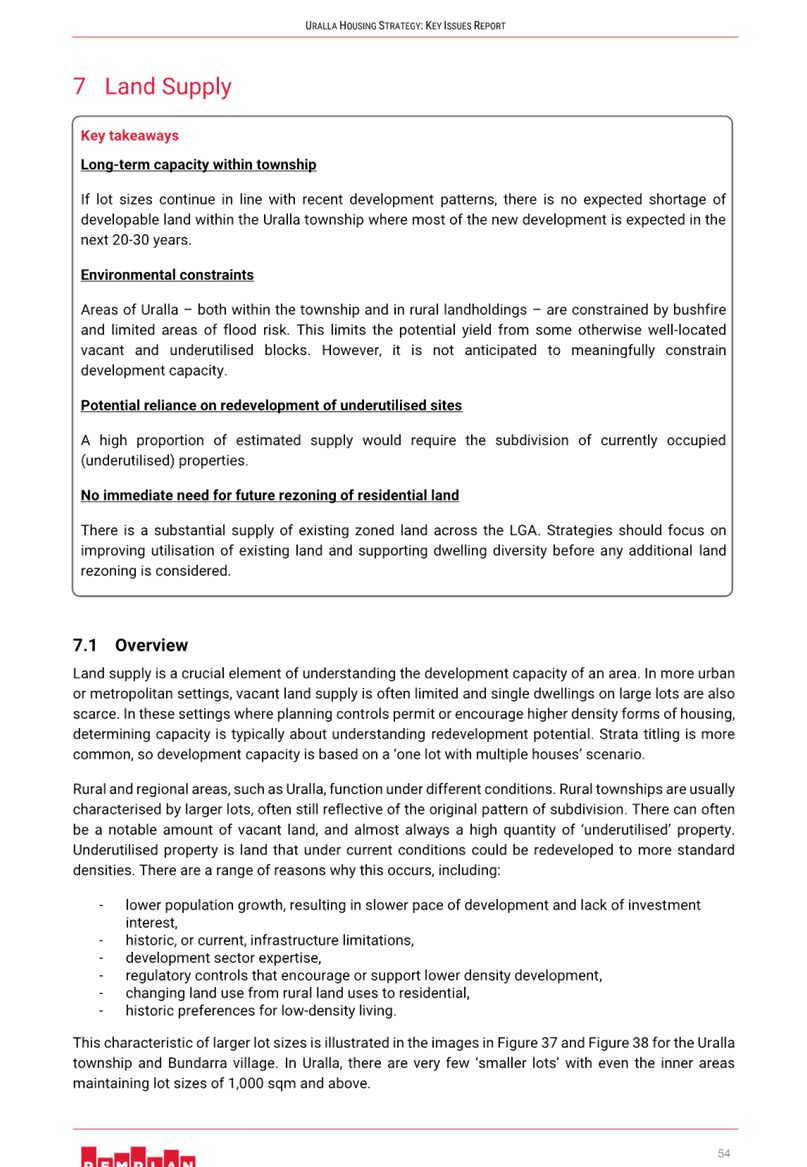
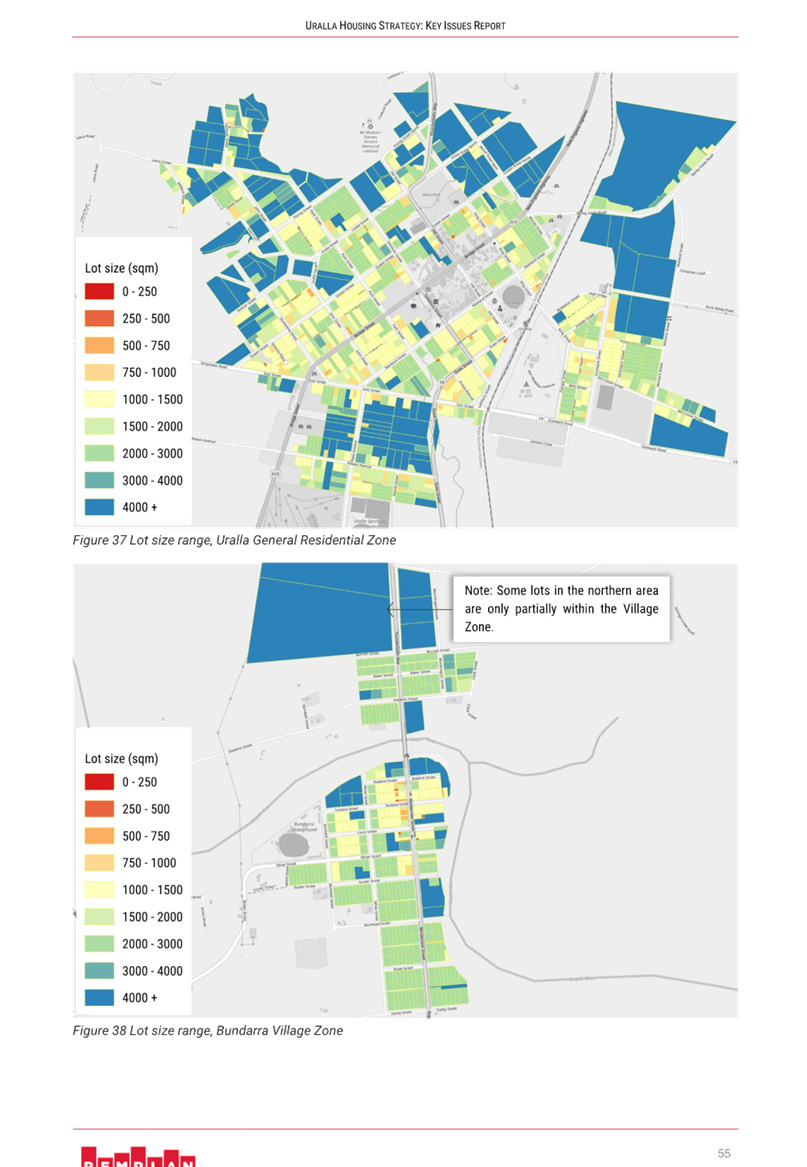
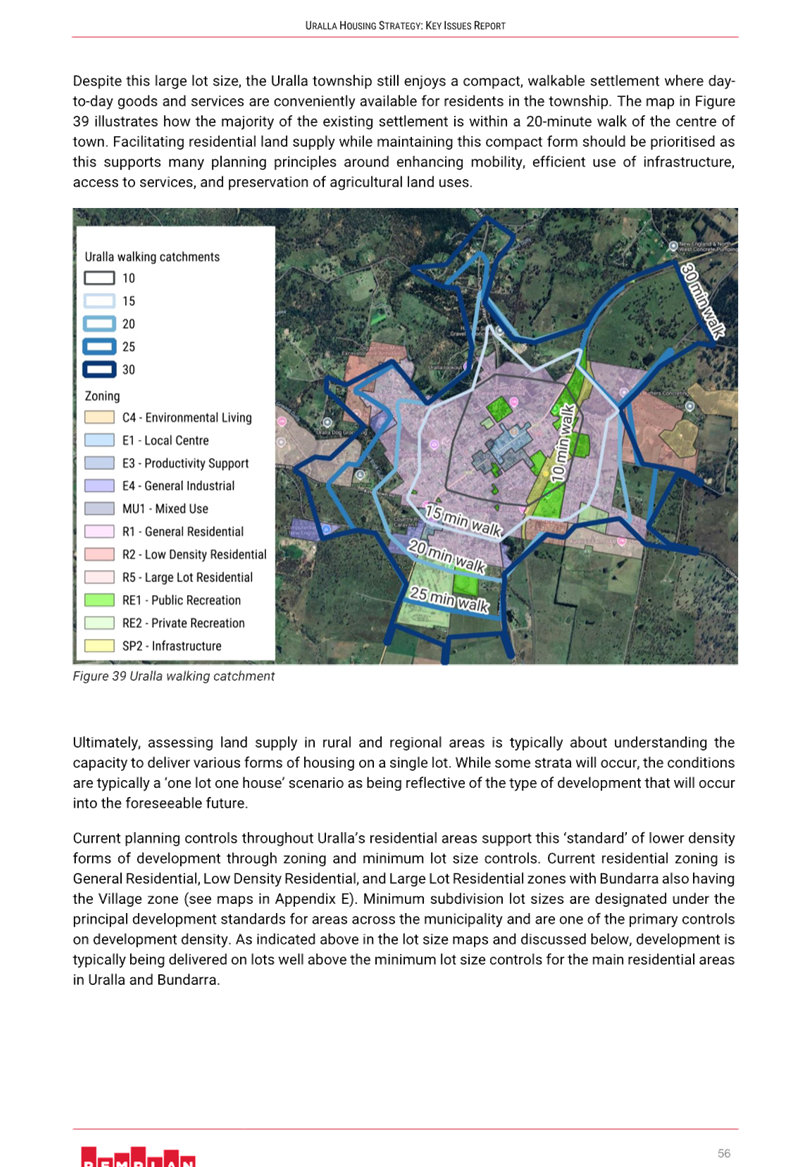
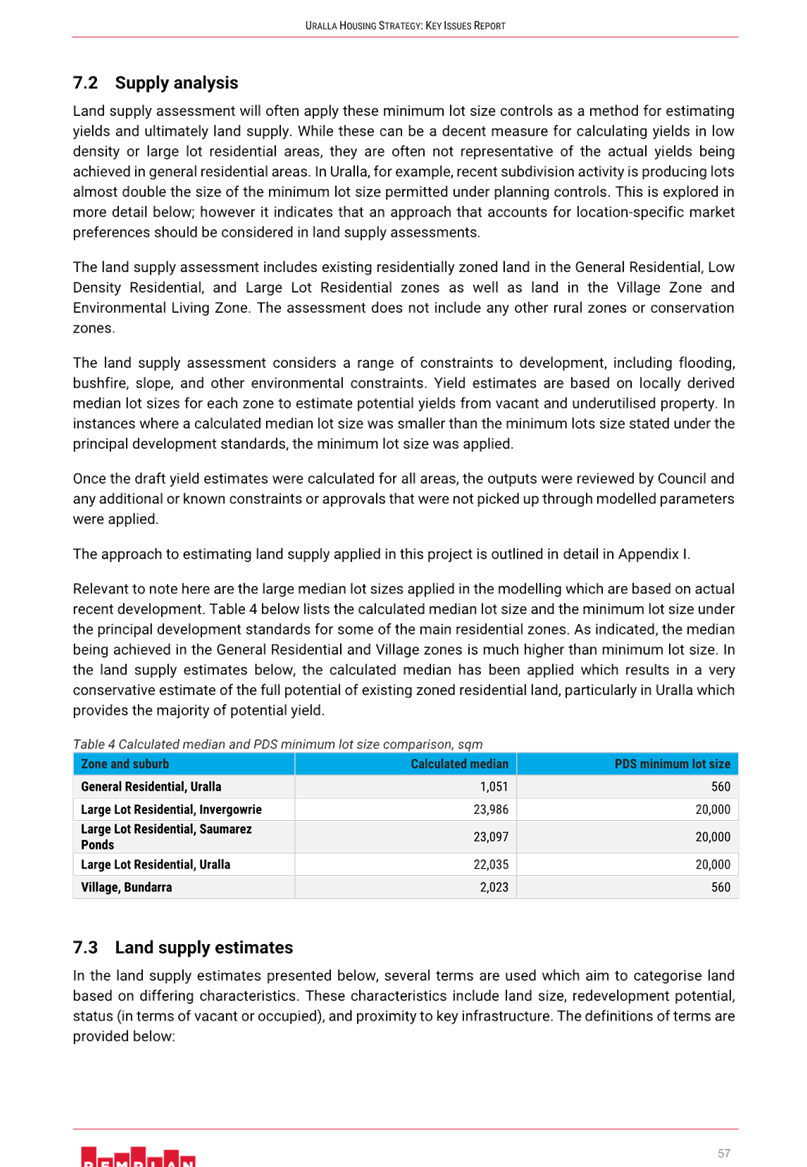
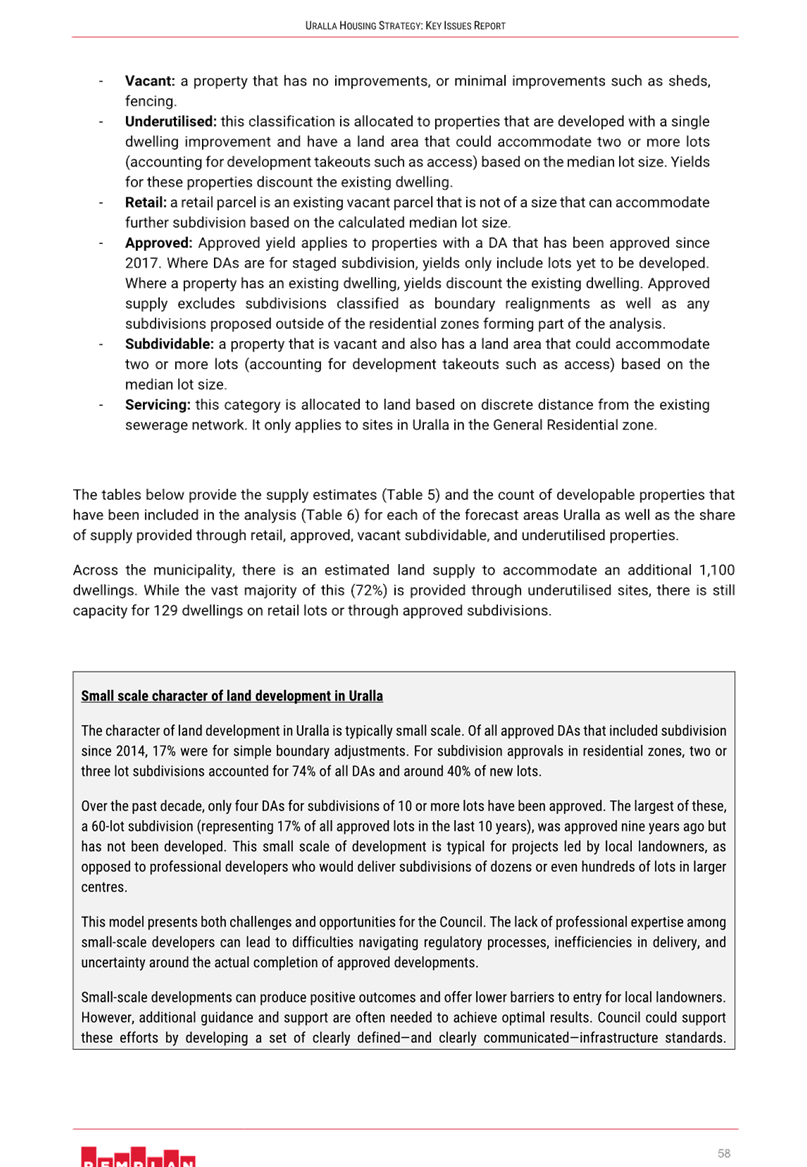
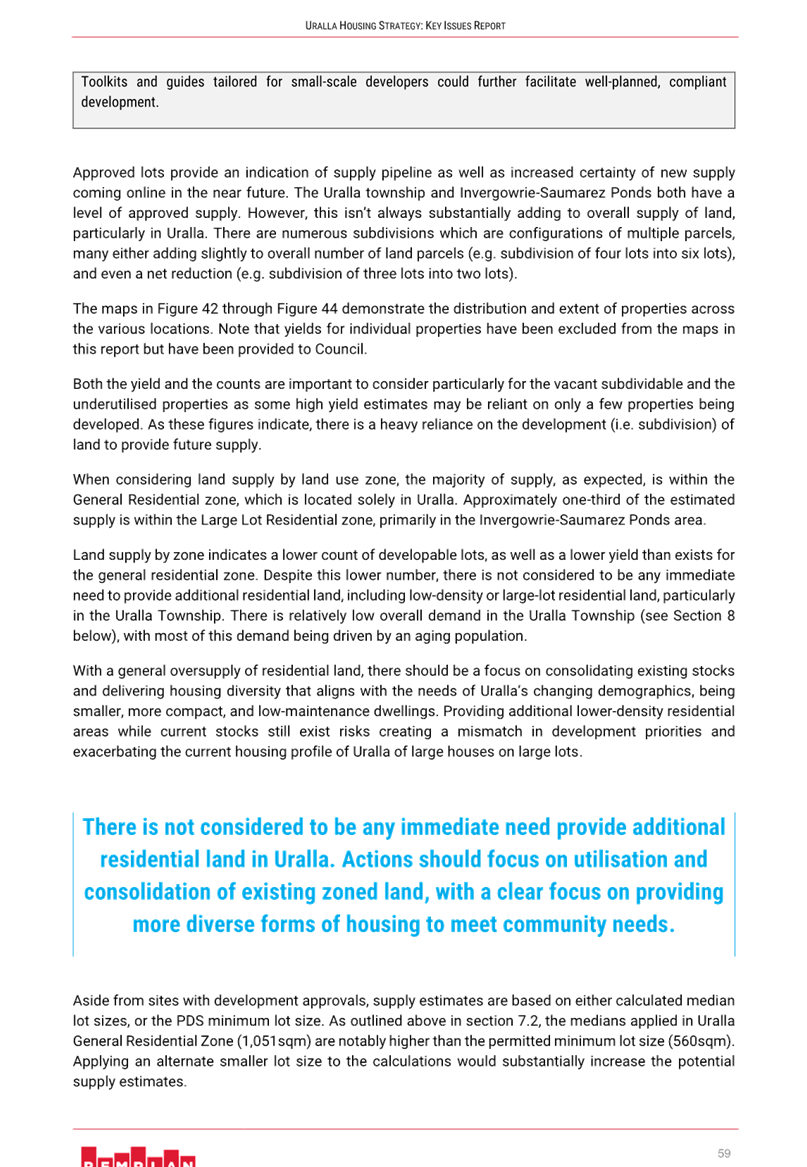
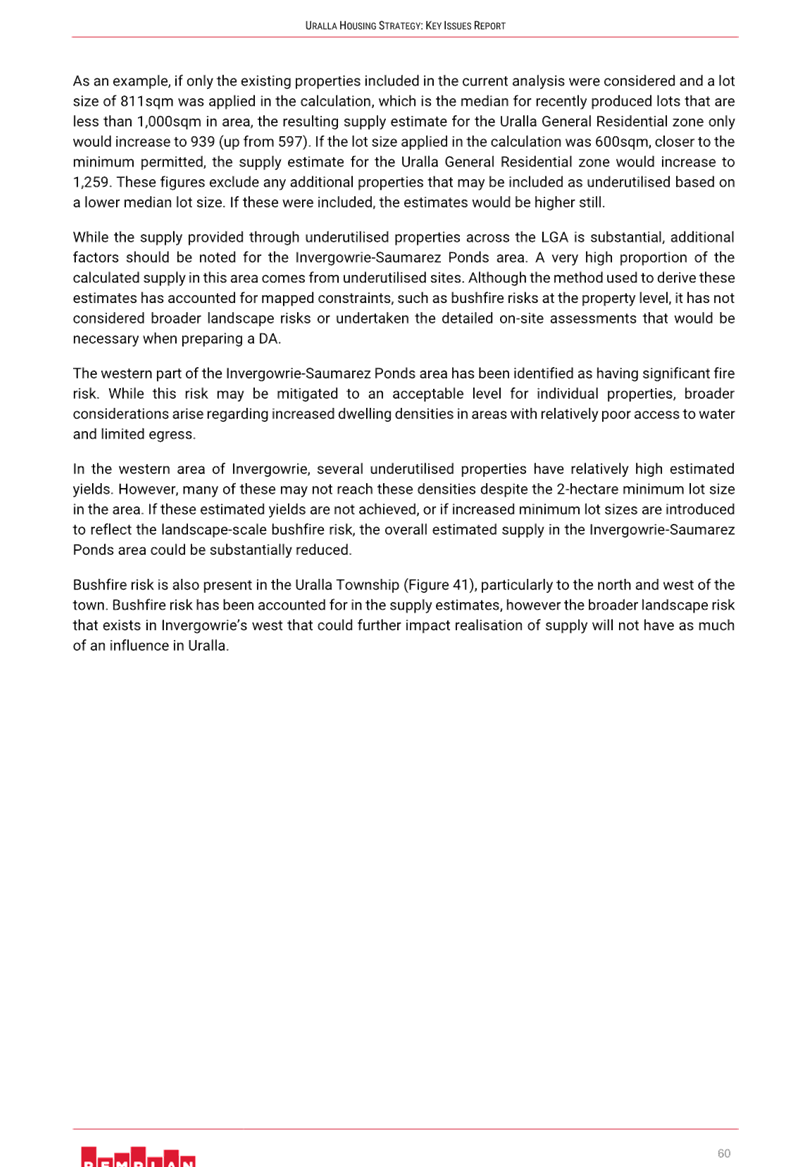
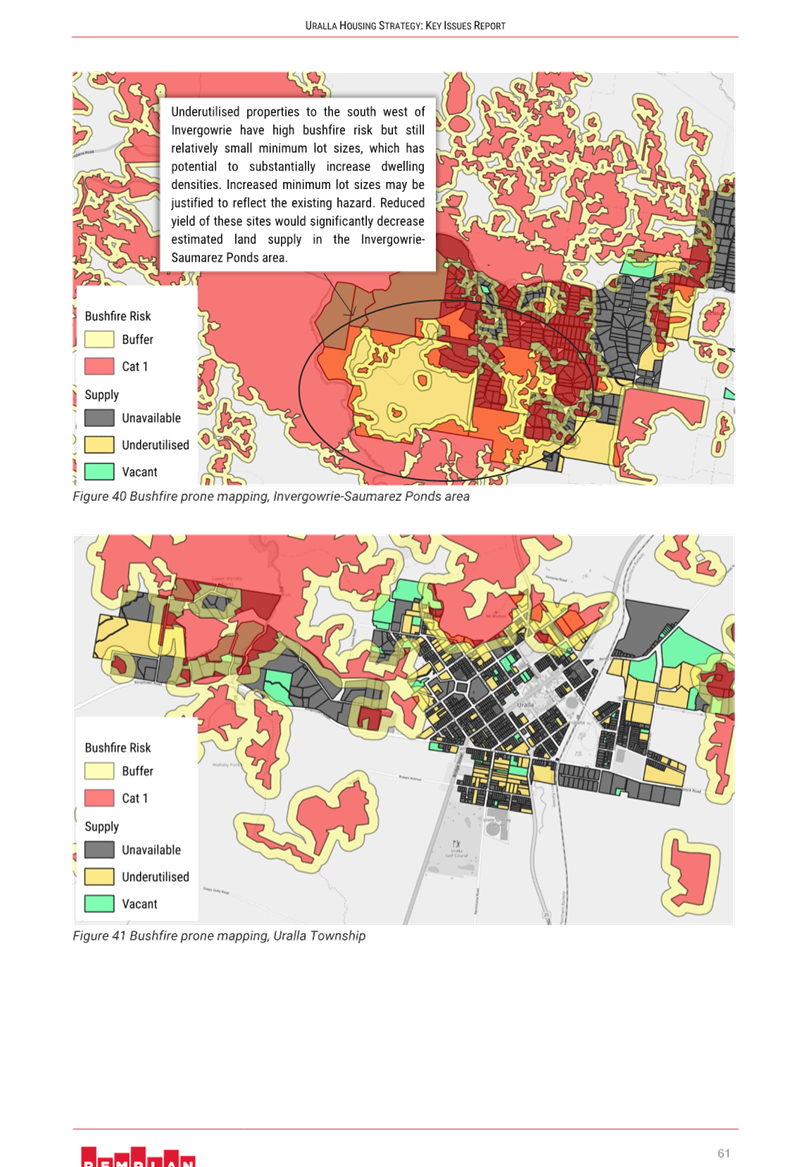
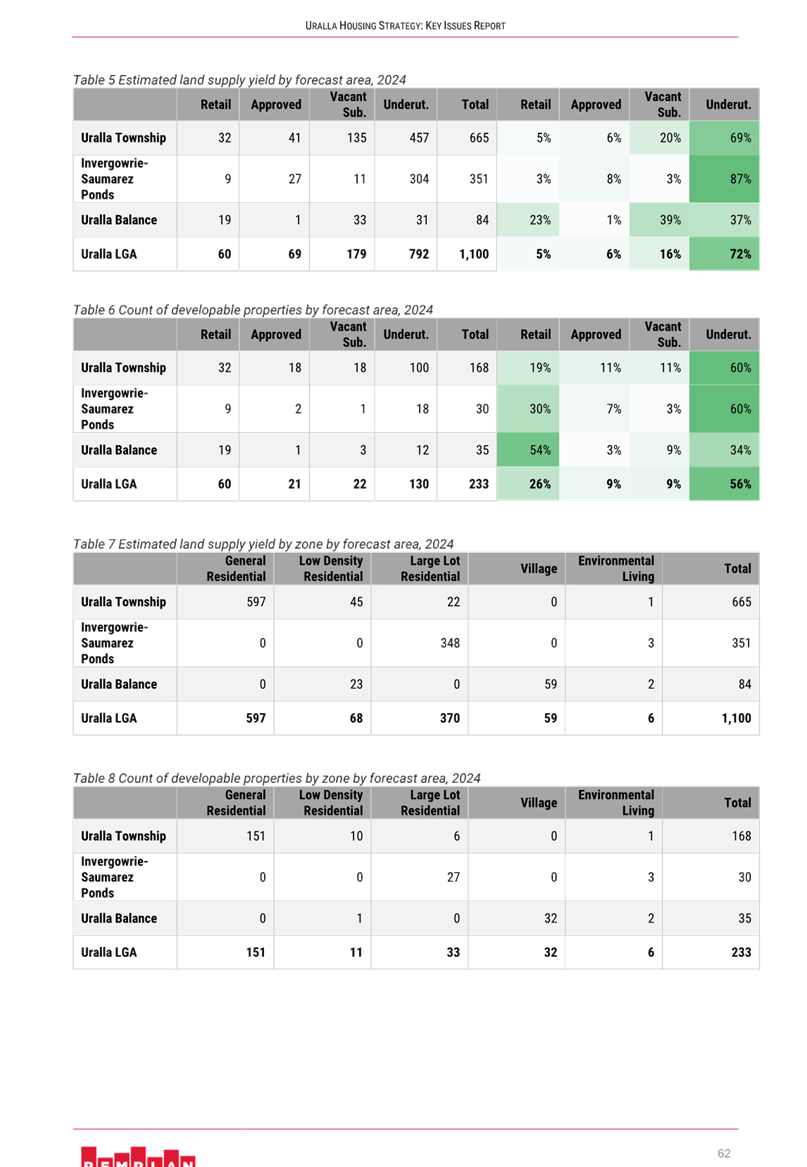
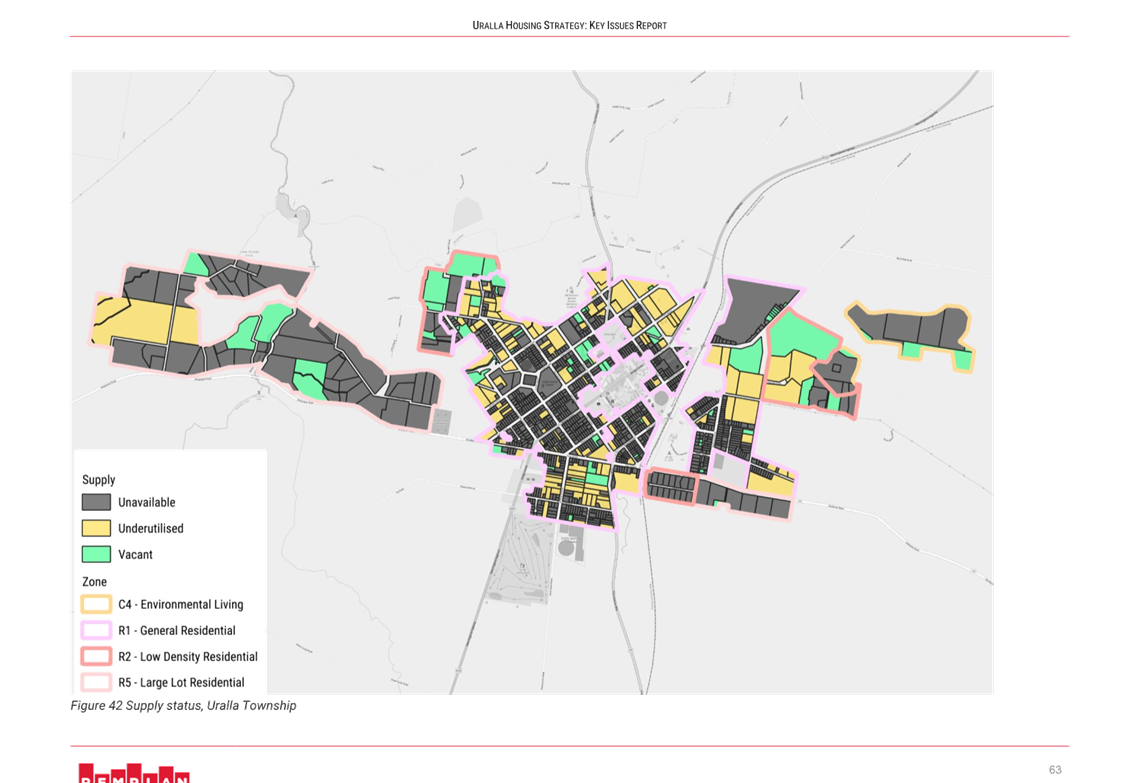
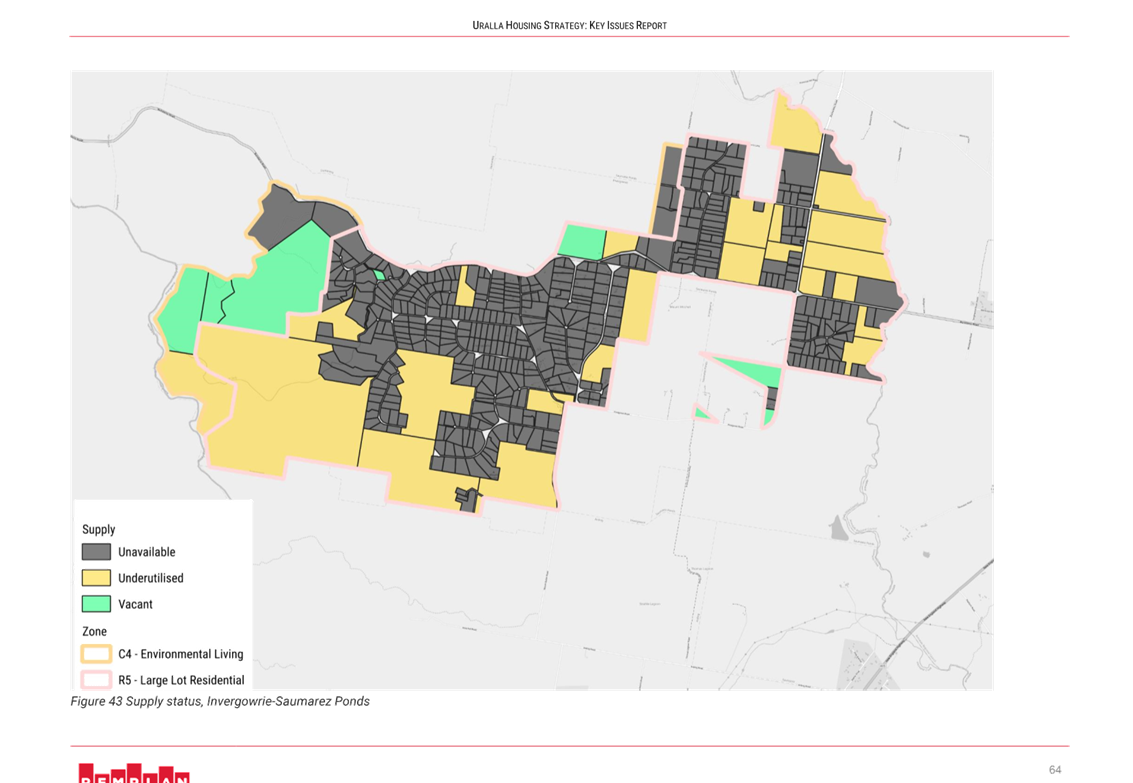
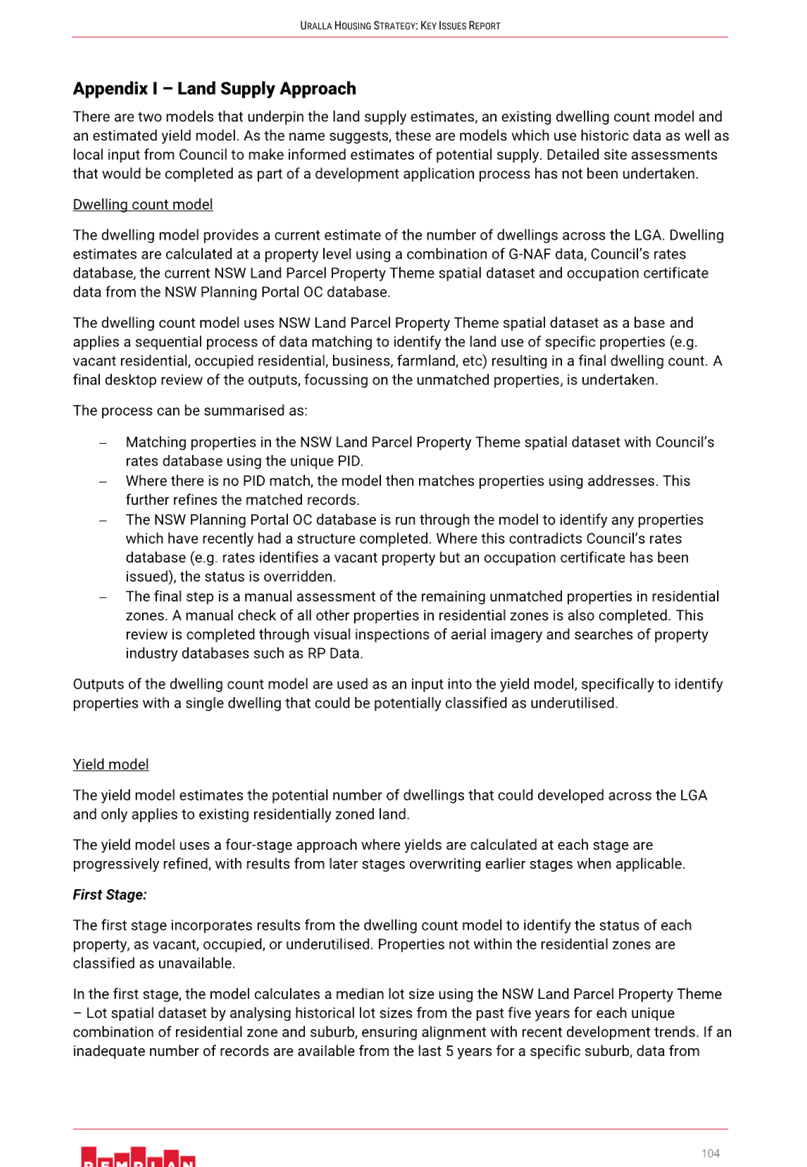
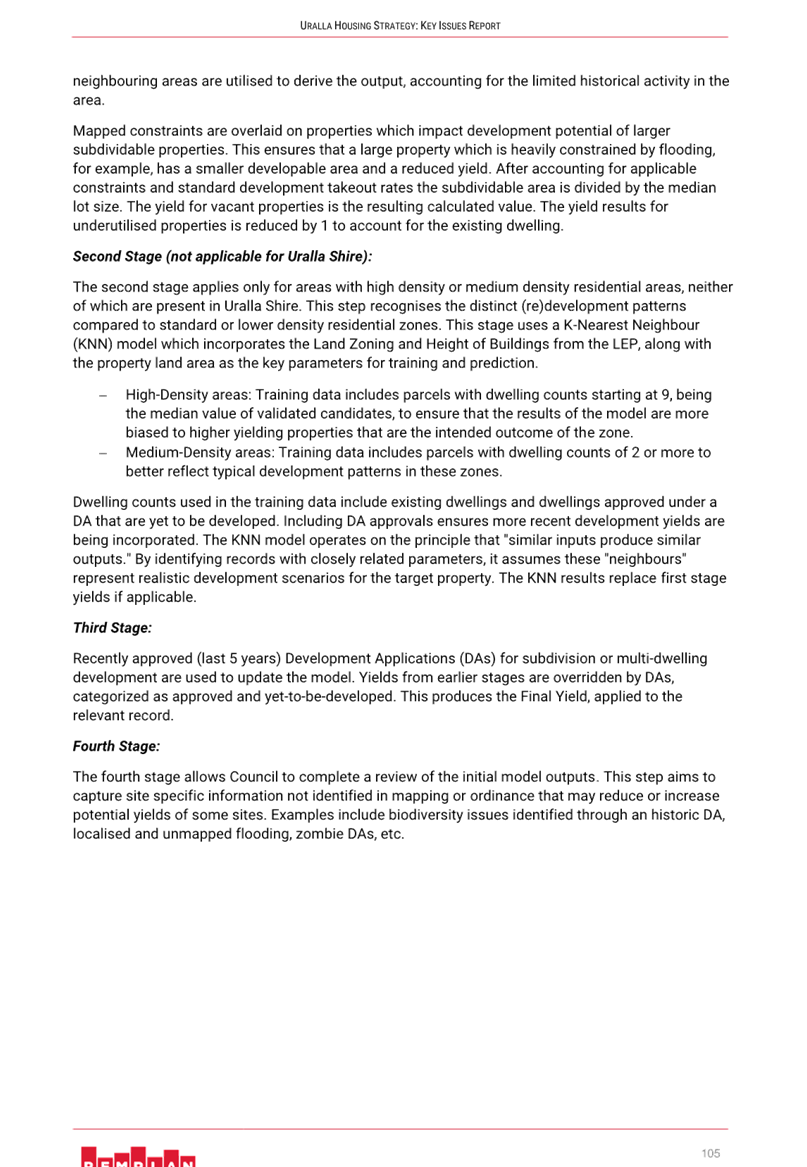
|
Ordinary Council
Meeting Business Agenda
|
25 February 2025
|
14.6 Community
Engagement Strategy - Response to submissions
|
Department:
|
Infrastructure &
Development
|
|
Prepared By:
|
Planning Officer Strategic
|
|
Authorised By:
|
Manager Governance and Service Centre
|
|
Reference:
|
UINT/25/2399
|
|
Attachments:
|
1. DRAFT
Community Engagement Strategy & CPP 2024 ⇩ 
2. DRAFT
Community Engagement Strategy & CPP -Track Changes 2024 ⇩ 
|
|
LINKAGE TO INTEGRATED PLANNING AND REPORTING FRAMEWORK
|
|
Goal:
|
4. We
are an independent shire and well-governed community
|
|
Strategy:
|
4.2. A
strategic, accountable and representative Council
4.1. Informed
and collaborative leadership in our community
|
Summary
At its ordinary meeting of 17 December 2024, Council
resolved to place the updated Community Engagement Strategy (CES) and Community
Participation Plan (CPP) on public exhibition for 36 days. One submission was
received.
In response to the submission, the CES has been amended to:
- Give
greater attention to the ‘inform’ level of public
participation.
- Make
explicit reference to s. 355 committees and how they fit into community
engagement.
- Include
‘rural and remote residents’ in hard-to-reach groups.
- Other
minor changes that reflect engagement strategies already employed by Council
e.g. participation in non-council event, notices at General Stores.
|
Recommendation
That
Council:
1. Notes submissions received in response to consultation;
and,
2. Adopts
the revised Community Engagement Strategy.
|
Report
Notification of the public
exhibition period was given via Council’s website and social media.
|
Theme
|
Submission comments
|
Officer comments
|
|
S. 355 committees
|
- Existing s. 355 committee mechanism not duly considered
Recommends:
- Update engagement matrix to include s .355 committees
- Include example of existing Bundarra School of Arts Hall
and Community Consultative Committee 2022 in s. 5.1 ‘How We
Engage’
- Reference as possible method for ‘empower’
level of engagement
|
Supported.
Community Advisory committees constituted under s. 355 of the Act can
be delegated decision-making powers. It is appropriate that they are
referenced at the ‘empower’ level.
It is not considered necessary to refer to Bundarra specifically, as
but to reference s. 355 committees generally, as any given existing
committees may not be renewed, or not renewed under the same terms of
reference.
|
|
Provision of
information about Council activities
|
- ‘Inform’
level of public participation not given enough attention in CES
“The key
purpose of informing the community needs to be added, i.e. in addition to
‘connecting with’ and ‘seeking feedback’. Being
informed is a pre-requisite to having informed ‘feedback’ and
‘opinions’ on plans, projects and policies.”
Recommends:
- Add a strategic
objective related to informing the community about Council activities.
- Augment
sections 2.2, 3.2 & 5 to reflect value of “inform” level
|
Supported.
All relevant sections
of CES updated to include ‘informing’ as a fundamental community
engagement activity.
Amended to include
Strategic Objective:
1) Ensure Council provides timely,
relevant, transparent, meaningful, and accessible information about its
activities, achievements, and outcomes, including the outcomes of community
engagement activities and decision-making processes.
Noting that many of the
issues raised by the submission regarding adequacy of existing
‘informing’ activities e.g. Newsletter is being addressed by
Chris Clark’s communications project.
|
|
Stakeholders
|
Recommends:
- Include ‘visitors’ as stakeholder group
- Include of ‘villages, localities and rural
residents’ and visitors in Hard-to-Reach Groups
|
Supported.
Visitors are a distinct stakeholder group to be considered in the CES
e.g. Council operates a Visitor Information Centre. However, it is considered
that visitors are not a hard-to-reach group as they will actively seek
information.
Hard-to-reach Groups has been amended to include ‘Residents of
rural and remote localities’.
|
|
Communication and
Engagement methods
|
Recommends CES
additional methods:
- Councillors and Council
Meetings
- Council supported (not
facilitated) events, e.g. Council’s in-kind contributions,
partnerships, etc. for Show Societies’ and Service Clubs’ events
- Council involvement with
events organised by other parties e.g., information stall or listening posts
at Seasons of New England
- Adding ‘and
general stores’ to ‘the supermarket’ for Community
Noticeboards
|
Supported.
|
|
Document presentation
|
Commends structure and readability
Suggests minor change to front cover photograph
|
Noted.
Supported.
|
Conclusion
As amended, the CES now places greater emphasis on the
‘inform level’ of community engagement, and more adequately
reflects Council’s existing methods of engagement and the community it
seeks to support.
Council Implications
Community
Engagement/Communication
Nil
Policy
and Regulation
Nil
Financial/Long
Term Financial Plan
Nil
Asset
Management/Asset Management Strategy
Nil
Workforce/Workforce
Management Strategy
Nil
Legal
and Risk Management
Nil
Performance
Measures
Nil
Project
Management
Strategic Planning Officer
|
Ordinary Council Meeting Business Agenda
|
25 February 2025
|
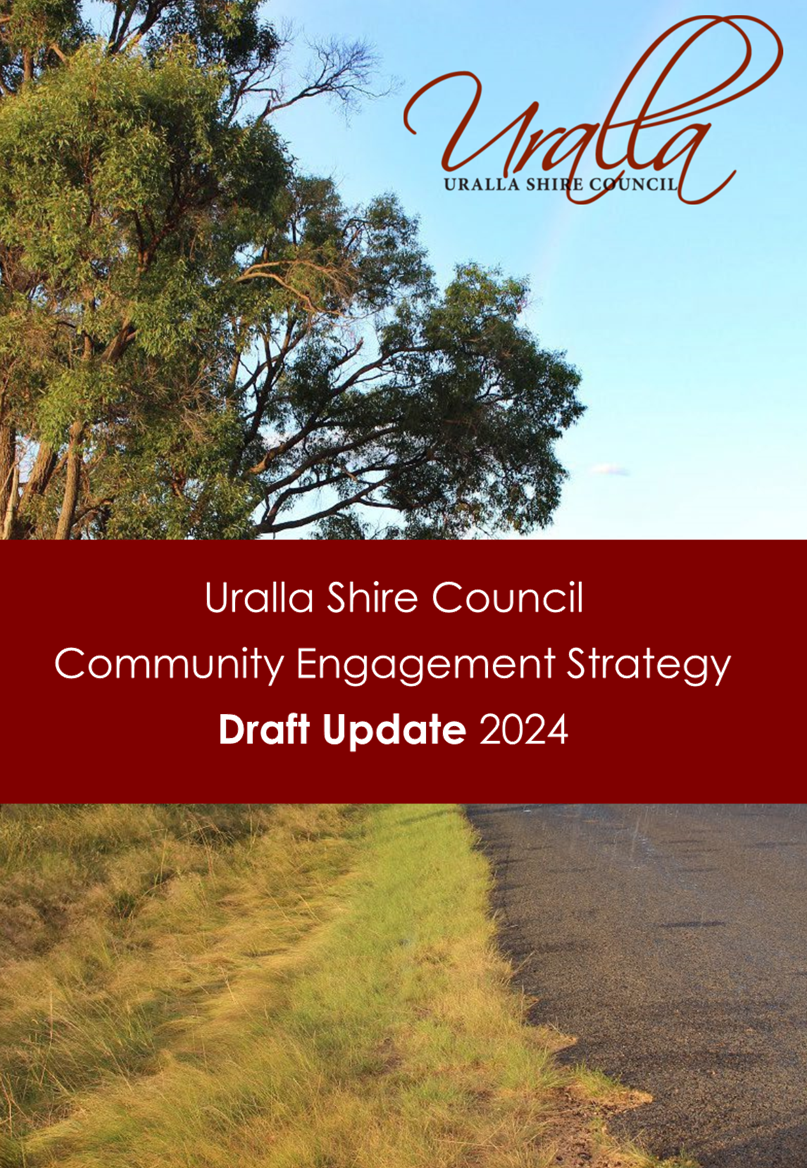
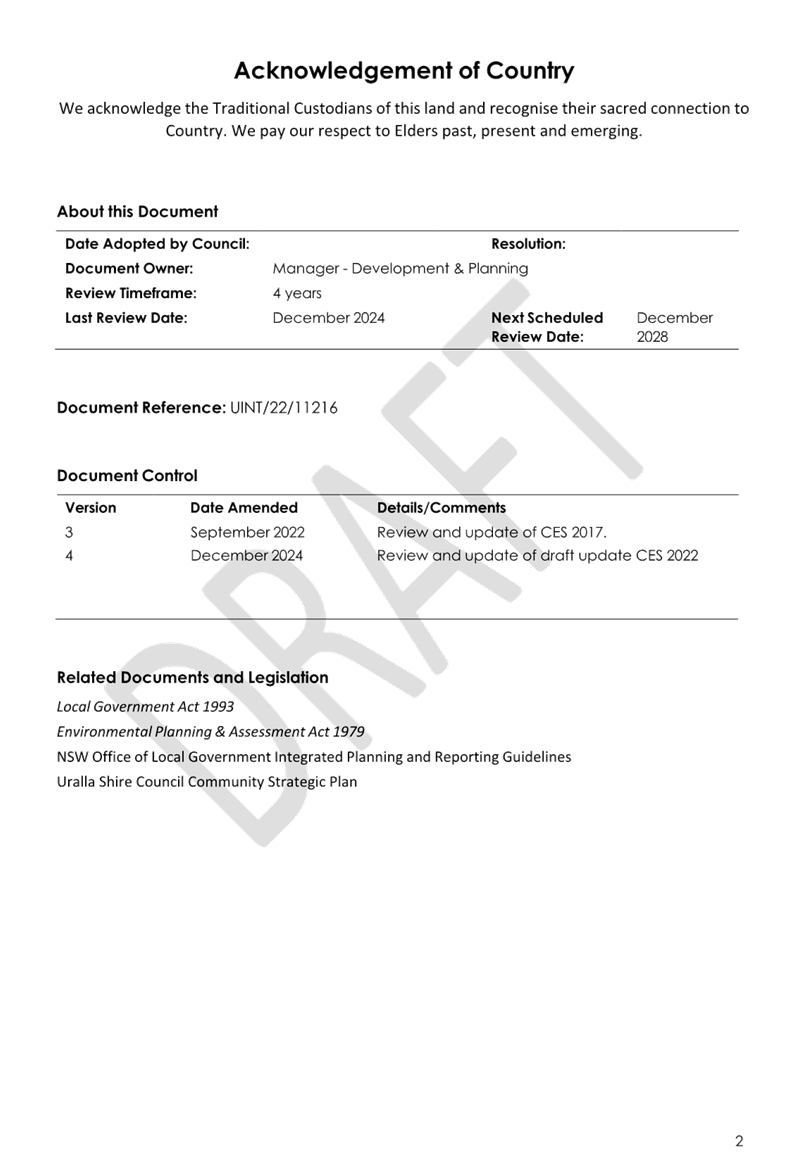
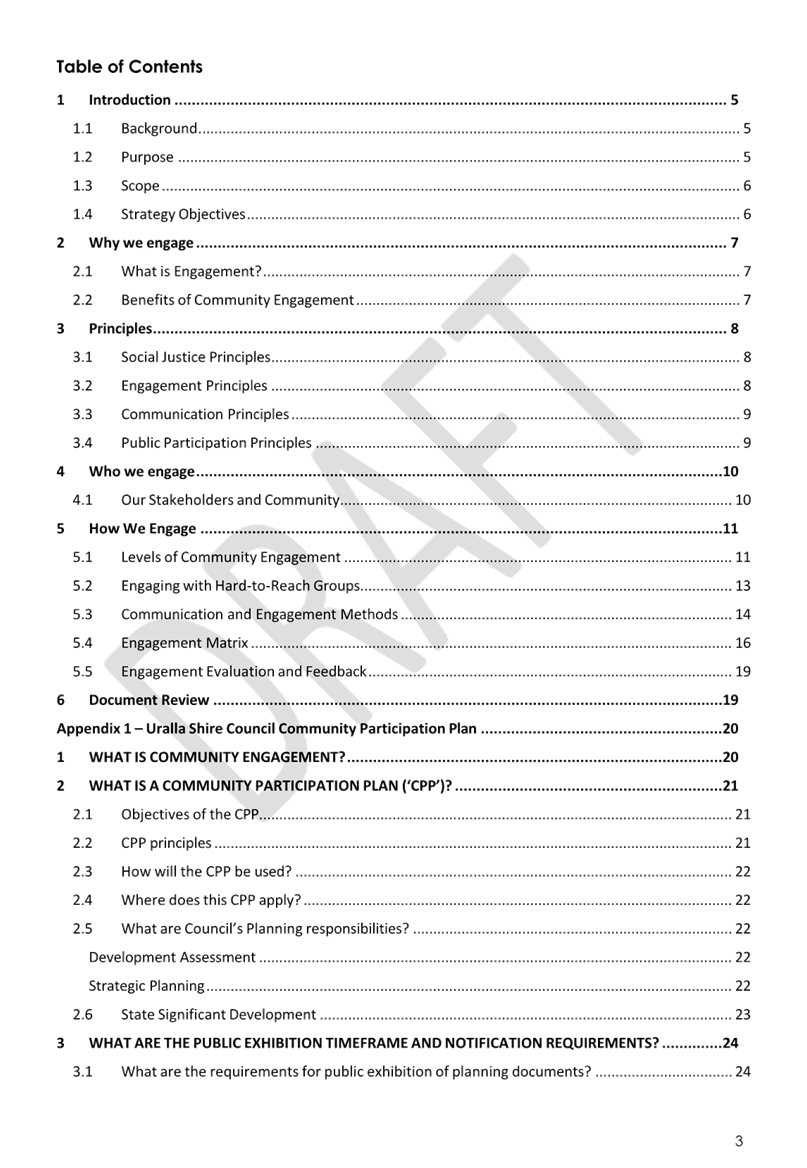
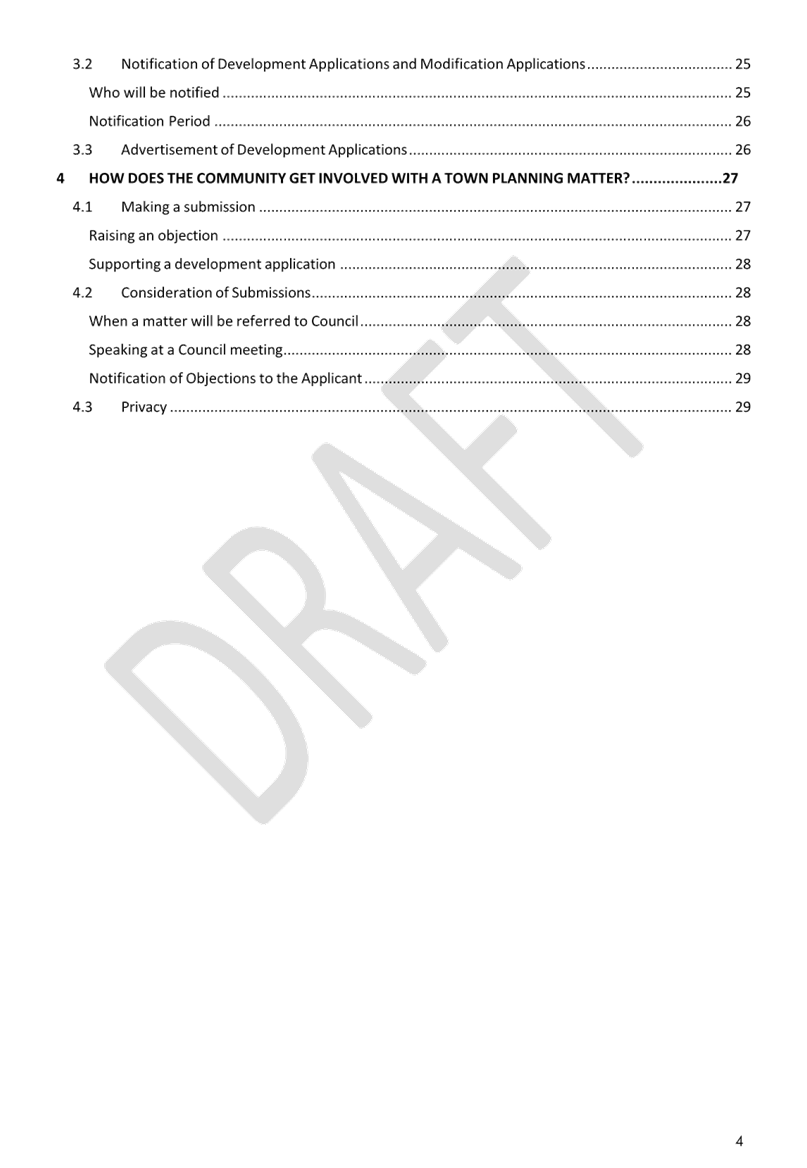
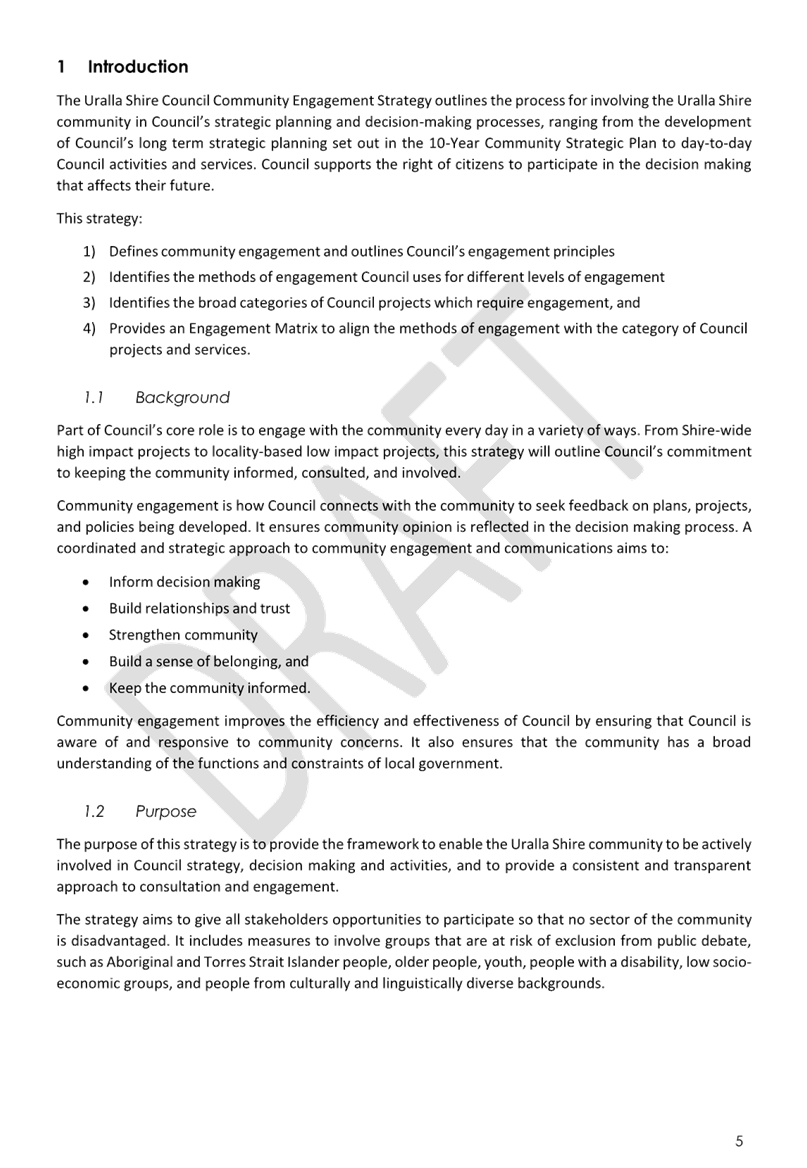
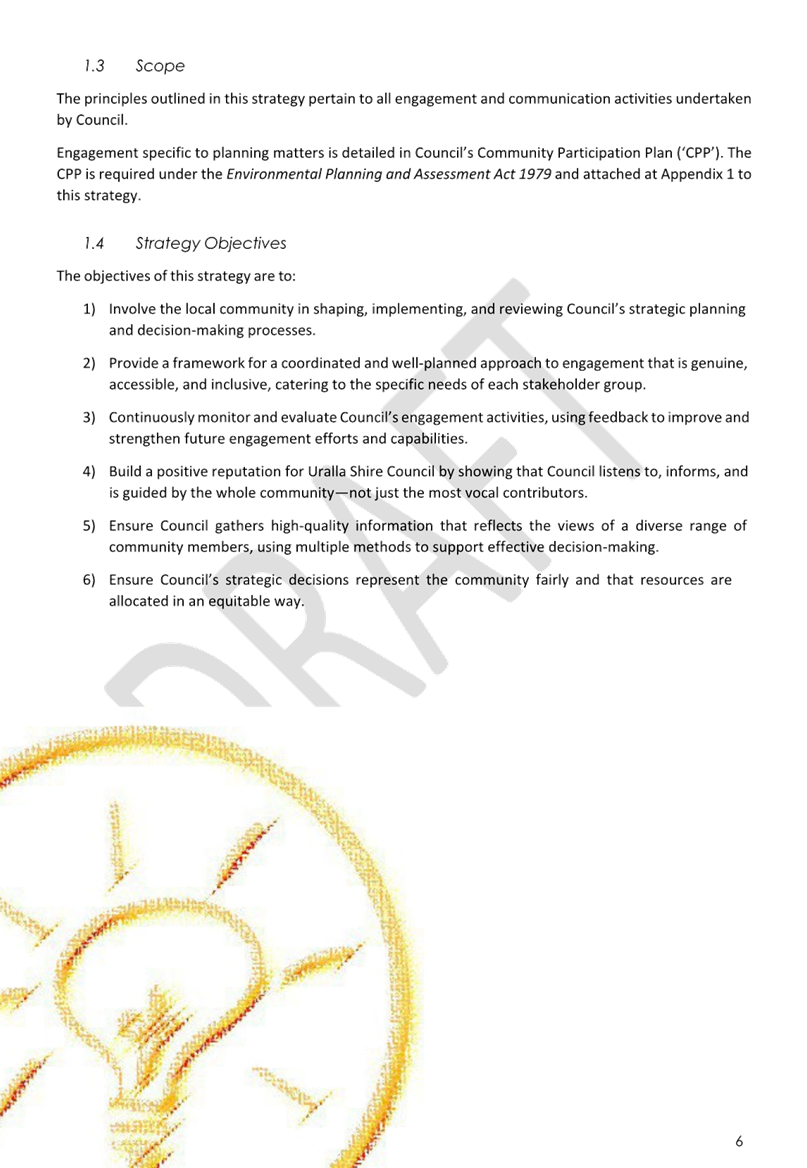
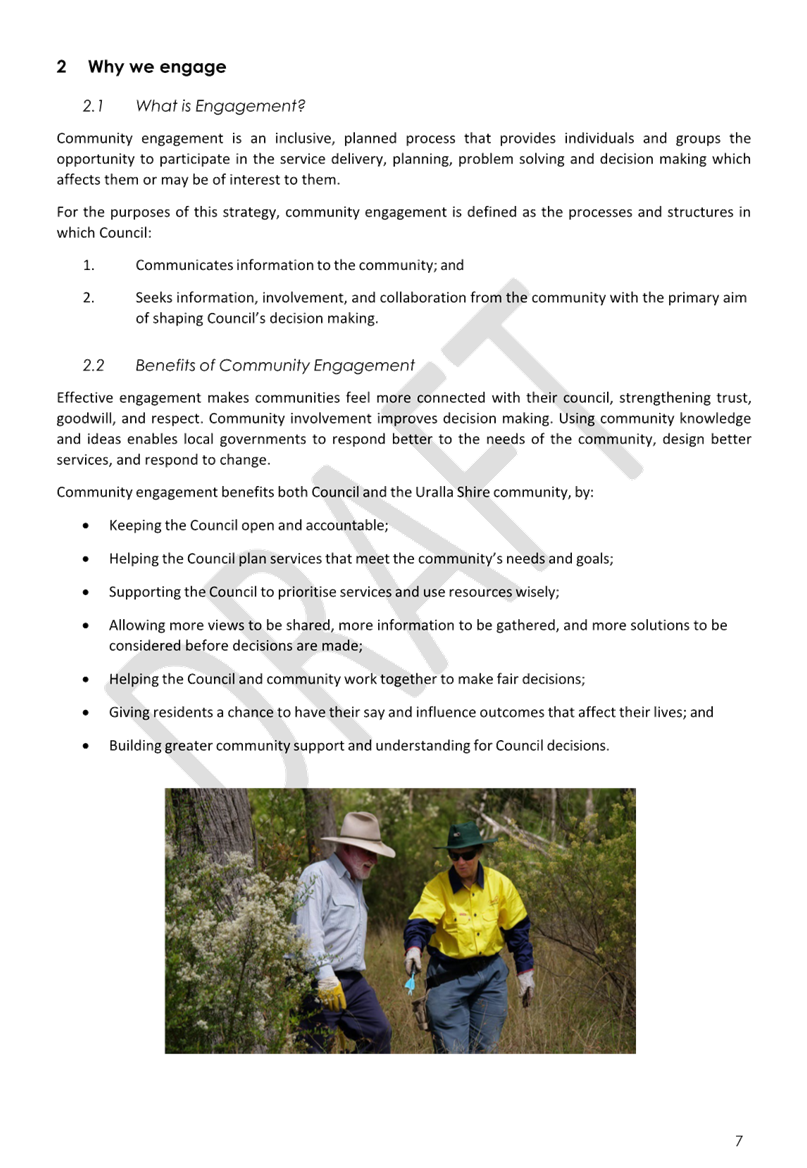
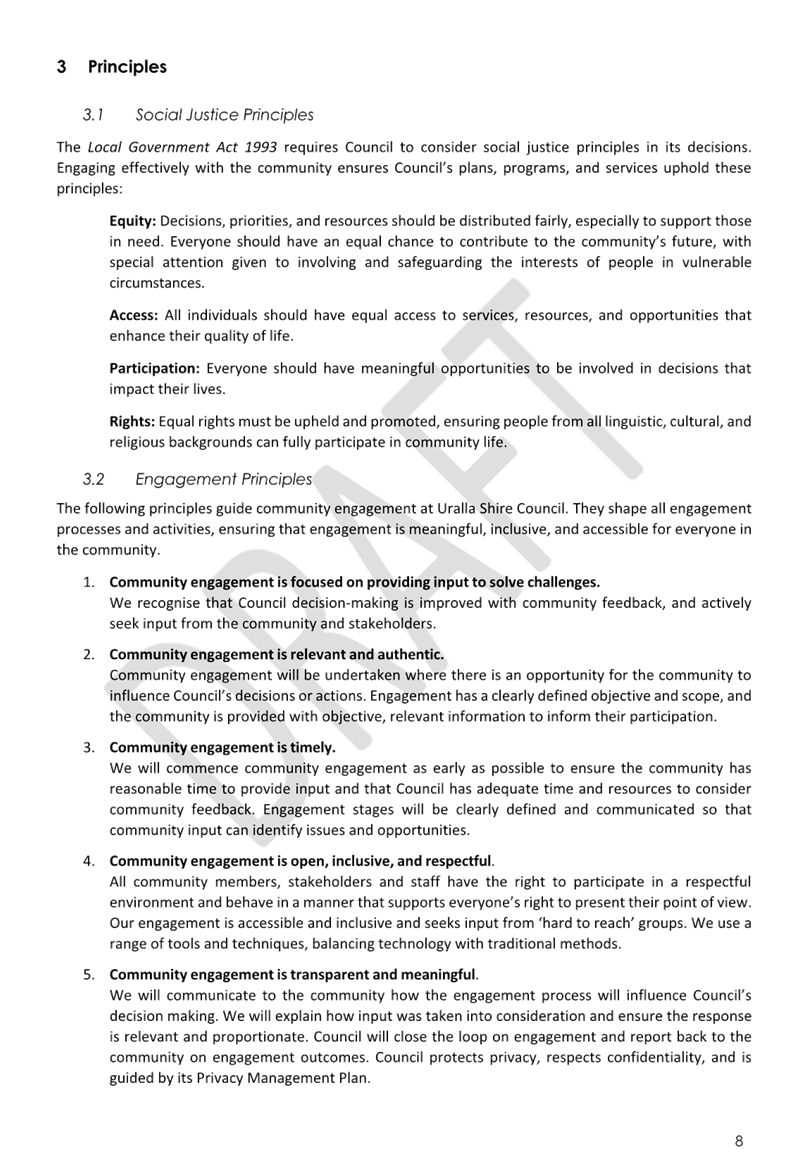
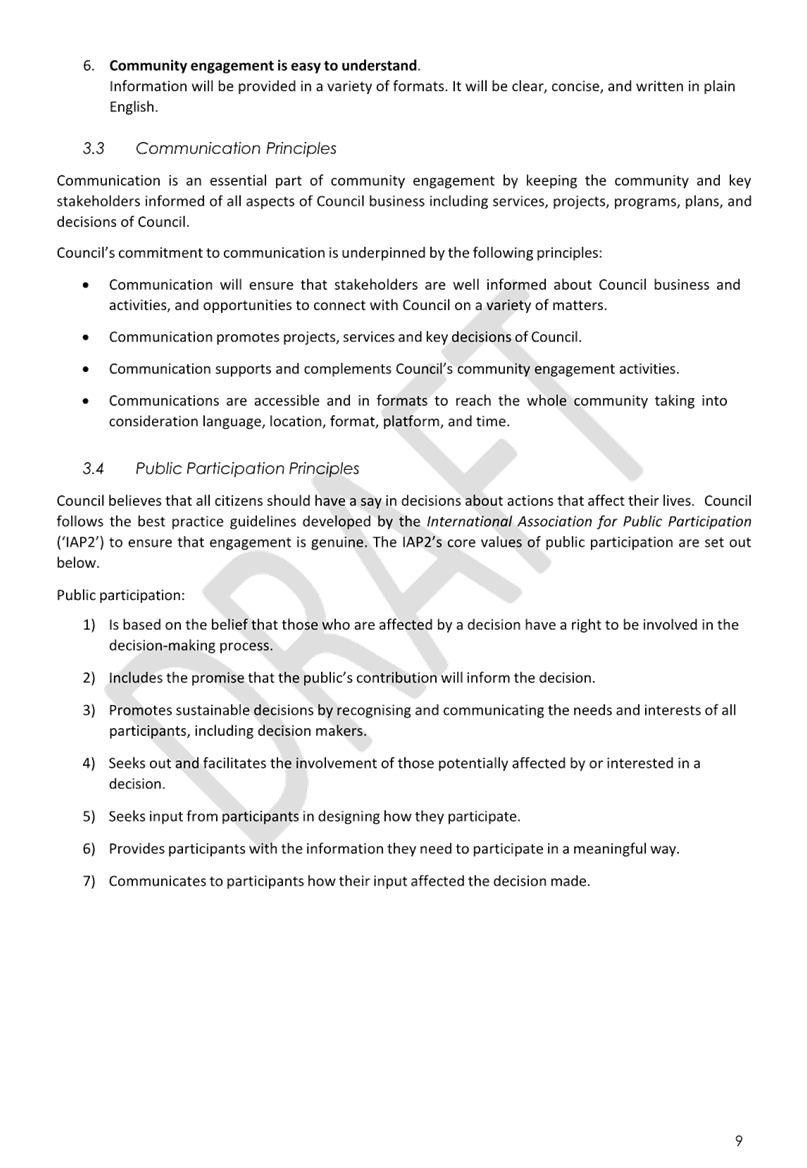
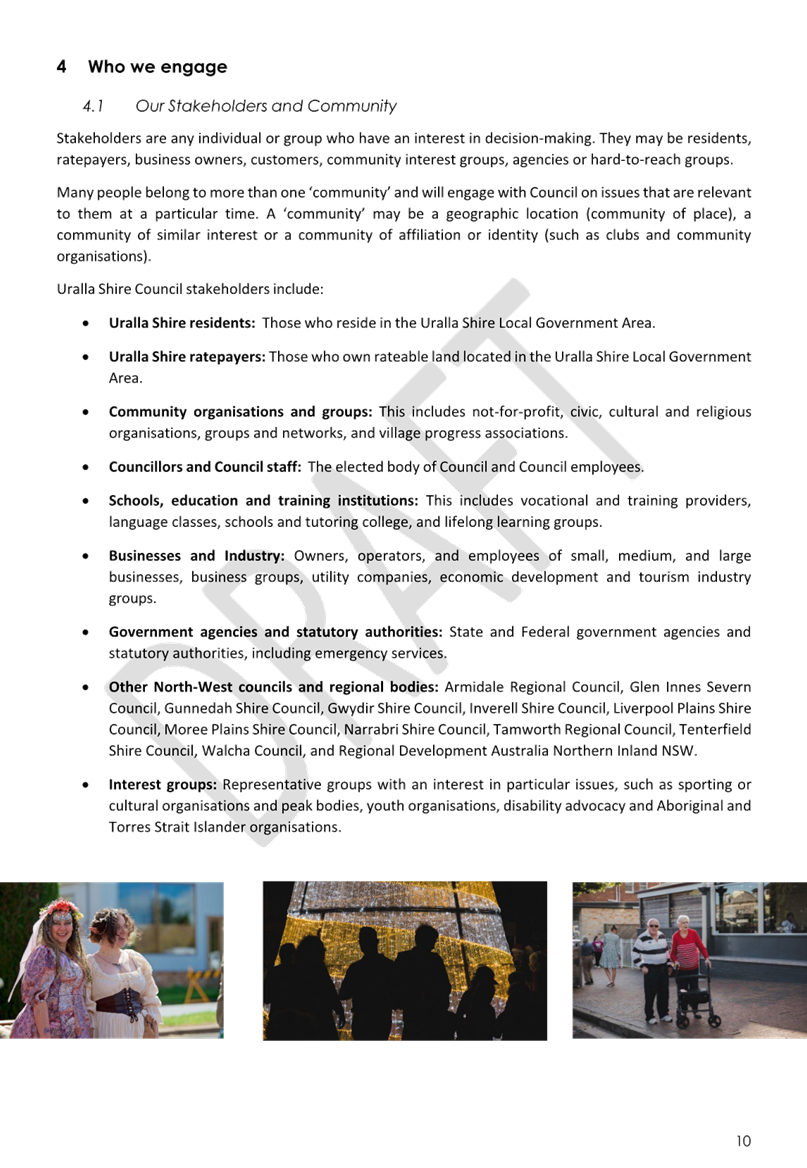
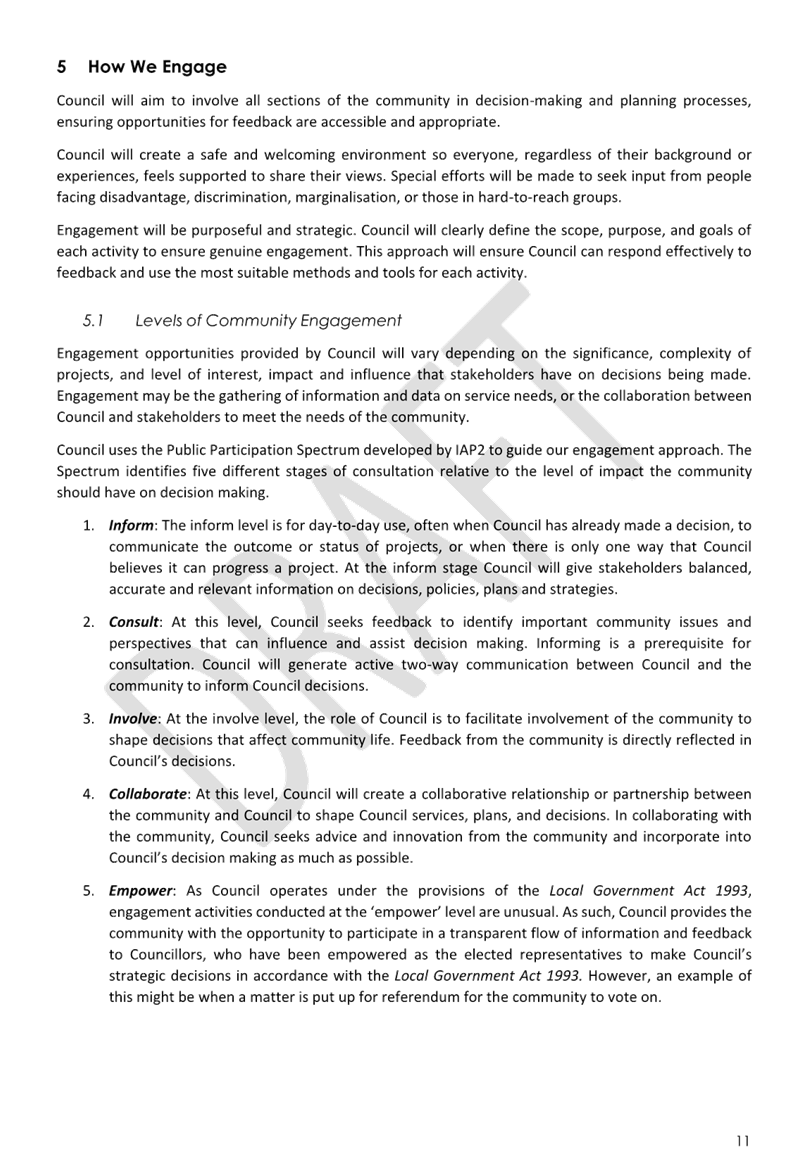
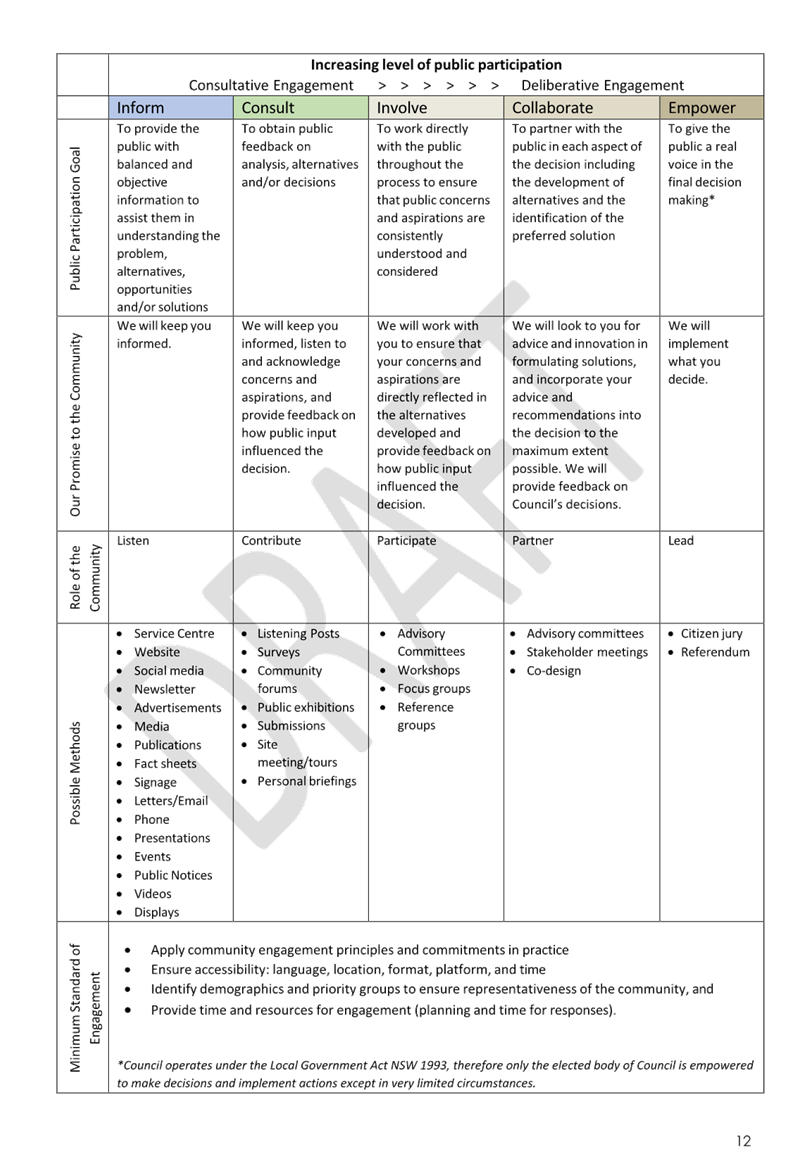
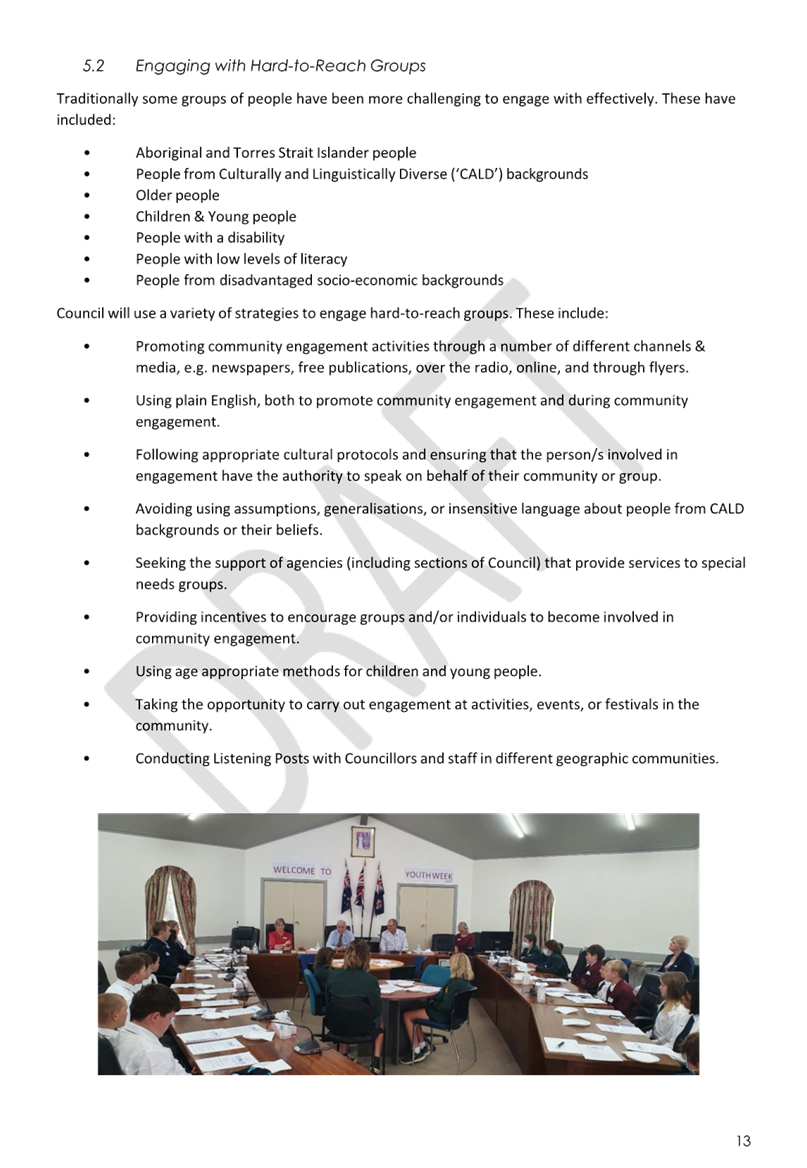
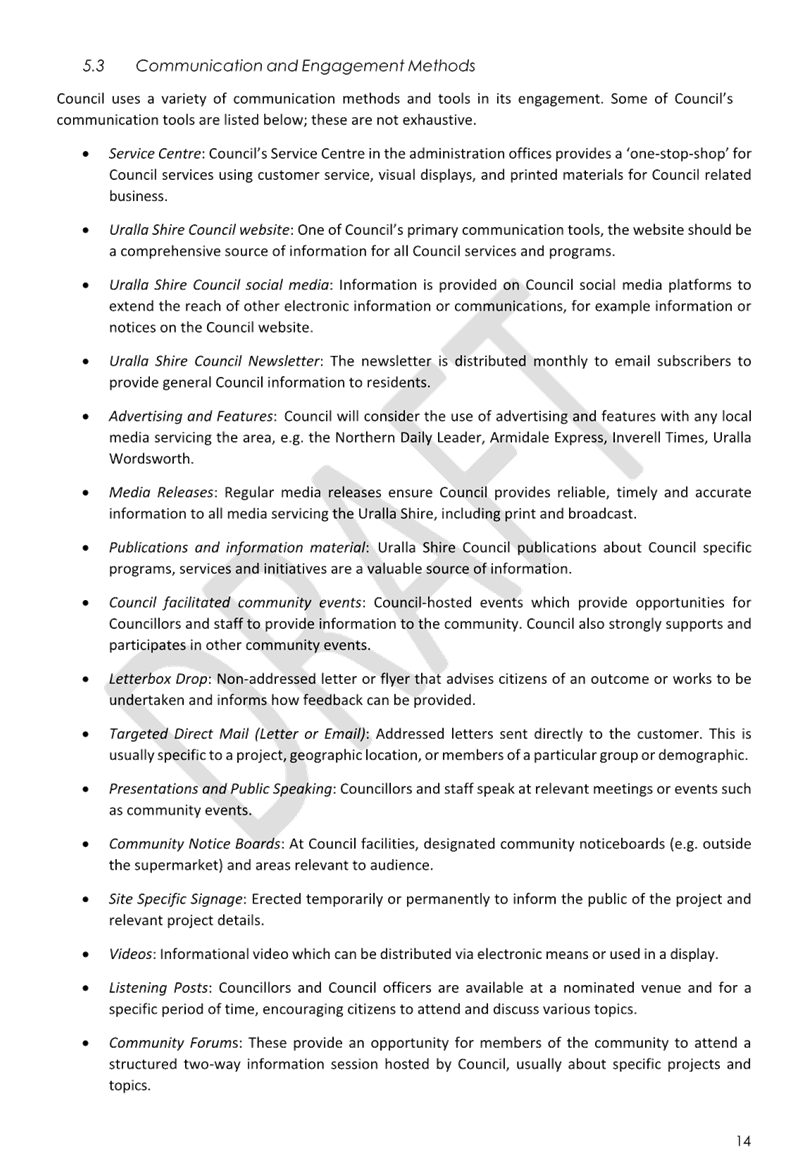

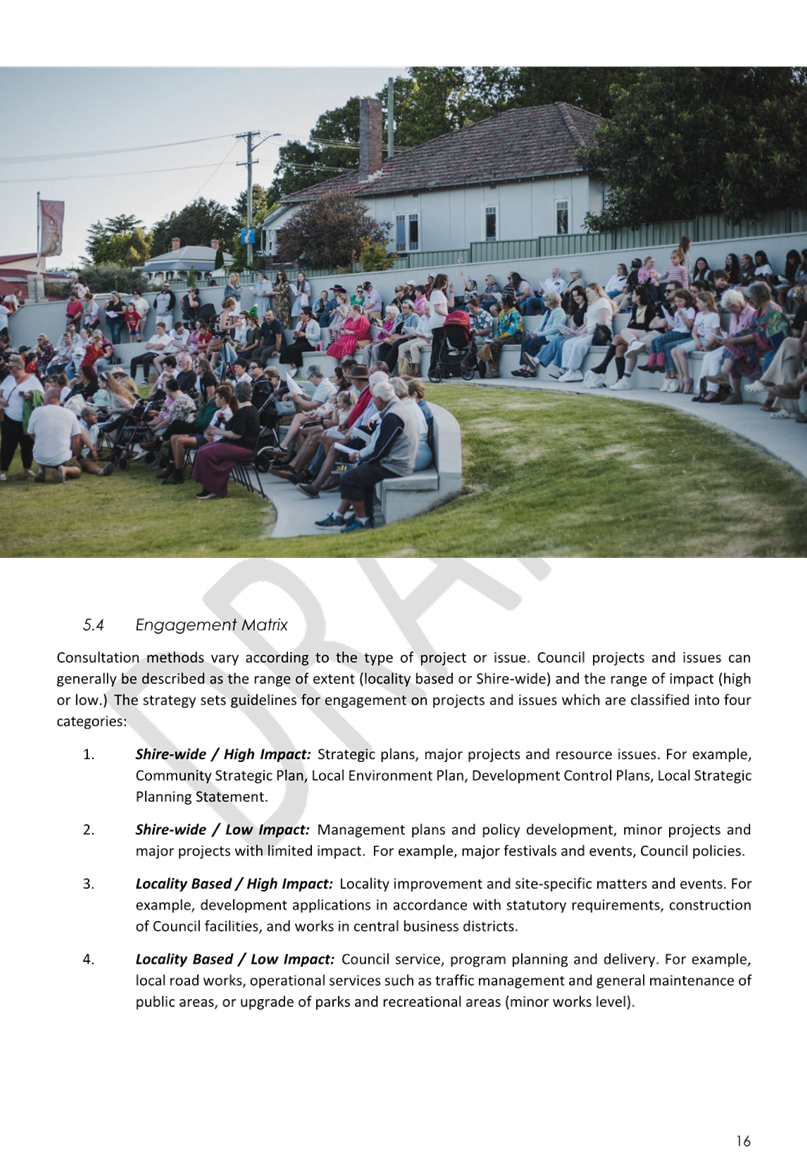
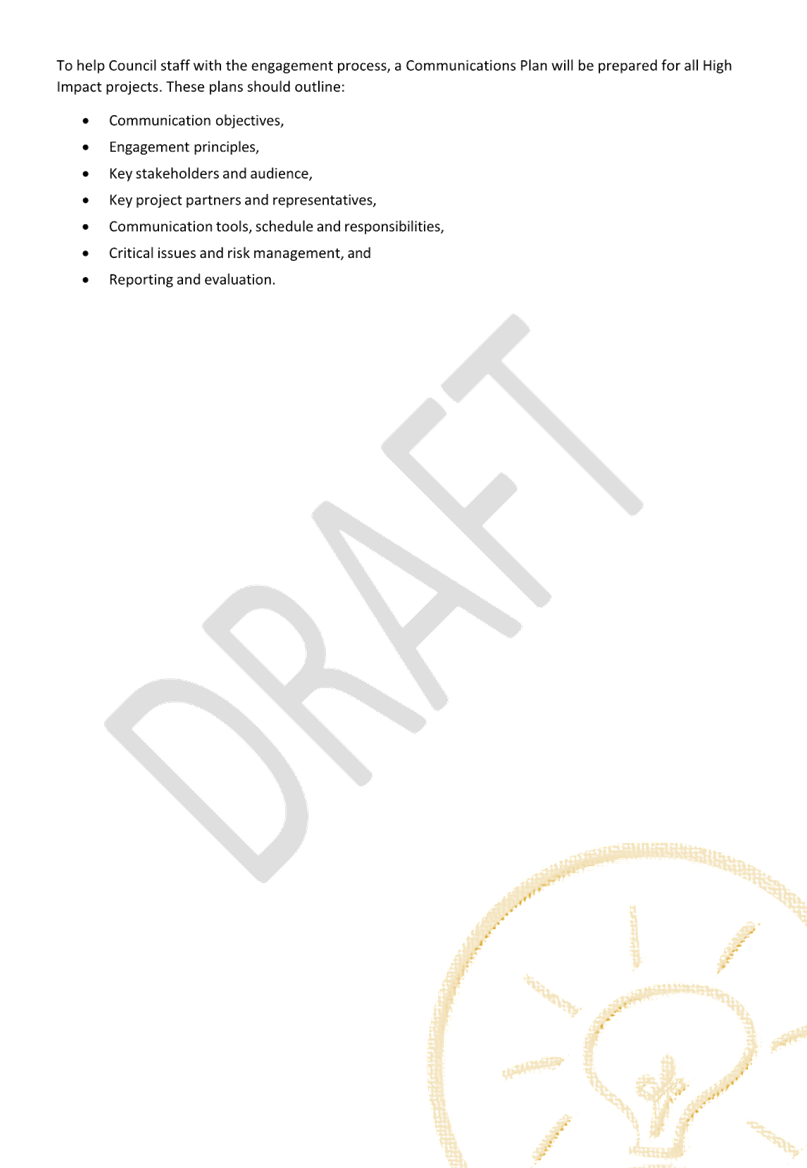
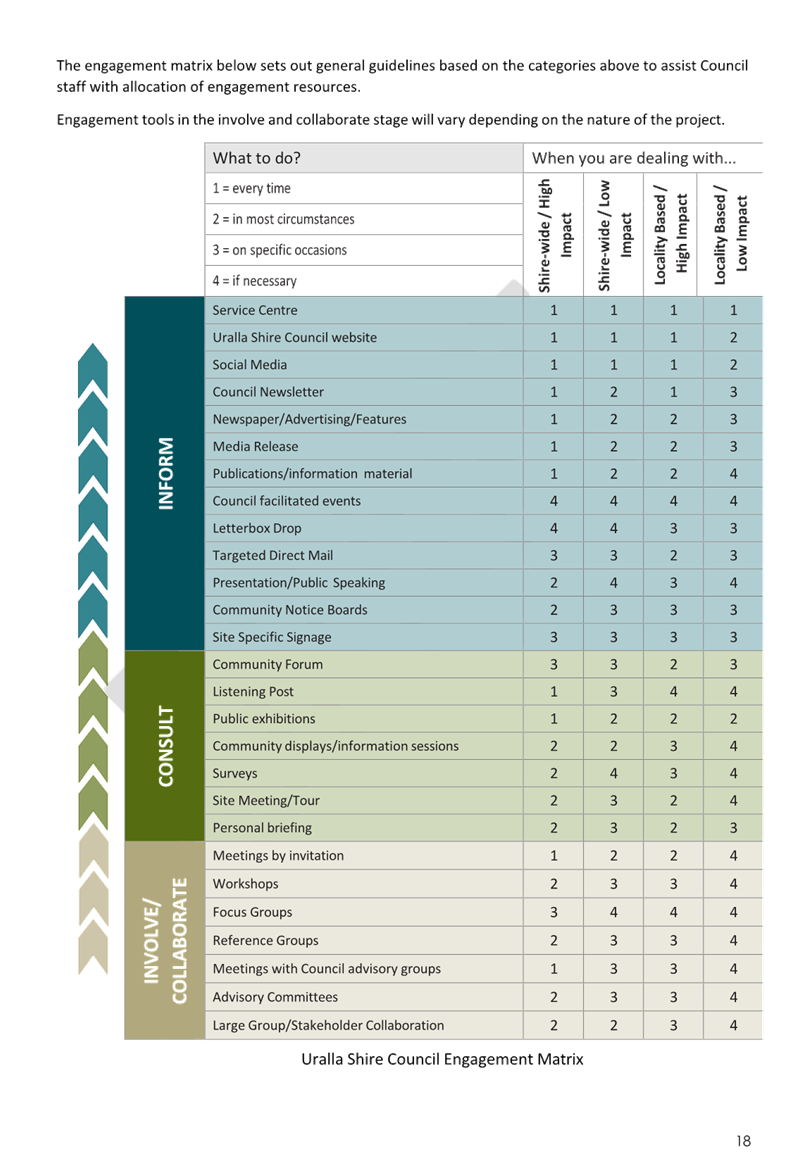
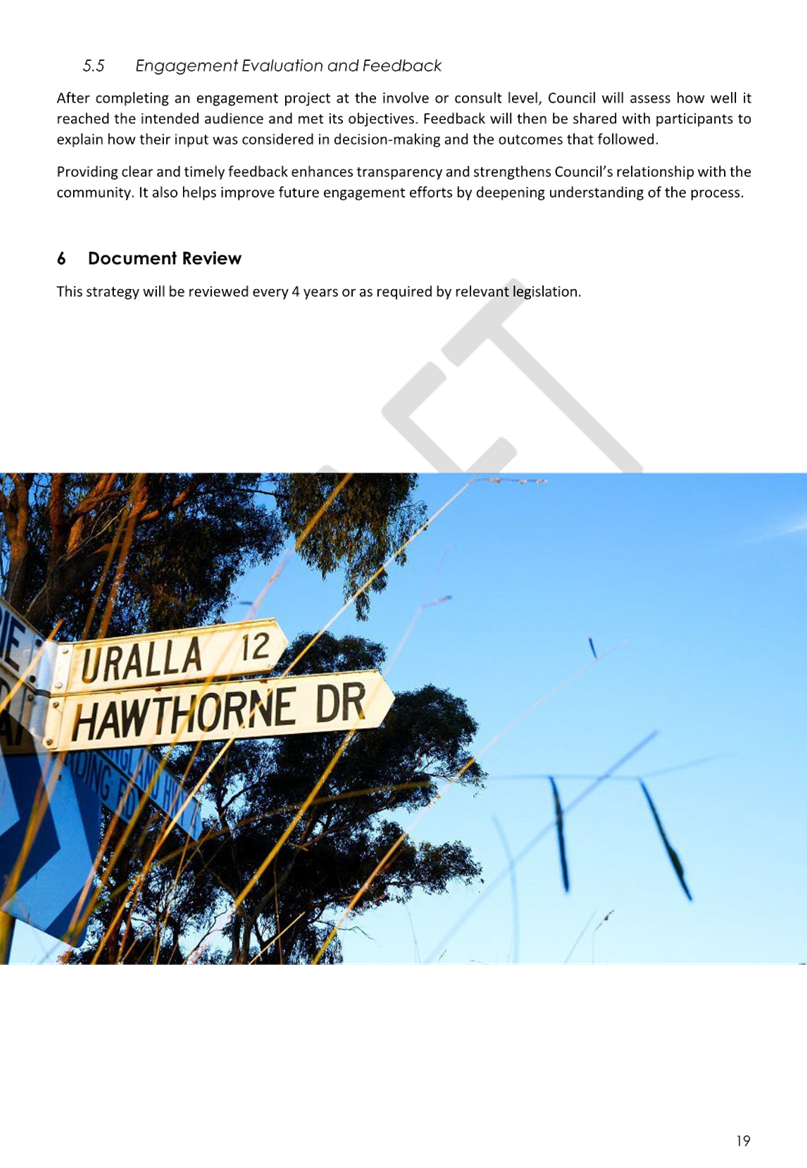
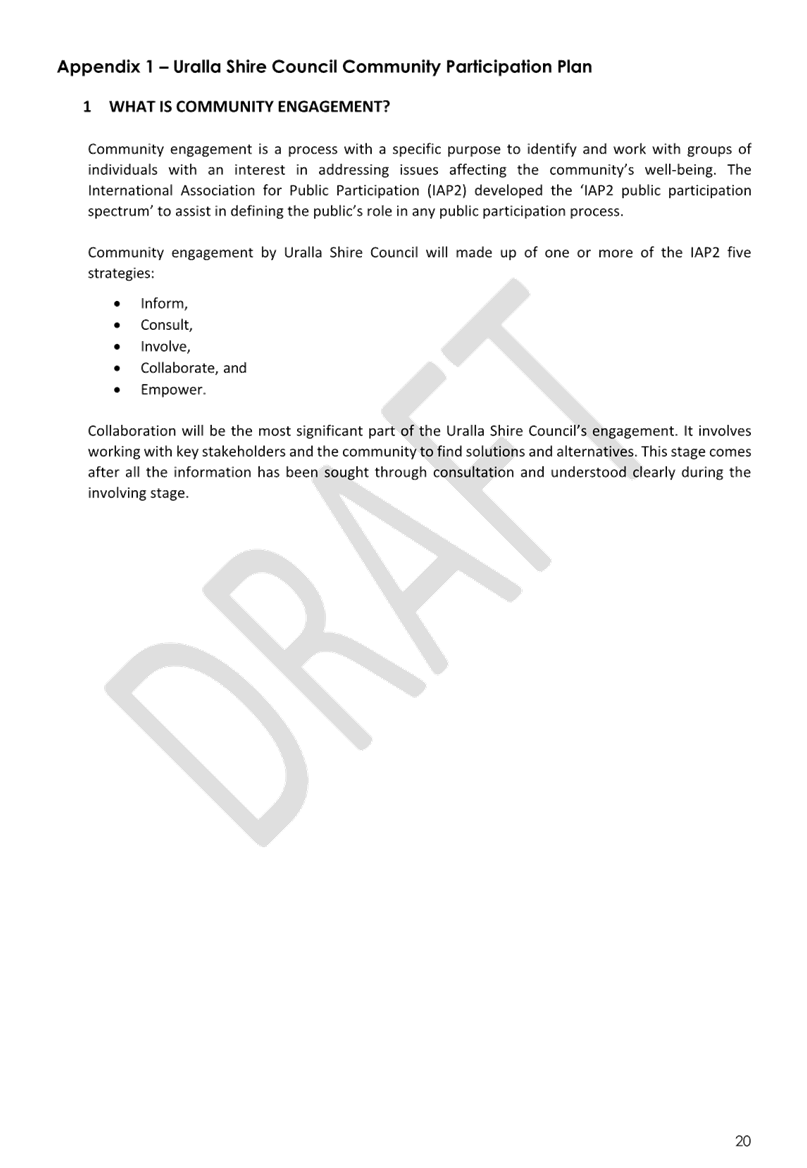
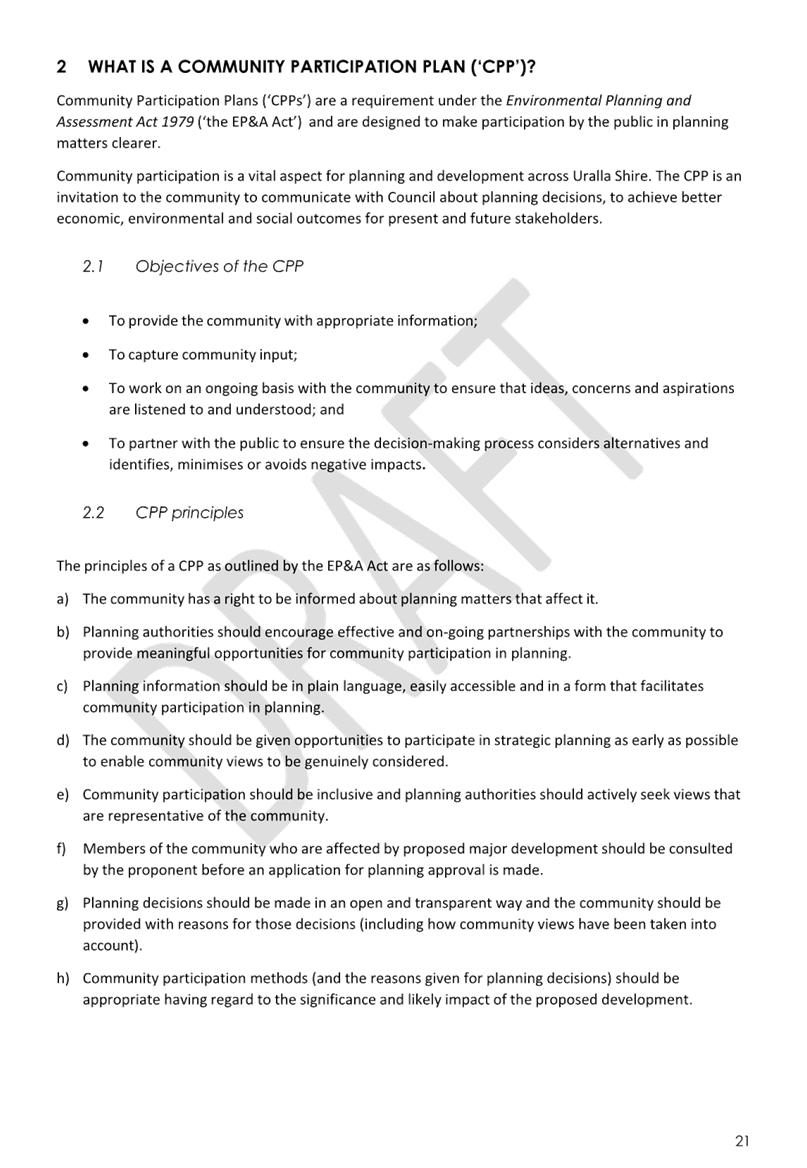
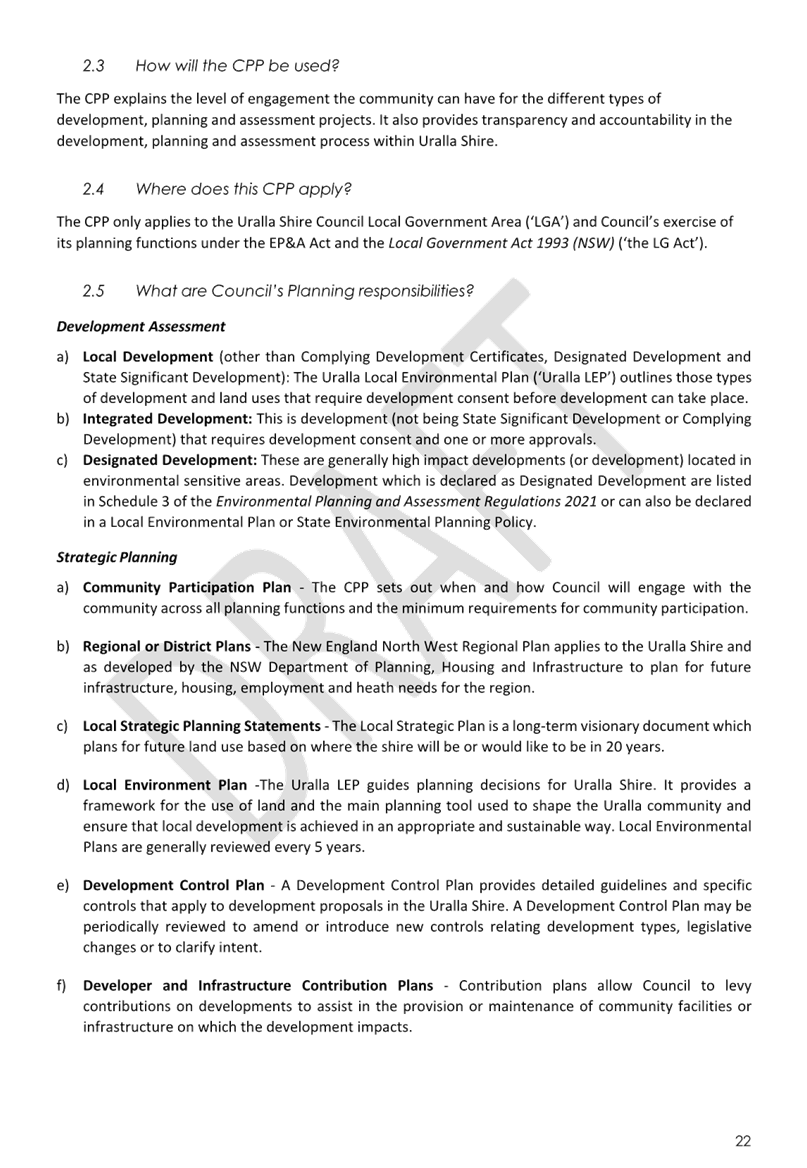
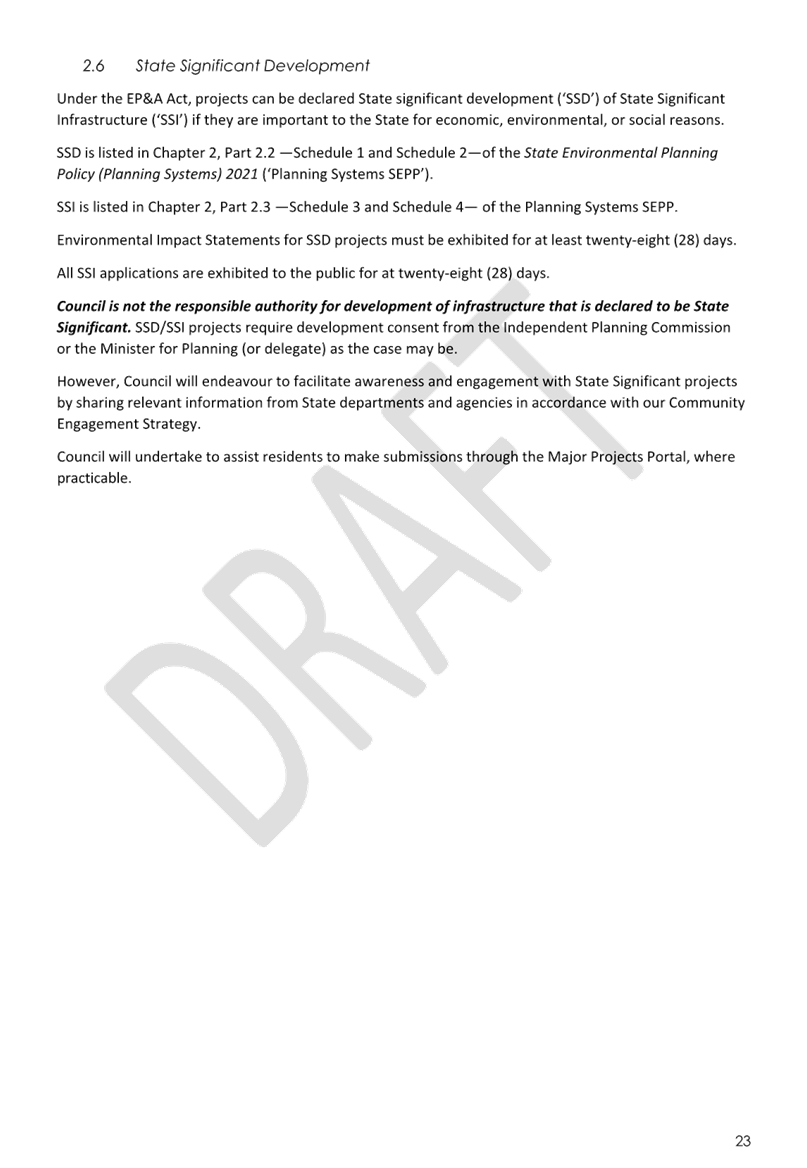

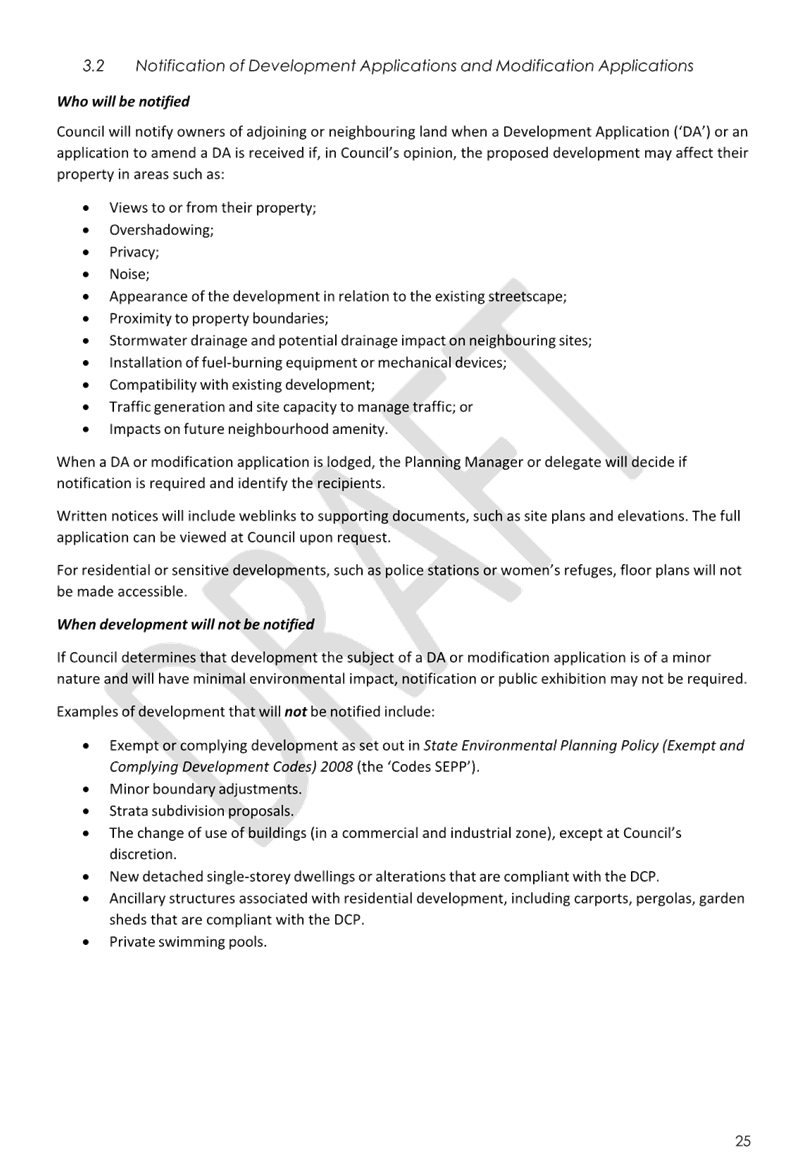
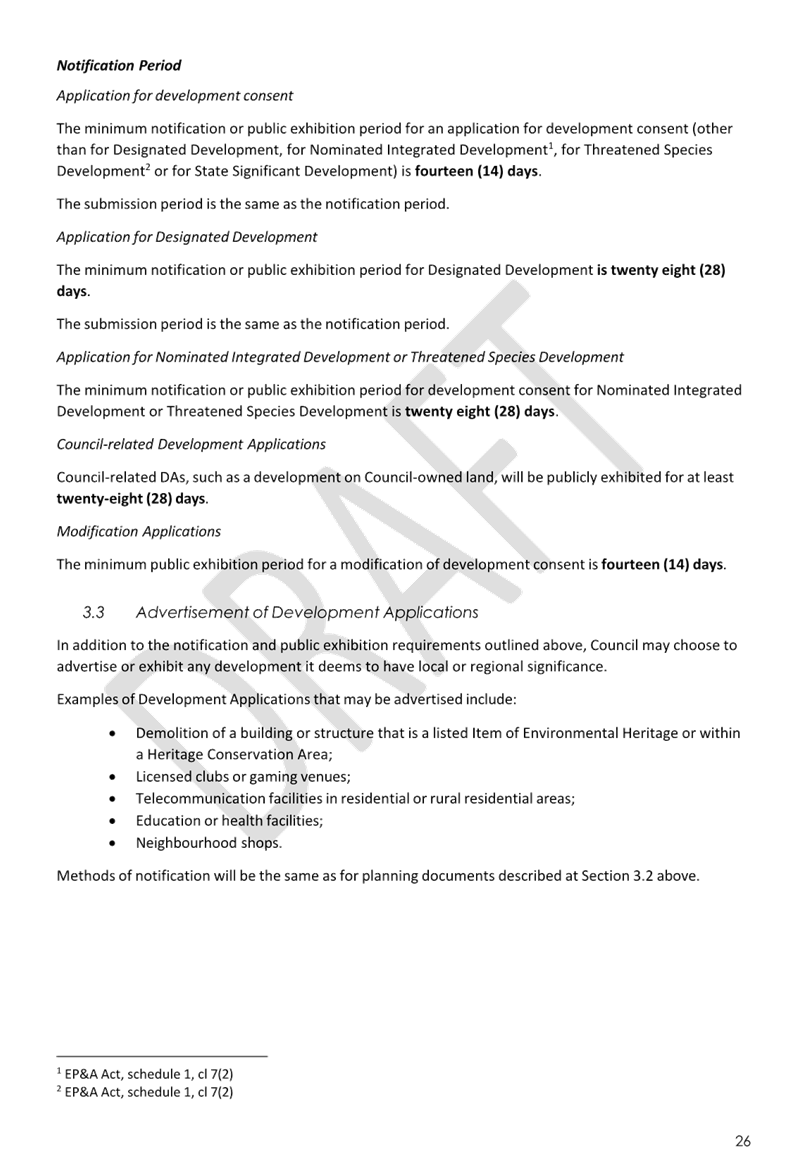
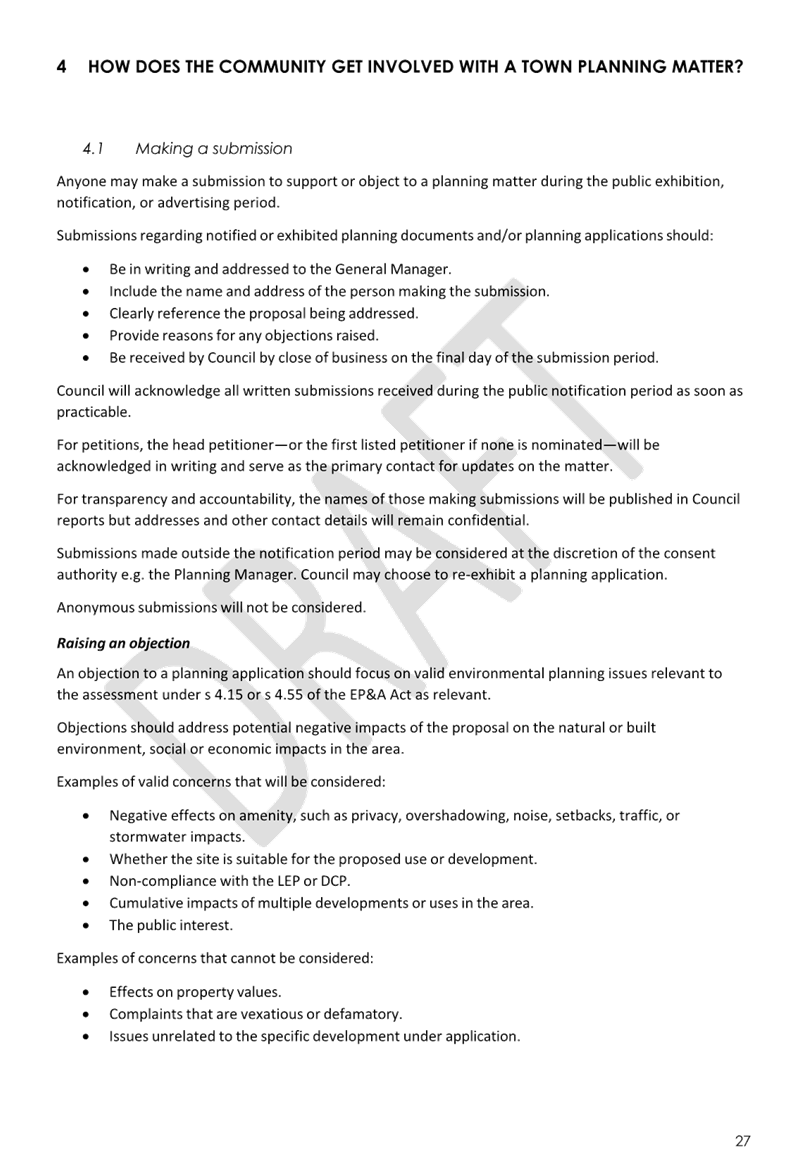
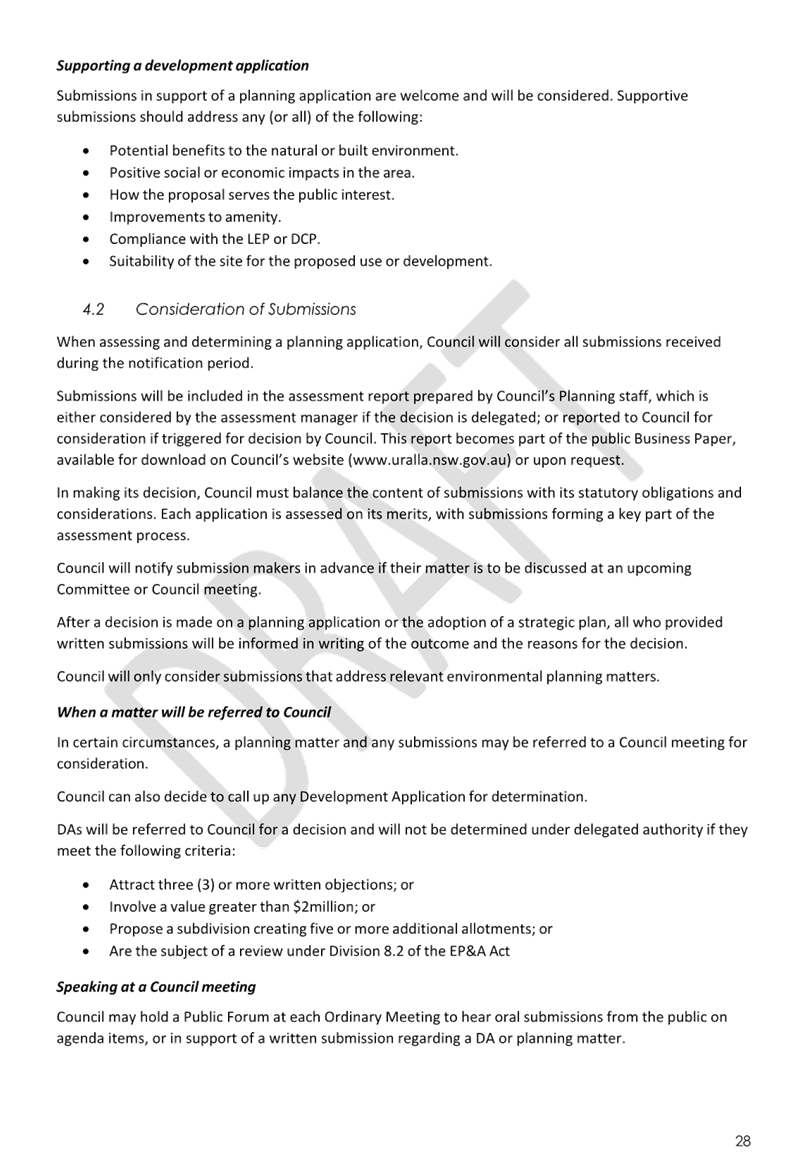
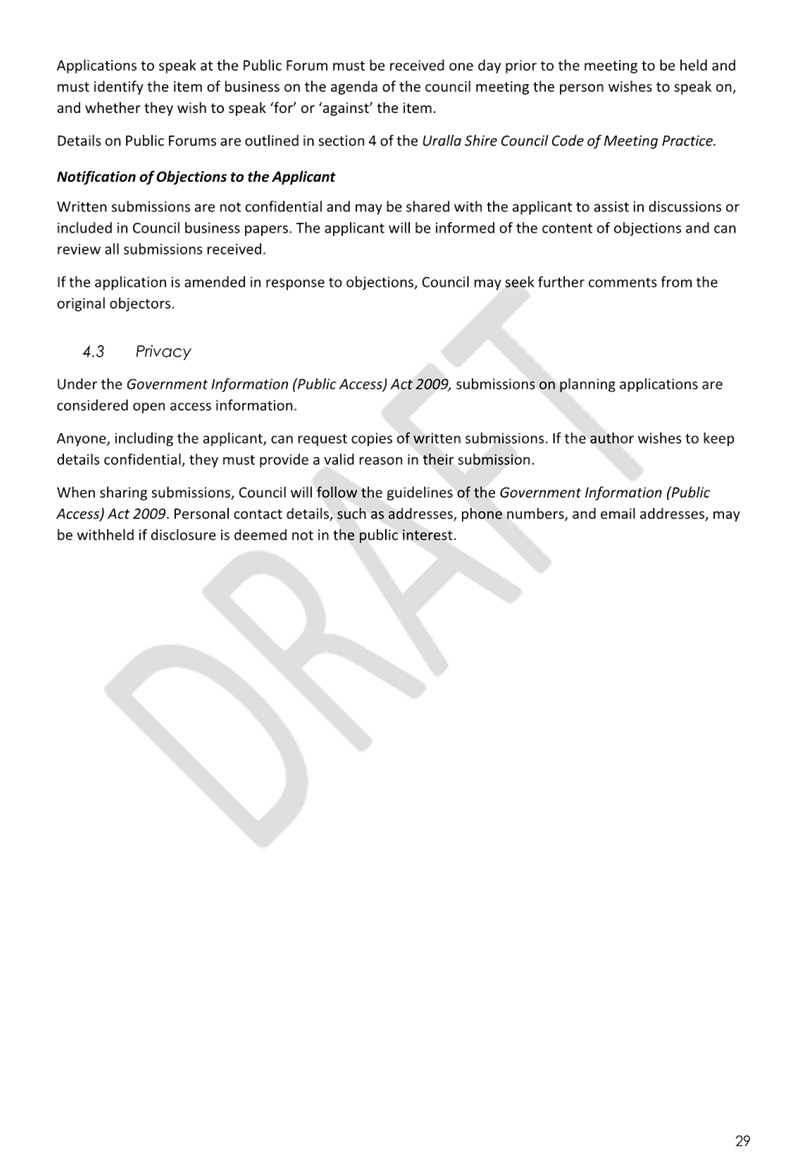
|
Ordinary
Council Meeting Business Agenda
|
25 February 2025
|
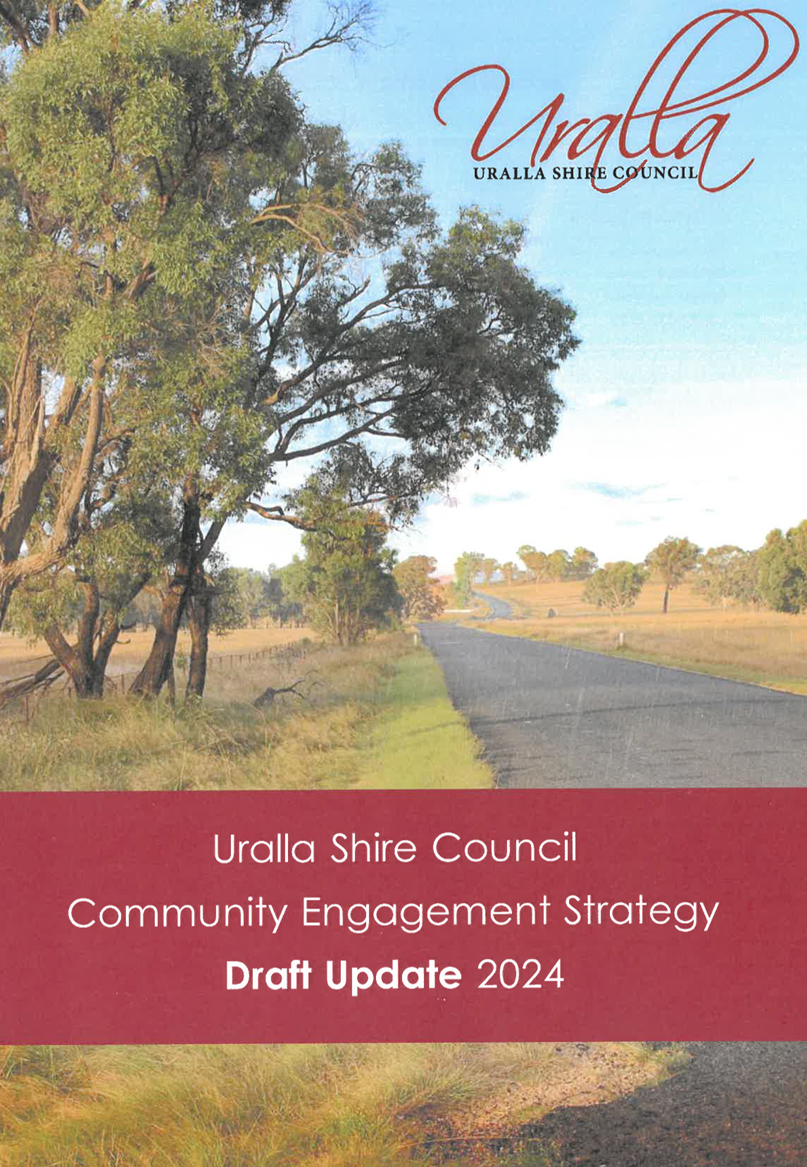
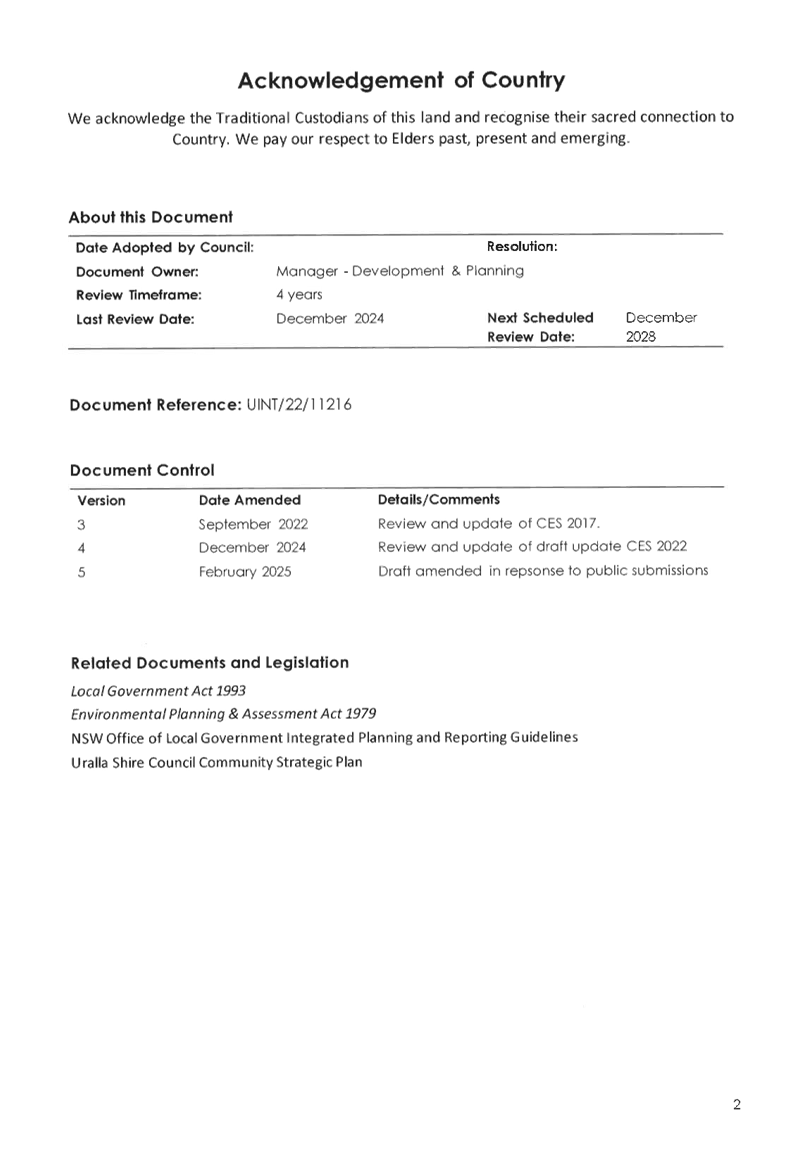
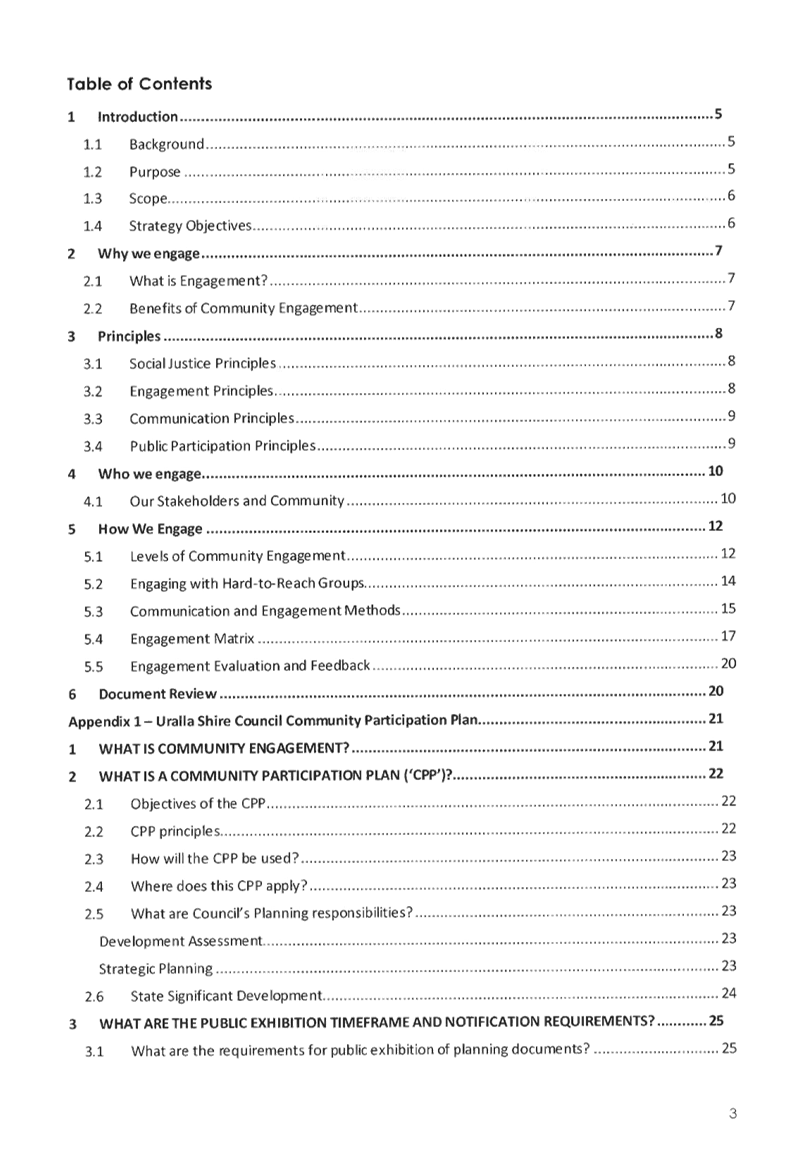

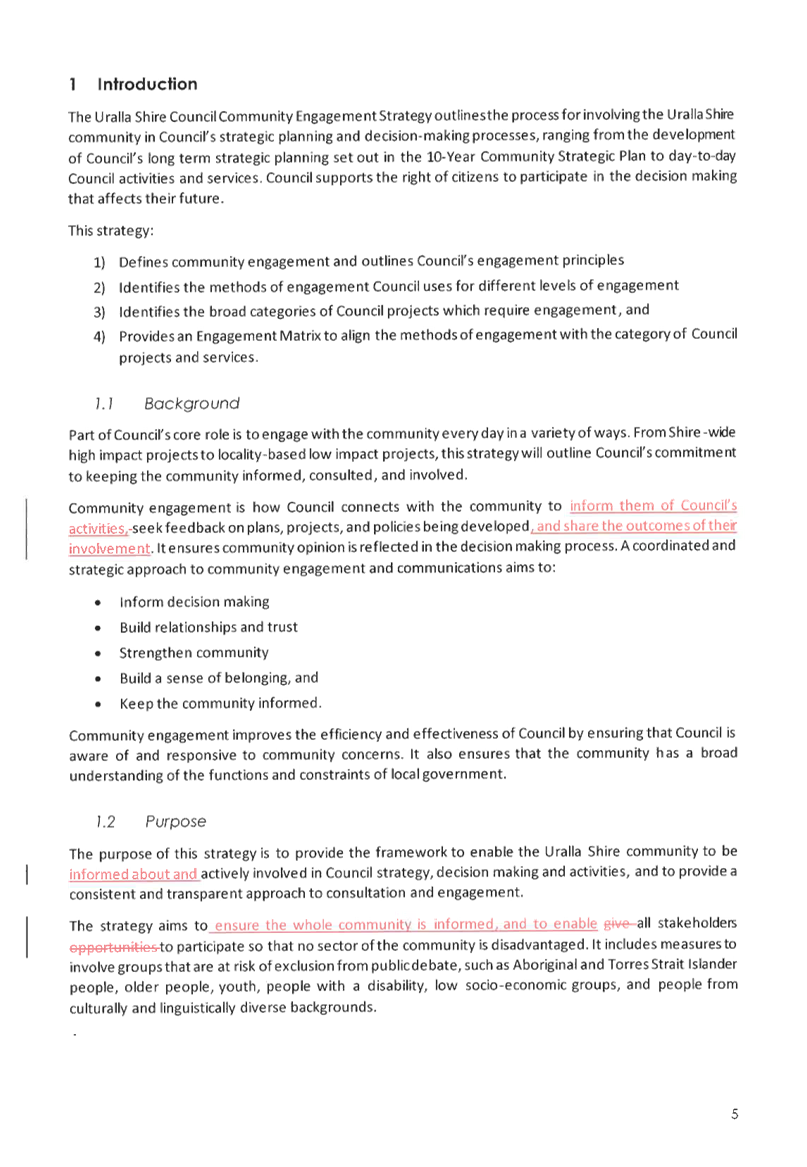
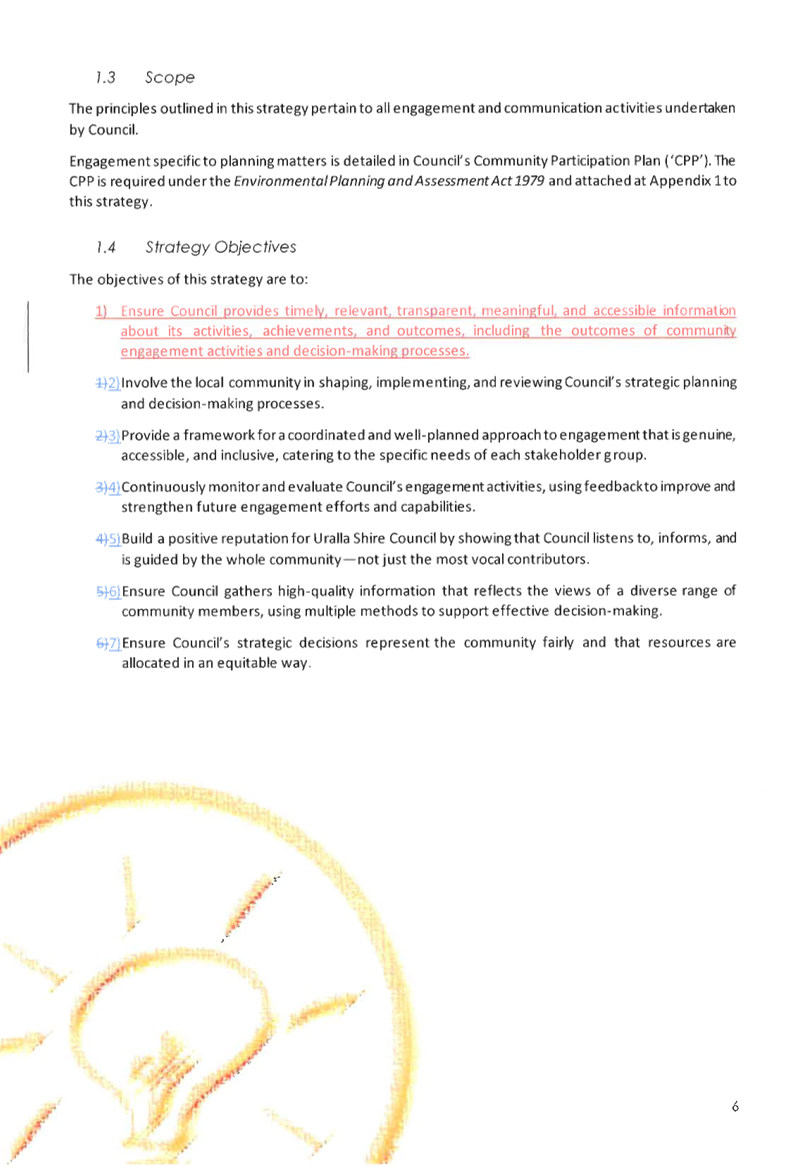
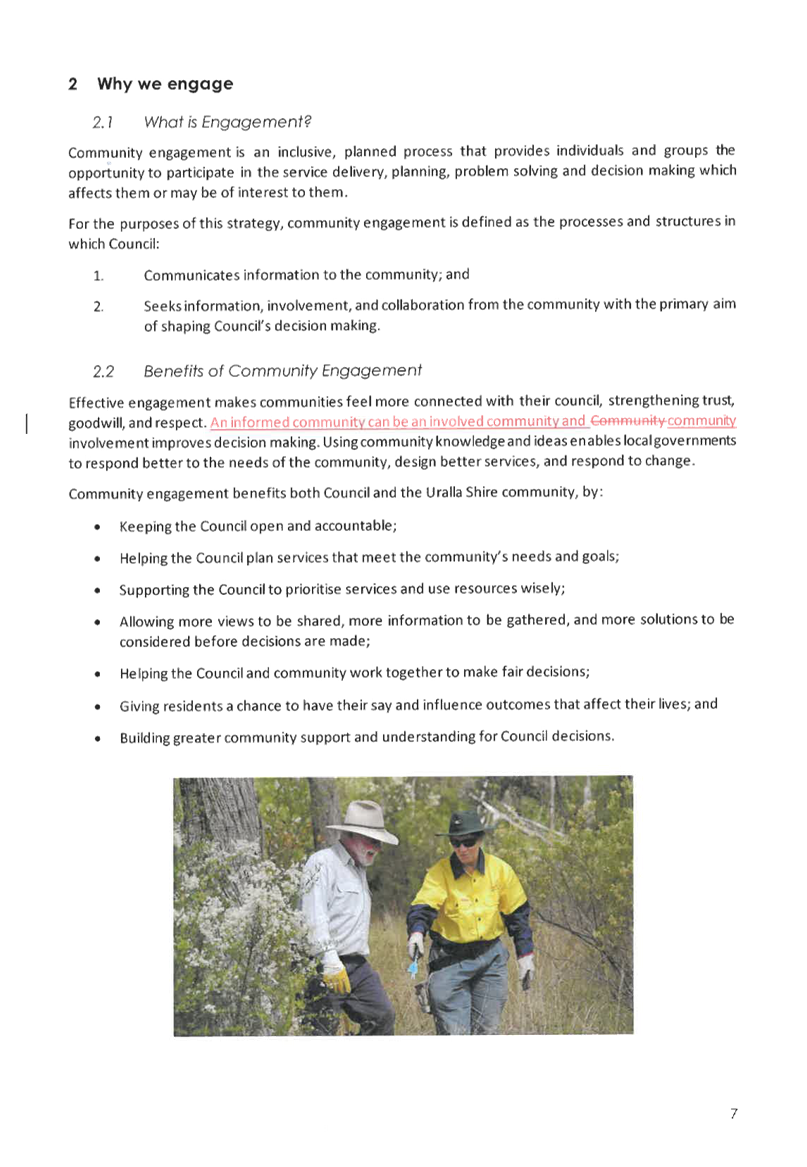
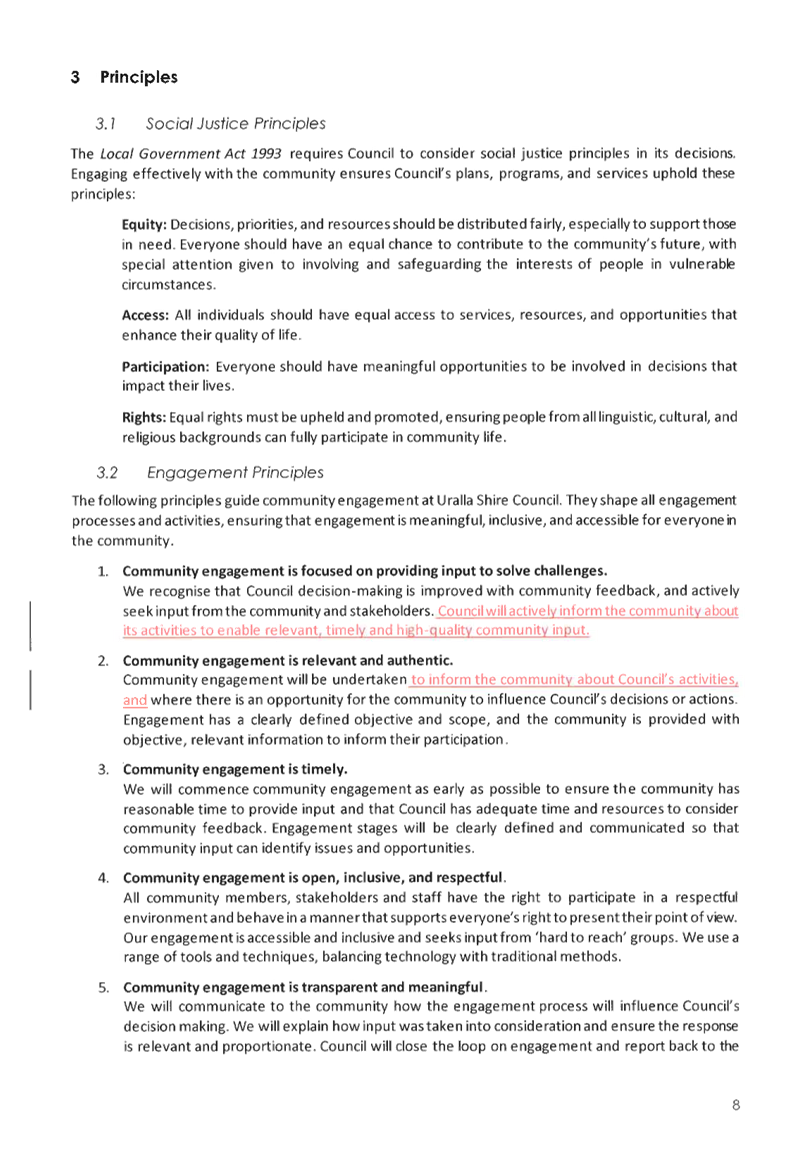
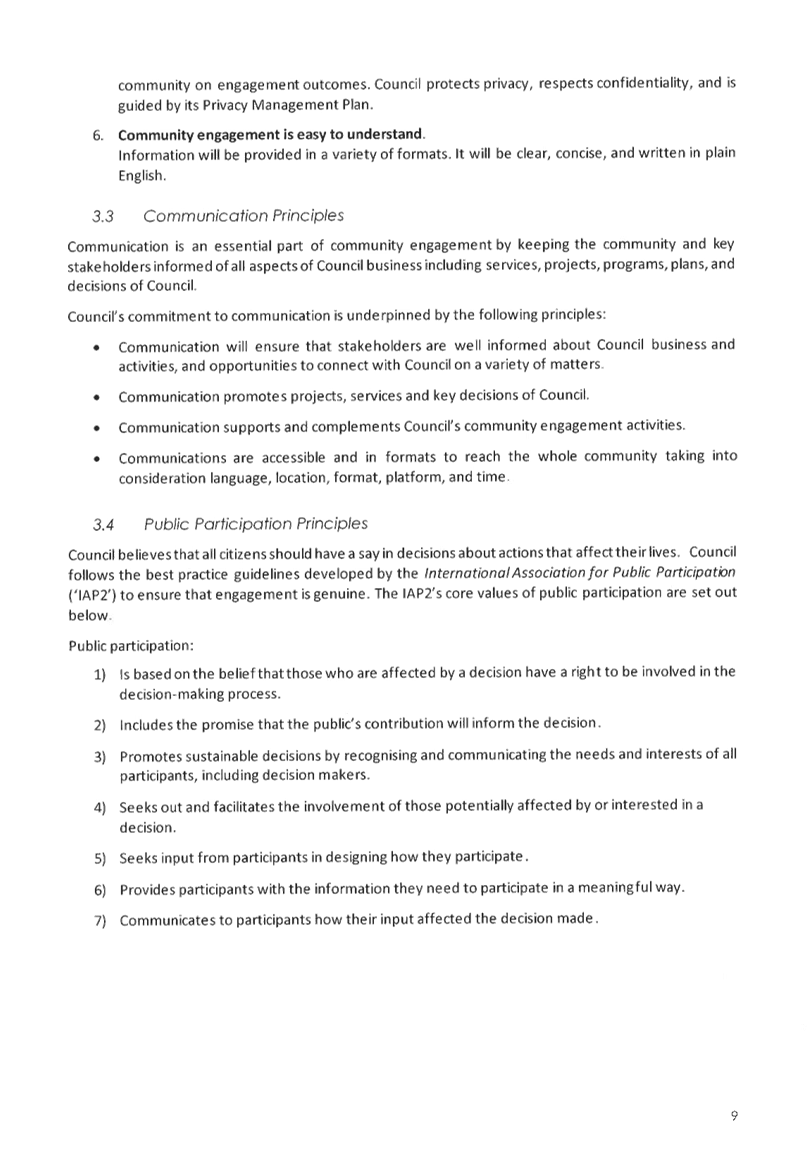
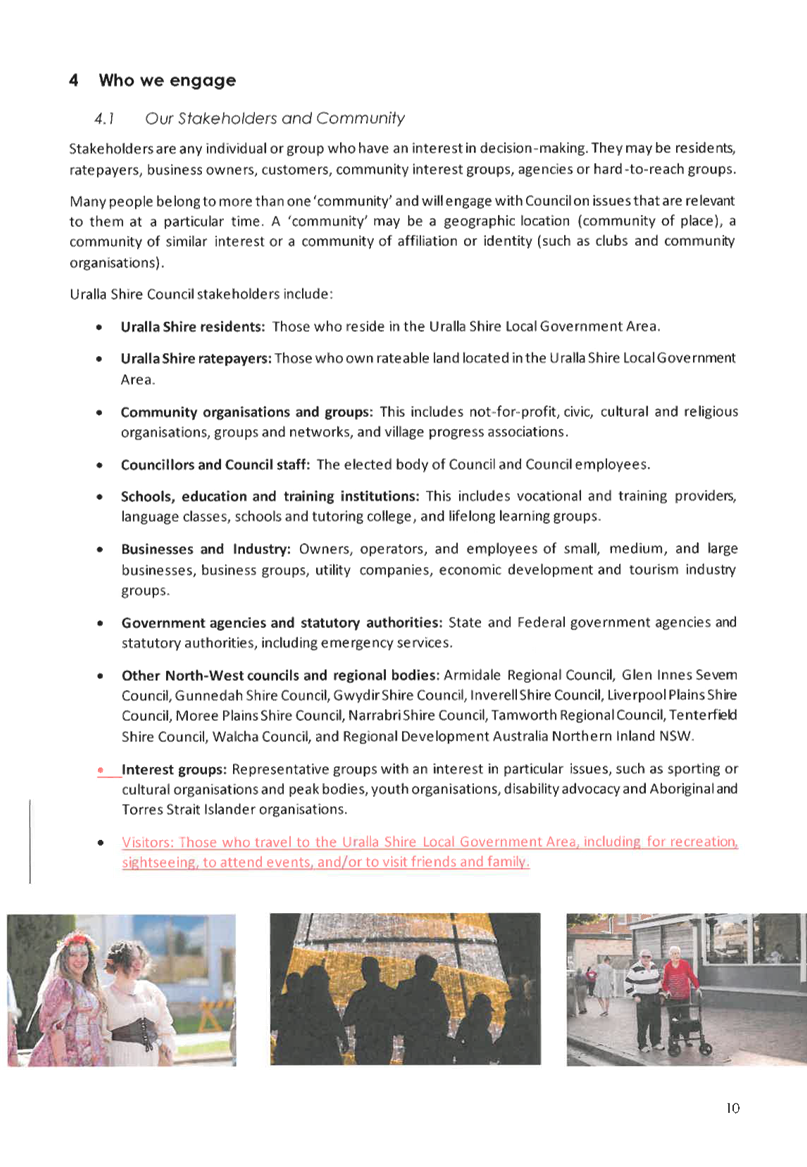

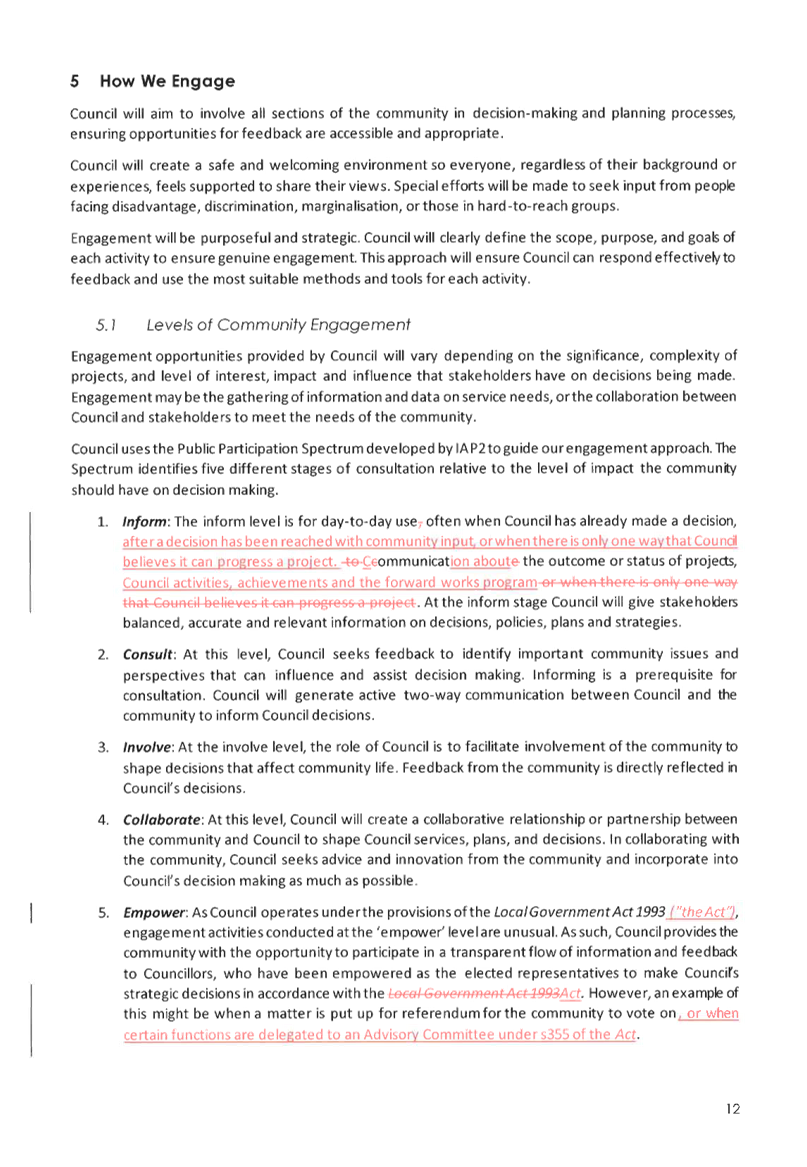
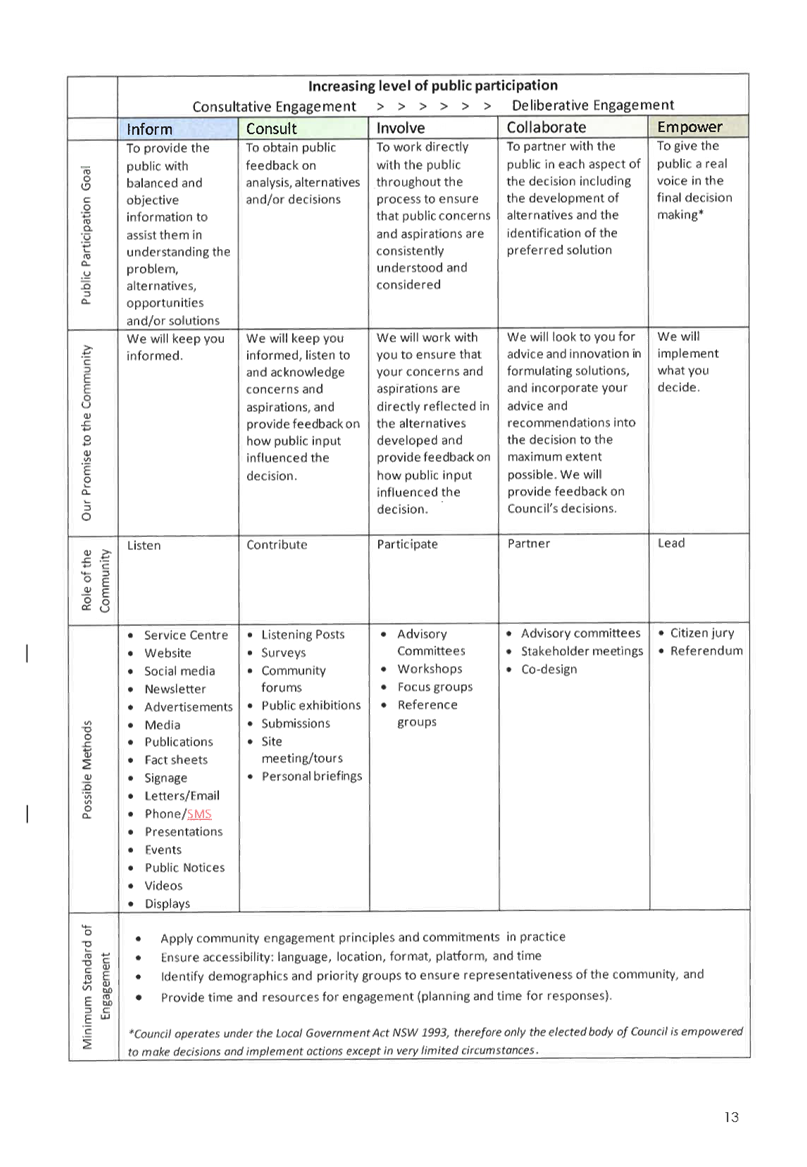
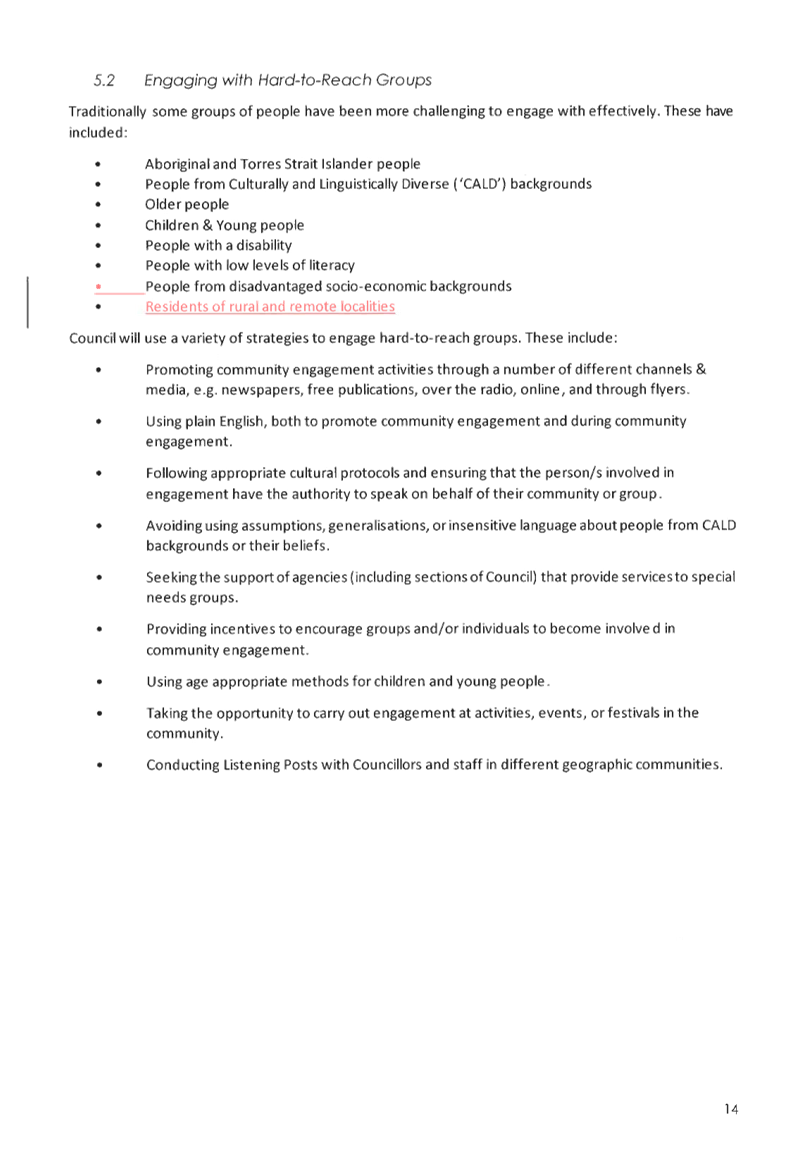
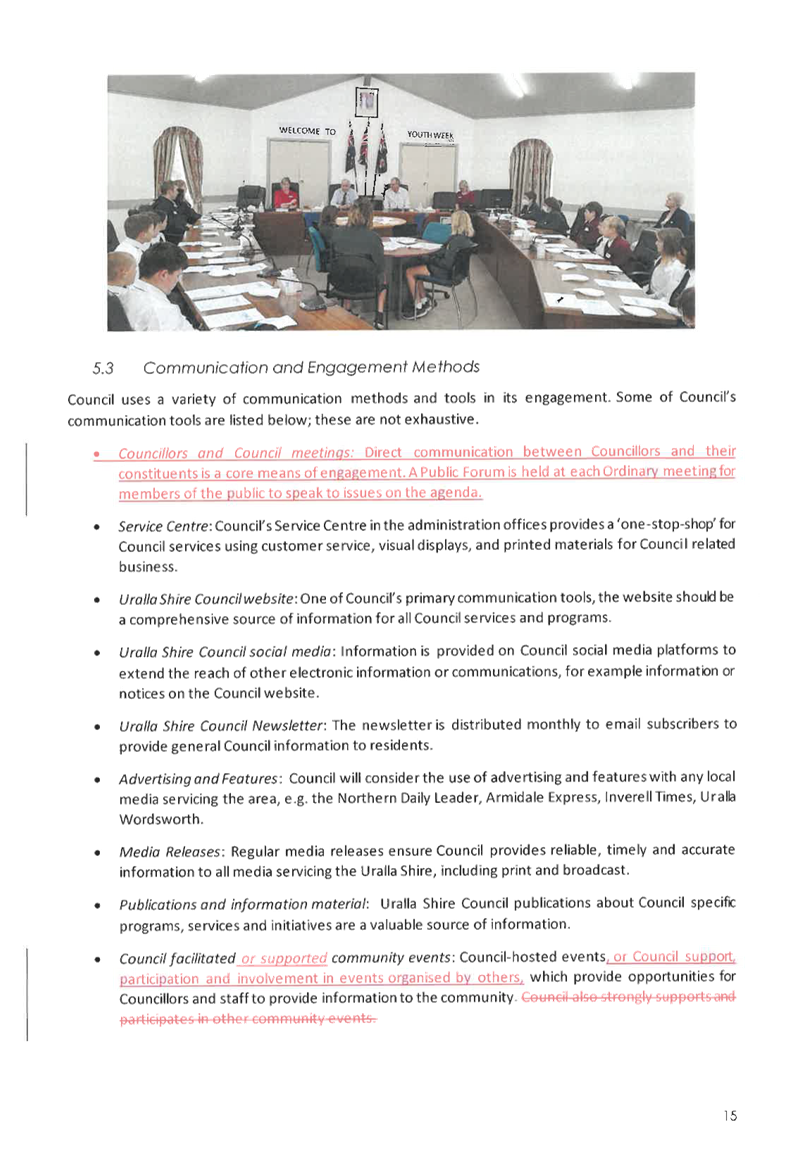
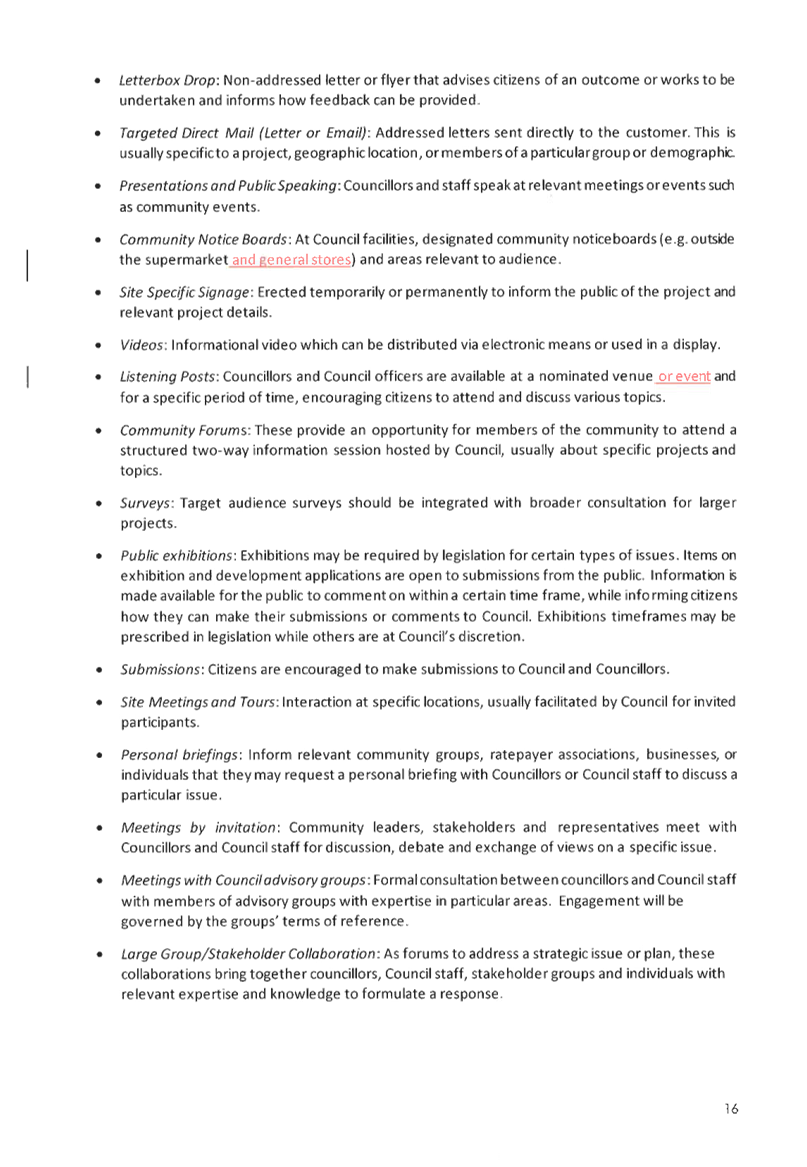
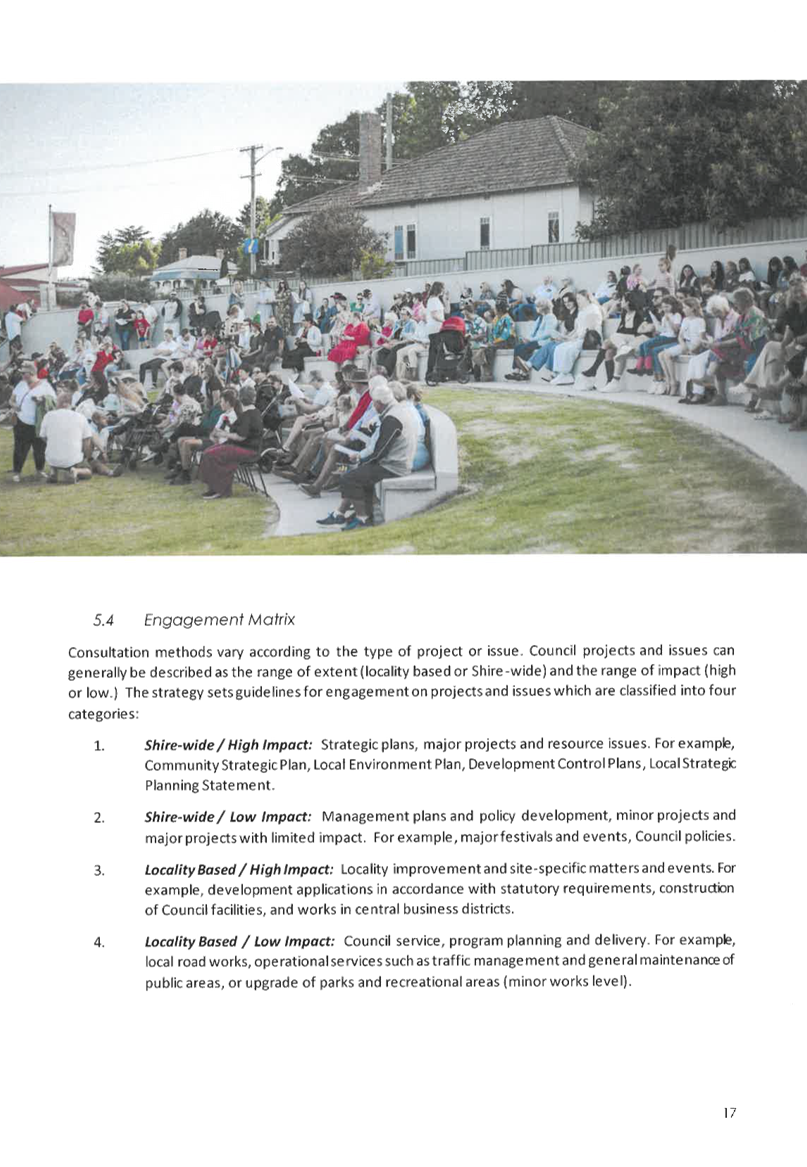

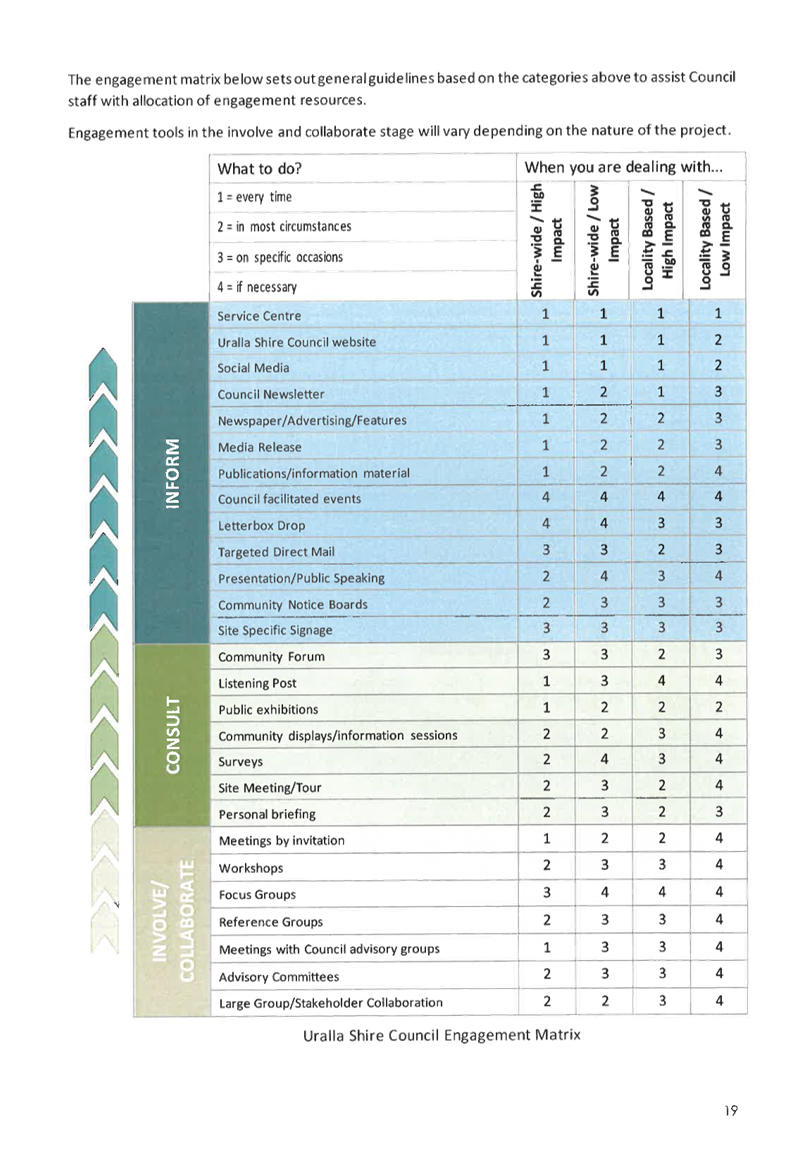
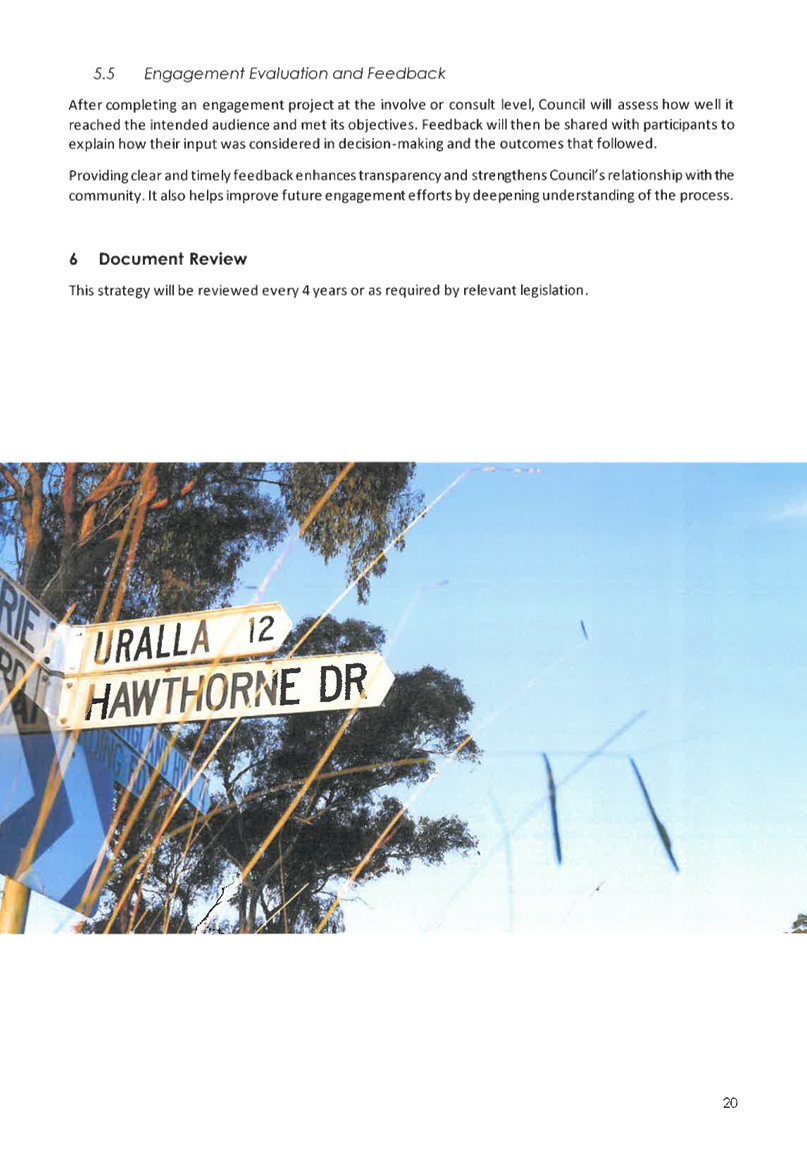
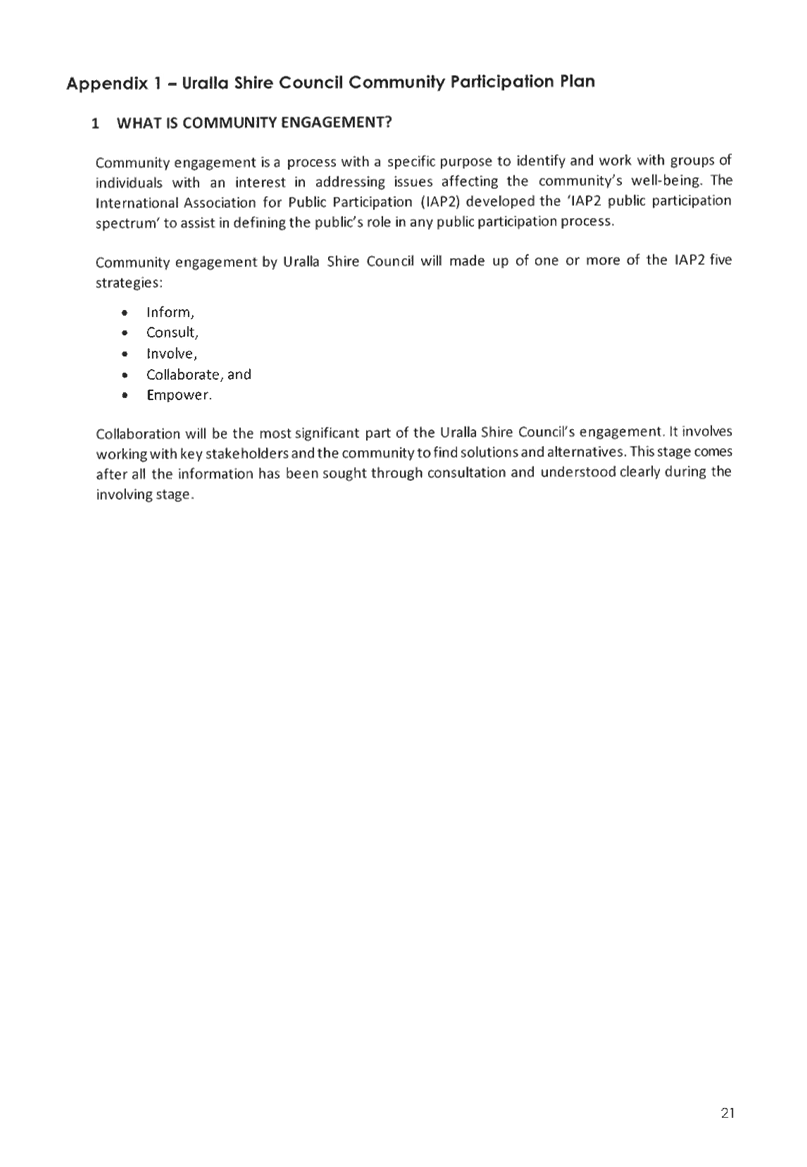
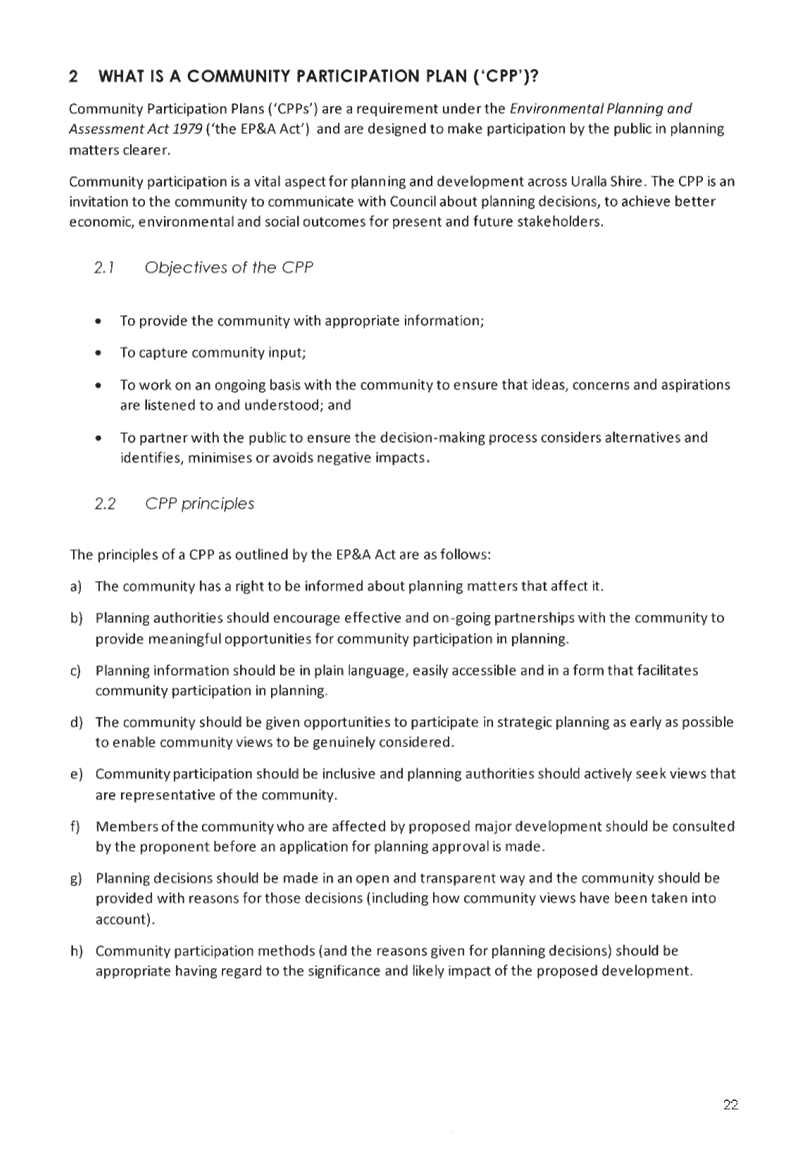
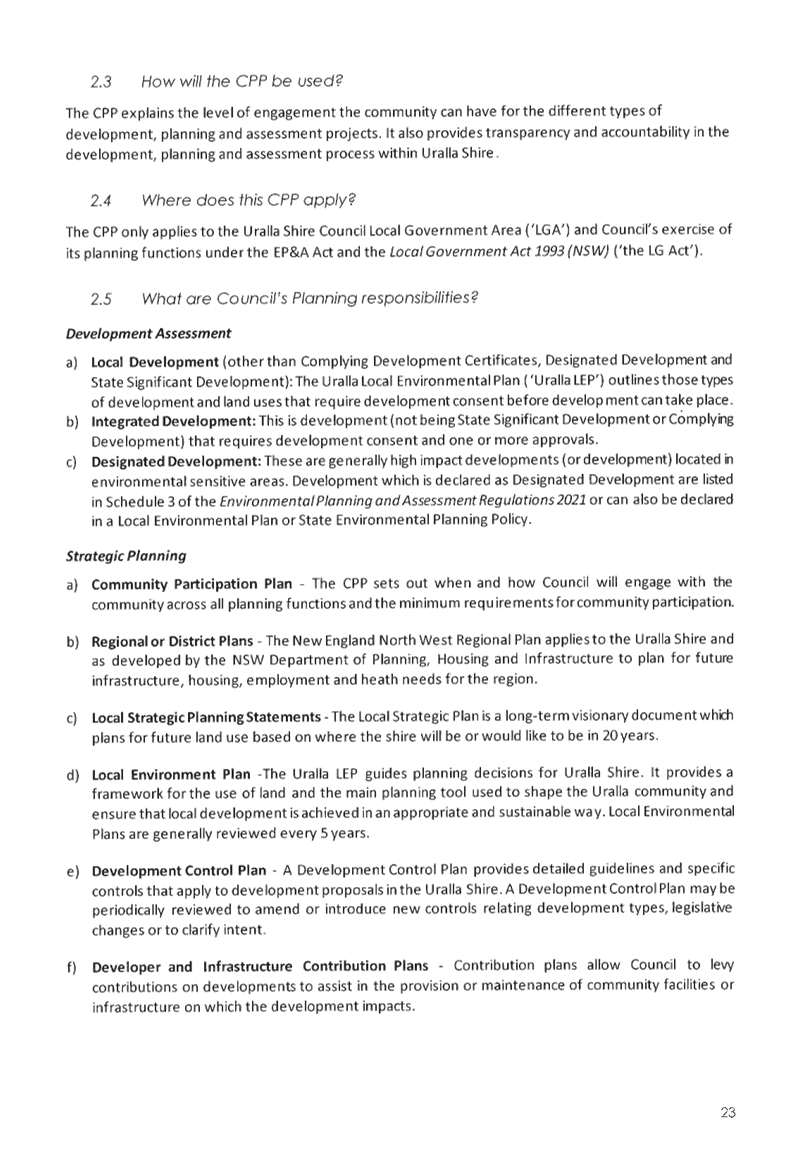
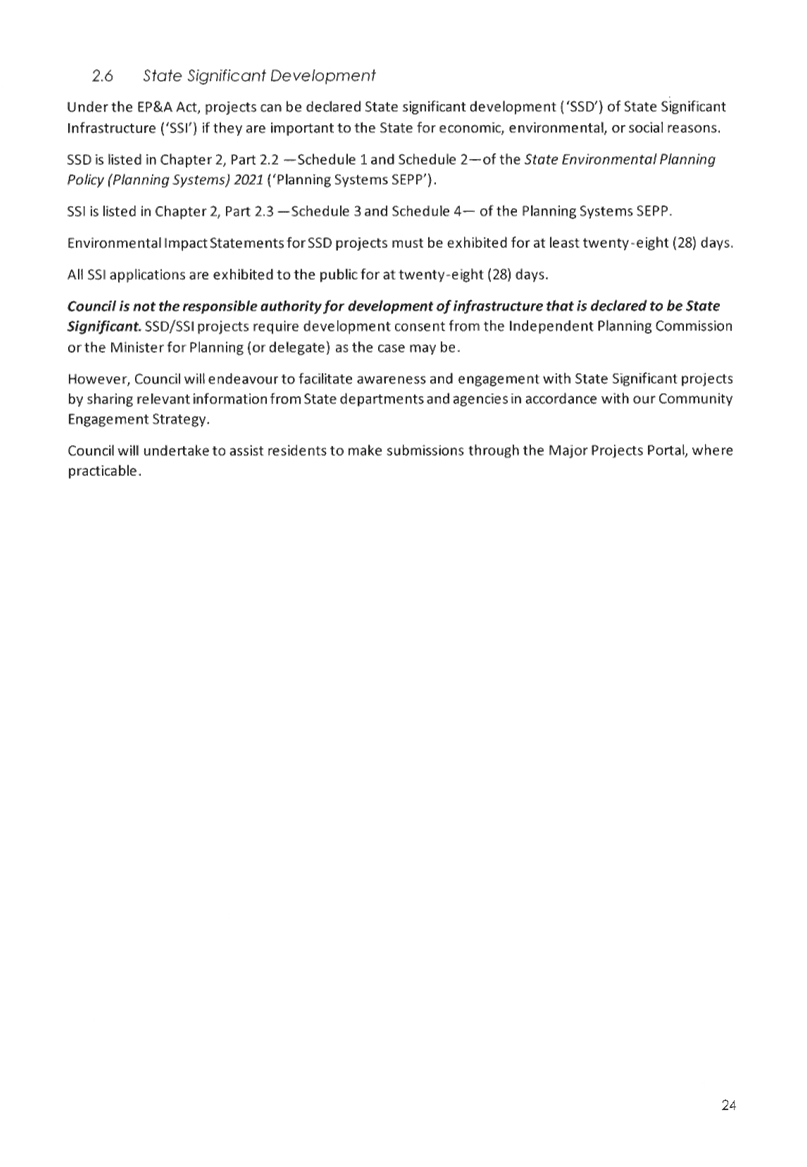
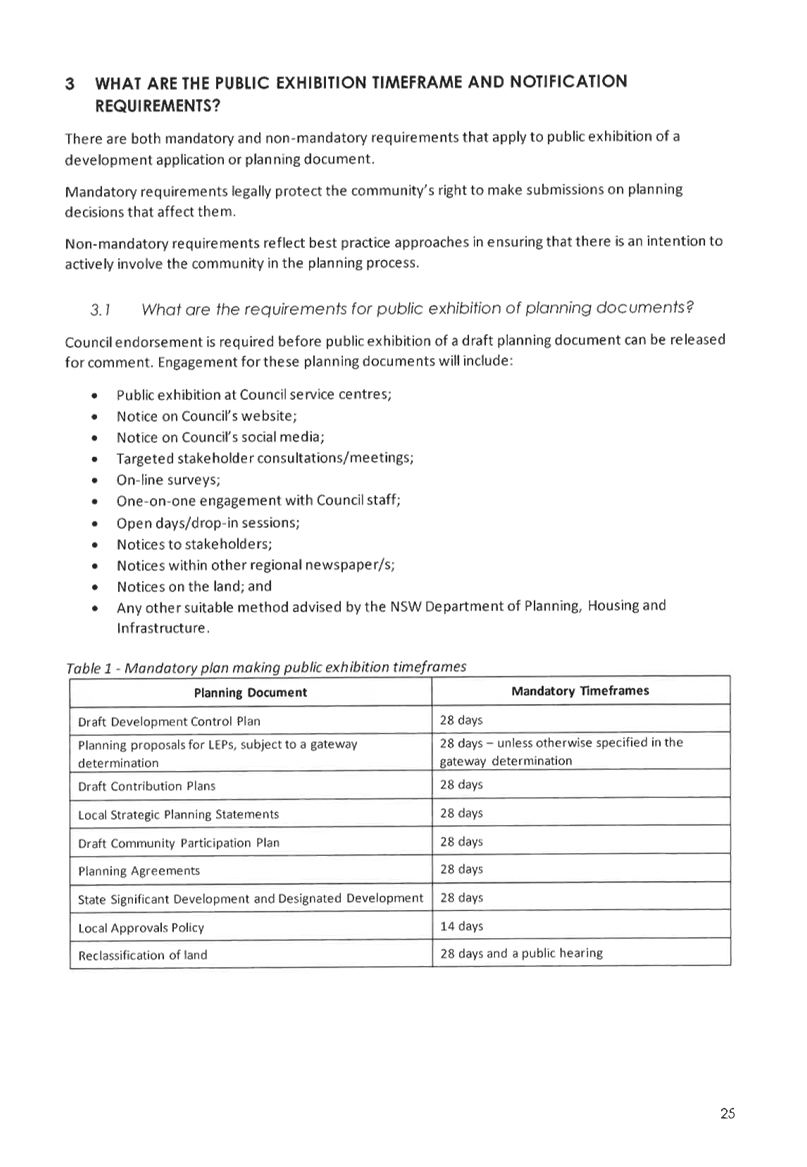
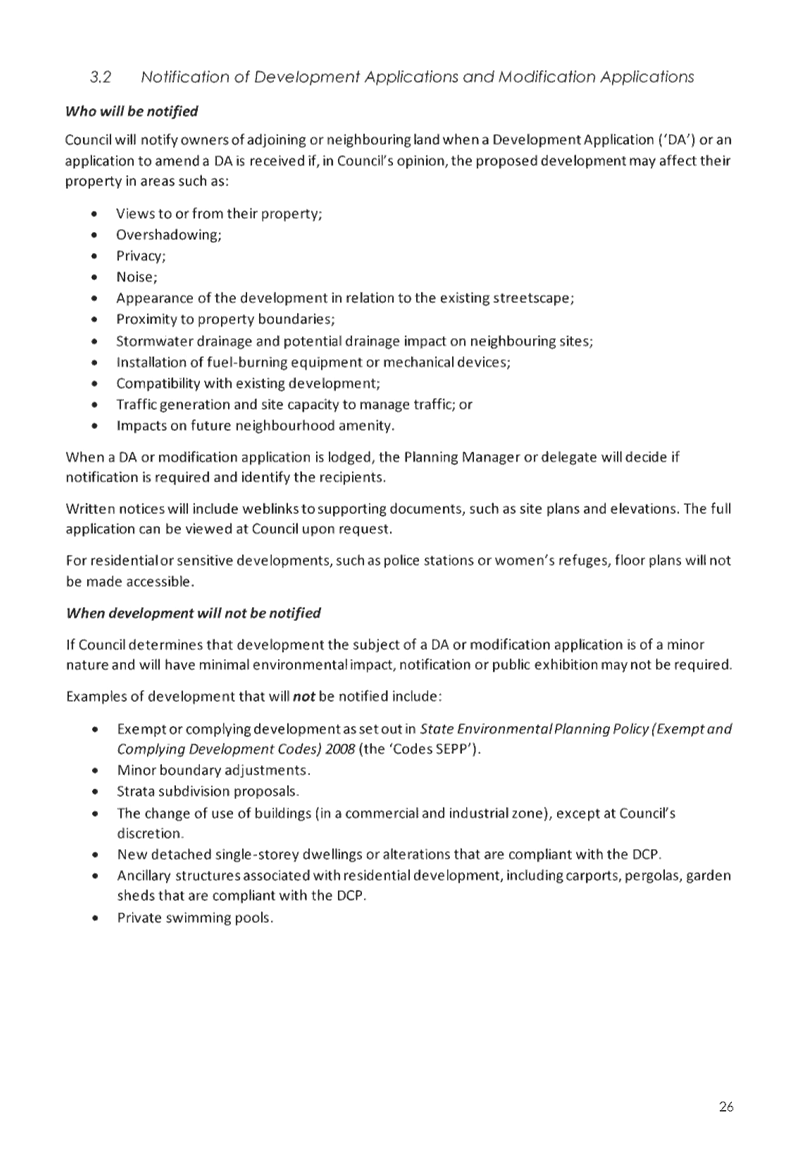
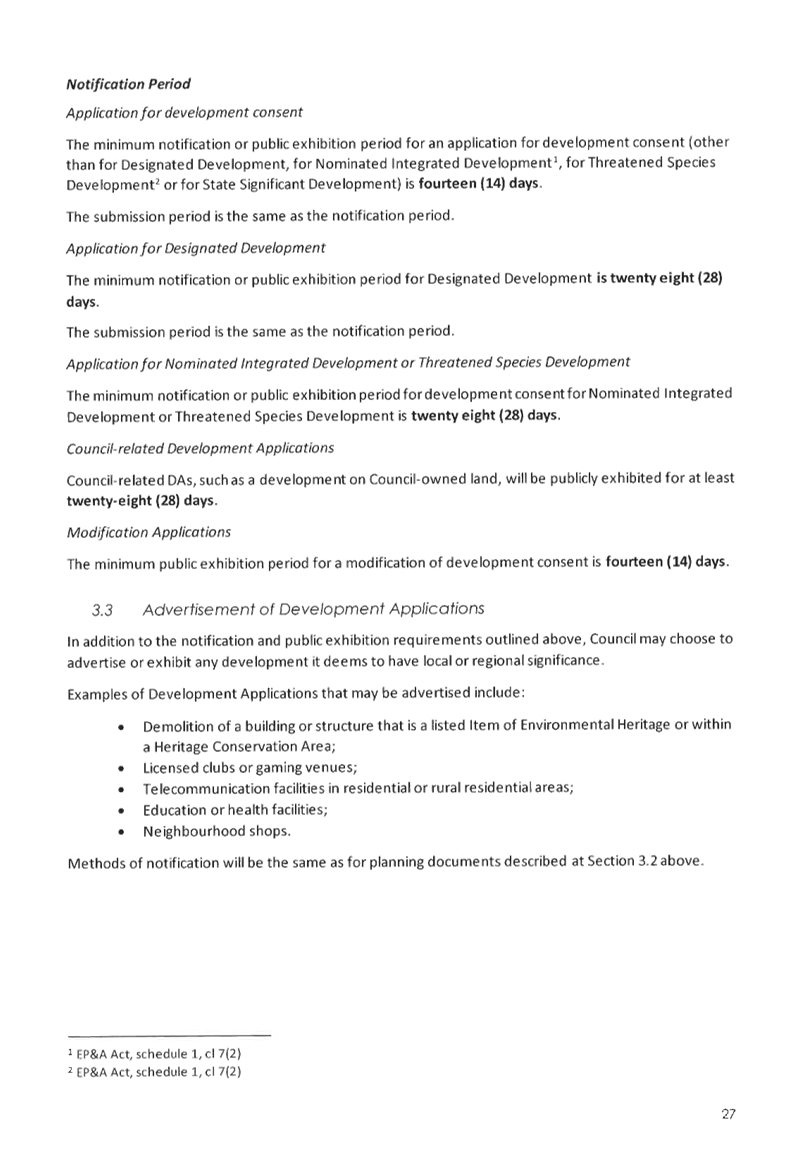
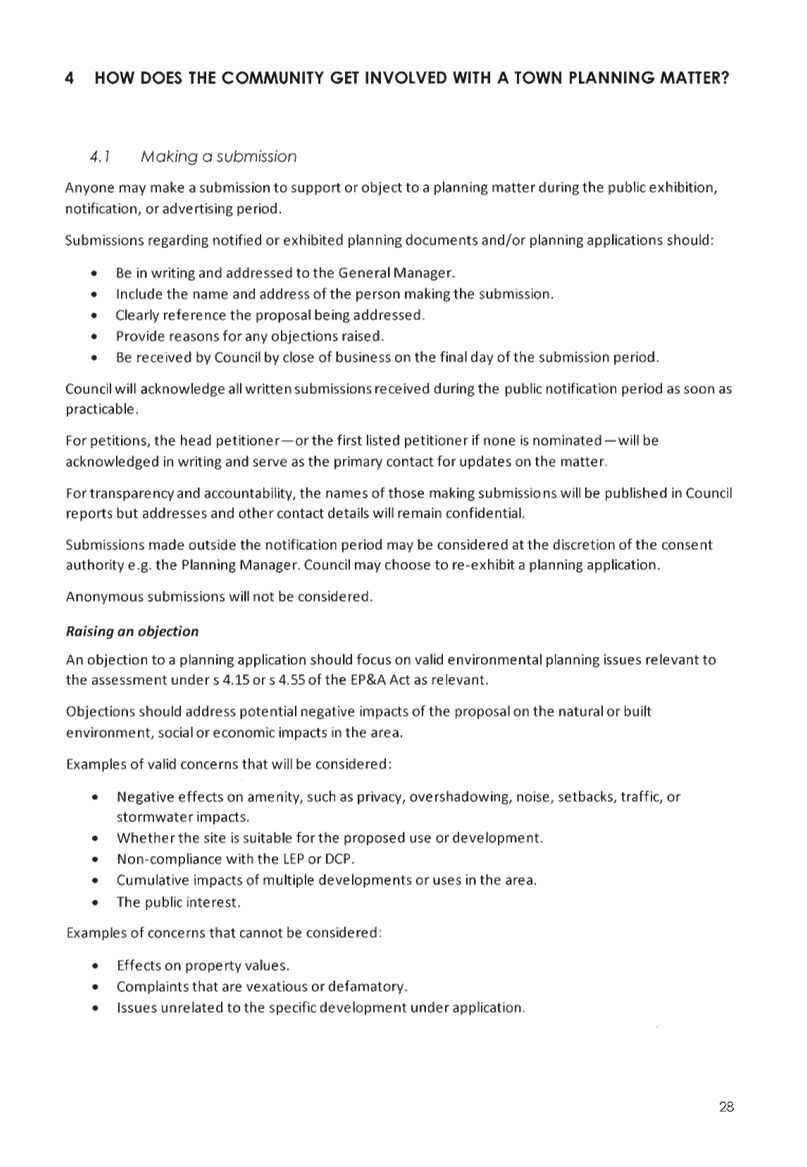
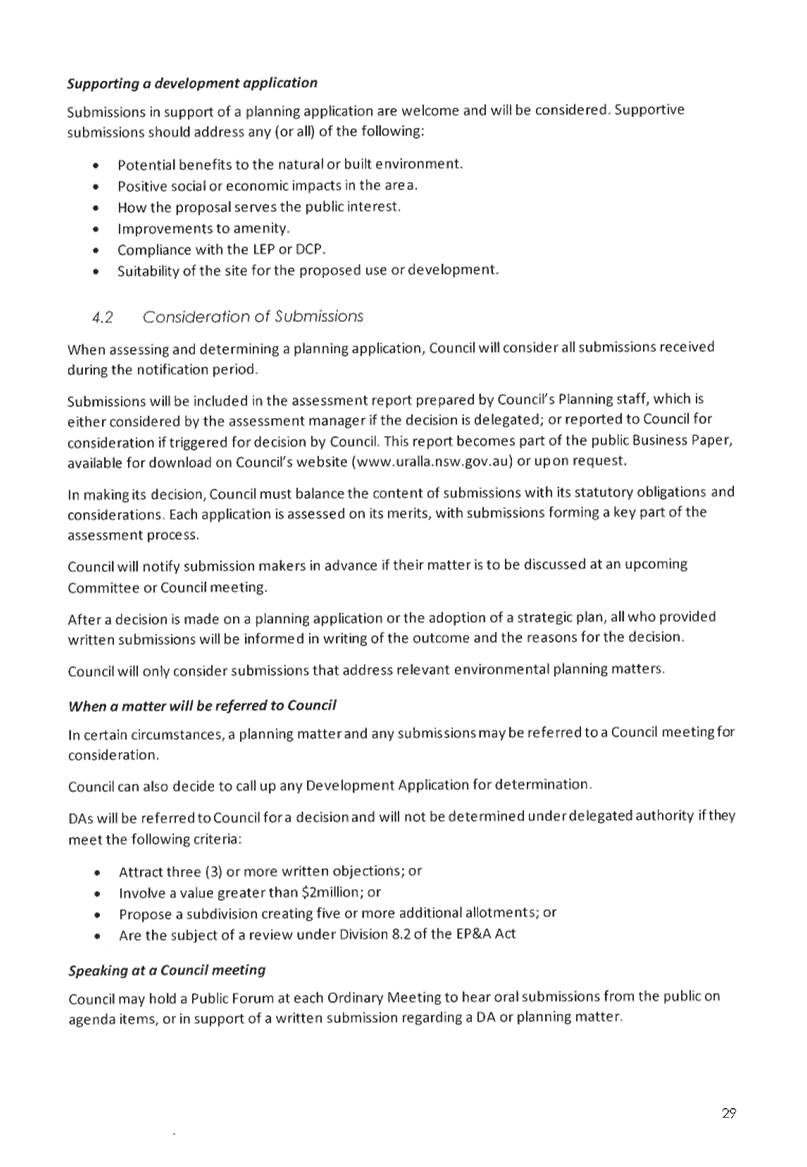
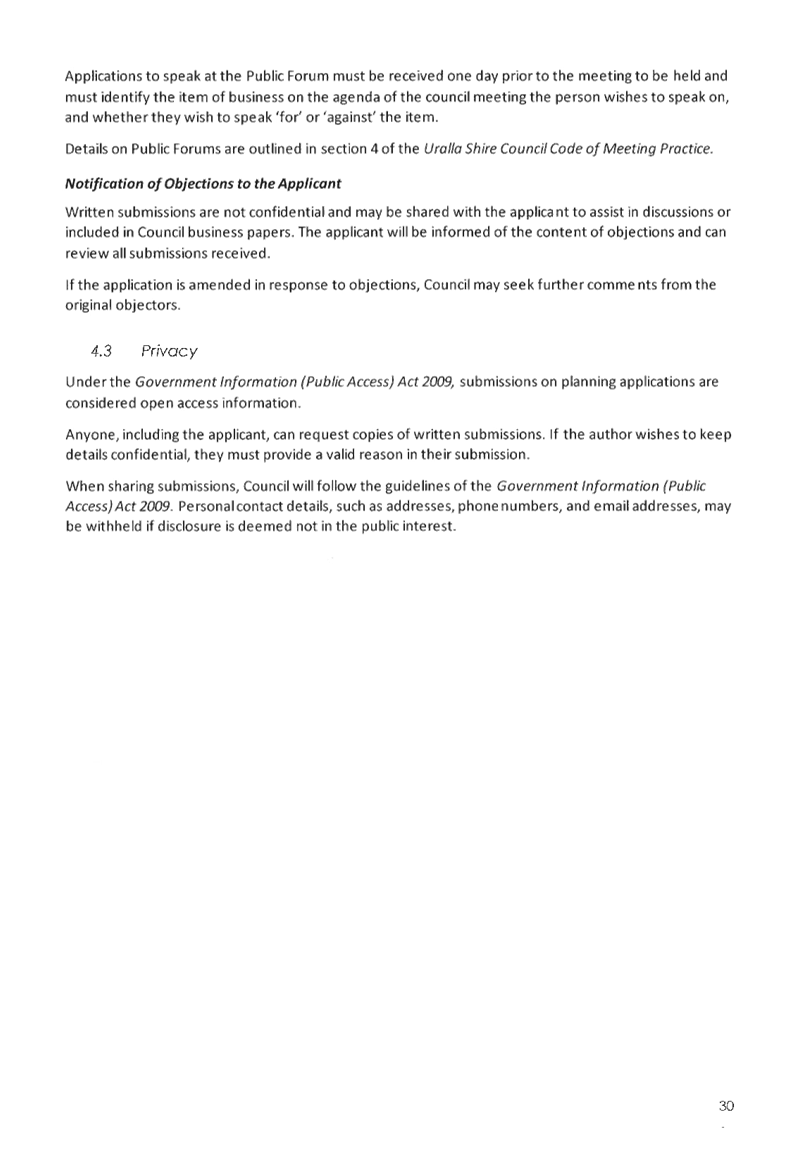
|
Ordinary Council
Meeting Business Agenda
|
25 February 2025
|
14.7 Plans
of Management for Council managed Crown Lands (CLM)
|
Department:
|
Infrastructure &
Development
|
|
Prepared By:
|
Group Manager Infrastructure
Services
|
|
Authorised By:
|
Director Infrastructure & Development
|
|
Reference:
|
UINT/24/18523
|
|
LINKAGE TO INTEGRATED PLANNING AND REPORTING FRAMEWORK
|
|
Goal:
|
3. We
are good custodians of our environment
|
|
Strategy:
|
3.1. To
preserve, protect and renew our beautiful natural environment
|
Summary
Plans of Management for Crown
Lands managed by Uralla Shire Council have been in development for many months.
This report provides an update on the status of each.
|
Recommendation
That Council notes this update on the preparation of
Plans of Management for Crown Lands managed by Council.
|
Report
The full process for the adoption
of Plans of Management (POM) is:
Step 1 – Draft POM developed by officer
Step 2 – Ministerial review and comment.
Step 3 – incorporate Ministerial direction.
Step 4 – Council noting for Public Exhibition
Step 5 – Final internal review/amendment.
Step 6 – Final Council adoption.
Council has five (5) POMs
that are in various stages of development.
Two of the five plans are generic
POM’s:
· Crown Land Plan of
Management - Crown Reserve Parks (Generic) - Uralla Shire Council
· Crown Land Plan of
Management - General Community Use Reserves (Generic) - Uralla Shire Council
Both of these plans have been
submitted to the Minister managing Crown Lands for consent and approval and
have now come back with comments that require action. To effectively action the
Ministerial input a Native Title Consultant has been engaged to provide input.
These POMs are effectively at Step 3 of the process.
There are three further POMs:
· Crown Land Plan of
Management - Bundarra Downs Reserve (Bundarra Nature Park) - Crown Reserve
1013348
· Crown Land Plan of
Management - Gostwyck Road Reserve - Crown Reserve 89071
· Crown Land Plan of
Management - Racecourse Lagoon - Crown Reserve 86472
These are at Step 1 and will be
issued to the Minister for direction when ready. Considering the Ministerial
input for the two more advance generic POMs, it is likely that our Native Title
Consultant will be involved prior to submission to the Minister.
Once all POM’s pass Stage 3 they will be presented to
Council to consider public exhibition for community feedback.
It is intended that the two Generic POMs will reach Stage 4
and be submitted to Council to consider for public exhibition in March 2025,
with the remaining POM’s reaching Stage 2 and being submitted to the
Minister in April 2025.
The timeframe for gaining Ministerial advice and direction
is unknown.
Conclusion
Manager Waste and Environment will
continue working with the engaged Native Title Consultant to complete the POMs.
Once approved they will follow the due process of acceptance from Council,
public exhibition for community feedback, and final adoption by Council.
Council Implications
Community Engagement/Communication
Nil
Policy and Regulation
Nil
Financial/Long Term Financial Plan
Nil
Asset Management/Asset Management
Strategy
Nil
Workforce/Workforce Management Strategy
Nil
Legal and Risk Management
Nil
Performance Measures
Nil
Project Management
Manager Waste and Environment.
|
Ordinary Council
Meeting Business Agenda
|
25 February 2025
|
14.8 Introduction
of a Declared Dams Safety Level
|
Department:
|
Infrastructure &
Development
|
|
Prepared By:
|
Manager Water & Sewer
|
|
Authorised By:
|
Director Infrastructure & Development
|
|
Reference:
|
UINT/25/1049
|
|
LINKAGE TO INTEGRATED PLANNING AND REPORTING FRAMEWORK
|
|
Goal:
|
4. We
are an independent shire and well-governed community
|
|
Strategy:
|
4.2. A
strategic, accountable and representative Council
|
Summary
In
December 2023 the NSW Government commissioned the Independent Pricing and
Regulatory Tribunal (IPART) to recommend a clear, cost-effective methodology
for the Dam Safety Levy. IPART will introduce the levy on dam owners (including
Council) to share the costs of dam safety across NSW. Under IPART's framework, owners of dams with a 'Significant' dam safety
consequence rating—such as applies to Kentucky Creek Dam—will pay
an annual levy of $10,588 plus the most current consumer price index
annually commencing in 2025. Council must ensure that the dam safety levy
amount is incorporated into the yearly budget and determine whether to fund the
levy through existing water fees and charges or to recover the cost from
Uralla’s residents.
|
Recommendation
That Council
1. Notes
the anticipated $10,588 (plus annual indexation) dam levy imposed by Dam
Safety NSW, based on the current ‘Significant’ consequence rating
of Kentucky Creek Dam;
2. Incorporates
the expected cost into annual budget preparations with an adjusted annual
Consumer Price Index allowance commencing in March 2025; and
3. Notes
that the impact on Council’s current draft Long Term Financial Plan
considerations is an additional $10,588 (plus indexation) annual levy from 1
July 2025, which equates to an additional $6.46 (plus indexation) per
connected household per annum.
|
Report
The
report received from Dam Safety NSW outlines the following:
“Kentucky Creek Dam,
Council’s current water supply, is one of 380 NSW dams regulated by Dams
Safety NSW (DSNSW). Before 2015, dam safety was managed by the Dams Safety
Committee under the Dams Safety Act 1978, with limited regulations. In 2015,
the NSW Parliament established DSNSW as an independent regulator under the Dams
Safety Act 2015, strengthening safety standards and reducing risks to
surrounding communities.
DSNSW provides various forms of
support to dam owners, placing financial demands on the Department. For
example, USC is receiving financial assistance for the 2025 risk assessment of
Kentucky Creek Dam, which also requires hydrological and geotechnical
investigations. DSNSW has offered to conduct some of this work in-house,
providing additional free support to USC.
Currently, Dam Safety NSW is
funded by the NSW Government. However, the Dams Safety Act 2015 allows for a
levy to recover regulatory costs from declared dam owners. This levy would
distribute costs among dam owners, ensuring DSNSW can continue providing
effective and efficient support. The levy is based on a dam’s consequence
rating, with higher-risk dams requiring greater regulatory oversight and costs.
The Department is confident that
this approach, backed by IPART’s thorough analysis, will enable Dams
Safety NSW to maintain high regulatory standards while ensuring financial
sustainability.
From March to August 2024, IPART
conducted extensive consultations, including a public hearing with declared dam
owners, to gather feedback and refine the levy structure. More details on the
IPART Dams Safety Levy Review are available on their website:
https://www.ipart.nsw.gov.au/sites/default/files/cm9_documents/Final-Report-Dams-Safety-NSW-levy-review-September-2024.PDF
What does this mean for Uralla Shire
Council?
Table 1 below indicates the
indicative levy prices proposed by IPART for the 2025-26 financial year.
Kentucky Creek Dam is currently rated ‘Significant.’ The table
below shows that, under the proposed system, USC would be required to pay $10,588
plus indexation, commencing in 2025.
|
Dam
consequence category
|
Low
|
Significant
|
High
|
Extreme
|
|
Levy
per dam (2025 - 26)
|
$7,651
+ indexation
|
$10,588
+ indexation
|
$12,621
+ indexation
|
$15,269
+ indexation
|
Table 1
Dams Safety NSW will continue working
with dam owners to support a smooth transition to the levy’s
implementation on 1 July 2025.
.
In April 2025, all declared dam
owners will receive a letter from Dams Safety NSW outlining their 2025-26 levy
amount, which will be adjusted based on the March 2025 Consumer Price Index.
Additionally, under the NSW Dams
Safety Act, Council must conduct a Consequence Category Assessment on its dams
every 15 years. The next assessment for Kentucky Creek Dam is due in June 2035
and may confirm or alter the dam’s consequence rating, potentially
affecting the levy amount.
The levy must be included in each
financial year’s budget following its implementation in July 2025.
Additionally, Council should consider whether to cover the levy through
existing water rates and funds or pass the cost onto Uralla’s residents.
With approximately 1,639 water
meters in Uralla, the current levy equates to $6.46 per household connected to
the town's water supply. This price will be adjusted each year with the most
current price indexation commencing in 2025.”
Conclusion
IPART will introduce a levy on
dam owners, including Council, to share the costs of dam safety. Under IPART's
framework, owners of dams with a 'Significant' consequence rating—such as
Kentucky Creek Dam—will pay an annual levy of $10,588 plus most current
consumer price index.
Council will need incorporate
the dam safety levy amount into its annual budgets from 1 July 2025.
Council Implications
Community Engagement/Communication
IPART -
Between March and August 2024, IPART held extensive consultations, including a
public hearing with declared dam owners, to gather feedback and refine the levy
structure.
Policy and Regulation
Dams Safety NSW (DSNSW) -
Independent regulator charged with ensuring the safety of declared dams.
NSW Government – Current
funding of dam safety related to State management and administration.
The Dams Safety Act 2015 - allows
the Government to levy dam owners to cover regulatory costs.
Local Government Act 1993 Chapter
15, Part 1, Section 495 - Making and levying of special rates.
Local Government Regulation 2005
Part 5, Part 6, Part 9.
Financial/Long
Term Financial Plan
Yearly Operational Plan
Delivery Program 2022-2026
Draft Long Term Financial Plan
2032
Water and Sewer Asset Management
Plan
Yearly Fees and Charges
Asset
Management/Asset Management Strategy
Water and Sewer Asset Management
Plan
Workforce/Workforce
Management Strategy
Not applicable
Legal and Risk Management
TBC
Performance
Measures
Not applicable
Project
Management
Manager Water and Waste water
|
Ordinary Council
Meeting Business Agenda
|
25 February 2025
|
14.9 Summary
of Future Grants
|
Department:
|
Infrastructure &
Development
|
|
Prepared By:
|
Group Manager Infrastructure
Services
|
|
Authorised By:
|
Director Infrastructure & Development
|
|
Reference:
|
UINT/25/857
|
|
LINKAGE TO INTEGRATED PLANNING AND REPORTING FRAMEWORK
|
|
Goal:
|
2. We
drive the economy to support prosperity
4. We
are an independent shire and well-governed community
|
|
Strategy:
|
2.3. Communities
that are well serviced with essential infrastructure
4.2. A
strategic, accountable and representative Council
4.3. An
efficient and effective independent local government
|
Summary
There is a significant
volume of grants that are received through the infrastructure side of
Council’s operations. Many grants are one-off opportunities
(non-recurrent) because they are linked to a specific event such as disaster
recovery, or where the Federal or State Government want to invest in a
particular policy direction. Other grant types are recurrent and reasonably
dependable such as, for example, many Roads and Transport grants for the
renewal of transport assets.
The list below
provides an update of current and future recurrent grants, and where known,
non-recurrent (one-off) grants, and an assessment of their potential to
continue in the coming years. Noting that no Capital and Operational
Expenditure has been linked to any grant that has not been awarded.
|
Recommendation
That Council notes this list for Information Only and
further discussion if warranted.
|
Report
The list of
current grants available to Council is as follows:
Federal Government Grants
§ Safer Local Roads and
Infrastructure Program (SLRIP)
· This Grant could be
broken apart if Government chose to which would make the Grant more
restrictive. This is however considered unlikely at this stage.
· For the 2024 round,
Council has applied for the Barraba Road Project for which the outcome is still
pending. It is likely a response will not be issued until after this
year’s Federal Election.
· No additional works
have been allocated or forecasted to this Grant except works that have been
listed in the Grant application.
§ Local Roads and Community
Infrastructure Program (LRCIP)
· LRCIP3 and 4
completion date for works is 2025.
· LRCIP4 Works
include:
o Bundarra Pedestrian Pram Ramps.
o Park, John St (Uralla) and
Noalimba (Kentucky) Footpath.
o Design of King and Maitland St Roundabout.
o Design of Terrible Vale Culvert
Crossing.
o Rocky River Culvert Crossing.
· LRCIP Phase 5 is yet
to be released. The likelihood of this grant is uncertain.
· No additional works
have been allocated or forecasted to this Grant except works that have been
listed in the Grant application.
§ Roads 2 Recovery (R2R)
· A 5-year Program
from 2024-29.
· The allocated dollar
value awarded to each council is based on length of road network.
· Works have been
forecasted/programmed appropriately.
· Key works for 2024
include Terrible Vale Road upgrade.
· Forecasted works for
2025 include Parking Bays and Intersection Upgrades on Bridge St aligning with
TfNSW’s Works.
§ Blackspot
· Criteria for this
program requires a minimum of 2x fatalities to occur within a certain time
period and within a certain distance from each other.
· This grant is not
historically a significant source for rural councils as the basic criteria is
often hard to achieve. Whilst there may be many deaths on a particular road,
they are typically spread out, not centralised i.e. an intersection.
· No applications are
afoot as we do not meet relevant criteria for any location.
§ Active Transport Fund (ATF)
· This is a new Grant
and is not necessarily guaranteed.
· In 2024, an
application was submitted for a Path from Rocky River Primary to Alma Park.
This would enhance and link with the Rocky River culvert renewal and pedestrian
access works already funded by LRCI4.
§ Disaster Recovery Fund
Arrangements (DRFA)
· This Grant is linked
to specific disaster events if so declared by the NSW Government
· Council is still
working through the AGRN1030/34 Grant (Flooding) from 2022.
State Government Grants
§ Active NSW
· This is a new Grant
and not guaranteed.
· In 2024, an
application was submitted for Footpath from Plane Ave to the Glen reticulating
along Uralla Creek creating a continuous footpath from one side of town to the
other and hopefully allowing opportunities for community events like Parkrun.
§ TfNSW Block Grant
· This Grant is
guaranteed annually, however funding for beyond 2025 is yet to be released.
· Like R2Rm, the
values awarded to Councils is linked to length of regional roads.
· The values allocated
have the potential to be reduced by State Government.
· No works have been
forecasted yet relating to this Grant.
§ TfNSW Block Grant (Supplementary)
· Linked to the above
but targeted at minor items that compliment roads.
· Unlike the above
this grant is not guaranteed annually.
§ Block Grant (traffic facilities)
· Linked to above but
aimed at Traffic safety related items like line marking.
· Safe
§ Regional Emergency Road Repair
Fund (RERFF)
· This Grant is
awarded only as a response to Disaster Events.
· It will cease once
specifically selected repair works are completed.
§ Regional
and Local Roads Repair Program (RLRPP)
· Like RERRF, this Grant is awarded only as a response to Disaster
Events.
· It ceases once the specific works complete.
· This Grant has a 4
Year program 2023-2027 and will cease afterwards.
§ Repair Regional Roads
· Suspended for
duration of RERRF.
· This Grant is 50/50
co-funded which can be used with other grant funding.
§ Fixing Local Roads (FLR)
· This is a guaranteed
Grant and is similar to R2R
§ Fixing local Roads (Pothole)
· This Grant has
finished as it is linked only to disasters.
§ Restart NSW
· This is a continuing
annual Grant with funding awarded until 2027.
§ Bushfire Local Economic Recovery
Package (BLERP)
· Similar to RERRF,
this Grant is awarded as a response to Disaster Events.
· This Grant
refurbished the Courthouse and has now ceased.
§ Stronger Country Communities Fund
Round 5
· Council has
previously received approval to proceed with its original Scope (multiple Open
Space and Sporting Facilities Enhancements).
· Council’s
Variation request to reduce its original scope and redirect $550,000 to Stage 2
of Pioneer Park has been declined.
· Other avenues to
secure the Stage 2 funding are now being investigated – including the
Australian Arts Council National Fund.
· There is no current
information regarding a future Round 6 of the SCCF.
OLG
§ Local Government Recovery Grant
(LGRG)
· Similar to RERRF,
this Grant is awarded as a response to Disaster Events.
· In 2025, the Grant was awarded to USC to complete assessment works
of the Uralla Creek Catchment from Plane Ave to Salisbury St and included funds
for the rectification works identified for stormwater management and Creek
regeneration.
Conclusion
There are some grants that are consistently awarded, and are
likely to continue into the future, to aid Council in completing their works on
important Infrastructure. There are some grants that are linked to Disaster
Events to aid with recovery efforts. And finally, there are some grants that
are one-off and are unlikely to be repeated. The Infrastructure Team
‘policy’ approach is conservative and does not forecast works
against Grants that are not secure, i.e., if a Grant Application is unsuccessful,
it does not affect our planning or budgets.
Council Implications
Community Engagement/Communication
Nil
Policy and Regulation
Nil
Financial/Long Term Financial Plan
As noted above, Infrastructure
Teams forecasting relating to Grants should not represent a negative outcome to
LTFP Planning.
Asset Management/Asset Management
Strategy
Many Grants are ongoing
operational and maintenance Grants which assist with renewing our Assets.
Workforce/Workforce Management Strategy
Nil
Legal and Risk Management
Infrastructure Team do not
forecast any works that are not secure or awarded. If an application is denied,
then there is no impact. It is intended that Grants where an application is
required to be made, instead of a Government Allocation, will be contracted out
with Project Management fees included in the Grant.
Performance Measures
Nil
Project Management
Nil
|
Ordinary Council
Meeting Business Agenda
|
25 February 2025
|
14.10 Community
Donations
|
Department:
|
General Manager’s
Office
|
|
Prepared By:
|
General Manager
|
|
Authorised By:
|
General Manager
|
|
Reference:
|
UINT/25/1406
|
|
LINKAGE TO INTEGRATED PLANNING AND REPORTING FRAMEWORK
|
|
Goal:
|
4. We
are an independent shire and well-governed community
|
|
Strategy:
|
4.2. A
strategic, accountable and representative Council
|
Summary
Council has been requested to consider a
donation to a community group not included in the 2024/25 Budget, specifically
the Uralla Arts Show.
An initial allocation of $3000 was made to the Lanterns
Festival. In recent discussions with the festival organisers, it has been
confirmed that only $1000 is required for the event. At the same time,
Council has been approached to consider funding another community group not
initially included in the 2024/25 allocations. These proposed revised
allocations are considered deserving and will deliver broader and worthwhile
community benefits.
|
Recommendation
That Council reallocates the funding of $3,000 set aside
for the Lanterns Festival as resolved in the June 2024 Ordinary Meeting as
follows:
a) $1000
to the Uralla Arts Show;
b) $1000
to the Lanterns Festival; and
c) $1000
to the Anaiwan Elders Group.
|
Report
Council resolved #17.06/24 in the June 2024 Ordinary
Meeting when approving the Operational Plan and Budget for 2024-25 to include
allocations to the following groups:

```````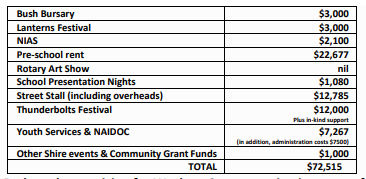
In
January 2025, a discussion with a representative of the Lanterns Festival
provided insights into the Lanterns Festival's origins and future plans. Key
points include:
1. The Lanterns Festival initially was part of the
Seasons of New England event.
2. Students in district schools create lanterns,
fostering their involvement in the festival.
3. Large lanterns are stored at a local school.
4. Approximately 200 lanterns are needed, costing
around $500.
The
festival is proposed to coincide with another event, such as the Winter
Solstice event. This will involve further discussions with Council on the
event and traffic management plans.
The
representative indicated that a revised allocation of $1000 for the Lanterns
Festival would be adequate.
Conclusion
Officers are recommending a revision of the funding of
$3,000 allocation set aside for the Lanterns Festival as follows:
1. $1000 to the
Uralla Arts Show;
2. $1000 to the
Lanterns Festival; and
3. $1000 to the
Anaiwan Elders Group.
|
Ordinary Council
Meeting Business Agenda
|
25 February 2025
|
14.11 Revised Debt
Recovery Update
|
Department:
|
Corporate & Community
|
|
Prepared By:
|
Manager Governance and
Service Centre
|
|
Authorised By:
|
General Manager
|
|
Reference:
|
UINT/25/1948
|
|
LINKAGE TO INTEGRATED PLANNING AND REPORTING FRAMEWORK
|
|
Goal:
|
4. We
are an independent shire and well-governed community
|
|
Strategy:
|
4.3. An
efficient and effective independent local government
|
Summary
Council has continued its focus on rates debtors to ensure
that rates are being paid in a timely.
Since the report to Council in October 2024, Council has
engaged the services of an external debt collection agency, SR Law. This has
resulted in a further improvement in the total amount of rates in arrears.
Since 30 June 2024 to 31 January 2025, the total amount of
rates in arrear has reduced from $1,354,550 to $682,937. This represents a
50.42% reduction in total arrears since 31 January 2025. Further improvement is
expected following the adoption and implementation of a more streamlined debt
collection process.
|
Recommendation
That Council notes the report regarding the recovery of
rates in arrears.
|
Report
As at 30 September 2024, there were 209 ratepayers in
arrears with an amount of $983,468 outstanding. The table provided to Council
at the October 2024 meeting is set out below.
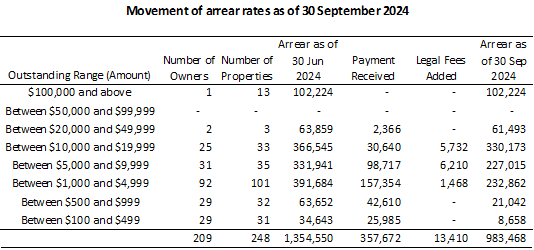
As at 31 January 2025,
there were 136 ratepayers in arrears with an amount of $682,937 outstanding.
This has resulted in an improvement of the total amount of rates in arrears by
$300,531, or 30.55%. A table summarising the figures as at 31 January 2025 is
set out below.
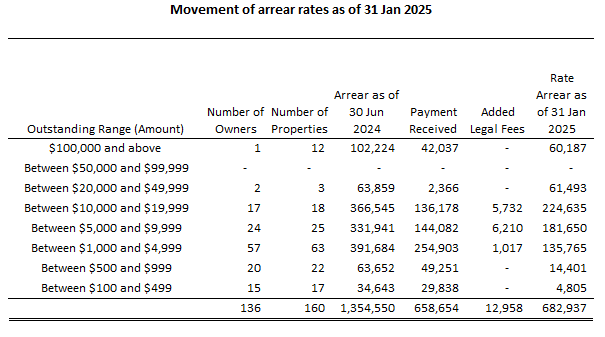
As at 30 September 2024, one ratepayer owed $102,224 on 13
properties. The ratepayer has now paid the full outstanding amount on one of
the properties, and partial payment on some of the other properties. The
ratepayer has indicated that they intend to pay the balance at the end of
February 2025 once some livestock has been sold. A balance of $60,187 is
now outstanding.
Proposed changes to the debt collection process are the
subject of a separate report to Council at this meeting. These changes
will streamline the debt collection process, and are expected to result in
improved rates recovery going forward.
Conclusion
An increased focus on debt recovery for rates in arrears has
improved the position since 30 June 2024. Further improvements in the debt
recovery process are expected to streamline the process.
Council Implications
Community Engagement/Communication
Ensuring that the community is informed on debt collection
provides transparency and equity for all ratepayers on Council’s
financial position. Ongoing positive and supportive
communication with ratepayers who have outstanding rates is important.
Policy and Regulation
Council is proposing to revise its debt recovery policy and
process to improve efficiency and to make the process clearer for staff and
ratepayers.
Financial/Long Term Financial Plan
It is important to ensure that rates are received by Council
in a timely fashion to ensure that Council operations are sustainable and
compliant with regulatory requirements.
Asset Management/Asset Management Strategy
There is a negative impact on cash flow management when
outstanding debts are not collected on time.
Workforce/Workforce Management Strategy
A new procedure for the debt
recovery is required to be implemented following the review of the debt
recovery policy.
Legal and Risk Management
The debt recovery policy has been reviewed by external
lawyers specialising in debt collection.
|
Ordinary Council
Meeting Business Agenda
|
25 February 2025
|
14.12 Debt Recovery
Policy Review and Hardship Policy Review
|
Department:
|
Corporate & Community
|
|
Prepared By:
|
Manager Governance and
Service Centre
|
|
Authorised By:
|
General Manager
|
|
LINKAGE TO INTEGRATED PLANNING AND REPORTING FRAMEWORK
|
|
1. Hardship
Policy ⇩ 
2. Draft
Debt Recovery Policy 2025 ⇩  Attachments: Attachments:
|
|
Goal:
|
4. We
are an independent shire and well-governed community
|
|
Strategy:
|
4.3. An
efficient and effective independent local government
|
Summary
A major review of the Debt Recovery Policy has been undertaken
by external legal professionals specialising in debt recovery (SR Law). The
changes to the Debt Recovery Policy will provide:
· clear and consistent
processes for ratepayers, Council staff, and external agencies;
· enhanced communication
and engagement with ratepayers to avoid escalation;
· a more streamlined and
efficient debt recovery process; and
· an improved framework
that aligns with legal and financial sustainability goals.
The revised Debt Recovery Policy ensures Council meets its
statutory requirements while prioritising equity, transparency, and financial
hardship considerations. This policy also refers to the Hardship Policy.
A minor review of the Hardship Policy was also undertaken by
SR Law. They concluded that the existing policy remains robust, equitable, and
compliant with statutory requirements. Therefore, no substantive changes to the
Hardship Policy are recommended. Minor changes include updating references to
legislation, position descriptions and to update the layout of the revised
policy into the revised policy format. Ongoing review of the Hardship
Policy by officers is planned to ensure it continues to respond sensitively to
community need and economic pressures while ensuring sound recovery provisions
for Council.
|
Recommendation
That Council:
1. Endorses
the revised Debt Recovery Policy and revised Hardship Policy for public
exhibition for 28 days.
2. Receives
a further report on completion of the exhibition period should any
submissions be received and/or changes proposed.
3. Adopts
the revised Policies should no submissions be received or changes proposed.
|
Report
Council’s Debt
Recovery Policy deals with debts relating to rates and charges, and sundry
debts. These are dealt with separately as under the Local Government Act
1993 (‘LG Act’), there are different debt recovery processes
that are followed when taking steps to recover outstanding rates and charges,
as compared to sundry debts.
Rates and charges
– current process
Council’s current
Debt Recovery Policy requires that Council undertake the following steps for
outstanding rates and charges:
|
Date
|
Event
|
|
31 Jul
|
Rates Notice issued by Council
(aka 1st instalment notice)
|
|
31 Aug
|
1st Instalment
falls due
|
|
15 Sep
|
Council issues reminder notice
for any amounts >=$100 (due 29 Sep)
|
|
30 Sep
|
Council issues 2nd
reminder notice (due 14 October)
|
|
15 Oct
|
Council refers debts >= $1,000
and for which 2 instalments remain outstanding to debt recovery
agency
|
|
16 Oct
|
Debt recovery agency issues
demand letters (due 30 Oct)
|
|
23 Oct
|
Debt recovery agency makes phone
or email demand
|
|
30 Oct
|
2nd instalment
notice issued by Council
|
|
30 Oct
|
Debt recovery agency sends to
Council list for filing Statement of Claim (‘SoC’)
|
|
3 Nov
|
Council instructs debt recovery
agency with list to file SoC’s
|
|
7 Nov
|
Debt recovery agency files and
serves SoC’s
|
|
14 Nov
|
Debt recovery agency issues
judgment warning letters
|
|
28 Nov
|
Debt recovery agency sends list
to Council for default judgment and enforcement
|
|
30 Nov
|
2nd Instalment
falls due
|
|
1 Dec
|
Council instructs debt recovery agency
to file for default judgment and enforcement
|
|
2 Dec
|
Debt recovery agency issues
default judgments
|
|
3 Dec
|
Debt recovery agency commences
enforcement
|
The debt recovery process for overdue rates is lengthy and extends
into the next instalment period, as instalments are spaced about three months
apart. The above timeline does not account for delays in referring cases to the
debt recovery agency or the time that they spend awaiting Council’s
instructions for complex matters.
As a result, ratepayers may receive Council correspondence
about overdue rates for the next instalment while the debt recovery agency
pursues payments from the previous period, causing confusion.
For Council staff, this process is inefficient, requiring
two reminder notices to be issued by them which adds to the workload of the
small finance team. Tracking referrals is also complex, as staff must confirm
that two instalments are overdue, and the total exceeds $1,000 before referring
the debt to the external debt recovery agency.
Rates and charges – proposed process
The revised Debt Recovery Policy proposes to shorten the
recovery process and to change the criteria of debts that are referred to the
debt recovery agency.
The proposed process is outlined below and uses the first
instalment as an example.
|
Date
|
Event
|
|
31 Jul
|
Rates Notice issued by Council
(aka 1st instalment notice)
|
|
31 Aug
|
1st Instalment
falls due
|
|
15 Sep
|
Council issues reminder notice
for any amounts >=$100 (due 29 Sep)
|
|
30 Sep
|
Council refers debts >= $1,000
to debt recovery agency
|
|
1 Oct
|
Debt recovery agency issues
demand letters (due 15 Oct)
|
|
8 Oct
|
Debt recovery agency makes phone
or email demand
|
|
16 Oct
|
Debt recovery agency sends to
Council list for filing Statement of Claim (‘SoC’)
|
|
20 Oct
|
Council instructs debt recovery
agency with list to file SoC’s
|
|
21 Oct
|
Debt recovery agency files and
serves SoC’s
|
|
30 Oct
|
2nd instalment
notice issued by Council
|
|
4 Nov
|
Debt recovery agency issues
judgment warning letters
|
|
19 Nov
|
Debt recovery agency sends list
to Council for default judgment and enforcement
|
|
21 Nov
|
Council instructs debt recovery
agency to file for default judgment and enforcement
|
|
24 Nov
|
Debt recovery agency issues
default judgments
|
|
25 Nov
|
Debt recovery agency commences
enforcement
|
|
30 Nov
|
2nd Instalment
falls due
|
The benefit of the revised debt recovery process is that it
is simpler and easier to manage. The Council officer only needs to send one
reminder letter to the ratepayer for any amount outstanding that is more than
$100. Then, if there are any debts in arrears of more than $1,000 that are
overdue 14 days after the rate or charge falls due, it can then be referred to
the debt recovery agency. The officer does not need to confirm that two
reminder notices have been sent, and that the debt relates to two or more
instalment periods. Presently it is difficult for Council’s finance
officer to confirm all of these variables as there is no simple report to confirm
these details.
The recovery process once it has been referred to the debt
recovery agency is primarily the same as it was in the current Debt Recovery
Policy.
Payment arrangements
At any time, ratepayers can enter into payment arrangements
with Council for their outstanding rates.
Under the LG Act, Council has the authority to make payment
arrangements with ratepayers for overdue rates and charges. These arrangements
provide flexibility for ratepayers facing financial difficulties while ensuring
councils can recover outstanding debts.
Eligibility and Structure
· Council
allows weekly, fortnightly, or monthly payment schedules.
· Payment
arrangements should, where possible, clear outstanding amounts by 30 June of
the current financial year in which the debt is owed.
· If
this is not feasible, the arrangement should aim to settle the debt within 12
months of approval.
· Ratepayers
unable to meet this timeframe may be referred to the Council’s Hardship
Policy for further assistance.
Short-Term Extensions vs. Formal Agreements
· Council
may approve short extensions for payment.
· Longer
arrangements (over three months) must be documented in writing, with formal
confirmation sent to the ratepayer.
Interest on Overdue Amounts (s 566 of the LG Act)
· Interest
continues to accrue on overdue balances, even under a payment plan.
· Payments
are applied to the oldest outstanding rates and charges first (s 568 of the LG Act).
Defaulting on Arrangements
· If
a ratepayer defaults twice, the payment arrangement is cancelled, and debt
recovery actions resume.
· If
the outstanding debt exceeds $1,000, the account may be referred to a debt
collection agency.
Hardship Policy
The Hardship Policy provides a framework for assessing and
supporting ratepayers and customers experiencing genuine financial hardship. It
applies to applications for waivers, deferments, alternative payment
arrangements, or the writing-off of rates, annual charges, water charges, and
accrued interest.
Hardship may arise from circumstances such as illness, loss
of income, natural disasters, or family crises. Applicants must complete a
Financial Hardship Relief Application Form and provide supporting
documentation, such as bank statements or letters from financial or medical
professionals. Council does not reduce rates or annual charges but may approve
periodical payment plans or waive accrued interest if payment would cause
hardship.
Payment arrangements must generally ensure debts are cleared
by 30 June of the financial year, with exceptions considered under extenuating
circumstances. Council may also write off accrued interest for first-time
defaulters, those with serious illness, or those complying with an approved
payment plan.
The General Manager has discretion to waive amounts up to
$1,000, while larger amounts require a Council resolution. A Payment Assistance
Panel reviews hardship applications and appeals, ensuring decisions align with
social justice principles and statutory requirements. All hardship applications
are treated confidentially, and applicants are notified of decisions within 30
days.
Sundry debts
The debt recovery process for sundry debts, such as fees for
a service, generally follow the same process as for rates and charges. The main
difference is that if an account is not paid by the due date and an account has
amounts that are 60 days in arrears, Council may refer the account to its debt
collection agency. For accounts which have amounts overdue but for which
the balance is less than $300, Council staff will continue to contact account
holders at reasonable intervals to attempt recovery.
Conclusion
The proposed revisions to Council’s Debt Recovery
Policy aim to create a more efficient, streamlined process for managing overdue
rates and charges. By reducing the number of reminder notices and simplifying
the referral criteria for debt recovery, the changes will alleviate
administrative burdens on Council staff while maintaining a fair and structured
approach to debt collection.
Additionally, the continued emphasis on payment arrangements
and the Hardship Policy ensures that ratepayers experiencing financial
difficulties have access to support mechanisms that balance flexibility with
Council’s need to recover outstanding debts. The revised process
ultimately enhances efficiency, minimises confusion for ratepayers, and ensures
Council’s financial sustainability while upholding social responsibility.
Council Implications
Community Engagement/Communication
Ensuring that the community is informed on debt recovery
provides transparency and equity for all ratepayers on Council’s
financial position. Ongoing positive and supportive
communication with ratepayers who have outstanding rates is important.
Policy and Regulation
Council will continue to revise its debt recovery policy and
process to improve efficiency and to make the process clearer and sensitive to
ratepayer needs.
Financial/Long Term Financial Plan
It is important to ensure that rates are received by Council
in a timely fashion to ensure that Council operations are sustainable and
compliant with regulatory requirements.
Asset Management/Asset Management Strategy
There is a negative impact on cash flow management when
outstanding debts are not collected on time.
Workforce/Workforce Management Strategy
A new procedure for the debt
recovery is required to be implemented following the review of the debt
recovery policy.
Legal and Risk Management
The debt recovery policy has been reviewed by external
lawyers specialising in debt recovery.
|
Ordinary Council Meeting Business Agenda
|
25 February 2025
|
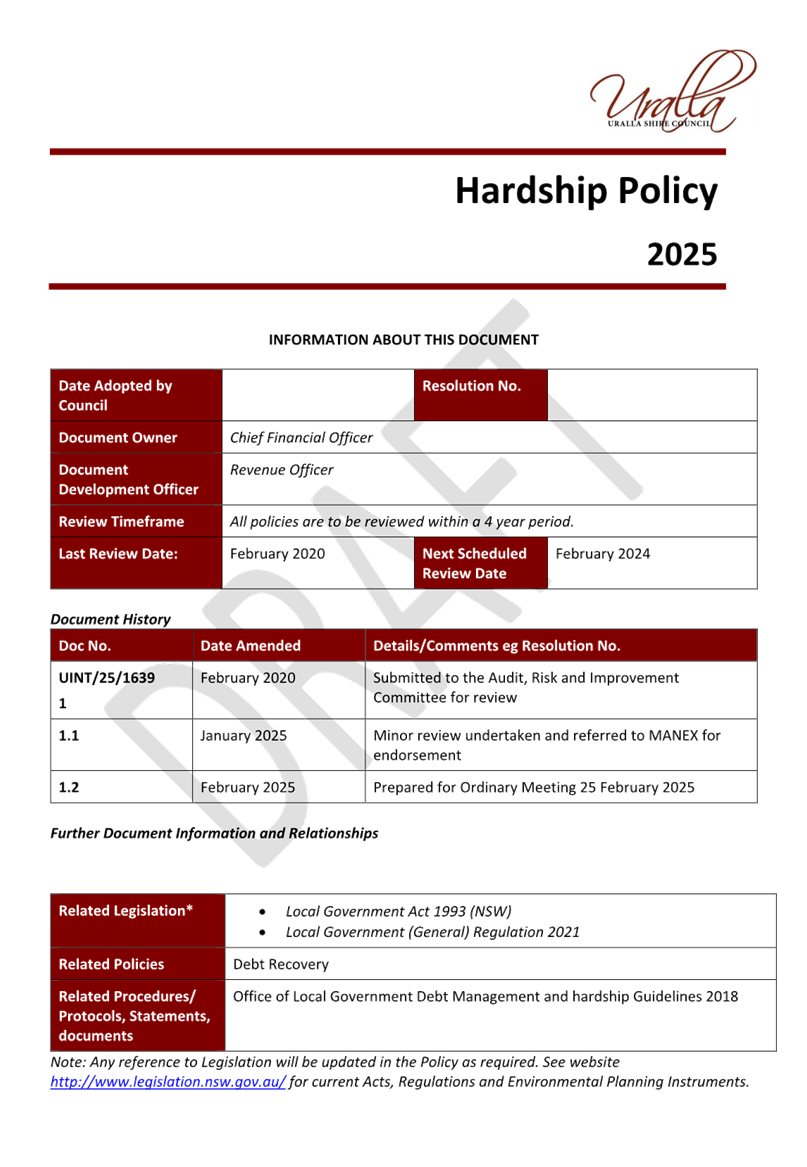
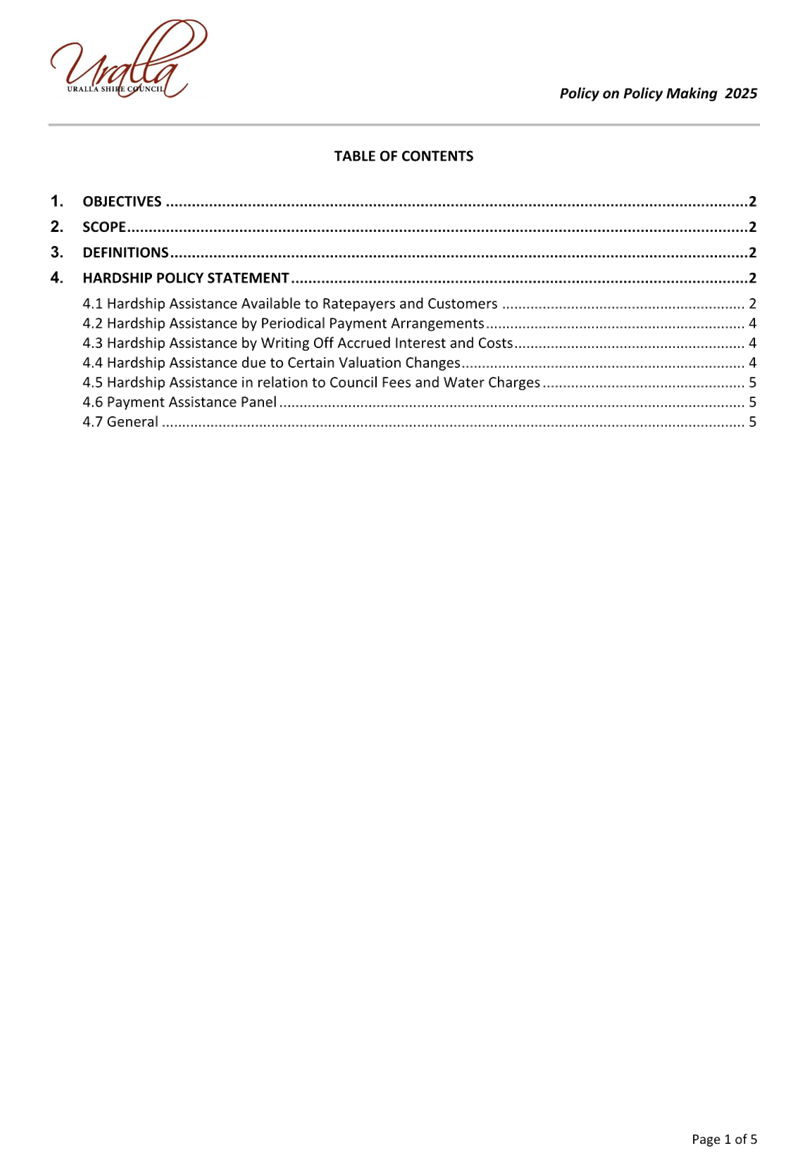
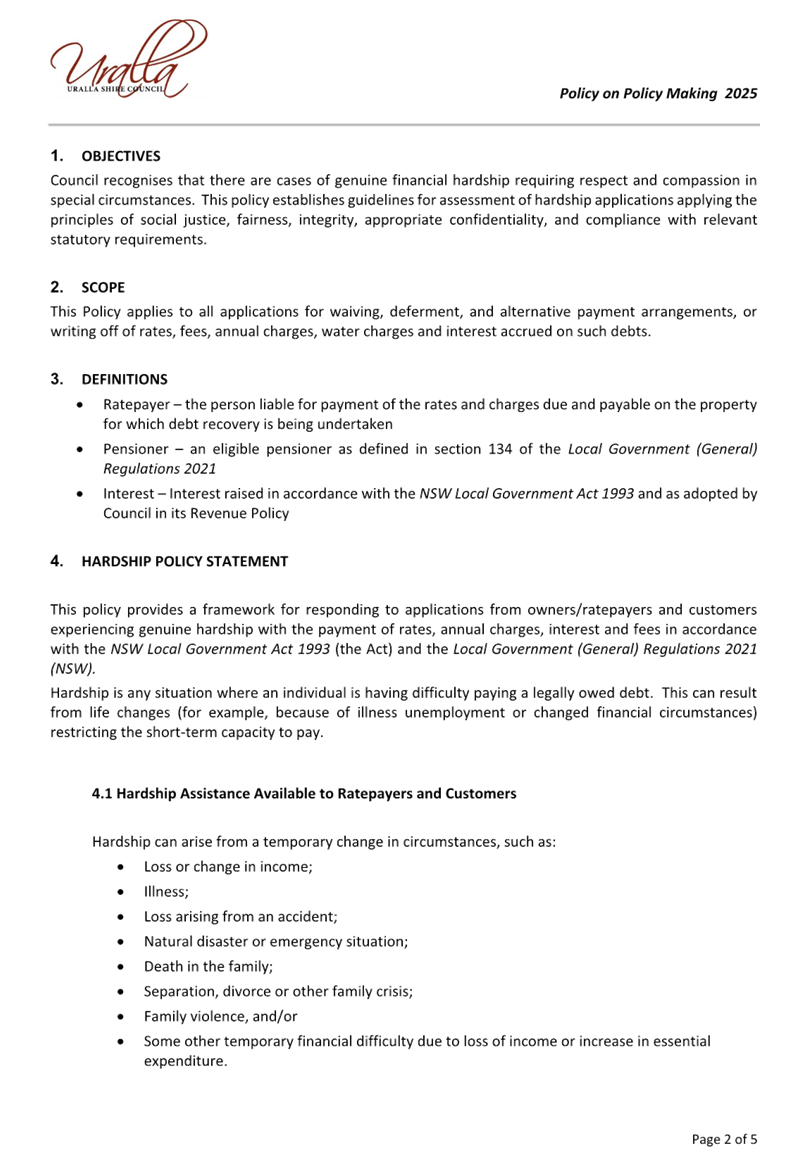
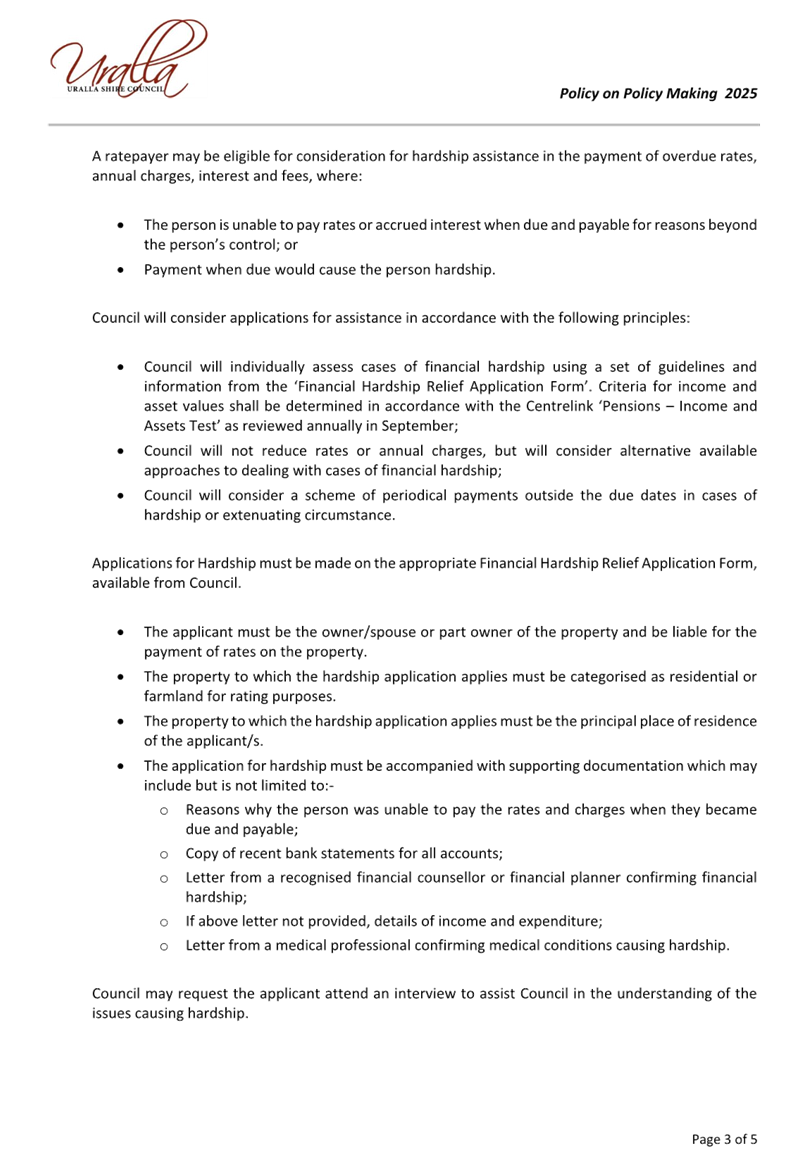
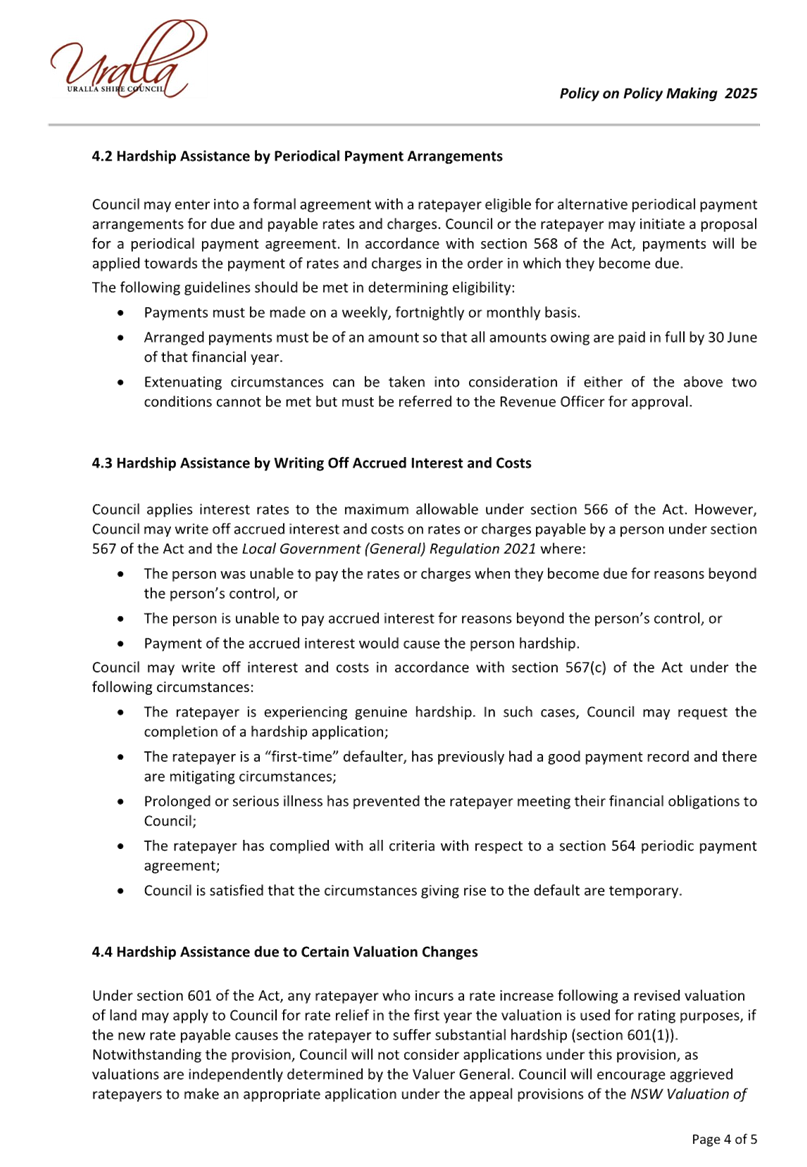
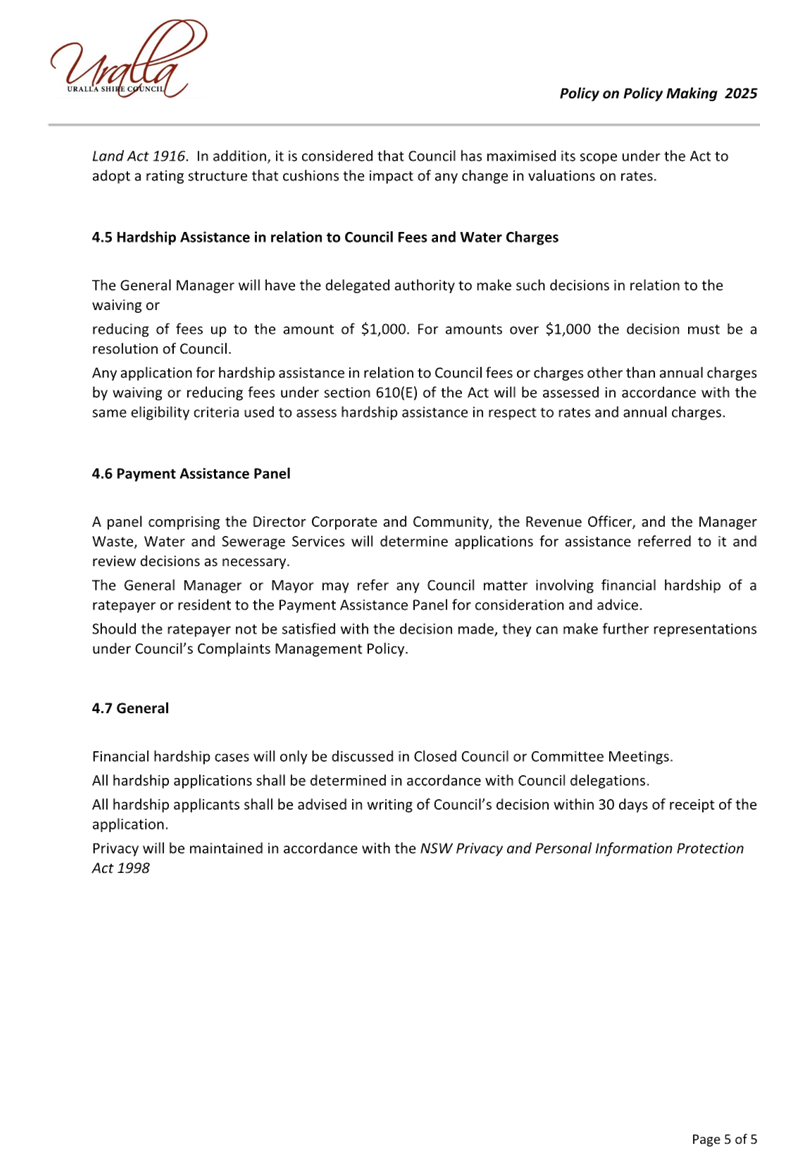
|
Ordinary
Council Meeting Business Agenda
|
25 February 2025
|
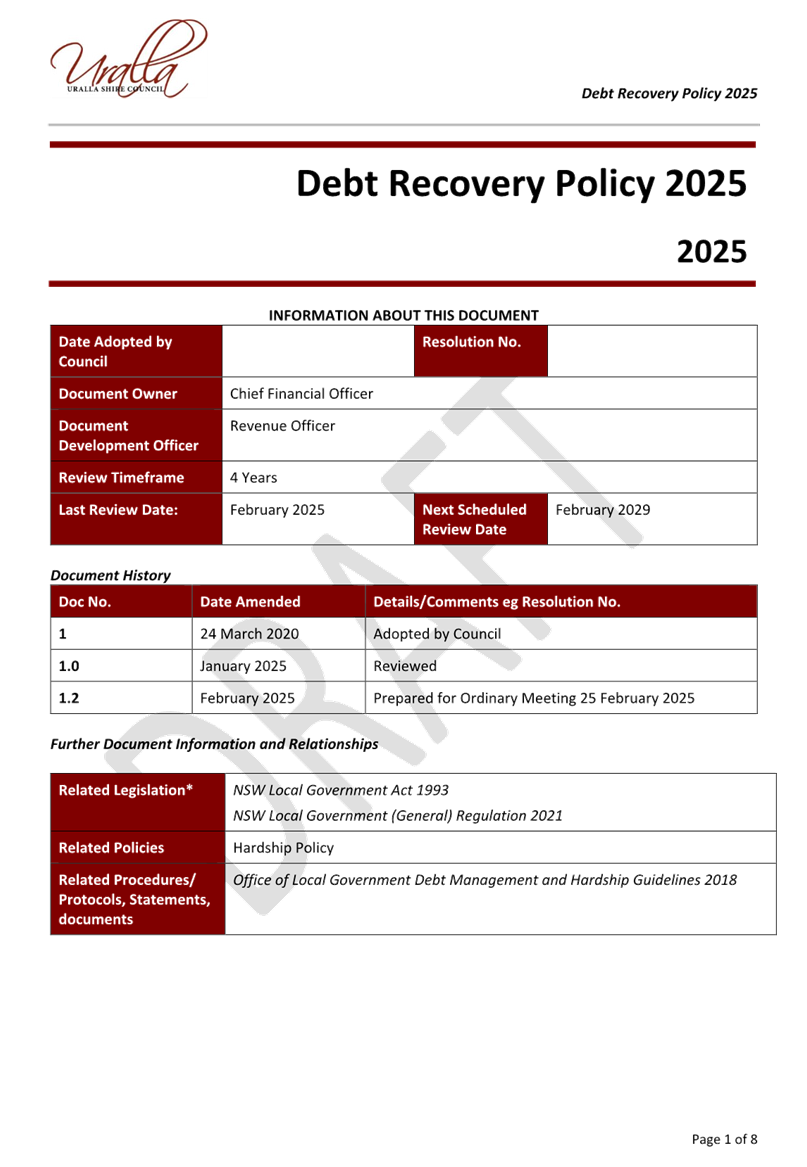
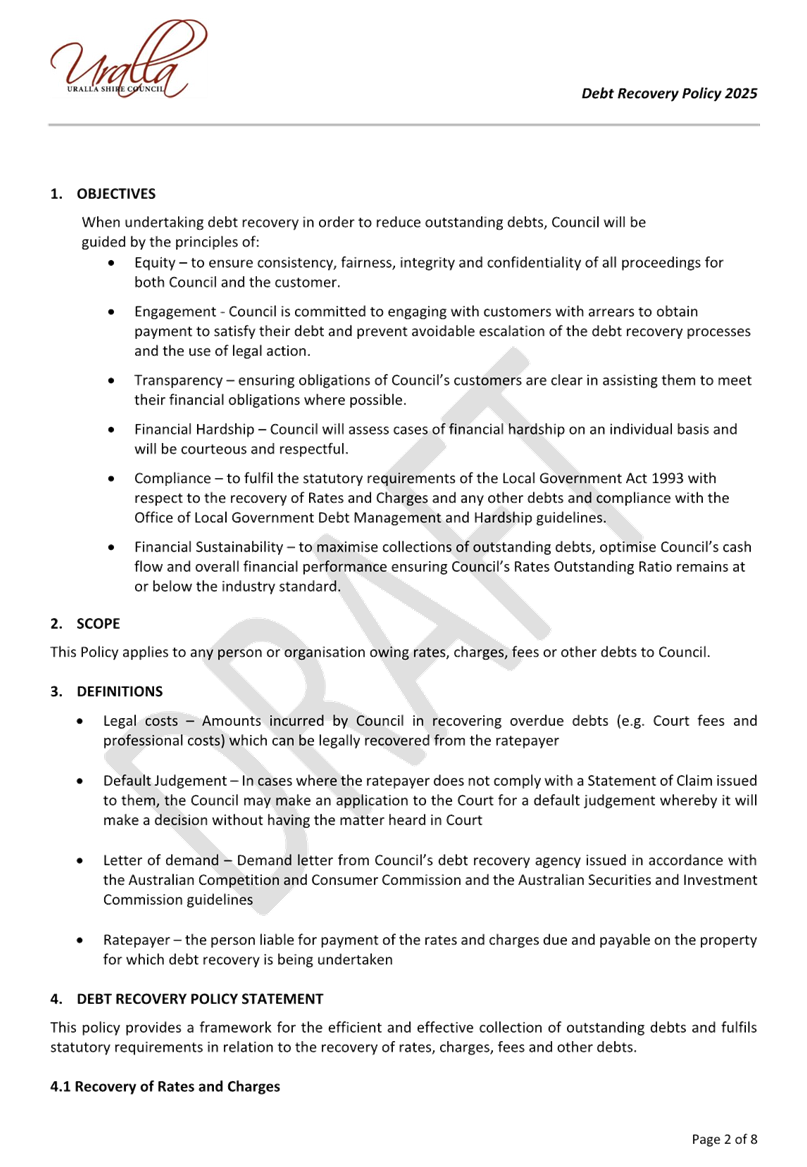
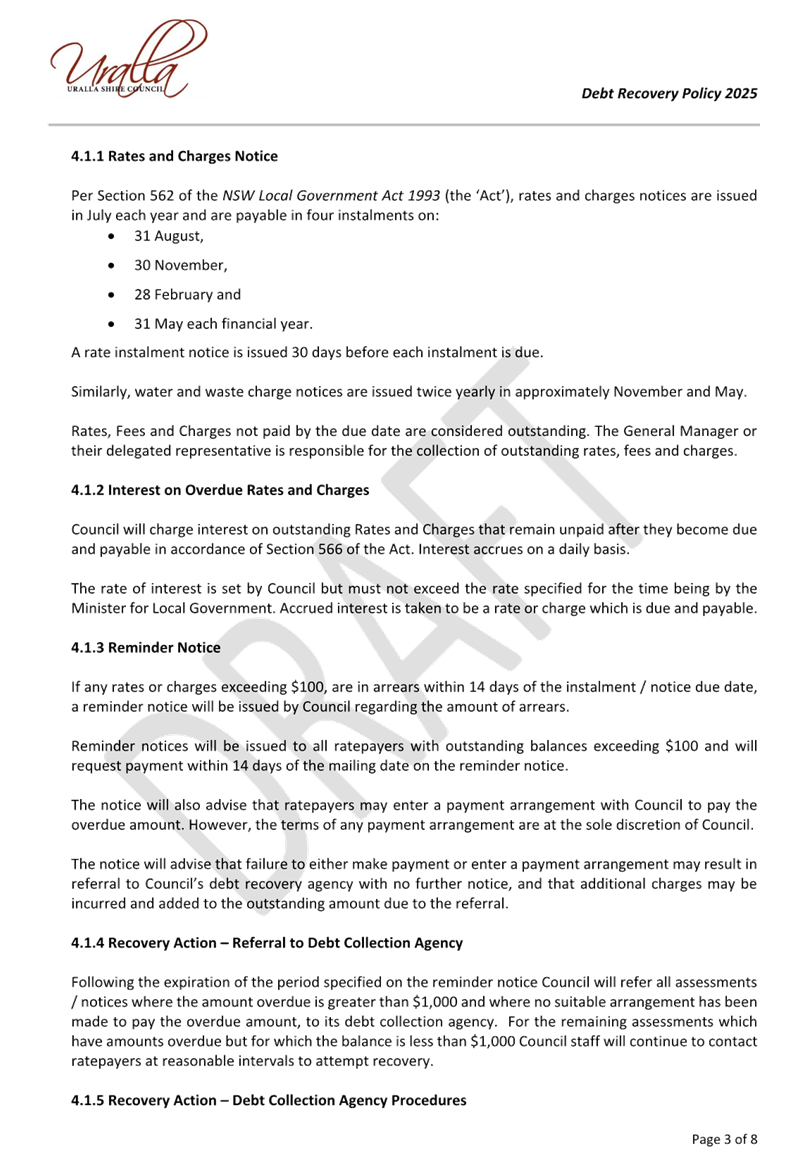
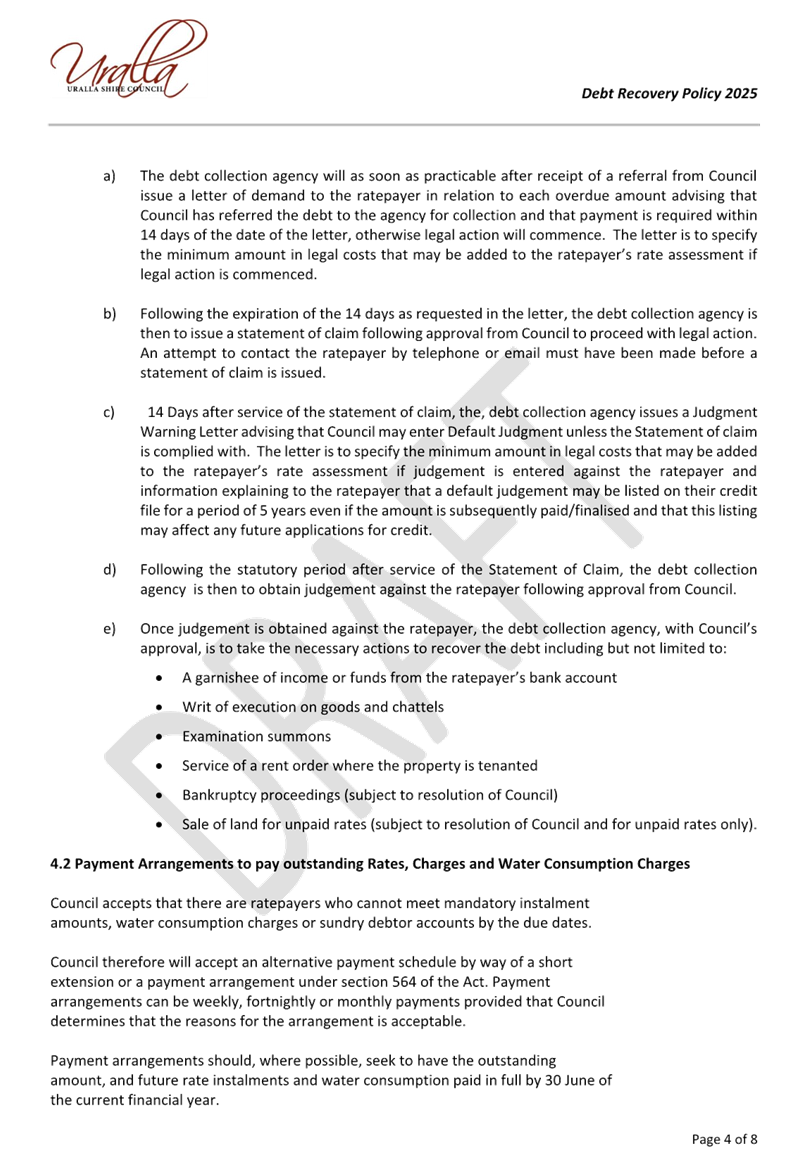
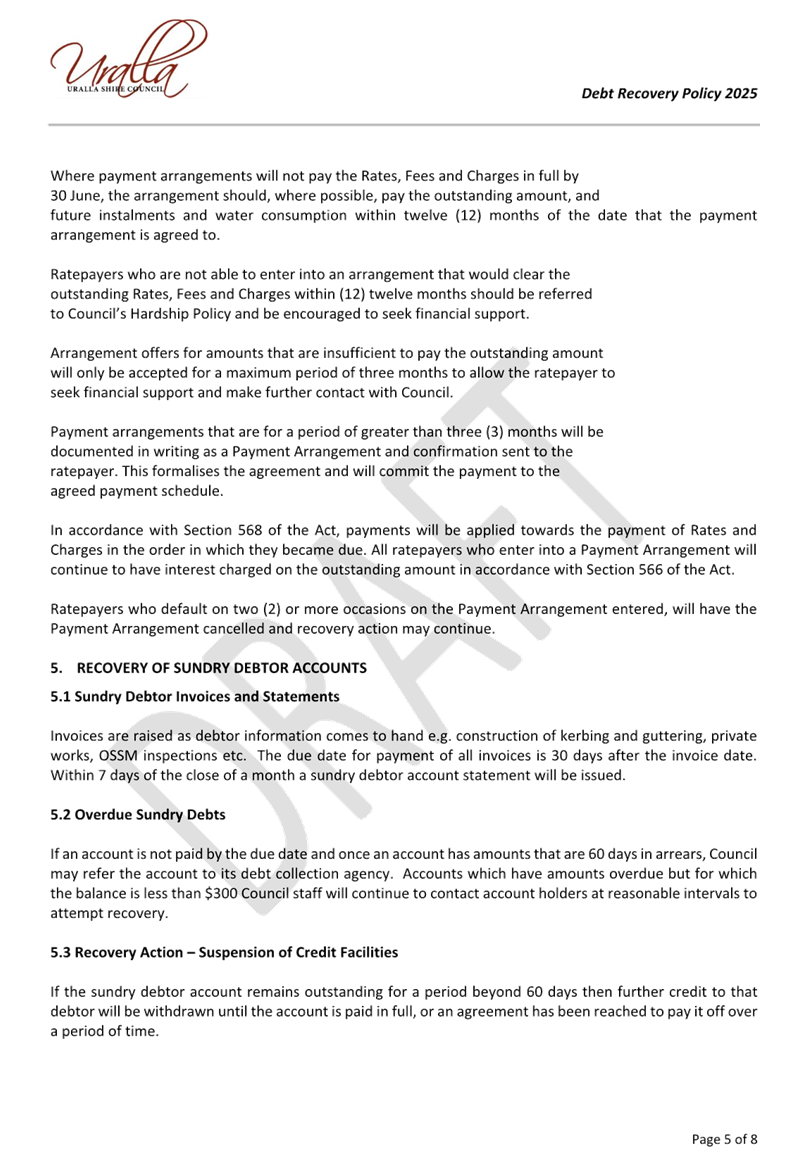
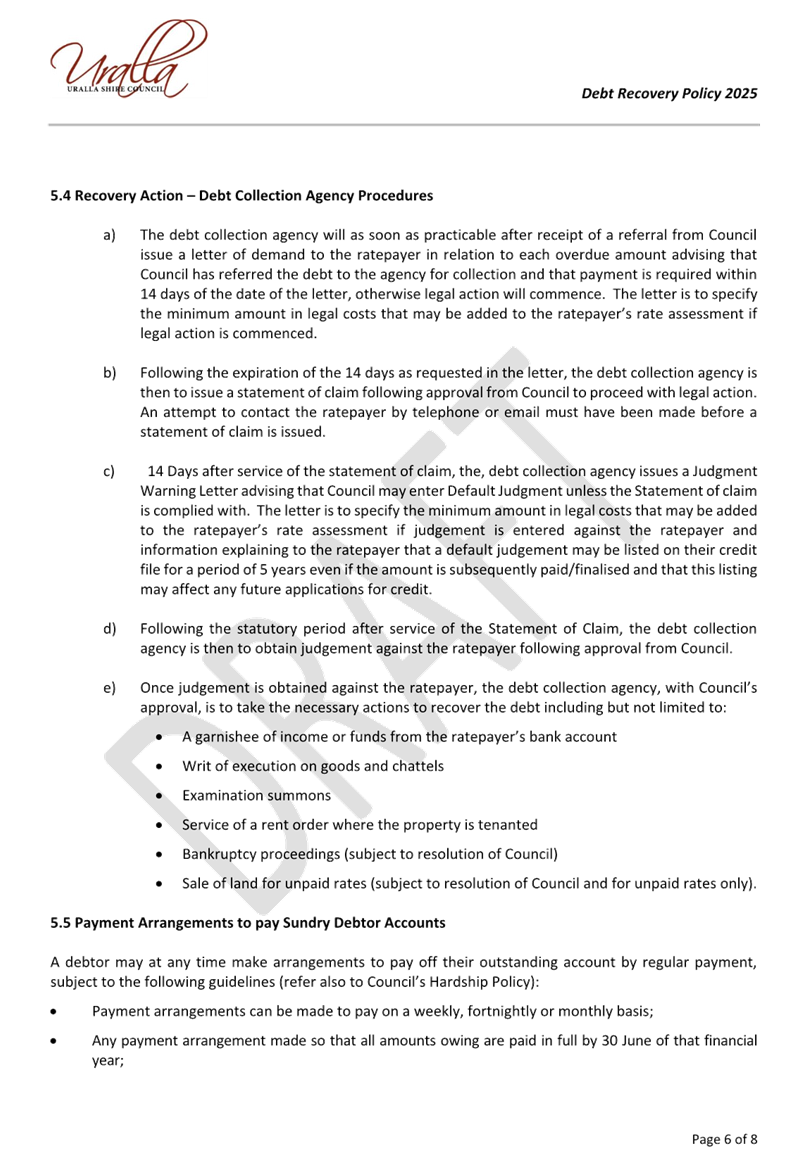
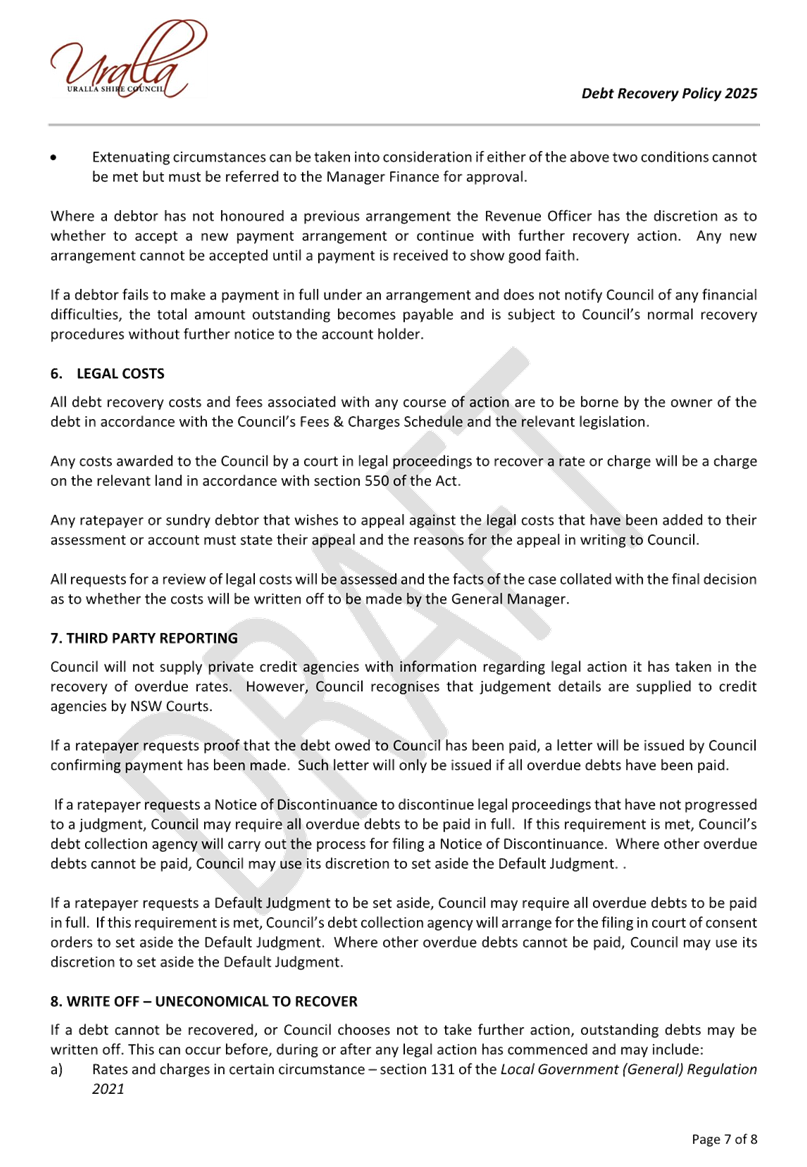
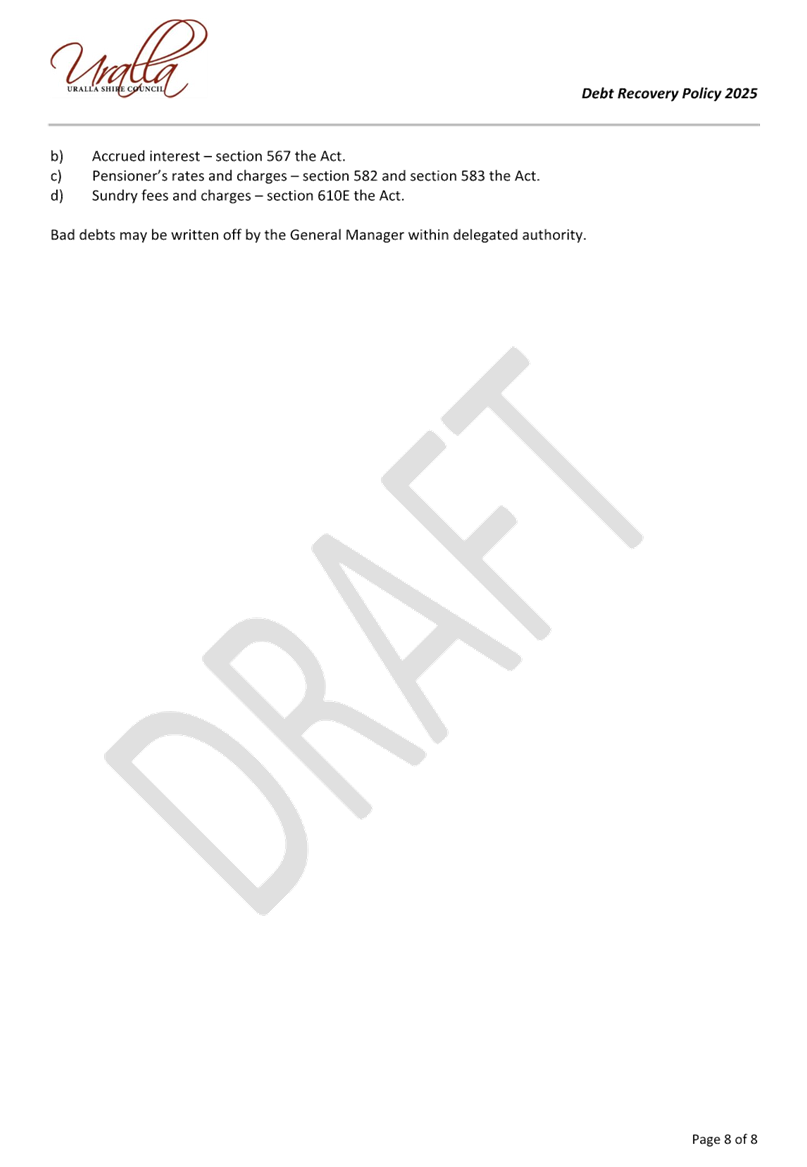
|
Ordinary Council
Meeting Business Agenda
|
25 February 2025
|
14.13 Policy on
Policy Making
|
Department:
|
Corporate & Community
|
|
Prepared By:
|
Manager Governance and
Service Centre
|
|
Authorised By:
|
General Manager
|
|
Reference:
|
UINT/24/20367
|
|
Attachments:
|
1. DRAFT
- Policy on Policy Making ⇩ 
|
|
LINKAGE TO INTEGRATED PLANNING AND REPORTING FRAMEWORK
|
|
Goal:
|
4. We
are an independent shire and well-governed community
|
|
Strategy:
|
4.2. A
strategic, accountable and representative Council
4.3. An
efficient and effective independent local government
|
Summary
A Policy on Policy Making establishes Uralla Shire
Council’s standards for developing and reviewing policies to ensure
consistency, high quality, and accessibility of policy documents for Council
Officers and the community. It aims to enhance transparency, governance, and
risk management by providing clear guidelines for all policy-related
activities.
|
Recommendation
That Council:
1. Endorses the
Policy on Policy Making for public exhibition for 28 days.
2. Receives a
further report on completion of the exhibition period should any submissions
be received and/or changes proposed.
3. Adopts the
Policy should no submission be received or changes proposed.
|
Report
The Policy on Policy Making (‘Policy’) outlines
the objectives and principles for policy development and review within Uralla
Shire Council, ensuring that policies are high quality, compliant with
legislation, and easily accessible by both Council Officers and the public. The
Policy sets standards to guide the creation of both internal and external
policies, aiming for consistency and clarity in the documentation process.
Key Highlights of the Policy:
1. Purpose of Policy Development
The Policy’s purpose is to establish broad guidance for Council
decision-making, ensure compliance with statutory requirements, and support
operational objectives. Policies may be developed in response to specific risks
or circumstances, and Council will adopt relevant NSW Government policies where
appropriate, instead of duplicating legislation.
2. Policy Adoption
Policies are classified as either External (impacting the community or
Councillors) or Internal (guiding internal Council operations).
o External
Policies require a public exhibition period of at least 28 days, with
documents made available online and in physical copies at Council's
Administration Centre and libraries.
o Internal
Policies undergo review and adoption within relevant Council committees
like MANEX (Managers and Executive staff) before being implemented.
3. Policy Review
o All
Policies are reviewed at least once every Council term or more frequently if
required by legislative or organisational needs.
o Minor
Policy reviews (administrative changes, minor updates, or legislative
alignment) can be made without re-adoption, but must be submitted to MANEX for
endorsement.
o Major
Policy reviews (substantive changes) follow the full adoption process as
outlined for new policies.
4. Consultation and Communication
o Draft
External Policies are publicly exhibited for a minimum of 28 days, and
community feedback is actively solicited during this time.
o The
community can submit feedback through Council’s website or at
Council’s Administration Centre and library branches.
5. Enforcement
Breaches of policies may lead to consequences under Council’s Model Code
of Conduct, ensuring compliance with both statutory requirements and internal
procedures.
Roles and
Responsibilities:
· Council
Officers, including Councillors and staff, are responsible for adhering to the
policies and participating in their development and review.
· The
Manager, Governance and Service Centre will oversee the implementation of this
policy, maintain the policy register, facilitate policy reviews, and ensure the
public exhibition process is conducted as required.
Conclusion
Council is invited to endorse the Policy on Policy Making
and recommend its progress to public exhibition. Alternatively, suggestions for
amendments may be provided before proceeding.
Council Implications
Community Engagement/Communication
The Policy on Policy Making will undergo a public exhibition
period of 28 days, providing the community with an opportunity to offer
feedback. This ensures transparency and active community involvement in the
policy development process.
Policy and Regulation
Compliance with various legislative frameworks, including
the Local Government Act 1993 (NSW), Government Information
(Public Access) Act 2009 (NSW), and the Privacy and Personal
Information Protection Act 1998 (NSW).
Financial/Long Term Financial Plan
Nil.
Asset Management/Asset Management Strategy
Nil.
Workforce/Workforce Management Strategy
This new Policy will improve understanding among employees,
particularly subject matter experts and policy owners, about their
responsibilities in the policy development and review cycle. The Policy also
encourages upskilling and training.
Legal and Risk Management
The Policy mitigates legal and operational risks by
establishing a controlled process for policy development, ensuring that all
documents undergo multiple levels of review and meet legislative requirements.
Performance Measures
The Policy's implementation will be tracked through specific
Operational Plan Action Items, with progress reported to Council on a regular
basis.
Project Management
The Policy Register will be maintained by the Manager,
Governance and Service Centre, who will coordinate relevant project teams for
policy reviews as required.
|
Ordinary Council Meeting Business Agenda
|
25 February 2025
|
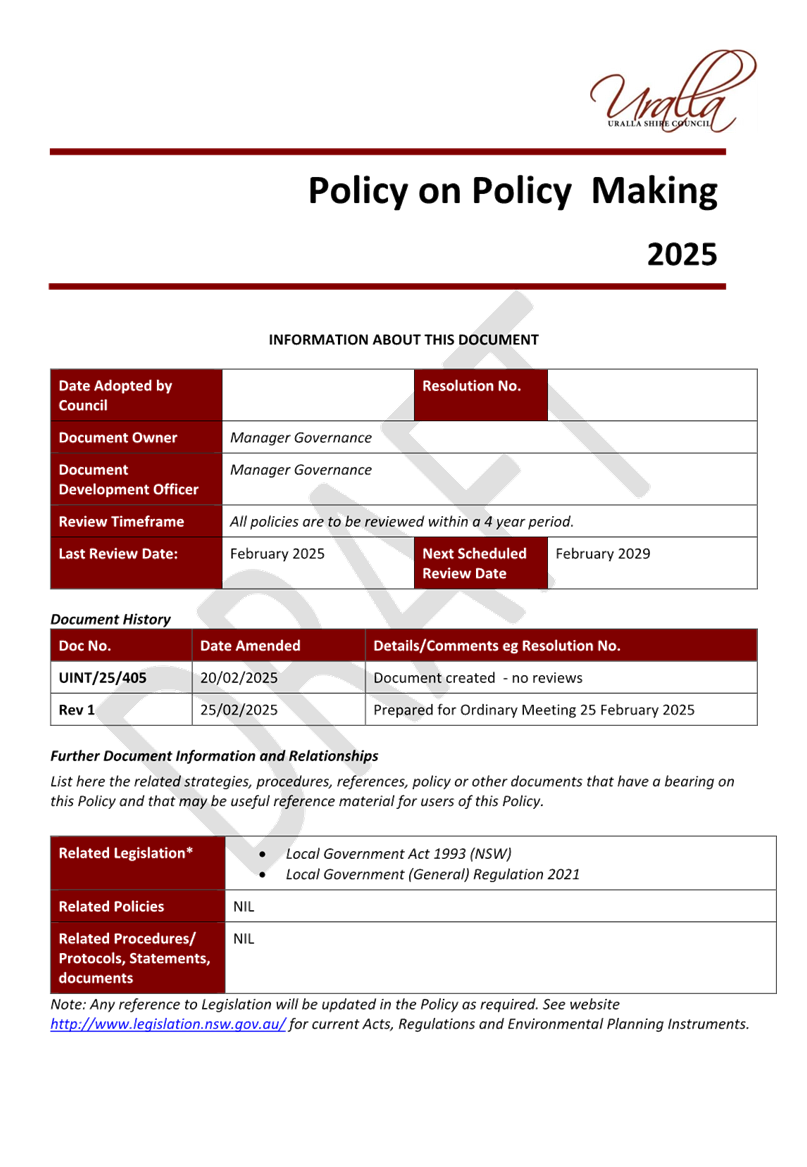
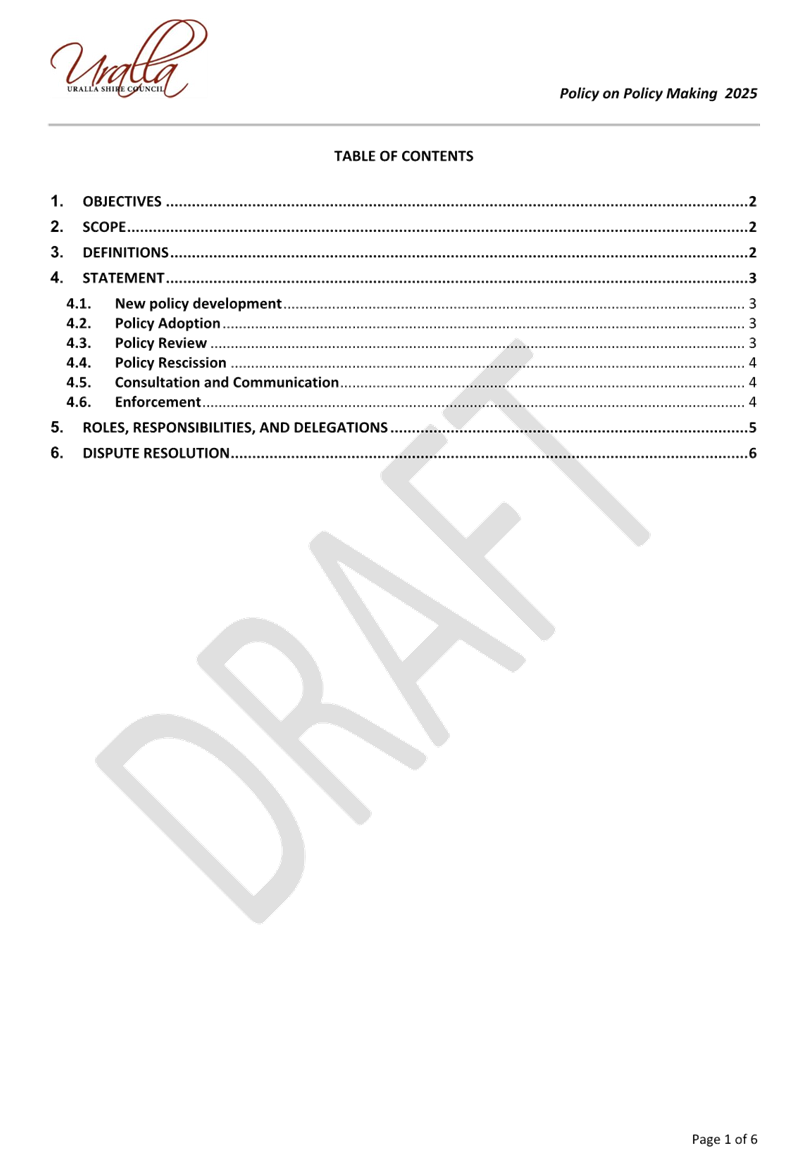
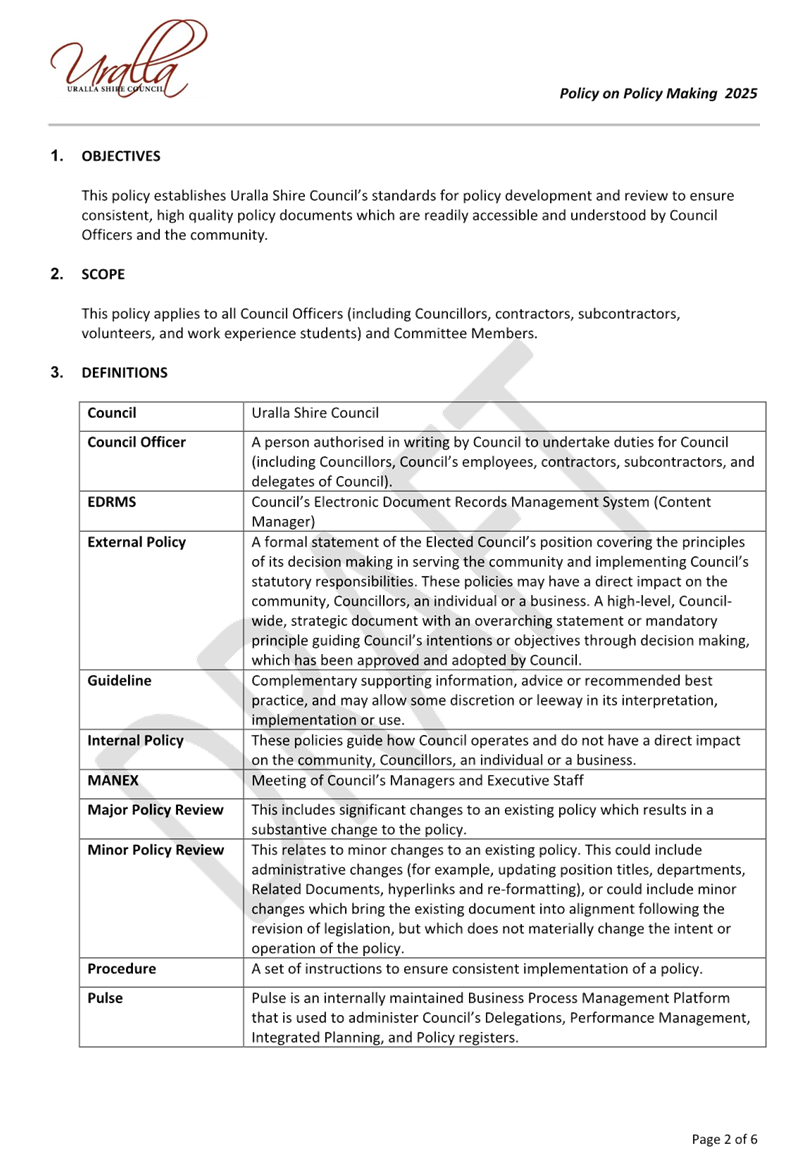

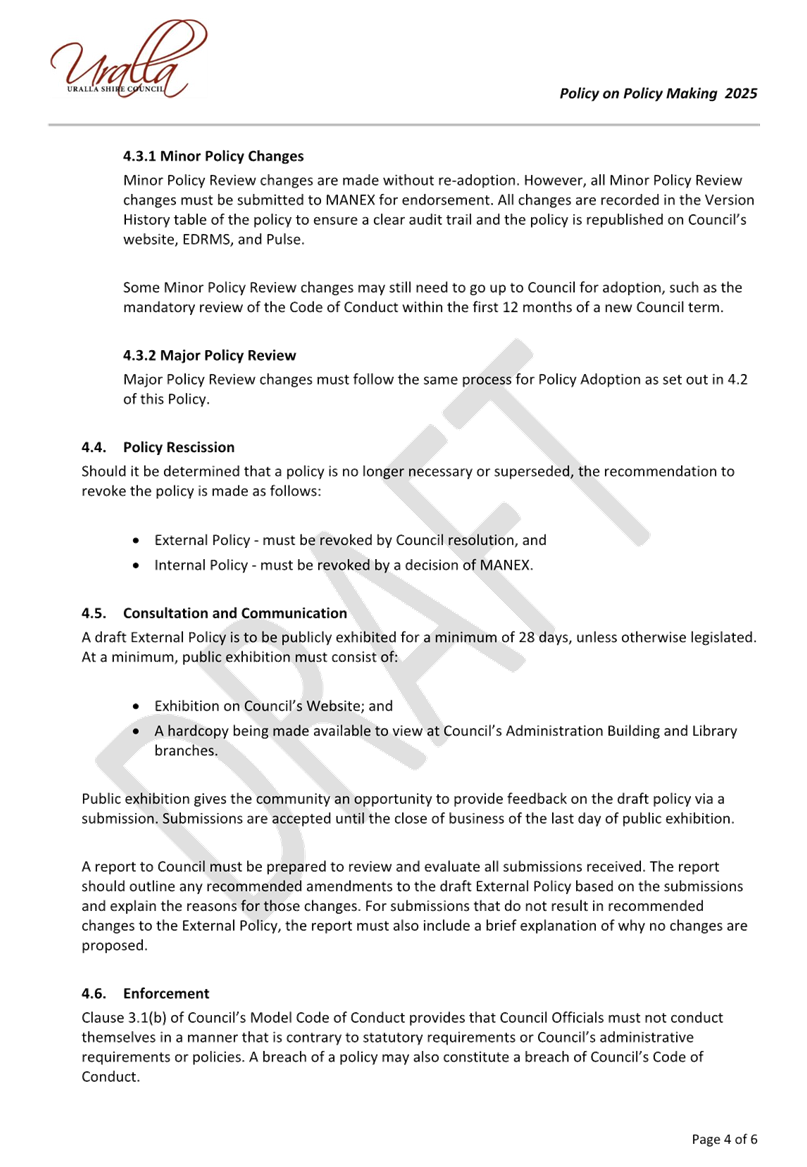
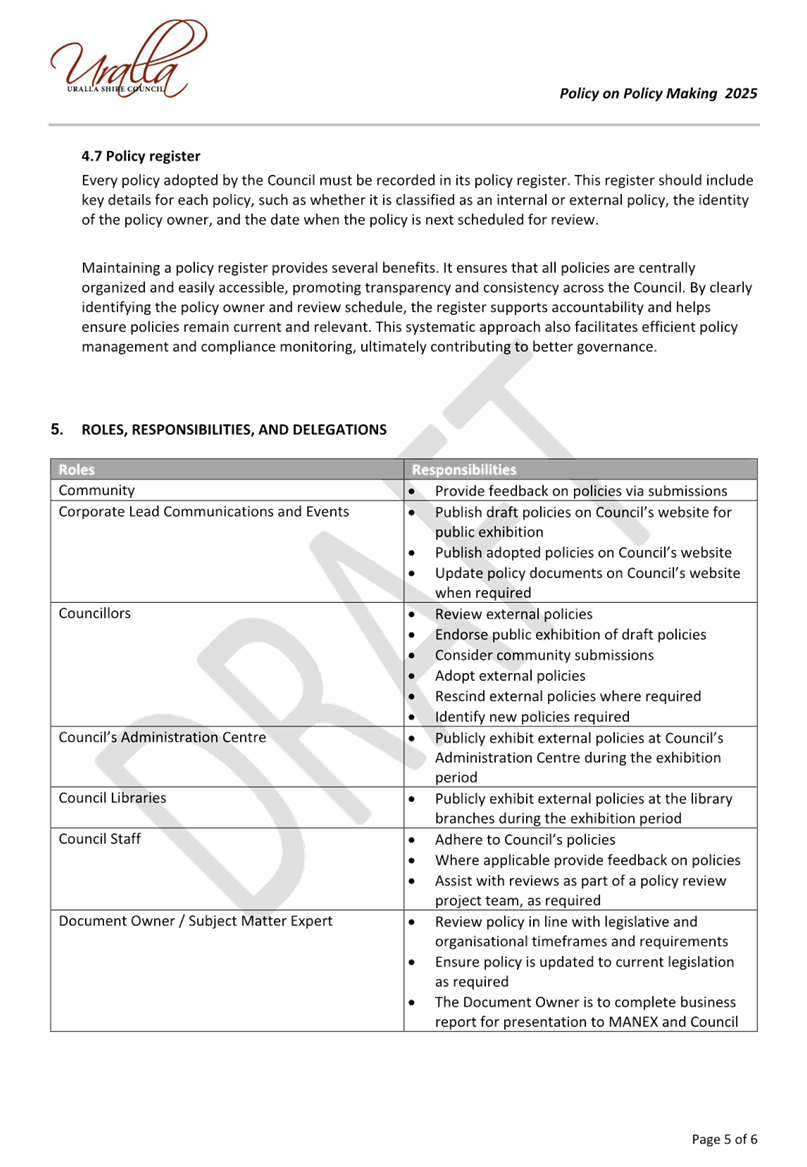

|
Ordinary Council Meeting Business Agenda
|
25 February 2025
|
14.14 Quarterly
Budget Review December 2024-25 (QBRS)
|
Department:
|
Corporate & Community
|
|
Prepared By:
|
Manager Finance
|
|
Authorised By:
|
General Manager
|
|
Reference:
|
UINT/25/2396
|
|
Attachments:
|
1. 2024-25
QBRS 2 Combined Report ⇩ 
|
|
LINKAGE TO INTEGRATED PLANNING AND REPORTING FRAMEWORK
|
|
Goal:
|
4. We
are an independent shire and well-governed community
|
|
Strategy:
|
4.3. An
efficient and effective independent local government
|
Summary
The purpose of this report is to present to Council a review
of the budget for the second quarter of the 2024/25 financial year.
|
Recommendation
That Council:
1. Receives
and notes the second quarter budget review summary for the 2024/25 financial
year; and
2. Adopts
the adjustments to budget allocations.
|
BACKGROUND:
It is a statutory requirement that Council’s
Responsible Accounting Officer prepares and submits a budget review statement
to Council on a Quarterly basis each financial year (LGGR 2005 cl.203 (1)).
Also, in compliance with the Local Government (General) Regulation,
Council’s Responsible Accounting Officer must include with the budget
review report an opinion on the financial position of Council and any
recommendations for remedial action if required. As such the second quarterly
review for the 2024/25 financial year has been prepared and is attached for
Council’s review.
Report
The
original budget for the 2024-25 financial year projected a negative operating
result before considering grants for capital purposes and accounting for
depreciation and amortisation. However, following adjustments in QBR1 and QBR2,
the year-end operating result now indicates even further decline in the
negative results. The table below provides a quick overview of the budget
adjustments.
|
Particulars
|
Original
Budget
|
Budget
with QBR1 Revisions
|
Proposed
budget with QBR2
|
|
Operating results ‐
before capital grants & depreciation
|
4,646
|
4,833
|
4,369
|
|
Operating results ‐
after depreciation
|
(1,703)
|
(2,514)
|
(2,978)
|
|
Overall results ‐ with
capital grants
|
3,747
|
3,253
|
1,069
|
|
Net cash flow for the year
|
(2,261)
|
(2,074)
|
(2,806)
|
ISSUES
The first quarter quarterly
budget review reported a positive revenue of $960k, while expenses totalled
$1.4 million, including $1.0 million for depreciation. The largest adjustment
in depreciation was for tip remediation assets.
The
second quarterly budget review proposes a negative adjustment of $130k to
revenue, a $563k increase in expenses, a $1.7 million decrease in grant funding
for capital works, and a $1.6 million reduction in capital expenses, with overall
negative impact of $741k.
Tablelands Community Services (TCS) and
Tablelands Community Transport (TCT)
The major adjustment in this quarter comes
from Tablelands Community Services (TCS) and Tablelands Community Transport
(TCT), which resulted in a negative adjustment of $795k resulting from the
following:
· Not meeting the
target number of home care package services;
· Exceeding the
forecast budget for contractor costs for client services; and
· Not delivering the projected
number of transport services.
This
budget adjustment is regrettable, and while there are a number of contributing
factors, the focus now is on undertaking a detailed internal review process and
deep dive financial analysis to better understand the business model. The
objective is to review all aspects of the business functions to identify
opportunities to increase revenue recovery, recover all Council costs, ensure
robust financial management and reporting processes are in place, build performance
and delivery, and comply with increased legislative standards and funding
provider requirements. Our valued community care staff are committed to
delivering these important services for the aged and vulnerable members of our
community to ensure they can remain in their own homes for as long as possible,
and to provide transport solutions across our catchment area.
A
report will be prepared for Council as soon as possible on the findings from
the current review with recommendations for the future direction for
Council’s consideration.
Restart NSW (RNSW) grant funded projects
The second-largest impact on expenses relates to RNSW
grant-funded projects, which were affected by changes in timing of project
completion. When the 24/25 budget was prepared, it was anticipated that a
significant number of the RNSW funded projects would be continued into the
24/25 financial year. However, the civil infrastructure team worked
diligently right up to 30 June 2024 and completed a significant number of
projects ahead of the new financial year. Given the earlier completion of
this work, a portion of both the revenue ($1.7m) and expenses ($1.3m) for this
year’s budget were already accounted for in 2023-24.
Accordingly, the changes result in a negative impact on revenue for $1.7
million, and a reduction in expenses of $1.4 million. The net result is a
$300,000 negative impact on the budget forecast.
This $300k difference between revenue and expenses refers to
the wages originally allocated to capital work budgets, which have now been
reallocated to operational wages.
Conclusion
Based
on the available information, analysis of the quarterly budgets, and past
trends, my view is that the Council has the capacity to sustain its regular
operations (excluding depreciation) from its operational revenue. However, the
major challenge arises when it comes to the renewal or upgrade of assets, as
this is when the Council's cash flow becomes negative. The Council needs to
focus on addressing the gaps by exploring options to increase revenue for long
term sustainability.
Council Implications
Community Engagement/Communication
Report of budget reviews to the Council’s ordinary
meeting.
Policy and Regulation
o Local
Government Act 1993;
o Local
Government Regulations (General) 2005;
o Local
Government Code of Accounting Practice and Financial Reporting; and
o Australian
Accounting Standards.
Financial/Long Term Financial Plan
This report is a review of the annual budget up to the end
of the second quarter. Changes to the budget are as outlined in the attached
statements.
Asset Management/Asset Management Strategy
N/A
Workforce/Workforce Management Strategy
N/A
Legal and Risk Management
Council is required
by legislation (clause 203 of the Regulations) to prepare quarterly budget
review statements for the first three quarters of each year, including an
opinion by the Responsible Accounting Officer as to whether the financial
position of the Council is satisfactory.
Corporate Governance
– the second quarter budget complies with legislative requirements. This
risk is assessed as low.
Financial
Management – The original budget for 2024-25, adopted by the Council in
June 2024, has been updated with the QBRS1 adjustments and will be further
updated with the adjustments from the second quarterly budget review. This risk is assessed as low.
Performance Measures
One of three
required budget reviews. Budget reviews are completed within two months after
the end of each quarter.
Project Management
N/A
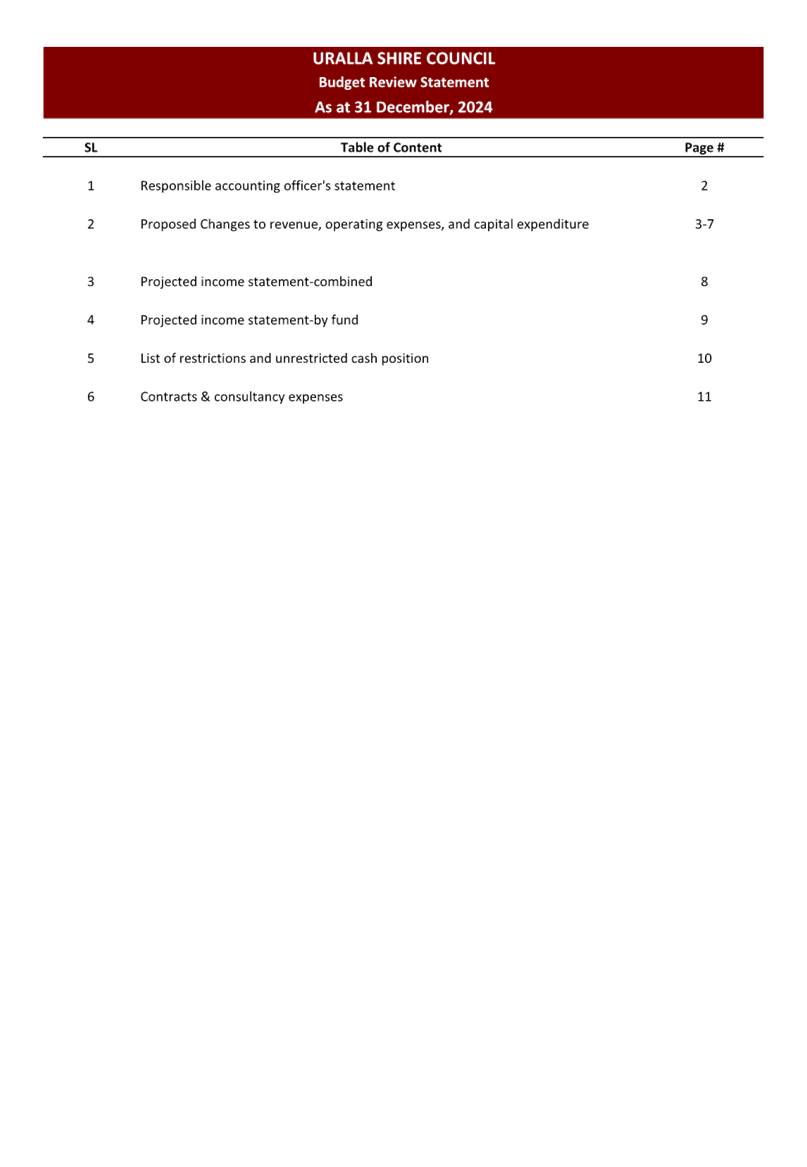
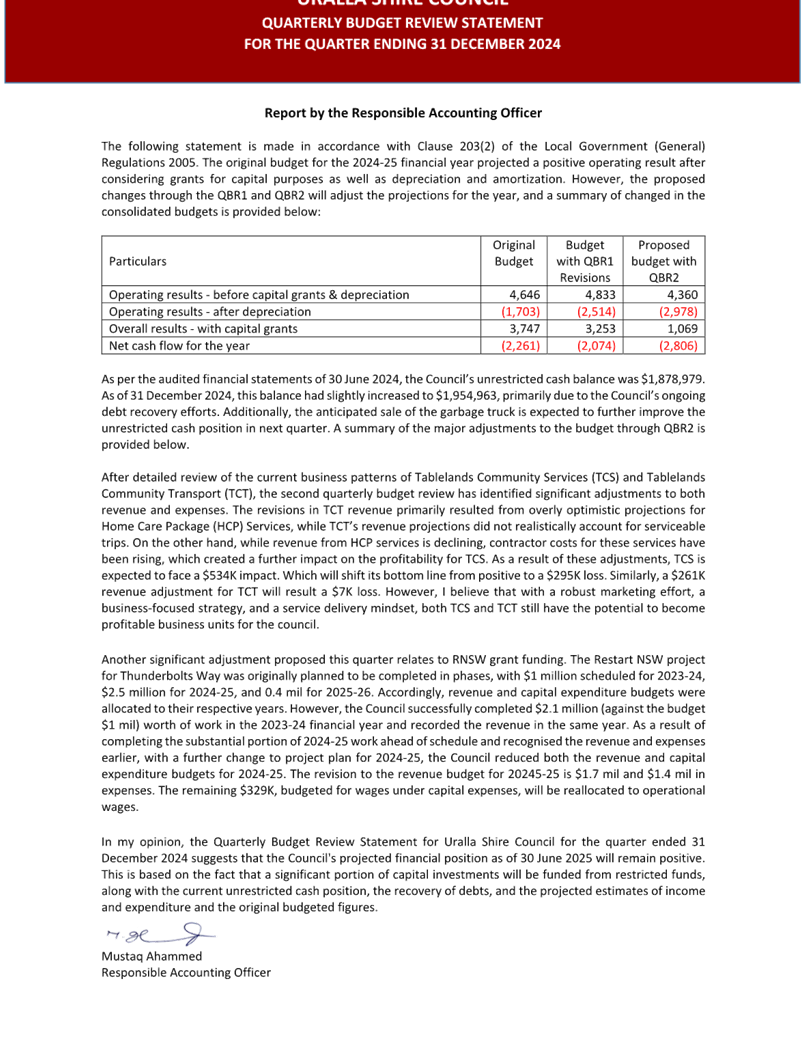
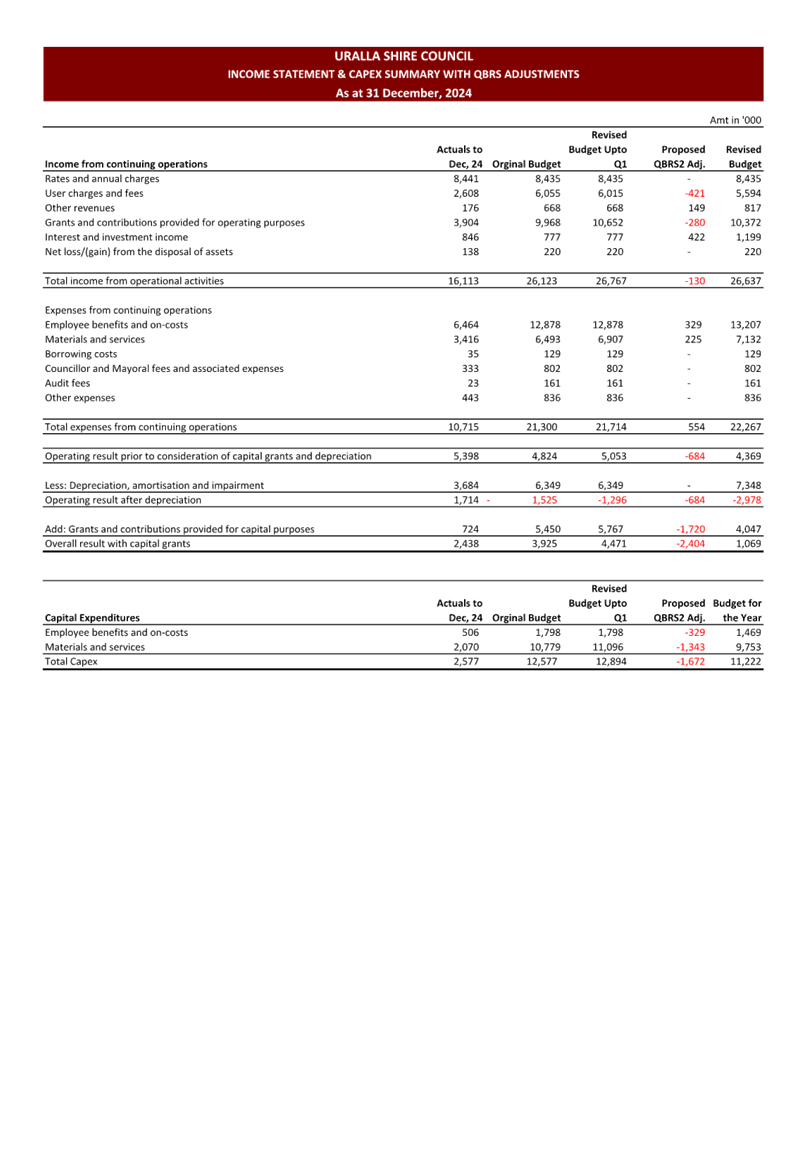
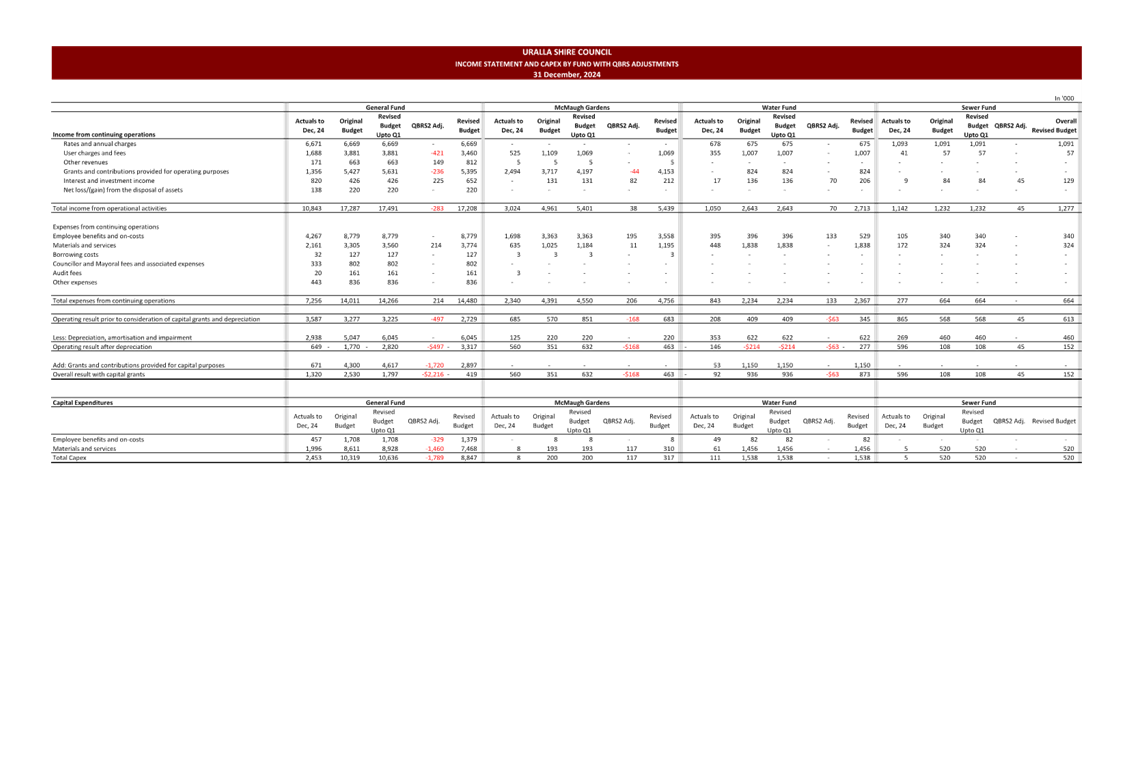
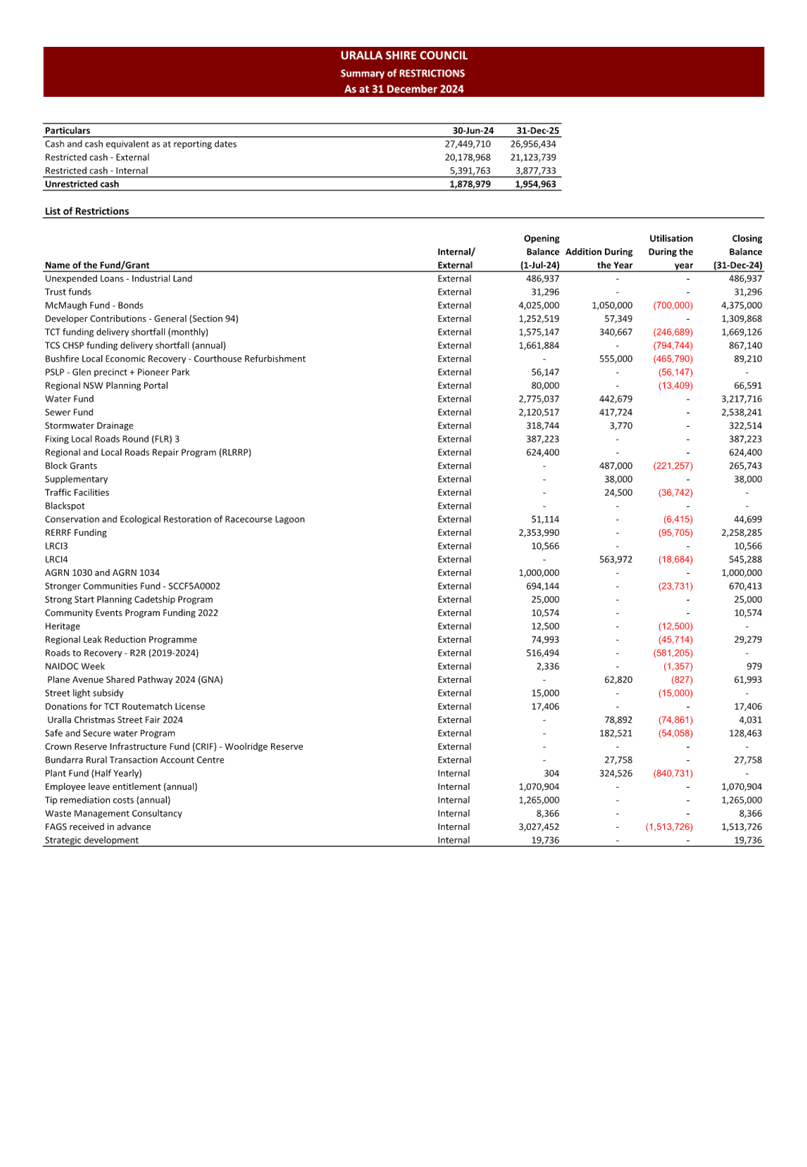
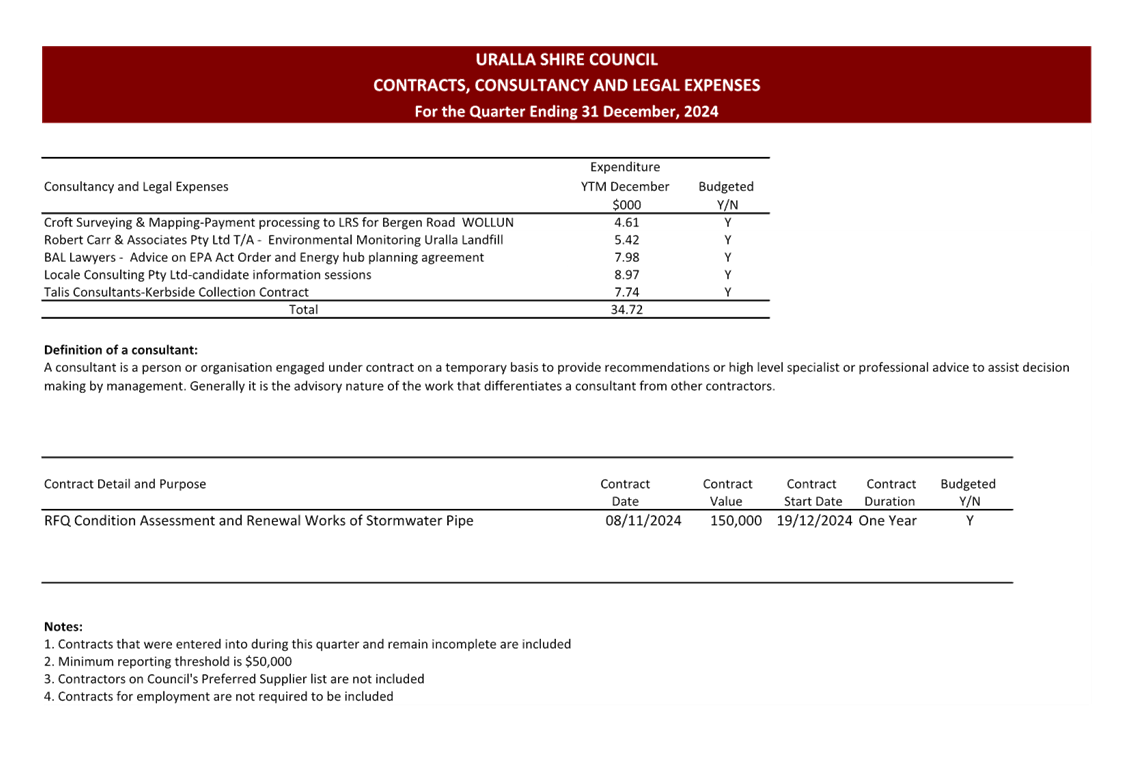
|
Ordinary Council
Meeting Business Agenda
|
25 February 2025
|
14.15 Loans as at 31
January 2025
|
Department:
|
Corporate & Community
|
|
Prepared By:
|
Senior Finance Officer
|
|
Authorised By:
|
Director Corporate & Community
|
|
LINKAGE TO INTEGRATED PLANNING AND REPORTING FRAMEWORK
|
|
Goal:
|
4. We
are an independent shire and well-governed community
|
|
Strategy:
|
4.2. A
strategic, accountable and representative Council
|
Summary
This report provides Council with a reconciliation of
borrowings as at the end of the reporting month.
|
Recommendation
That Council notes that the total loan position as of
31 January 2025 is $1,232,830.
|
Report
This report is provided to inform Council of the
reconciliation of borrowings on a monthly basis. A reconciliation of borrowings
for the month of January confirmed that the loan position as of 31 January 2025
is $1,232,830.
The table below provide details of interest applied and
instalments paid since the last report.

Conclusion
I, Mustaq Ahammed, Chief Financial Officer hereby certify
that the above borrowings have been made in accordance with the requirements of
the Local Government Act 1993 (the Act) (Chapter 15, Part 12 –
sections 621 to 624) and the Local Government (General) Regulation 2021 (the
Regulation) (Section 230).
|
Ordinary Council
Meeting Business Agenda
|
25 February 2025
|
14.16 Investments as
at 31 January 2025
|
Department:
|
Corporate & Community
|
|
Prepared By:
|
Senior Finance Officer
|
|
Authorised By:
|
General Manager
|
|
LINKAGE TO INTEGRATED PLANNING AND REPORTING FRAMEWORK
|
|
Goal:
|
4. We
are an independent shire and well-governed community
|
|
Strategy:
|
4.2. A
strategic, accountable and representative Council
|
Summary
This Report contains a summary of bank accounts, term
deposits, cash management accounts and investments in structured credit
instruments. The investments have been made in accordance with Section 625 of
Local Government Act 1993, Regulation 212 of the NSW Local Government (General)
Regulations 2021, and Council’s Investment Policy 2019.
|
Recommendation
That Council notes the cash position as of 31 January 2025
consisting of:
· cash and
overnight funds of $3,423,367;
· term deposits of
$24,350,000;
· total
convertible funds of $27,773,367 ($3,423,367 + $24,350,000) (including
restricted funds).
|
Report
Current term deposits of $24,350,000 spread over the next
twelve months will receive interest rates ranging from 4.90% to 5.45%, with an
average rate of 5.09%. Council’s General Fund bank balances (refer to the
Schedule of Cash at bank and Term deposits below) have been reconciled to the
bank statement as of 31 January 2025.
An additional table has been added to this report to provide
movement of term deposits with different banks.
key issues
Official cash rate
The current official cash rate as determined by the Reserve
Bank of Australia (RBA) was 4.35% as at 31 January 2025. It is noted that
the Reserve Bank reduced rates at its February Board meeting. This
decision and any subsequent rate cuts will potentially reduce future investment
returns.
The timing of potential interest rate changes will be guided
by the incoming data and the RBA Board’s assessment of the outlook for
inflation and the labour market. The changes in interest rates have resulted to
higher investment returns for the Council in 2023-24, and a good return is
still expected this year as most term deposits secured higher rates.
McMaugh Gardens - Bond Liability
As per the Department of Health’s prudential
guidelines, the council is advised to disclose the amount of McMaugh
Garden’s bond liability in the investment report. McMaugh Garden’s Bond
liability status as of 31 January 2025 is shown below:

Restricted and Unrestricted Cash, Cash Equivalents, and
Investments
Of the amount of cash disclosed in this report, not all the
cash is available for unrestricted use by Council. Most of the cash has been
set aside to meet external restrictions, being those funds that have been
provided for specific purposes such as developer contributions, government
grants, loans, water supplies, sewer services and Aged Care Bonds.
Additionally, a portion of the cash has been set aside to cover future
commitments that Council has made relating to asset renewals, remediation works
or leave provisions.
Most of the Council’s cash is externally restricted
and not available for day-to-day operational expenditure. As per audited
financial statements for the year ending 30 June 2024, the amount of
unrestricted cash was $1,878,692. Council updates its restriction status at the
end of each quarter. Based on latest reconciliation as of 31 December 2024, the
Council’s unrestricted cash is $1,954,963.

Conclusion
I, Mustaq Ahammed, Manager Finance, hereby certify that the
above investments have been made in accordance with the Section 212 of the
Local Government (General) Regulation 2021, and section 625 of the Local
Government Act 1993, and Council’s investment policy.
|
Ordinary Council
Meeting Business Agenda
|
25 February 2025
|
14.17 Register
Resolutions Actions Status as at 19 February 2025
|
Department:
|
General Manager’s
Office
|
|
Prepared By:
|
Executive Assistant
|
|
Authorised By:
|
General Manager
|
|
Reference:
|
UINT/25/588
|
|
Attachments:
|
1. Resolutions
Actions Status Report as at 19 February 2025 ⇩ 
|
|
LINKAGE TO INTEGRATED PLANNING AND REPORTING FRAMEWORK
|
|
Goal:
|
4. We
are an independent shire and well-governed community
|
|
Strategy:
|
4.1. Informed
and collaborative leadership in our community
|
Summary
The purpose of this report is to provide Council with the Resolution
Action Status updates.
|
Recommendation
That Council notes the Resolution Actions Status Report
as at 19 February 2025.
|
Report
Following every council meeting, the resolutions of Council
which require action are compiled. This document is referred to as the
Resolutions Action Status Report.
The purpose of the Resolutions Action Status Report is to enable
Council to monitor progress of resolutions until they are actioned.
Once resolutions have been completed they are removed
automatically from the report.
Conclusion
The Resolutions Action Status Report is presented to Council
at each Ordinary Meeting.
|
Ordinary Council Meeting
Business Agenda
|
25 February 2025
|
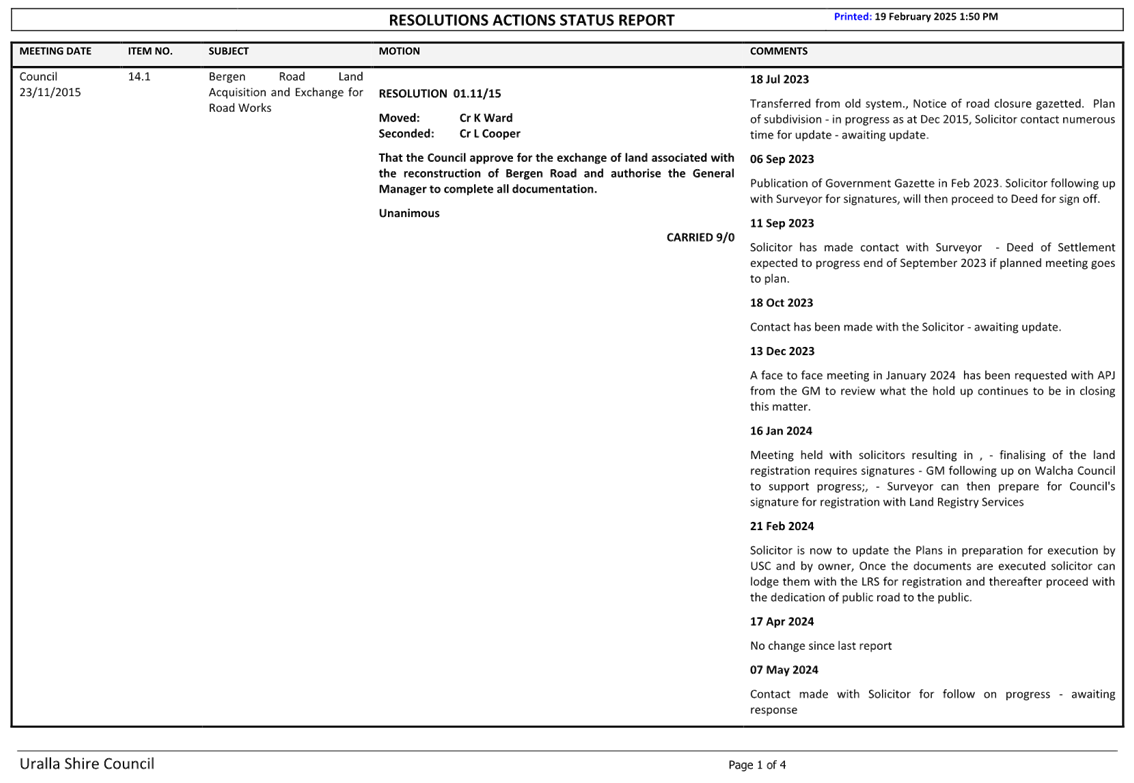
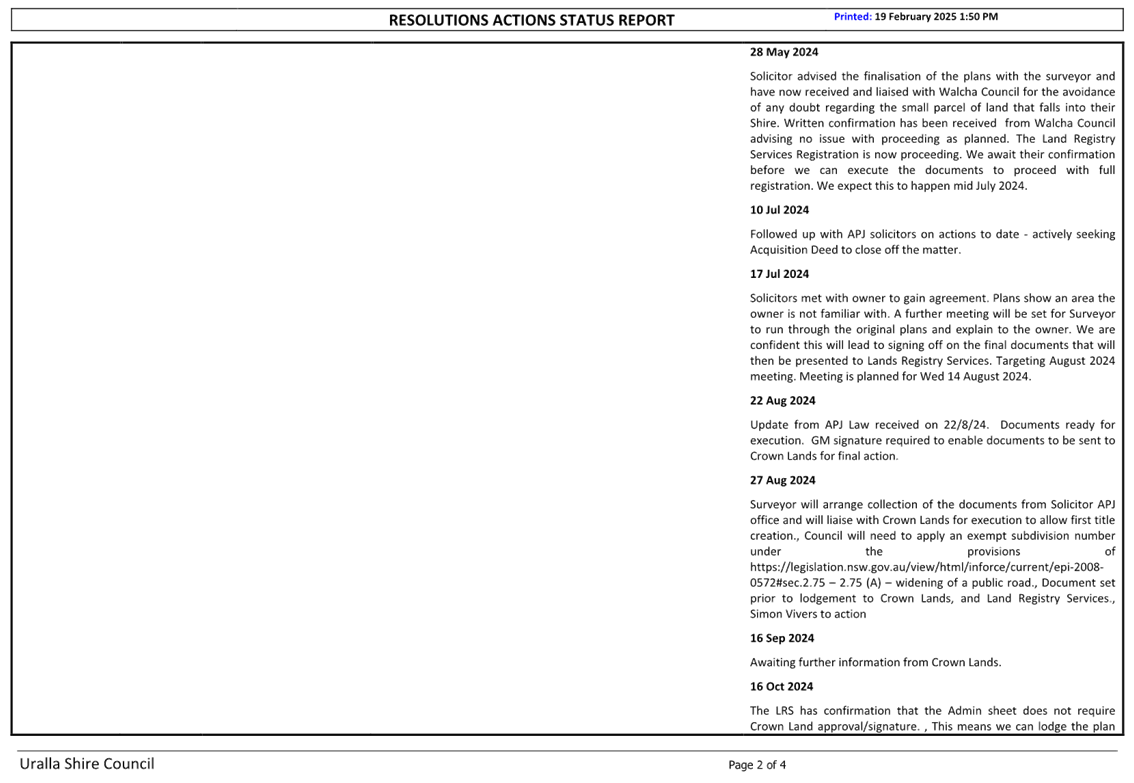
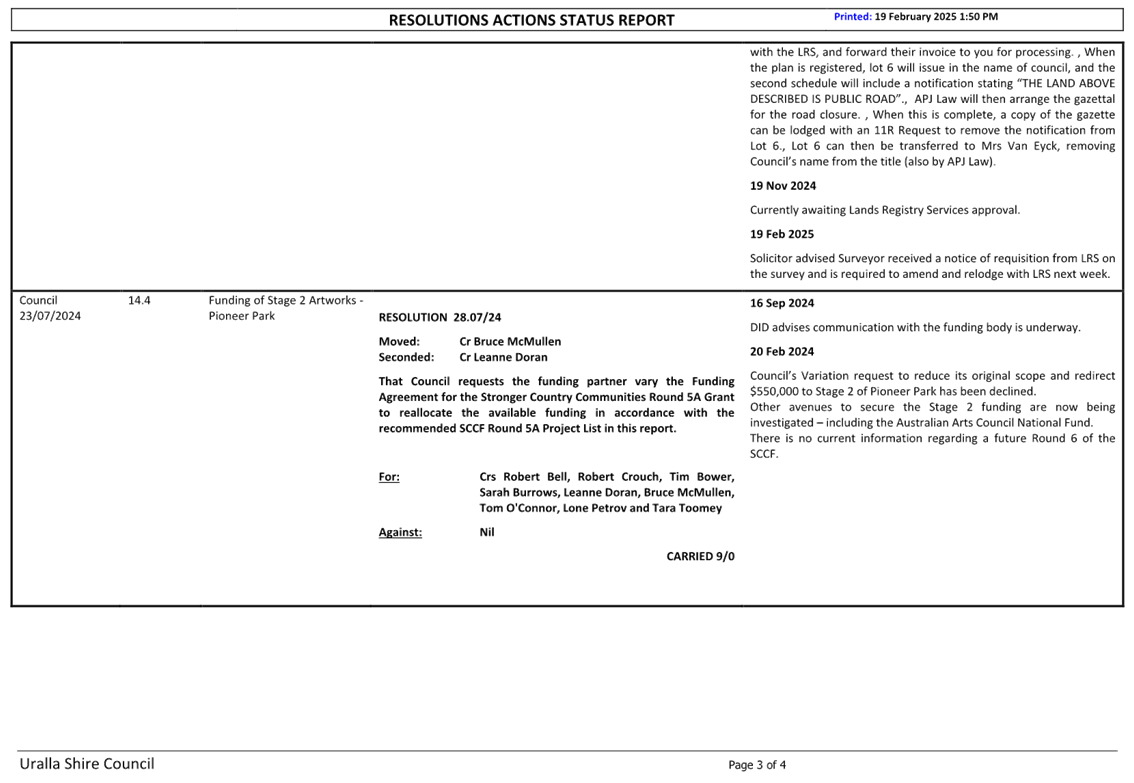
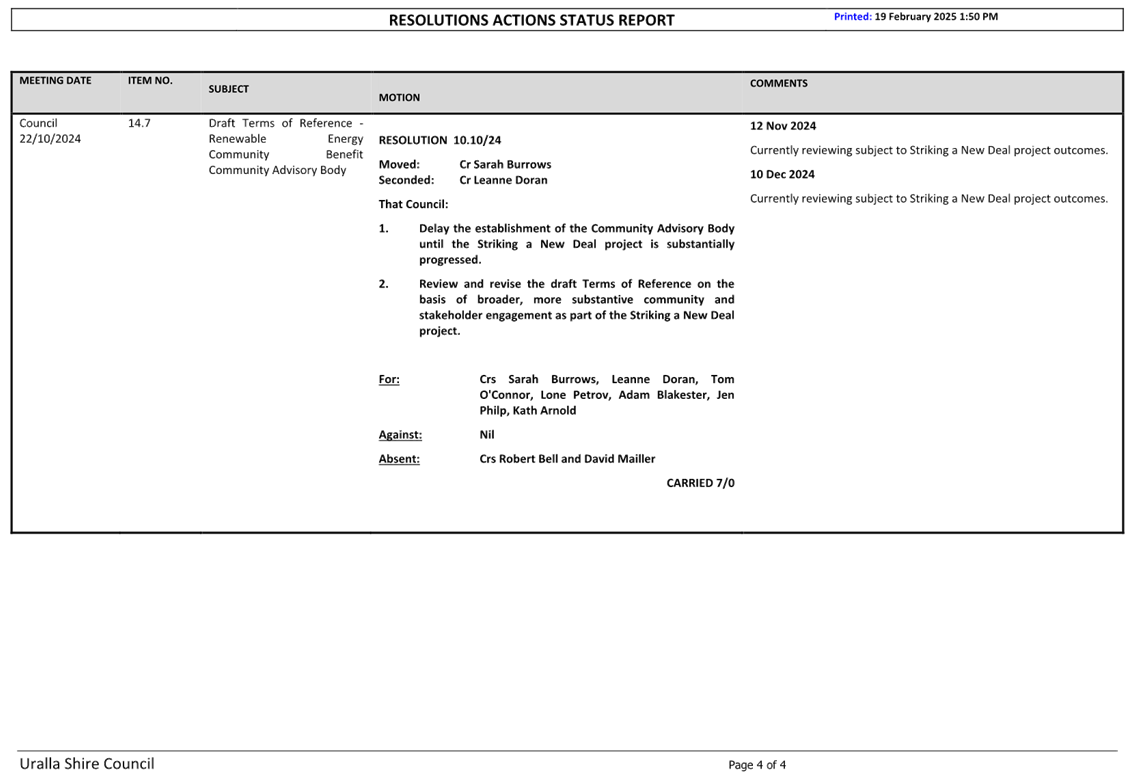
|
Ordinary Council
Meeting Business Agenda
|
25 February 2025
|
15 Confidential
Matters
|
Recommendation
That Council considers the confidential report(s) listed
below in a meeting closed to the public in accordance with Section 10A(2) of
the Local Government Act 1993:
15.1 Grace
Munro Options
This matter is considered to be confidential under Section
10A(2) - d(i) of the Local Government Act 1993, and the Council is
satisfied that discussion of this matter in an open meeting would, on
balance, be contrary to the public interest as it deals with commercial
information of a confidential nature that would, if disclosed prejudice the
commercial position of the person who supplied it.
|
16 Communication
of Council Decision
17 Conclusion
of Meeting











































































































































































































































